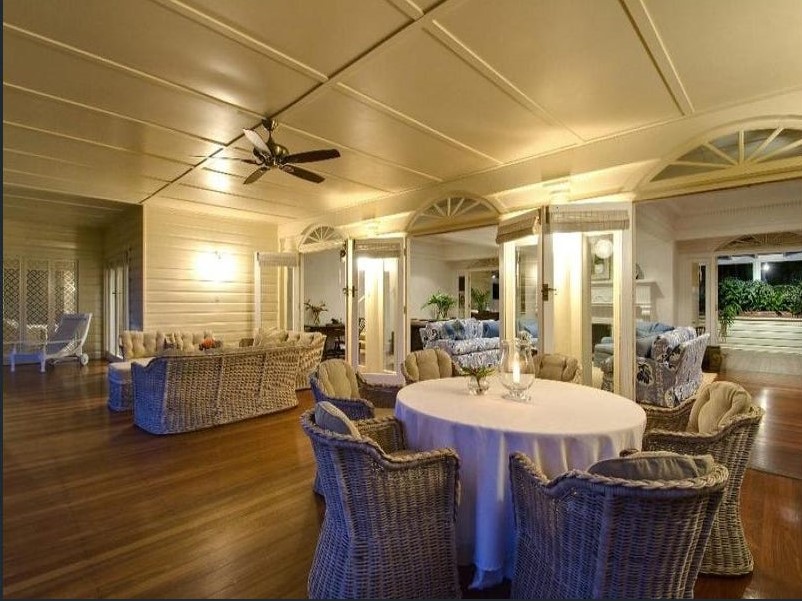Pittwater summer Houses: Kalua, Palm Beach
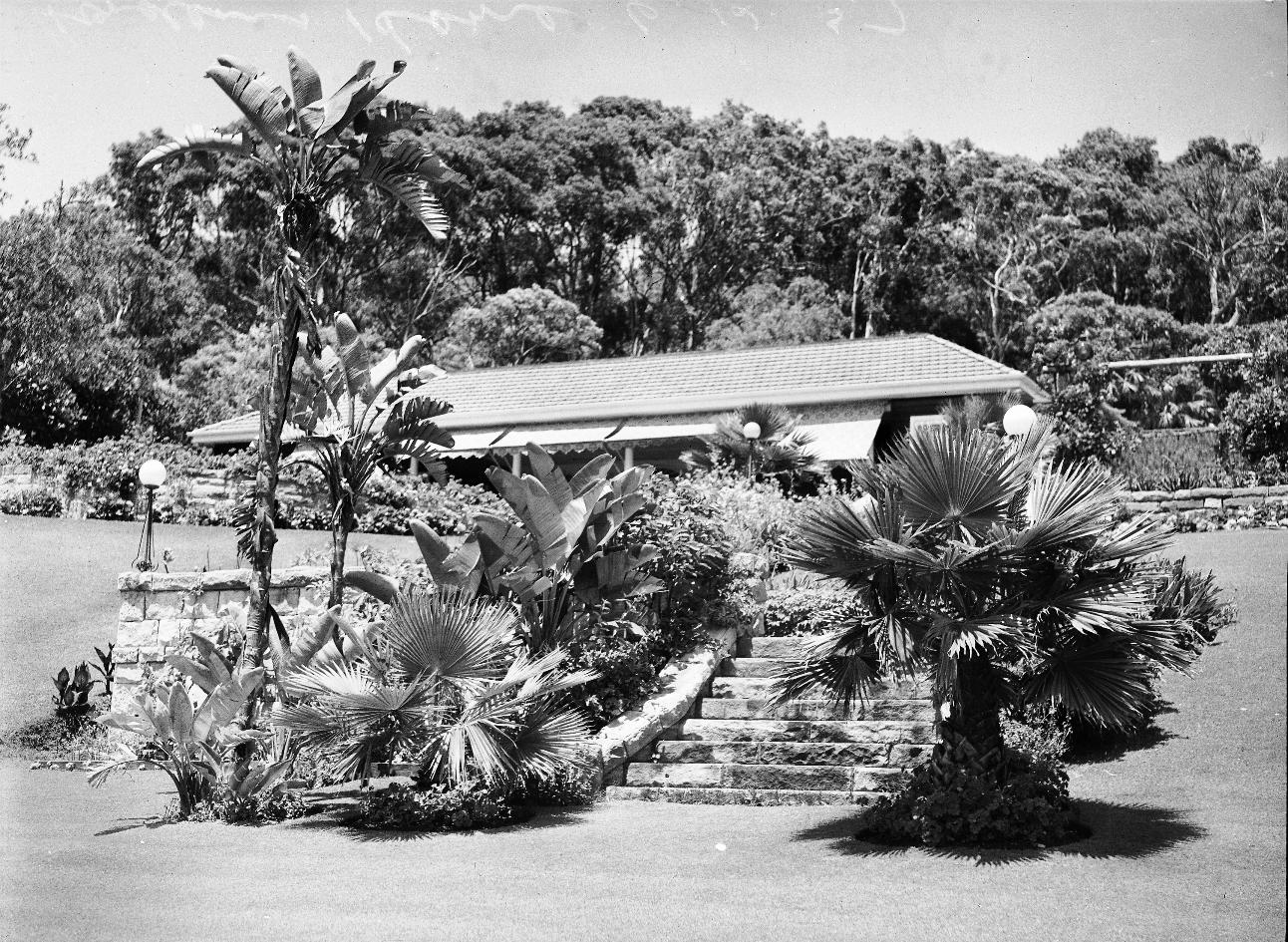
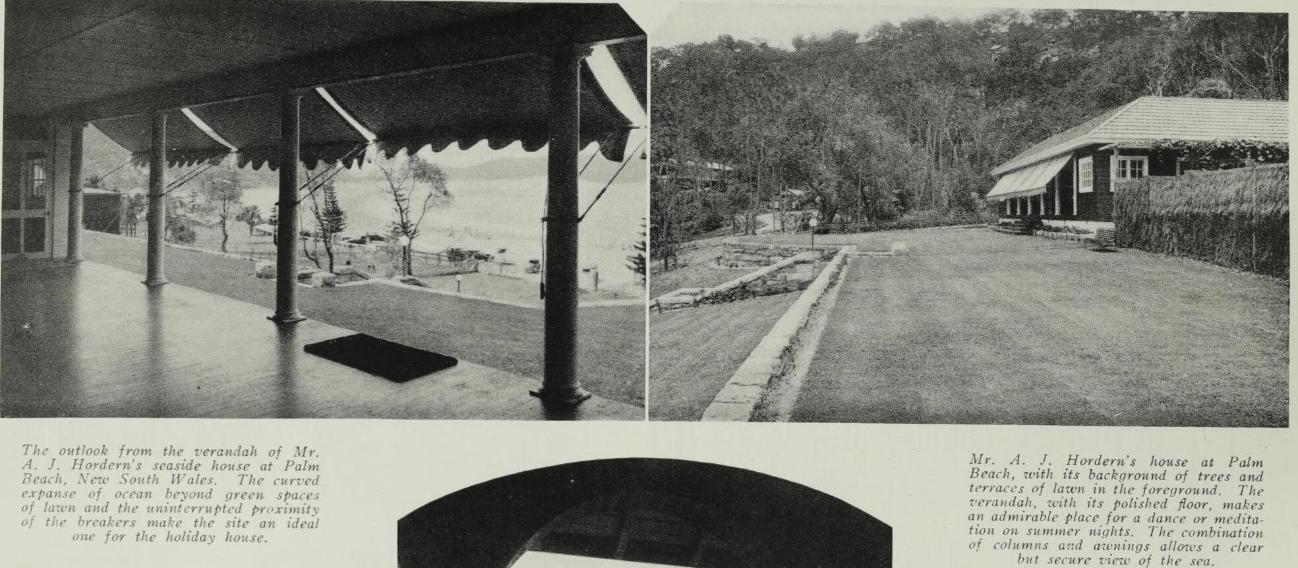
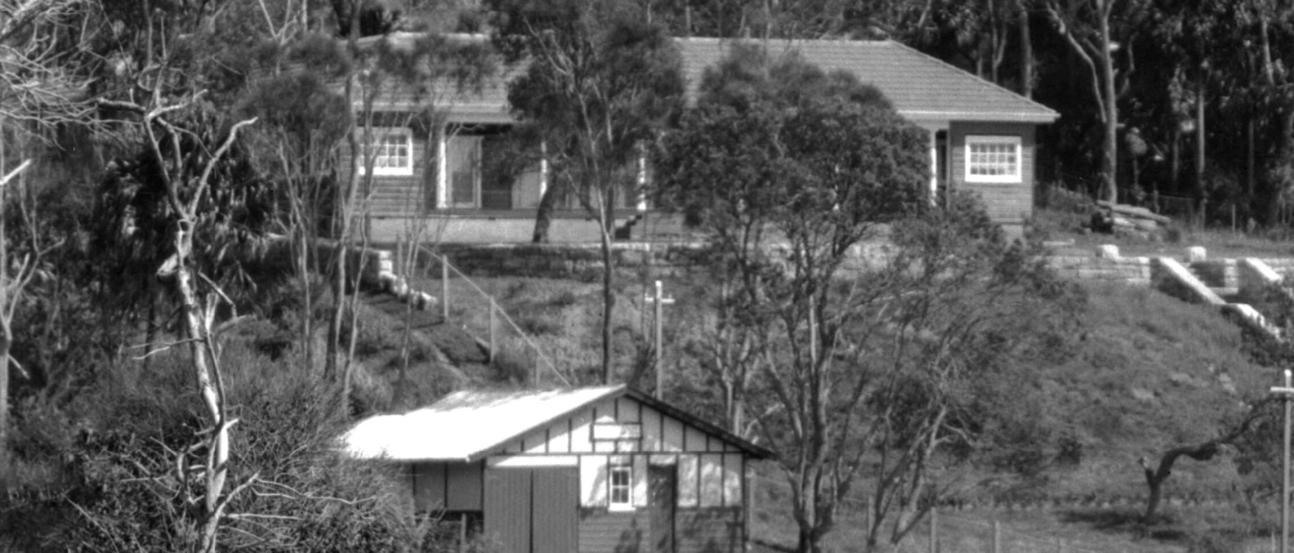
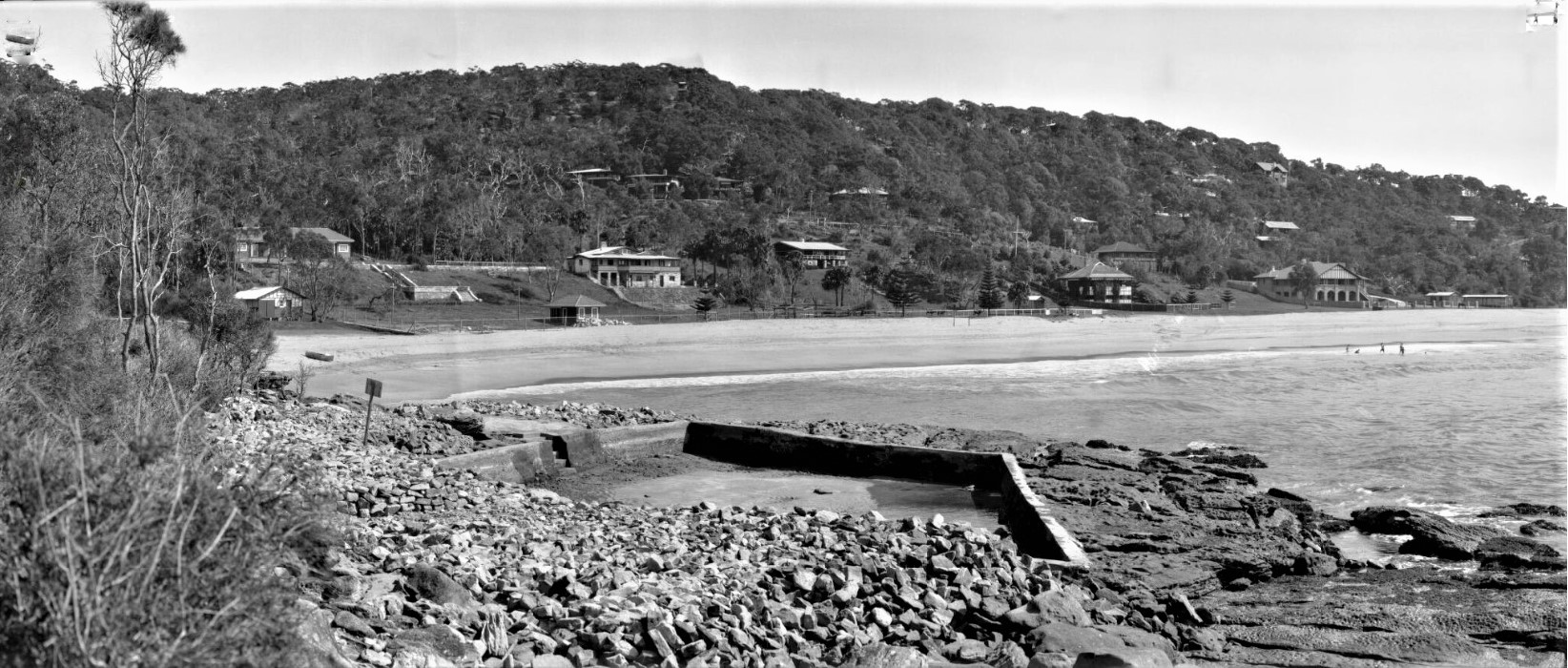
Caroline may have heard about Palm Beach and decided to buy there from one of the people associated with the early days of the Palm Beach SLSC and a promoter of the place - Percy Hunter:
The Director of the Conservatorium and Mme. Verbrugghen, with their family, are staying at Palm Beach. .. There were several New Year's Eve dinner parties at the Wentworth Hotel on Tuesday... Among those who entertained were : Colonel Sanders. Dr. Stewart' McKay, Mrs. Jack Campbell (Goorianiwa), Mr. Owen,- Mrs. C. Scott Wayne, and Captain Price. At Thursday evening's special dance-dinner a few of those who entertained guests were: Mr. and Mrs. Percy Hunter, Mr. and Mrs. Lebbeus Hordern, Mr. Jacques and Lieut. Jacques, Mr. E. Price, Mrs. C. Hordern, and Captain Cairnes ... HOME and SOCIETY (1919, January 5). Sunday Times (Sydney, NSW : 1895 - 1930), p. 14. Retrieved from http://nla.gov.au/nla.news-article123220953
The first element of this property and home is the amount of land bought by the Horderns to surround them – clearly they liked peace and privacy, lots of it. They don't appear in the social pages so popular during the 1920's and 1930's, despite their cousins doing so on a regular basis. Australians are fascinated with success stories and the Hordern family of retailers were certainly a success story - however, the Horderns who owned this home are mentioned only in passing in association with their Palm Beach weekender mostly through other people having use of the premises, and even though their two sons, and only children, both went through a divorce in the years after serving in WWI, their eldest at Gallipoli, the younger in France, their pictures don't appear in the papers and those journals that do seek to attract readership through running the sensational fall flat with this Hordern family - they simply remained out of sight and quiet.
The Lots bought for their Palm Beach refuge were purchased from 1919 on - although it should be remembered the lapse of time that occurs between a deposit being paid and a Certificate of Title being issued. Research for the first weekenders along the Palm Beach beachfront revealed some of those who had these first beachfront lots were entertaining guests in holiday homes and enjoying summer on the then coastal rural Pittwater a long time prior to the dates these titles are first registered.
All up Alfred James and Caroline Hordern acquired 7 Lots. Lots 87 and 88, then right at the end of Ocean Road, were first bought by a Gustavus Athol Waterhouse on July 3rd 1913 and then transferred to Alfred James Hordern on December 22nd, 1919. Lot 86 was purchased by Ernest Ebenezer Way with the Certificate of Title being issued on May 4th, 1917 (Vol/Fol 2754-135) and onsold to William John Creagh, the Hordern's solicitor, with the transfer registered on January 23rd, 1919. Mr. Creagh then sold his Lot to Alfred James Hordern with the transfer registered on April 16th, 1921. William John Creagh, was, along with Mr. Hordern's wife Caroline, one of the executors of his estate.
Mr. Hordern went on to buy Lots 89, 90, 91 and 126, behind him, on Florida road, with the Certificate of Title being registered in October 1922. The NSW Historical Land Records Viewer (HLRV) provides:
.jpg?timestamp=1674198870531)
.jpg?timestamp=1674198908021)
.jpg?timestamp=1674198974130)
.jpg?timestamp=1674199008490)
.jpg?timestamp=1674199037626)
Alfred J Hordern Florida Road Lots, Vol/Fol:3405-42, Lots 89, 90, 91 and 126 - courtesy NSW Historical Land Records Viewer (HLRV):
.jpg?timestamp=1706630936061)
.jpg?timestamp=1706630983073)
.jpg?timestamp=1706631063443)
.jpg?timestamp=1706631113722)
Lot 126, on the higher side of Florida road, was sold by Caroline in 1938. Lot 86, along with Lot 91, was split into sections and sold off in 1955 by the second wife of one of her sons, Bruce Alexander.
In 2012, when the then owners, the Suttons, were renovating and rejuvenating small additions to the Caretakers premises and main building, the land sizes were still; 37 Ocean road, Palm Beach; front Lot D DP25914 – 4603m2, and 38 Florida Road, back Lot D- DP25914 – 885.2m square.
The other element is the change in the garden over the years. From the outset an expansive lawn fills the front garden of the property, while the back lots retain the massive trees that once grew all over Pittwater prior to developments. Earlier panoramas show not much of a garden in the front area.
However, both Alfred and Caroline Hordern became renowned for their gardens – both at ‘The High Lands’ the main family home at Waitara (now listed as 9 Highlands Avenue, Wahroonga) and at Palm Beach for Kalua, although many imported tropical plants and non-natives were used. In fact, one article credits 30 gardeners being employed at one stage, and 10 full-time.
These reports also speak of the use of tropical plants – was Caroline homesick for the environs of Fiji? The flowers and plants of Japan are mentioned too – in fact the lady is in Japan when eldest son Roy dies in a motorcycle accident in Western Australia.
The Highlands along with Kalua became famous for their use of Hydrangeas; especially these being in spectacular and numerous bloom when the open gardens were held.
At Palm Beach there was a special arbour, called a 'Bush-House', off to the right hand side of the Kalua. These gardens would be open for viewing on allotted days during Spring to raise funds for local charities.
Alfred James Hordern (1859 -1932) was the youngest son of John and Rebecca (née Carr) Hordern.
John (1819 – 27 March 1864) was a son of Anthony Hordern, Snr. (1788 – 9 June 1869) and Ann (née Woodhead;1794-1871). John married Rebecca Carr (1827-1875) on 5 July 1845 in St Andrew's Sydney, New South Wales. They lived in Charlotte Place, Sydney then "Kingston", Newtown. He worked in the family business then on his own account from around 1845.
Alfred's siblings were John Lebbeus (1848-1910), William Carr (1850-1850 aged 10 months), Edward Carr (1853-1940) and Eda Rebecca (1856-1922) Hordern.
His father took his own life when he was just 5 years of age, under horrible circumstances, as the coroner reports published in newspapers attest. He died at the drapery establishment of his brothers — Messrs L. and E. Hordern, Brickfield-hill after what was described as 'a period of insanity'. John Hordern had been receiving treatment for 'a nervous complaint' months prior to taking his own life. His mother passed away at 48 years of age, when he was a teenager. Anthony Hordern Snr. was executor for his father's will and Alfred went into the family business with his older brothers.
There is some suggestions through the way they conducted themselves, and the amount of privacy they sought to maintain throughout their lives, that his father's death cast some kind of stigma over his and his brothers lives.
Lesley Hordern, wife of Marsden Hordern, a son of Edward Carr Hordern, Alfred's older brother, who did not marry into the family until 1953 when both A J and Caroline Hordern and their sons had all passed away, states in 'Children of One Family. The Story of Anthony and Ann Hordern and their descendants in Australia 1825-1925'.[ Retford Press, Sydney, 1985] of Alfred, in regards to 'The Highlands' home that;
"There is nothing in his letters to suggest he had the aestheticism or the spirit of innovation which would move him to commission such an architect. He was not a man to take risks or flout convention, and the robust and distinctive style of this house... bears little relation to his nervous personality."
However, other records attest to his simply being a very very private gentleman who would go out of his way to have some peace and quiet.
His wife, Lucy Caroline Doig was born in December 1869 at Brixworth to Alexander and Mary (née Chalmers) Doig. Some records state she was born in Fiji, where her father was a planter and later, a merchant, other biographies record her birth as having occurred in the U.K. Brixworth is a large village and civil parish in West Northamptonshire, England.
Alexander Doig was born on 25 October 1831 in Douglastown, Kinnettles, Angus, Scotland, the youngest son of Charles and Jean Doig and one of seven children born to the couple. He was christened on 30 October 1831 in Kinnettles, Angus, Scotland. In 1851 he was a brass pounder living with his father at Dudhope Crescent, Dundee, who was a flax mill overseer. Alexander was in a non-marital relationship with Isabella Brownlee. Isabella was born about 1832 in Scotland and, later, was a handloom weaver in Hilltown, Dundee. Alexander had an illegitimate son by Isabella Brownlee. The child, named Alexander Doig, was born in September 1853 in Dundee, Angus, Scotland and died on 1 July 1854 in Hilltown, Dundee, Angus, Scotland from ‘teething’. He was buried on 3 July 1854 in Howff Graveyard, Dundee, Angus, Scotland.
Alexander Doig, his father, had already left Scotland before he was born, arriving in Melbourne Australia in April 1853, aged 22, via the Loch Lomond. Unclaimed letters for him are listed in the Mount Alexander Mail for Castlemaine in October 1856 - a gold mining place.
Gold was discovered here on 20th of July 1851 near present-day Castlemaine (Mt Alexander Goldfields) at Specimen Gully on Barkers Creek. Discovered by Christopher Thomas Peters, a shepherd and hut-keeper on the Barker's Creek, in the service of Dr William Barker on his Mount Alexander run. When the gold was shown in the men's quarters, Peters was ridiculed for finding fool's gold, and the gold was thrown away as Barker did not want his workmen to abandon his sheep, but in August they did just that. John Worley, George Robinson and Robert Keen, also in the employ of Barker as shepherds and a bullock driver, immediately teamed with Peters in working the deposits by panning in Specimen Gully where the gold had been found, which they did in relative privacy during the next month. When Barker sacked them and ran them off his land for trespass, Worley, on behalf of the party "to prevent them getting in trouble", mailed a letter to The Argus (Melbourne) dated 1 September 1851 announcing this new goldfield with the precise location of their workings. This letter was published on 8 September 1851. "With this obscure notice, rendered still more so by the journalist as 'Western Port', were ushered to the world the inexhaustible treasures of Mount Alexander" also to become known as the Forest Creek diggings.
Within a month there were about 8,000 diggers working the alluvial beds of the creeks near the present day town of Castlemaine, and particularly Forest Creek which runs through Chewton where the first small village was established. By the end of the year there were about 25,000 on the field.
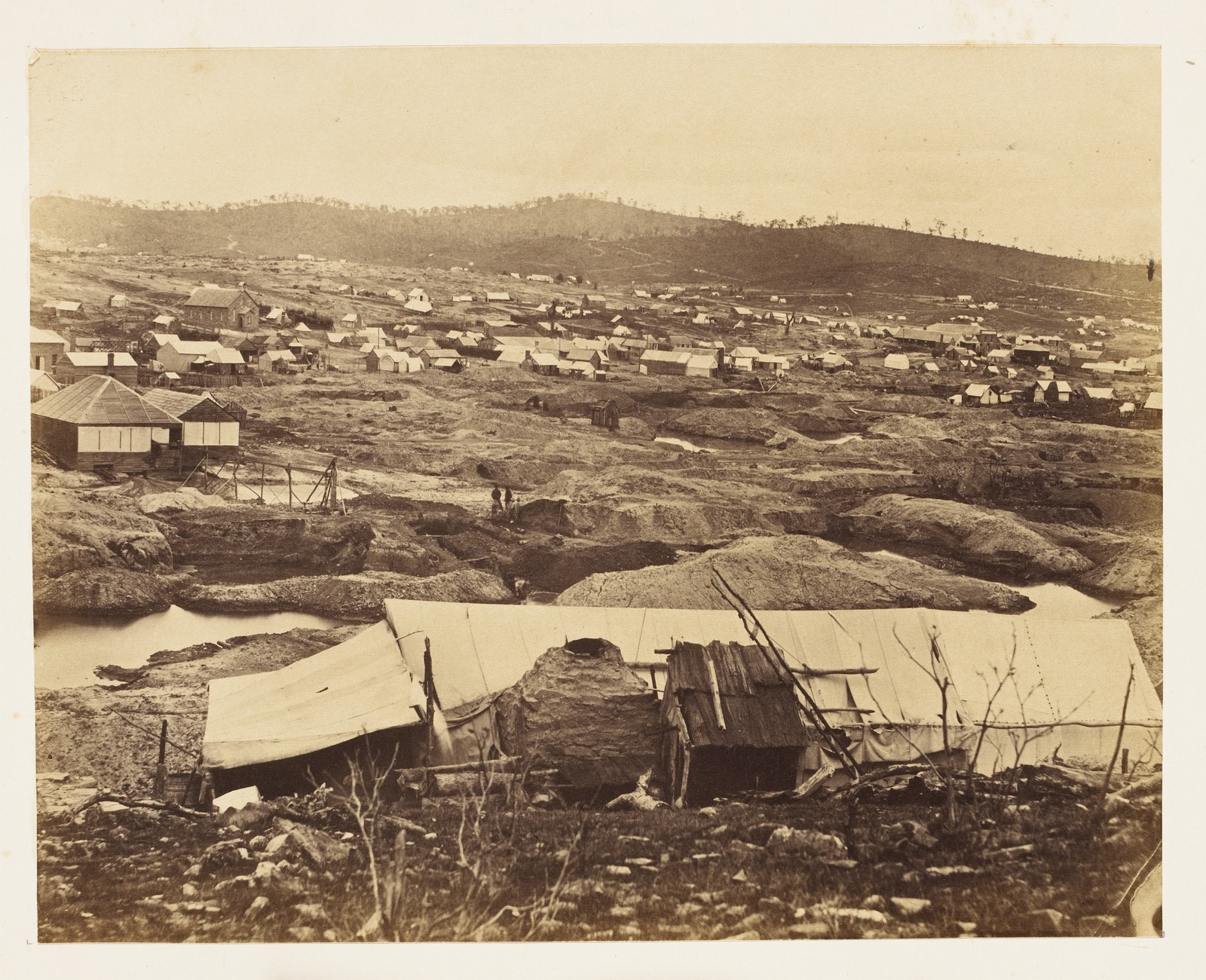
Castlemaine in 1858, Forest Creek gold diggings. (A view of the diggings from Old Post Office Hill in 1858. State Library Victoria pictures collection.)
In 1857 he married Mary Chalmers who had arrived in September via the Hornet that same year, in Melbourne. The Victorian Marriage certificate Registration number: 3324 / 1857. Mary had been born in June 1832 at Dundee.
By at least 1867 the couple are on their way to the islands of the Pacific:
Gem, schooner, 99 tons, Captain Bryce, for S. S. Islands. Passengers— Dr. Smith, Mr. and Mrs. Doig, Mrs. Blackman, and Mr. Wilson. LATEST SHIPPING. (1867, December 14). Sydney Mail (NSW : 1860 - 1871), p. 9. Retrieved from http://nla.gov.au/nla.news-article166798720
Founded by traders and settlers as early as 1830, Levuka was the first permanent European settlement in the Pacific islands. In the 19th century, the small town flourished and attracted cotton and coconut planters, sandalwood and Bêche-de-Mer traders. Merchants arrived to set up shops, bars, and hotels. Ships and sailors visited and Levuka turned into a rowdy place. Local chiefs had trouble maintaining control. In 1874 the king of Fiji “Tui Cakobau” and his fellow chiefs ceded the islands to the queen and Fiji became a British colony on 10 October 1874 and Levuka became Fijis’ first capital. A few years later, the lack of space hindered the further economic growth of the town. A new capital was needed. In 1882 the capital was officially moved to Suva, businesses and many people left the old capital and Levuka seemed to be doomed to stand still in time.
Alexander Doig was also an importer and merchant in Sydney and had land at Blues Point, while a later advertisement shows he is selling, via a subdivision, some of the Billy Blue land granted to that gentleman and inherited by his family:
WANTED, a SITE for Cottage on Blue’s Point, water frontage preferred. State position, size, and price, A E Doig, St Leonards. Advertising (1870, September 2). The Sydney Morning Herald (NSW : 1842 - 1954), p. 8. Retrieved from http://nla.gov.au/nla.news-article13223297
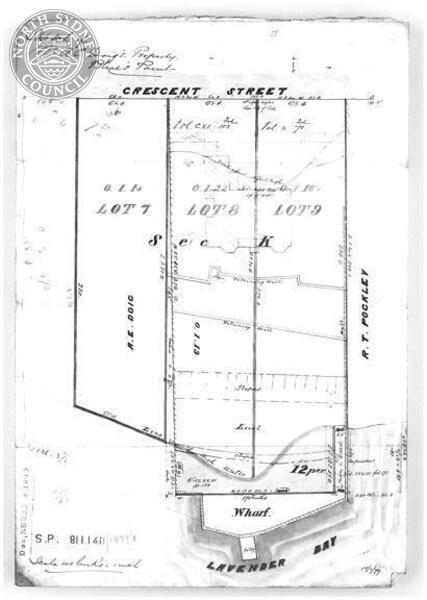
Sketch of Mr A.E. Doig's Property, Blues Point. Courtesy Stanton Library, North Sydney Council. Date created; 1879 Image courtesy Stanton Library Historical Services.’
Department of Lands,
Sydney, 12th September, 1873.
RECLAMATION OF LAND.
NOTICE is hereby given, that application has been made by Mr- Alexander Evans Doig to reclaim and purchase certain land adjoining his property at Blue's Point, North Shore, as particularized in the annexed description and all persons interested are invited to state, within one month from this date, their objections, if any, why Mr. Alexander Evans Doig should not be permitted to reclaim and purchase the land referred to.
JAMES S. FARNELL. Description referred to.
12 perches, county of Cumberland, parish of Willoughby, at Blue's Point, North Shore, fronting A. E. Doig's subdivision of William Blue's 80 acres grant: Commencing on the highwater mark and extending to the limit-line for reclamations as laid down by the Engineer-in-Chief for Harbours, &c. [72-4,193 Ms.] RECLAMATION OF LAND. (1873, September 19). New South Wales Government Gazette (Sydney, NSW : 1832 - 1900), p. 2559. Retrieved from http://nla.gov.au/nla.news-article223104895
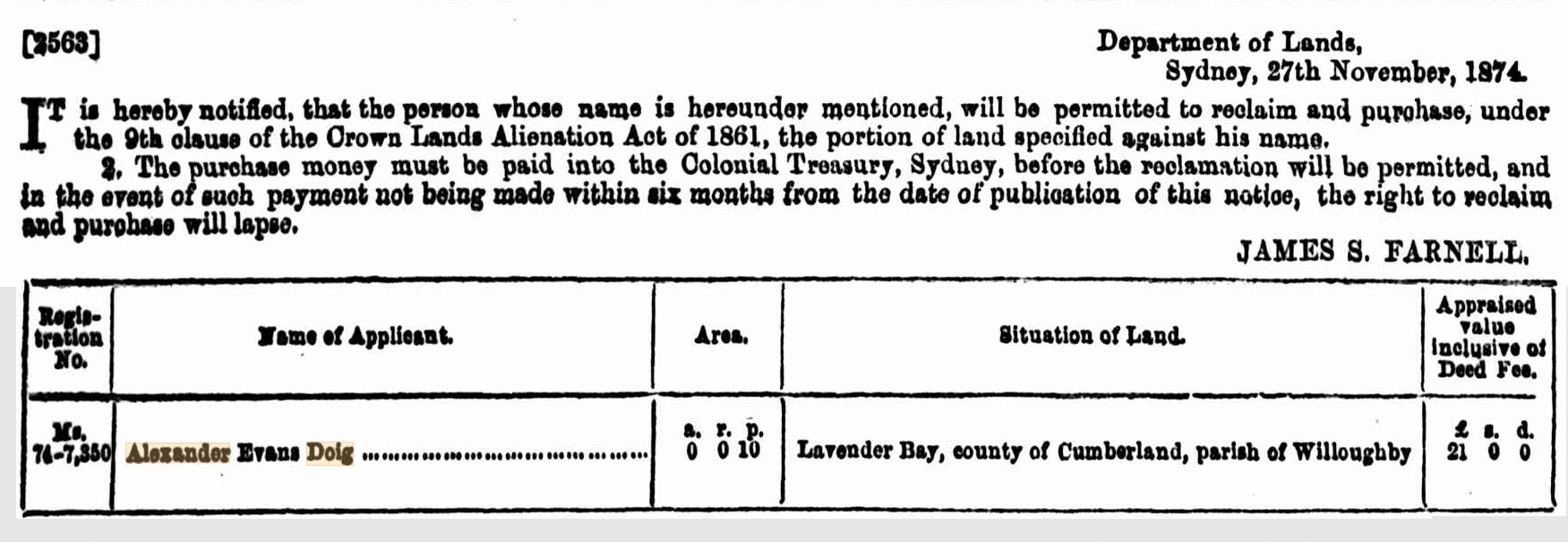
Government Gazette Notices (1874, November 27). New South Wales Government Gazette (Sydney, NSW : 1832 - 1900), p. 3560. Retrieved from http://nla.gov.au/nla.news-article223582736
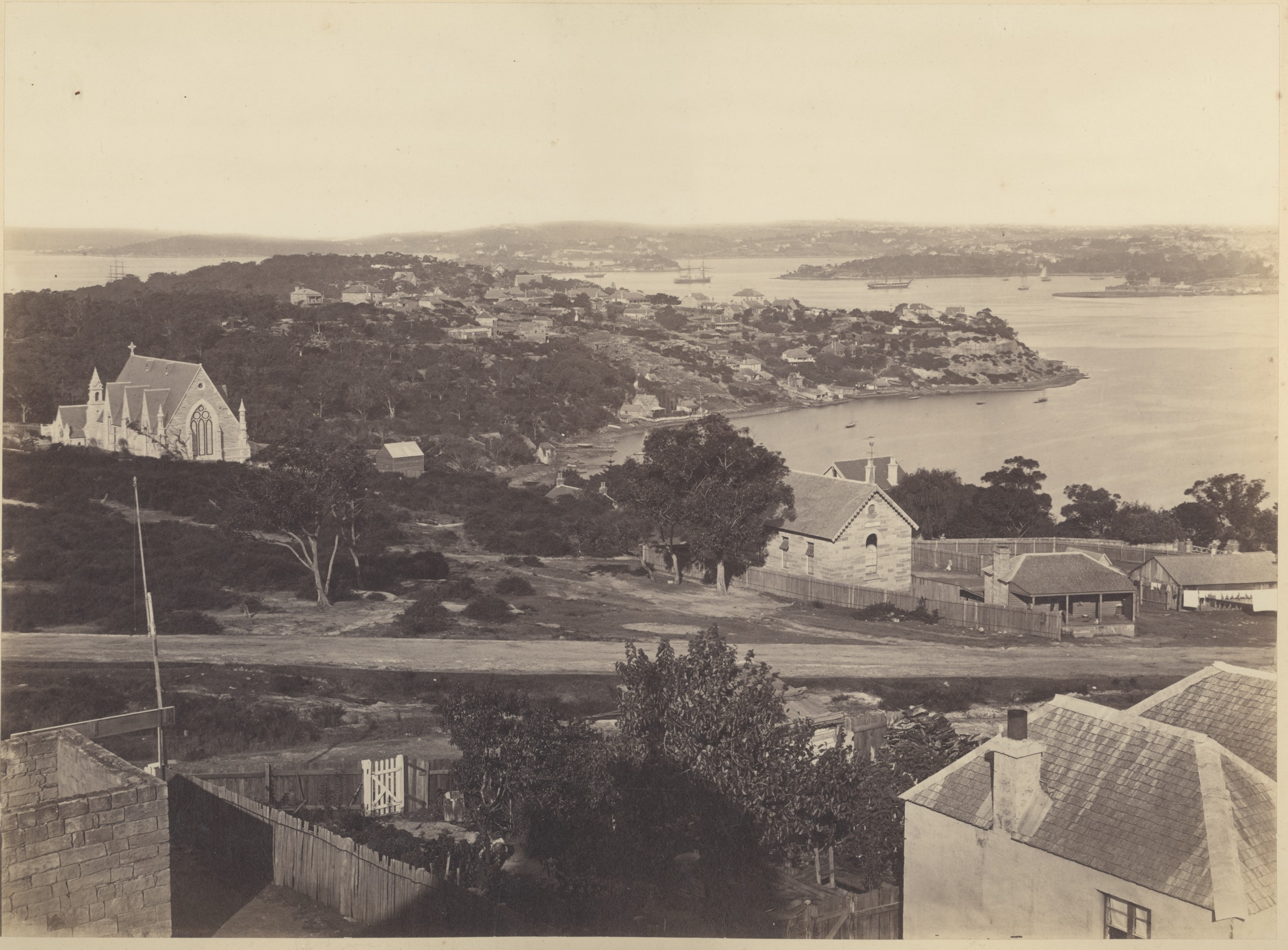
Lavender Bay circa 1877 by Alexander Brodie, 1874-1875. Courtesy State Library of NSW, Item:SLNSW_FL1085029
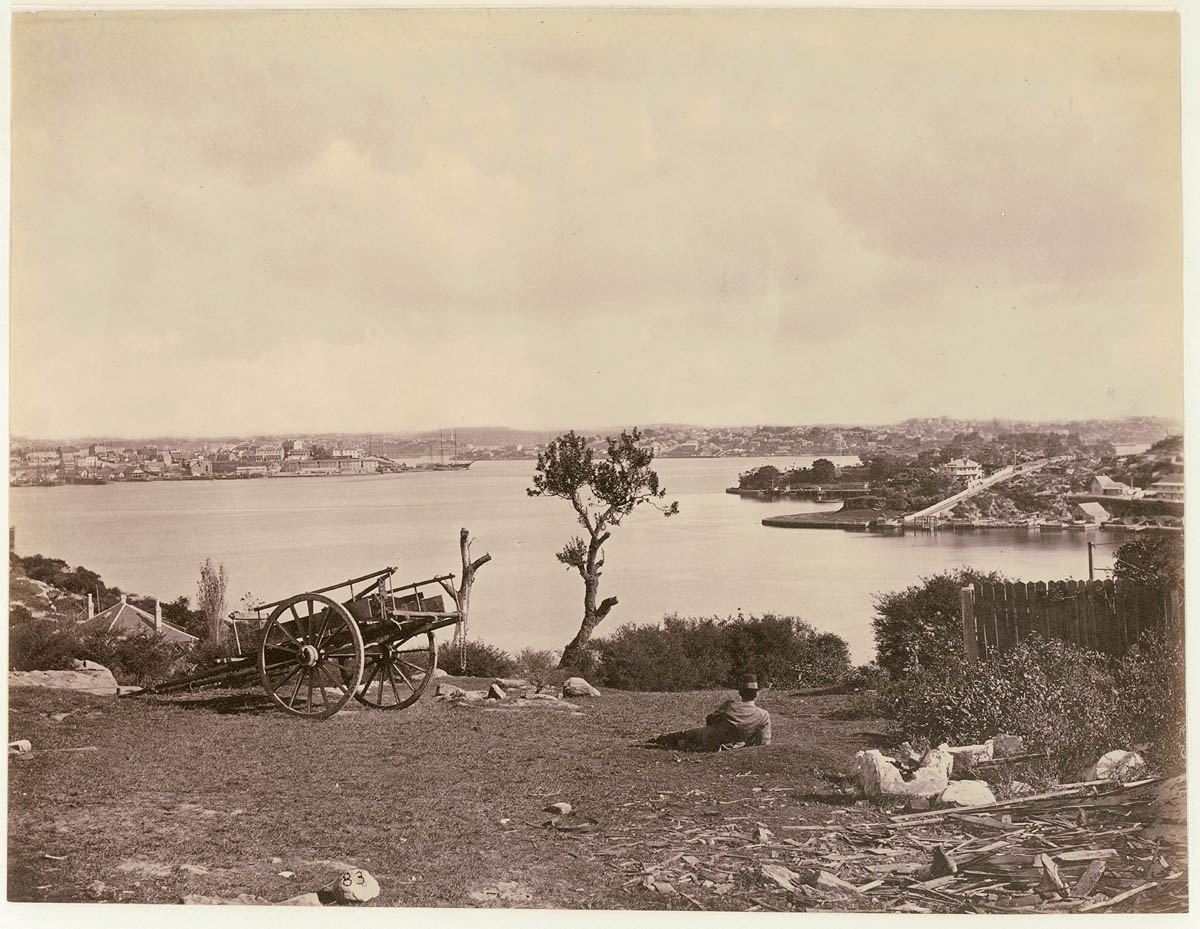
Lavender Bay circa 1877 by Alexander Brodie, 1874-1875. Courtesy State Library of NSW, Item:SLNSW_FL1231946
A sister, Lillian, was born in New South Wales in 1874 or 1875. No other children's births are recorded but they may have been registered with the British Consul in Fiji, if born there. The Shipping Lists record a Mr and Mrs A E Doig and two 'Misses' leaving Sydney for Melbourne on the Ly Ee Moon on February 26th 1882, possibly to meet up with a ship going to the United Kingdom, as Mary passed away in 1884 -
DOIG.—December 5, at Dawlish, Devonshire, of malignant liver complaint, Mary, the beloved and deeply regretted wife of A. E. Doig, of Lavender Bay, St. Leonards, in the 51st year of her age. Family Notices (1884, January 17). The Sydney Morning Herald (NSW : 1842 - 1954), p. 1. Retrieved from http://nla.gov.au/nla.news-article13557769
Dawlish is an English seaside resort town and civil parish in Teignbridge on the south coast of Devon; it is located 12 miles from the county town of Exeter and from the larger resort of Torquay. The Saint Gregory the Great, Dawlish, Grave list sorted by Index (column 1) provides:
K037, Monument on base with kerbs. Marble monument - granite kerbs, Flushed Lead East. On monument; ‘’Loving memory of my devoted wife Mary Doig (nee Chalmers) born at Dundee 24th June 1832 died 5th Dec'r 1883 Far from her earthly home present with the Lord.’’
Caroline's father Alexander remarried a few months later:
DOIG—TORRANCE.—February 12, at Brenchley, Lavender Bay, the residence of the bride's uncle, by the Rev. Roger Mackinnon, Alexander Evans Doig, Esq., of Tivoli, Lavender Bay, to Agnes Eadie, eldest daughter of the late Rev. John Torrance, Dumfries, Scotland. Family Notices (1885, February 20). The Sydney Morning Herald (NSW : 1842 - 1954), p. 1. Retrieved from http://nla.gov.au/nla.news-article13580419
Agnes was born on 10 Feb 1854 in Dumfries, Dumfries, Scotland. In 1881 she was a governess for the children of John Luke, farmer, at 19 High Street, Elie, Fife.
The couple went on to have eight children together, four daughters and four sons, the first of whom, Phoebe, was born in Scotland. Two of their sons would later be killed in action during WWII. A few notes:
DOIG.-March 21, at 84, Crown-street, Aberdeen, the wife of Alex. E. Doig (of Tivoli, North Shore), of a daughter. Family Notices (1886, May 7). The Sydney Morning Herald (NSW : 1842 - 1954), p. 1. Retrieved from http://nla.gov.au/nla.news-article28357036
Through passengers per Royal mail steamer, from London : Mesdames Purnier, Doig and infant, Asher, Misses Partner, Doig (2), Aslier, Messrs. Parmer, Surgeon-Major, Williams, N.S.W. Permanent Defence Force, A. E. Doig, Stanley Mayall, Asher. SHIPPING. (1886, November 22). The Daily Telegraph (Sydney, NSW : 1883 - 1930), p. 4. Retrieved from http://nla.gov.au/nla.news-article239327200
DOIG.—March 25, at Tivoli, Lavender Bay, North Shore, Sydney, the wife of A. E. Doig, of a son. Family Notices (1887, April 6). The Sydney Morning Herald (NSW : 1842 - 1954), p. 1. Retrieved from http://nla.gov.au/nla.news-article13648658
DOIG.—September 7, at Tivoli, Lavender Bay, North Shore, Sydney, the wife of Alexander E. Doig, of a daughter. Family Notices (1888, September 20). The Sydney Morning Herald (NSW : 1842 - 1954), p. 1. Retrieved from http://nla.gov.au/nla.news-article13697187
Caroline married Alfred James Hordern in 1890 at the Scots Church in Melbourne. This may have been where her parents had married in 1857. There were no social pages reports or anything about either of their families, just a simple Family Notice published, alike the old Banns then part of our culture, indicating even then a wish for privacy for private occasions. Alfred James would have been aged 37 and Caroline 21:
HORDERN—DOIG.—March 5, at Scots Church, Collins-street, Melbourne by the Rev. A. Marshall, Alfred James Hordern, to Caroline Doig, both of St. Leonards, Sydney. Family Notices (1890, March 8). The Sydney Morning Herald (NSW : 1842 - 1954), p. 1. Retrieved from http://nla.gov.au/nla.news-article13762279
The Scots' Church is a Presbyterian church in Collins Street, Melbourne, Victoria, Australia and the first Presbyterian church to be built in the Port Phillip District (now the state of Victoria).
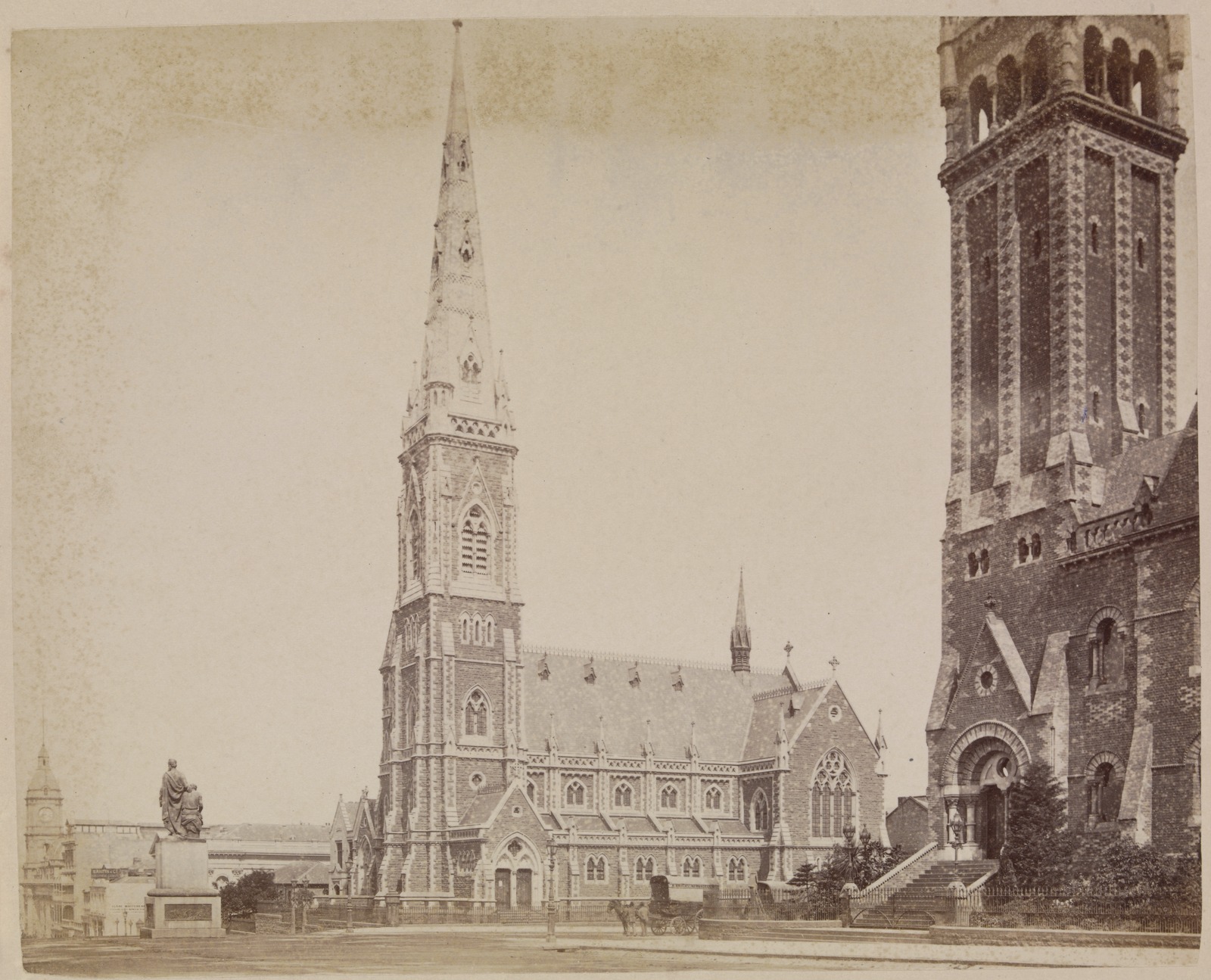
Photo: Scots' Church [picture] / C. Nettleton. Nettleton, Charles, 1826-1902 photographer. [ca.1880] – courtesy State Library of Victoria, item FL15921715
Alfred James and Caroline Hordern purchased acreage at Wahroonga - although 2 acres would be resumed in 1924 as a site for Waitara Public School. Caroline Hordern and Alfred lived in a cottage in Wahroonga while their house 'The Highlands' was being constructed.
Their eldest son, Alfred Roy, was born here on February 1st 1891. Their second son, Bruce Alexander (after his grandfather) was born in 1898, the birth registered this time at Woollahra. No announcement, as was run in Family Notices by other Hordern family members, appears for either birth.
Both boys attended the Church of England Grammar School at North Sydney. Both went into the family business after school. Both served in WWI.
This article suggests employees of this arm of the Hordern family saw the boys grow up and had a definite fondness for them:
Farewell to Lieut. A. Roy Hordern.
The presentation and dinner tendered on Monday last to Lieutenant A. Roy Hordern, of the Sixth Light Horse Regiment, A.I..F., on his departure to the front, were marked by a deep note of personal feeling, the young officer being a prime favorite with the whole staff in Hordern Brothers, Pitt-street, big establishment. It was an employees' function pure and simple. A presentation from all hands of a pair of Zeiss binoculars, case of gold-mounted pipes, rug, and fountain pen, was made on the main staircase, amidst much enthusiasm, at 6 p.m., while a company of some 60 of the old employees entertained the lieutenant at dinner at Baumann's Cafe later in the evening.
After the toast of "The King," the toast of "The Guest of the Evening" was also proposed by the chairman (Mr. W. G. Bean) and supported by Messrs. Caton, Cresswell, Hugger, Leigh, Morton, and Ruthe. Lieutenant Hordern cordially responded.
The other toasts were:— "The Guest's Parents," proposed by Mr. Hocking and responded to by Mr. A. J. Hordern and "The Visitors," proposed by Mr. Jackson, and responded to by Mr. E. Carr Hordern and Mr. E. D. Hordern. Musical and other Items by Messrs. Morton, Eyre. Fox. Hagger. Jackson, Leigh, Savage, Creak, and Lieutenant Hordern helped the success of a memorable evening. FAREWELL TO LIEUT. A. ROY HORDERN. (1914, December 18). The Daily Telegraph (Sydney, NSW : 1883 - 1930), p. 9. Retrieved from http://nla.gov.au/nla.news-article238882481
Roy proceeded to Gallipoli via the HMAT 'Lutzow' and joined the MEF on May 15th 1915. The Mediterranean Expeditionary Force (MEF) was part of the British Army during World War I, that commanded all Allied forces at Gallipoli and later Salonika. Its headquarters was formed in March 1915. The MEF was originally commanded by General Sir Ian Hamilton until he was dismissed due to the failure of the August Offensive. Command briefly passed to General William Birdwood, commander of the Australian and New Zealand Army Corps, but for the remainder of the Gallipoli campaign it was General Sir Charles Monro who led the MEF.
On May 27th 1915 a shell exploded beside him, knocking him unconscious, badly burning his face and damaging his eyes, his left eye left permanently damaged. It didn't kill him though. He was taken via the HMAS 'Newmarket' to the Stationary Hospital at Lemmos and by early June was 'improving'. On June 6th he landed back at Anzac Cove, and was promoted to 1st Lieutenant on June 21st.
By September he had severe diarrhoea and rheumatism - the dysentery becoming so bad he was hospitalised and eventually sent home on December 4 1915 to 'regain weight'. His War Record also states he was suffering from 'shell shock' along with the dysentery.
He'd enlisted in September 1914 and had served with the Sydney Lancers for 7 years prior to enlistment, being made a second lieutenant in 1912 with them. He became a member of the 6th Light Horse Regiment. Although he tried to re-enlist in 1916 a medical examination and board judged he was no longer fit for service on September 16 1916.
His enlistment papers describe him as being five feet 10 inches tall, with blue eyes and a dark complexion.
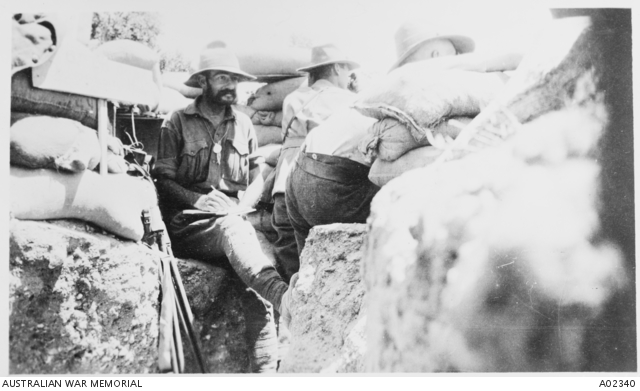
Photo: A bay in a trench occupied by members of A Squadron, 6th Australian Light Horse Regiment on Poppy Ridge. Signaller E D M Marsh, with beard, is in the left and Lieutenant R Hordern is in the centre, an unidentified soldier is to the right behind the sandbags. Photo courtesy Australian War Memorial
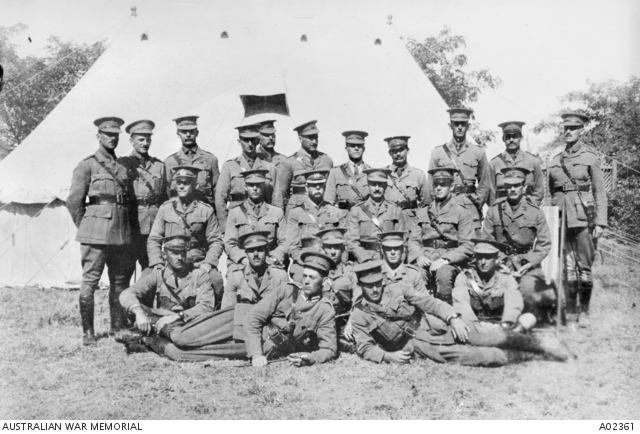
Group portrait of officers in the tent lines of the 6th Australian Light Horse Regiment. Back row, left to right: Identified left to right: back row: Captain (Capt), later Lieutenant Colonel, Michael Frederick Bruxner, (later DSO and Chevalier of the Légion d'Honneur) C Squadron; Second Lieutenant (2nd Lt) Harold Stewart Ryrie (later DSO), B Squadron, (died on 10 December 1919 of wounds received at Amman); Lt Dugald (Dougald) Drummond; (received severe gunshot wounds at Gallipoli and returned to Australia on 17 March 1916; Capt (later Major (Maj)) Harold Albert Duckett White, B Squadron; 2nd Lt. Henry Robson, C Squadron, (killed in action on Gallipoli, 24 July 1915); Maj Frederick Dudley Weedon Oatley, B Squadron (later died of disease 27 March 1919); Capt Arthur Verge, Medical Officer (later died of dysentery on 8 September 1915); Lt William Lang, Machine Gun Section, newly graduated from RMC Duntroon (later died on 13 August 1915 of wounds received at Lone Pine, Gallipoli); Capt (QM) Frank Richard, Quartermaster, Headquarters (HQ) (never saw active service on Gallipoli; returned to Australia 31 October 1915 as unfit for service following appendicitis and ulcerated stomach); Maj George Arthur Ferguson. Second row: Maj William Thomas Charley, A Squadron; Maj (later Lt Col ) Colin Dunmore Fuller, HQ (later DSO); Lt Col (later Brigadier General) Charles Frederick Cox, HQ; Capt (Adjutant) (later Lt Col) George Cattell Somervillle, HQ; Maj James Frederick White, C Squadron (returned to Australia 3 January 1916 suffering from enteric fever); 2nd Lt. Norman Matthew Pearce. B Squadron (later killed in action on 29 July 1916). Front row: 2nd Lt. Alfred Roy Hordern, A Squadron (invalided to Australia on 4 December 1915); 2nd Lt (later Capt) John Mackellar Chisholm, A Squadron, returned to Australia on 11 July 1917; Lt Warren Melville Anderson. B Squadron; Lt (later Capt) Cyril William Huxtable, C Squadron (a Duntroon graduate, wounded on Gallipoli and returned to Australia on 8 March 1917; 2nd Lt (later Maj) Harold Ormond O'Brien, A Squadron. Reclining in front: 2nd Lt. Donald Gordon Cross, A Squadron; Richardson (most likely Lt Rupert Noel Richardson, C Squadron (later died of wounds 17 September 1915. Photo courtesy Australian War Memorial.
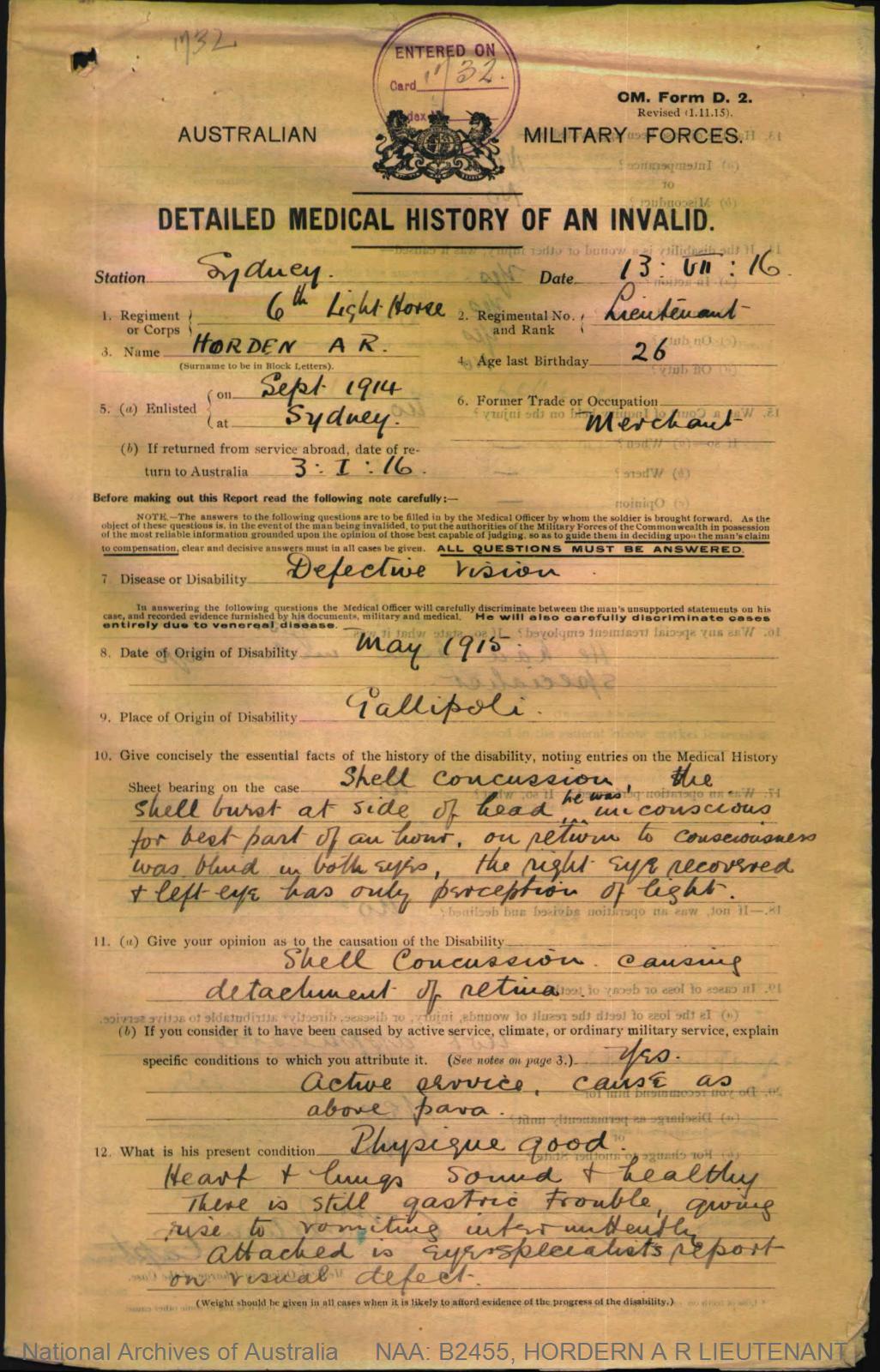
Roy headed back to England anyway, marrying a girl there in February 1917 in a London registry office who gave birth to his son later that year. The trio came home in February 1920.
The marriage did not succeed, with one 'Truth' expose citing the home at Palm Beach being used by him in November 1923 and a lady he was purported to be having an affair with and them going 'surfing'. They divorced in 1924, with Roy being denied access to his son by the judge, although his ex-wife did allow visits. His wife remarried and lived at Mosman, with Alfred recorded as being the person paying for his sons' attendance at Shore.
Bruce, described on his enlistment papers as 5 feet 11 and three quarters inches tall, also with a dark complexion and blue eyes and brown hair, had to wait until he was 19 years and three months old to enlist in 1916. Bruce served as a Gunner with the 11 FAB [Field Artillery Brigade] - 2 to 10 Reinforcements (April 1916 - February 1917) in France until the end of the war and stayed in London, supposedly from March 1919 until September 1919, to learn more about the buying branch business at 'Hordern Bros., Auckland House, 36 Basinghall street, London'. He was given leave to be there for six months, but was on a boat home a few months later.
His mother had to enquire of the authorities where he might be in 1916 and the family was again trying to find out more after he'd been granted leave:


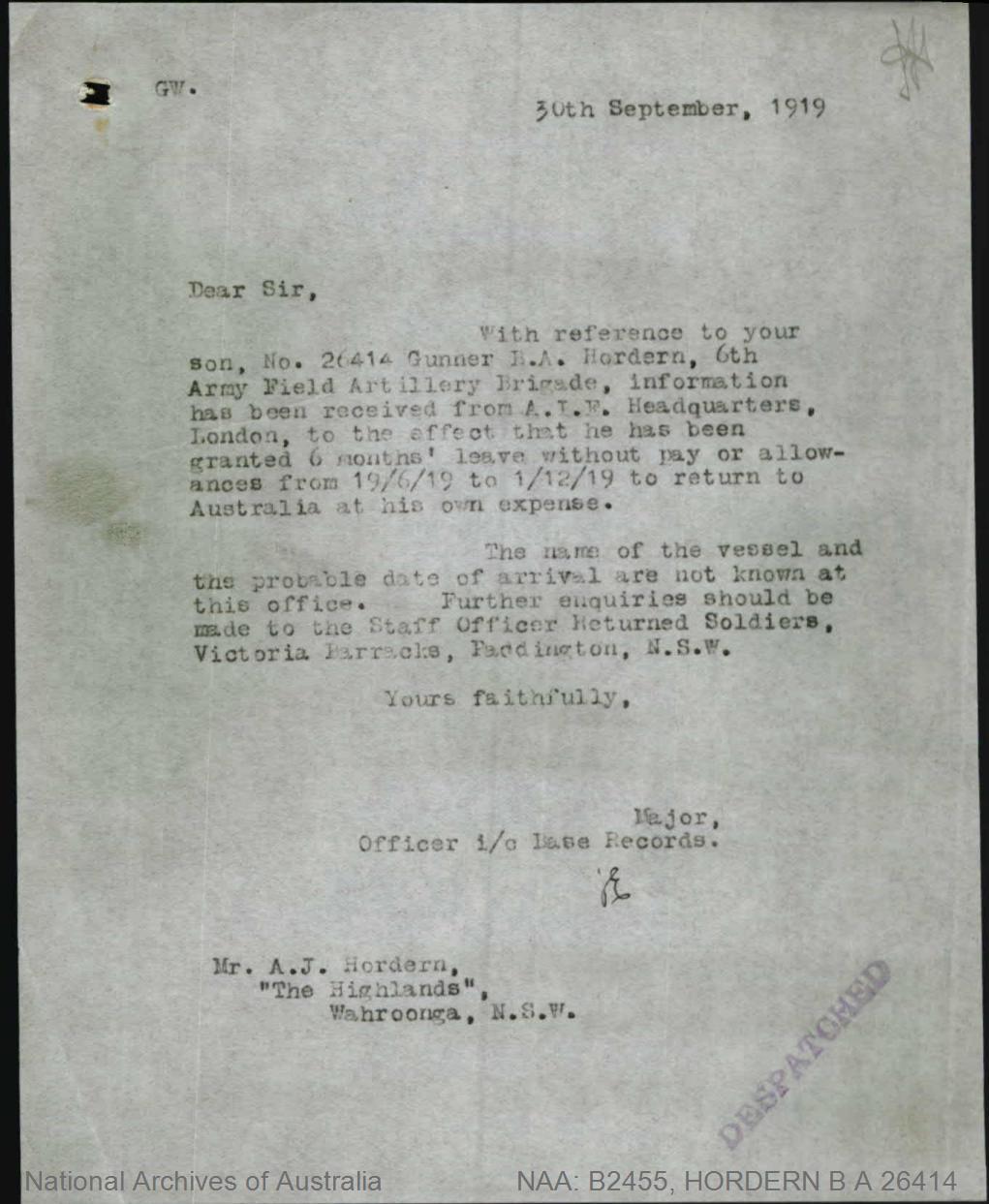
Bruce returned to Australia via the US - via the Ventura, disembarking on the 4th of November 1919:
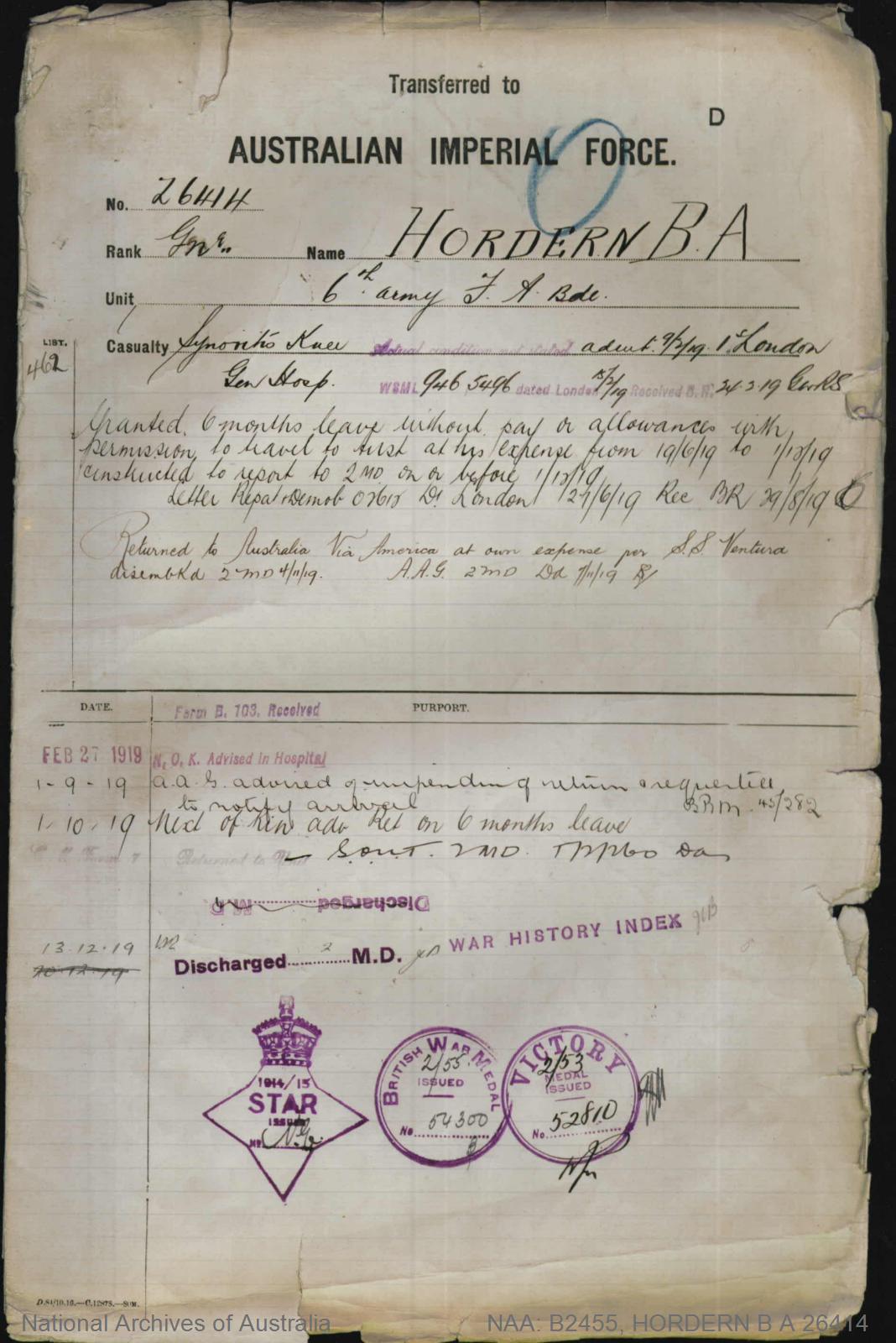
On their return the sons of Edward Carr Hordern and the sons of Alfred James clashed and Alfred James and his sons got out of the family business and went into selling cars (motors), not so successfully in Roy's case, although Bruce persisted. Roy also went into Metal Sprayers, supported by his father to the tune of £8000 and selling 12 months later for £3000 according to one newspaper report, and was also 'connected' with Continental Radio for a similar amount of time. His father also bought Roy, when married and with a son, a house at Wollstonecraft for £3150 in 1921-22.
Bruce went back to London and married his first wife in March 1921 in a London registry office.
Fortunately Roy and Bruce were coming home to a brand spanking new holiday home with sea air and water for respite and some form of recovery from what they had experienced.
No records that can be found name the Architect for 'Kalua' Palm Beach. However, those who were working and building bungalows and plantation houses in the area, which Kalua is described as, during the 1914 to 1920/21 period were Henry Wilshire, F. Trenchard-Smith and James Peddle of Peddle and Thorp, and Ross and Rowe. A few listings from Construction journals:
Barranjoey. — Erection of villa, Palm Beach. H. A. Wilshire and Day, architects; Platt and Halstead, builders, Palm Beach. BUILDING INDUSTRY & MACHINERY (1915, March 1). The Sun (Sydney, NSW : 1910 - 1954), p. 8 (FINAL EXTRA). Retrieved from http://nla.gov.au/nla.news-article229331862
Palm Bench, Mr. B. Verrills, Palm Beach; stone retaining wall.
Palm Beach; Mr. G. Gallager, Palm Beach; Interior decoration, painting, etc., at Villa, Messrs. James Sandy and Co., contractors. VARIOUS WORKS. (1915, May 11). The Daily Telegraph (Sydney, NSW : 1883 - 1930), p. 3. Retrieved from http://nla.gov.au/nla.news-article239039382
Palm Beach, the Samson Concrete Company, contractors, small concrete bungalow.
Palm Beach, Mr. B. Verrills, builder; additions to residence, GENERAL NOTES (1917, July 11). The Sydney Morning Herald (NSW : 1842 - 1954), p. 6. Retrieved from http://nla.gov.au/nla.news-article15743324
Palm Beach — Bungalow Undated — Peddle and Thorp, 8 Spring-st, Sydney. Advertising (1917, September 10). Construction and Local Government Journal (Sydney, NSW : 1913 - 1930), p. 3. Retrieved from http://nla.gov.au/nla.news-article109673172
Palm Beach— Erection of week-end cottage. H.. E. Ross and Rowe, architects and consulting engineers. BUILDING AND TENDERS. (1917, October 30). The Daily Telegraph (Sydney, NSW : 1883 - 1930), p. 9. Retrieved from http://nla.gov.au/nla.news-article239237288
Palm Beach.— Erection of cottage (concrete) ; Wilshire and Day, architects; A. G. Derriman, builder, Balfour-road, Rose Bay. BUILDING-INDUSTRY & MACHINERY (1917, September 17). The Sun (Sydney, NSW : 1910 - 1954), p. 7 (FINAL EXTRA). Retrieved from http://nla.gov.au/nla.news-article221410476
Palm Beach.— Erection of week-end cottage, Ross and Rowe, 350 George-Street BUILDING, INDUSTRY & MACHINERY (1917, November 5). The Sun (Sydney, NSW : 1910 - 1954), p. 7. Retrieved from http://nla.gov.au/nla.news-article221393205
Mr. F. Trenchard Smith. — Bungalow, Palm Beach. BUILDING, INDUSTRY AND MACHINERY (1919, October 20). The Sun (Sydney, NSW : 1910 - 1954), p. 11. Retrieved from http://nla.gov.au/nla.news-article222290426
Tenders Accepted - Palm Beach— Residence - J. Peddle & Thorp. Builder: J. B. Black, Schwebel Street, Marrickville. Advertising (1920, March 29). Construction and Local Government Journal (Sydney, NSW : 1913 - 1930), p. 1. Retrieved from http://nla.gov.au/nla.news-article108989612
The Moorings at 93 Florida Road, Palm Beach, (built 1915-1920) was designed by James Peddle, Craigie Lee at 35-37 Sunrise Road was another of his. Marara at Careel Bay, built around 1917 as a beach house for Dr James Frederick Elliott (1858-1928), a pharmaceutical chemist and chemical engineer and a noted yachtsman, with a town residence in Point Piper, is also believed to be the work of architect James Peddle of Peddle & Thorp
James Peddle was a master furniture craftsman with knowledge of the English Arts and Crafts movement. In 1889 he supervised a commission for the new impressive Australia Hotel. At this time he established an office as an architectural artist with a focus on residential projects. Samuel G Thorp joined the office as an articled pupil in 1902, becoming a partner by 1915.
James Peddle encouraged his staff to travel, study and work overseas. He himself travelled to the USA in 1912 to qualify as an architect in California. Mr. Peddle settled in Pasadena and set up an architectural practice enabling the pursuit of climate-appropriate bungalows integrated with new technologies. On his return to Sydney in 1915, he championed healthy living through the design and construction of housing responsive to Sydney’s climate and geography.
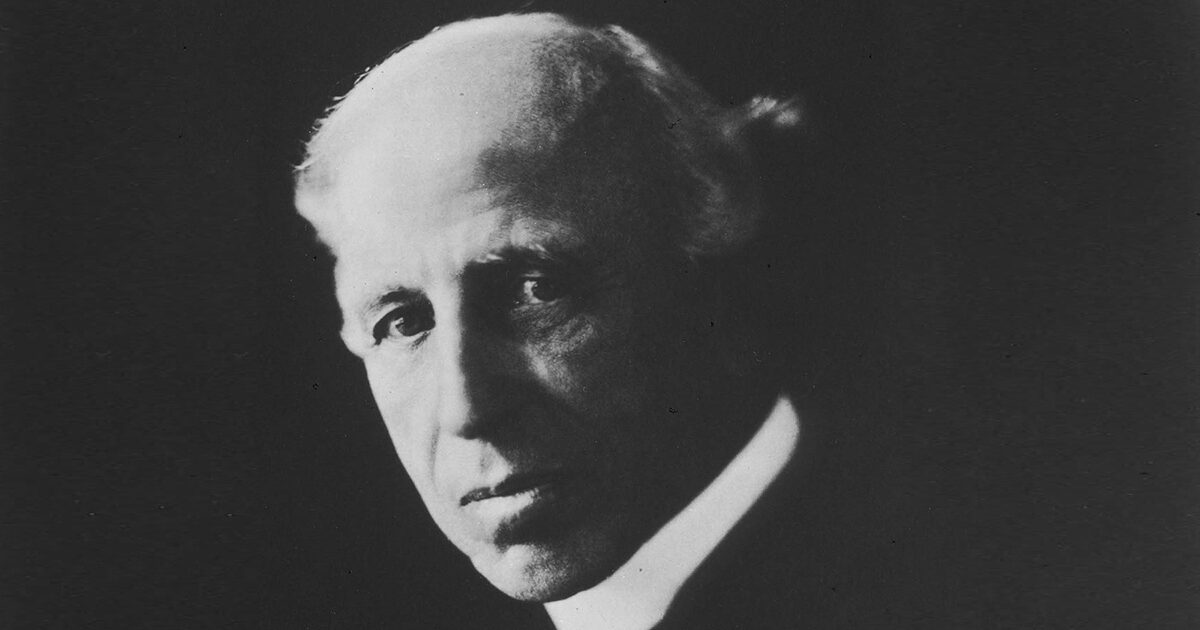
Pictured: Portrait of James Peddle (c.1920’s, May and Mina Moore Photographer) from; https://ptw.com.au/practice/history/1889-1919
His philosophy on his return was widely publicised and created a shift from purely Federation built homes to Federation- Plantation style homes for Sydney, of which many examples still stand. Plantation Style is timber-built for the breeze with balconies, verandahs, and porticos, combined with a Federation style variant showing the typical gables and rafter ends.
You can read about it in:
SOME LESSONS WE CAN LEARN FROM OUR AMERICAN NEIGHBORS Address given to the Health Society of N.S.W. at Government House, Sydney, by James Peddle, F.I.A., N.S.W. (12 October 1916) Federated Builders' Association of Australia & Master Builders' Federation of Australia. (first published 1907). SOME LESSONS WE CAN LEARN FROM OUR AMERICAN NEIGHBORS Address given to the Health Society of N.S.W. at Government House, Sydney, by James Peddle, F.I.A., N.S.W., Building : the magazine for the architect, builder, property owner and merchant Retrieved from http://nla.gov.au/nla.obj-273752220
This is also under Extras below.
Most of the Real Estate listings for this property cite the Dillingham plantation-style home at Oahu Hawaii as the inspiration, a 1917 erected open pavilion style with surrounding verandahs structure.
However, as Caroline is reported in family records to have spent sometime in Fiji when her father still had interest there, the open pavilion and plantation style buildings that predominated that other home may have been an influence as well.
The Enemark Palm Beach panoramas help date what is in them and what was built in approximately which year when combined with insights from Warringah Shire Councils' Minute of Meetings. This one from the Meeting held on June 14th, 1920 tells us:
27. Barrenjoey Co , 31/5/20, intimating that the Company does not desire a local rate levied at Palm Beach ; Received, 28. Barrenjoey Co. , 31/5/20 asking that steps be taken to prevent the removal of sand from Beach Road, Palm Beach. Resolved - (Crs. Quirk and Lodge) That Mr. Peters be informed of the Company's report, and that he be notified to desist. 29. Barrenjoey Co., 31/5/20, drawing attention to washaway on Florida Road ; Referred to Engineer.
.jpg?timestamp=1588460653833)
Enlarged section from EB Studios (Sydney, N.S.W.). (circa 1917). Panorama of Palm Beach, New South Wales, 2 Retrieved from http://nla.gov.au/nla.obj-162481294 - section from showing Peters home with tents still in it (Summer) and Chorleys holiday home already built.
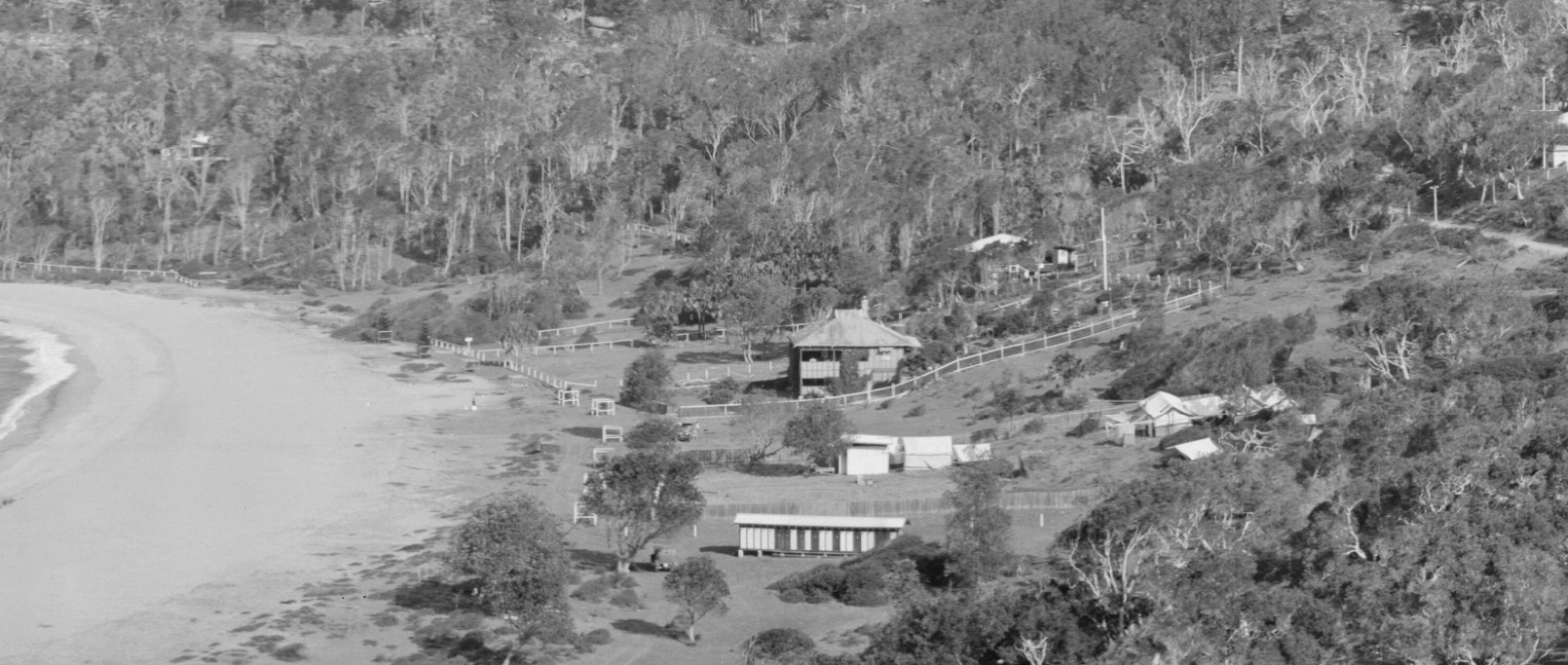
Panorama of Whale Beach (Palm Beach), New South Wales [picture] / EB Studios. EB Studios (Sydney, N.S.W.). (1917). Panorama of Whale Beach, New South Wales Retrieved from http://nla.gov.au/nla.obj-162483691 section from showing Peters home not built, and Chorleys holiday home already built, and bush and some lawn on Hordern Lots.
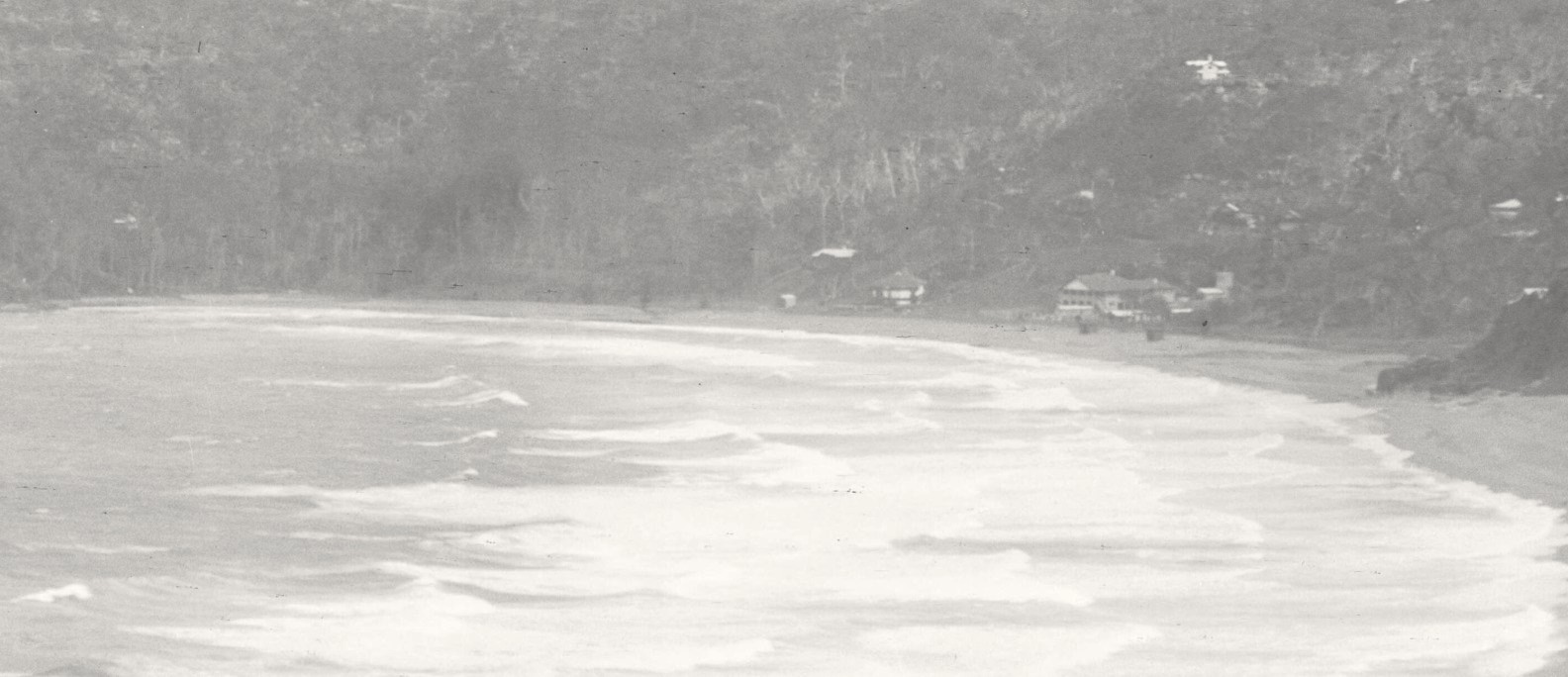
This section from Panorama of Palm Beach, New South Wales, 14 shows the Peters place finished but only bush at the other end of the beach. EB Studios EB Studios (Sydney, N.S.W.). (circa 1920). Panorama of Palm Beach, New South Wales, 14 Retrieved from http://nla.gov.au/nla.obj-162567120
The position of the house, as sited, may suggest the plans and layout had been approved prior to the purchase of Lot 86. The house hasn't been placed in a central location on the 3 beachfront lots, it's been restricted to just one, the southernmost.
These photos, taken for a pamphlet for Avalon Park Estates by Rex Hazlewood, that was sold from December 1921, show Kalua in place prior to then, while the left edge of one taken from the then Palm Beach Rockpool shows the sandstone steps leading up to the property and the building at the front near the gate are still being constructed, intimating the house as built 1920-1921 and the steps and that building completed in late 1921:
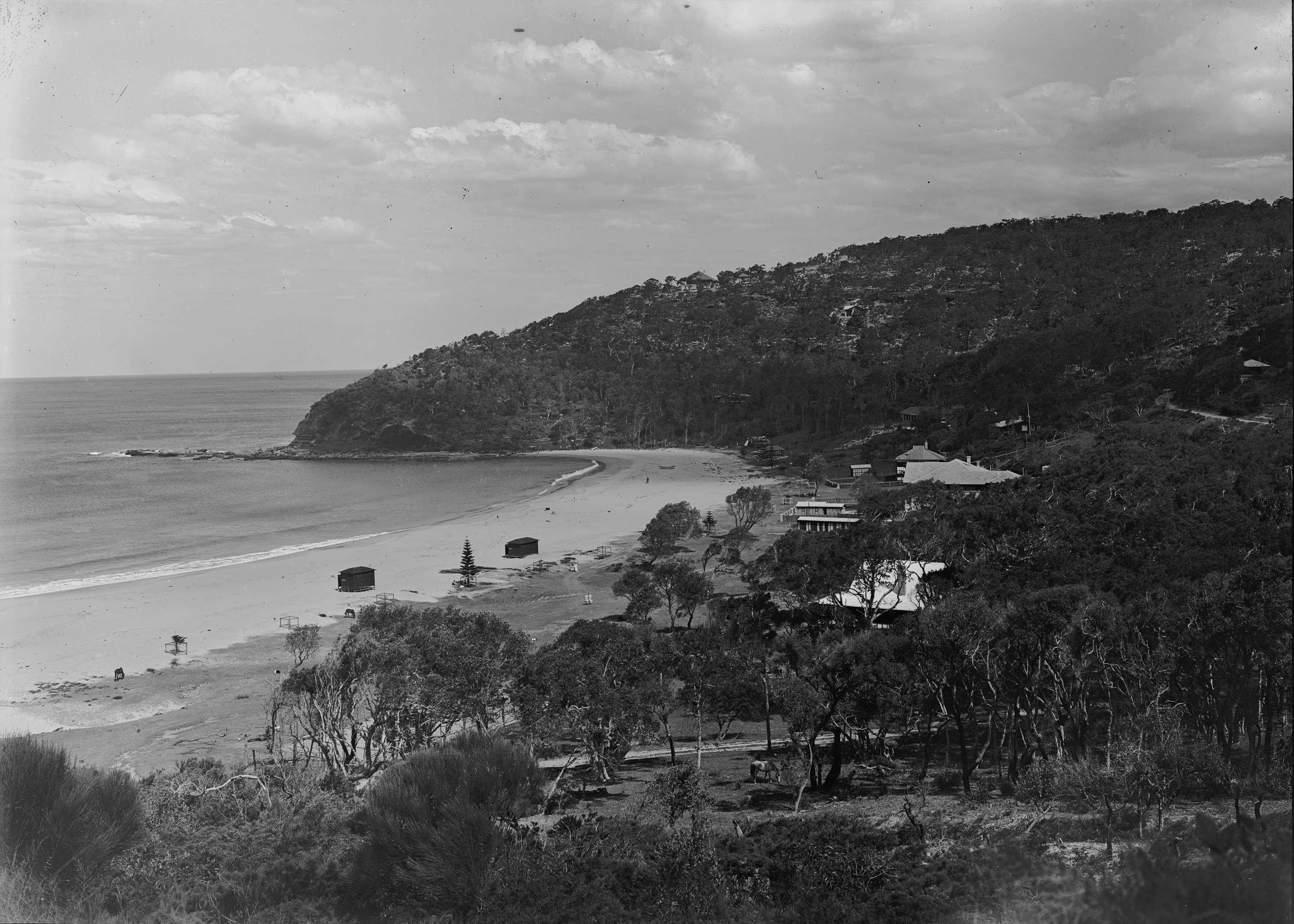
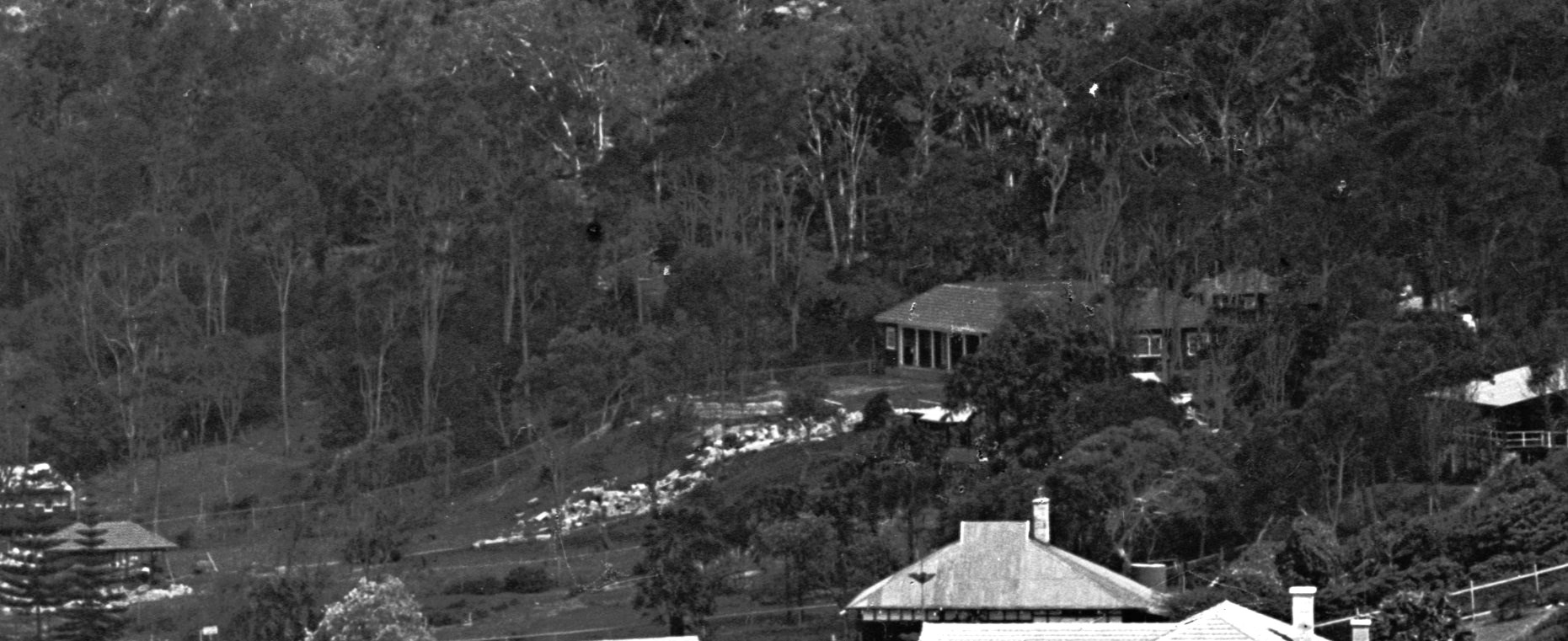
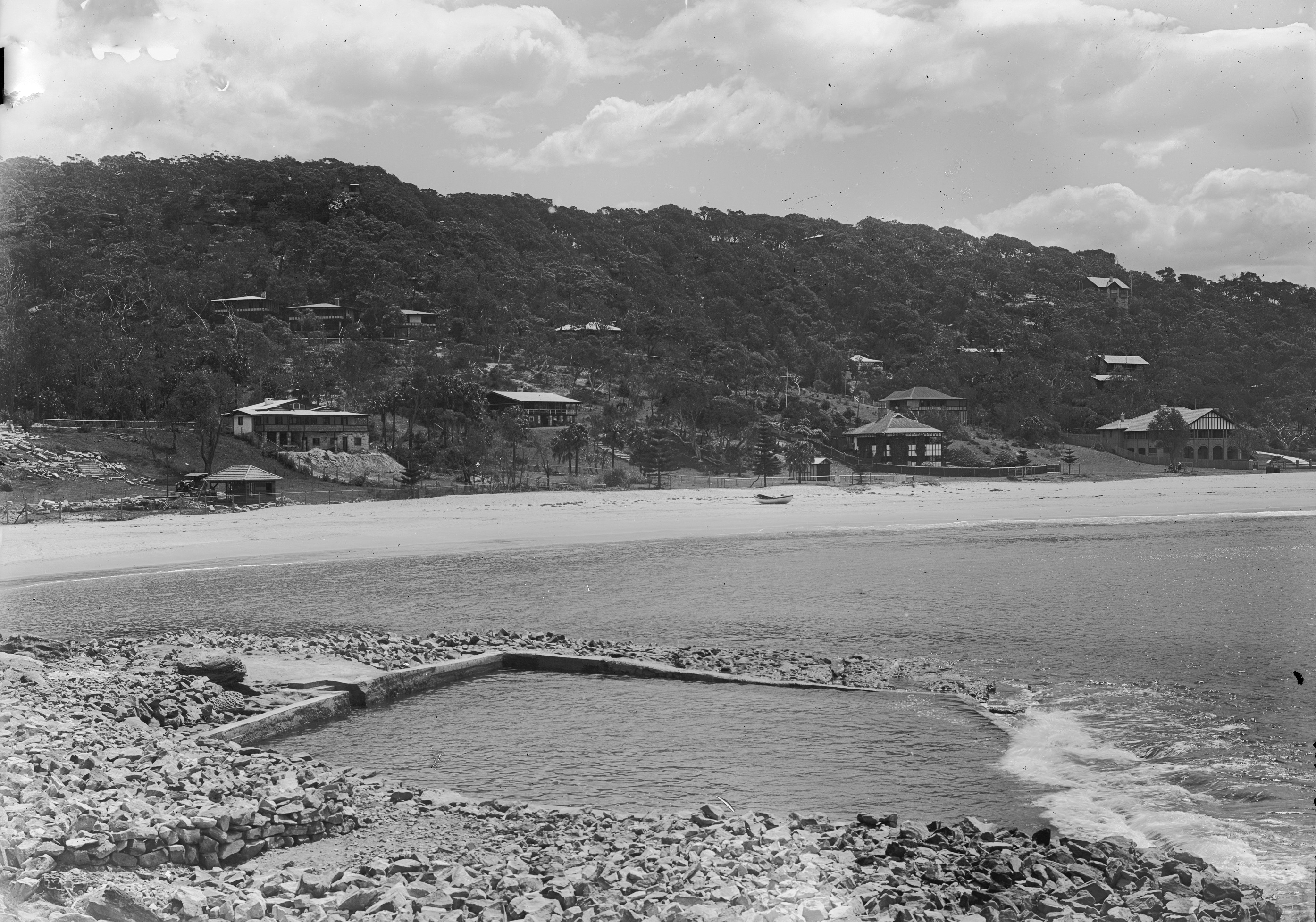
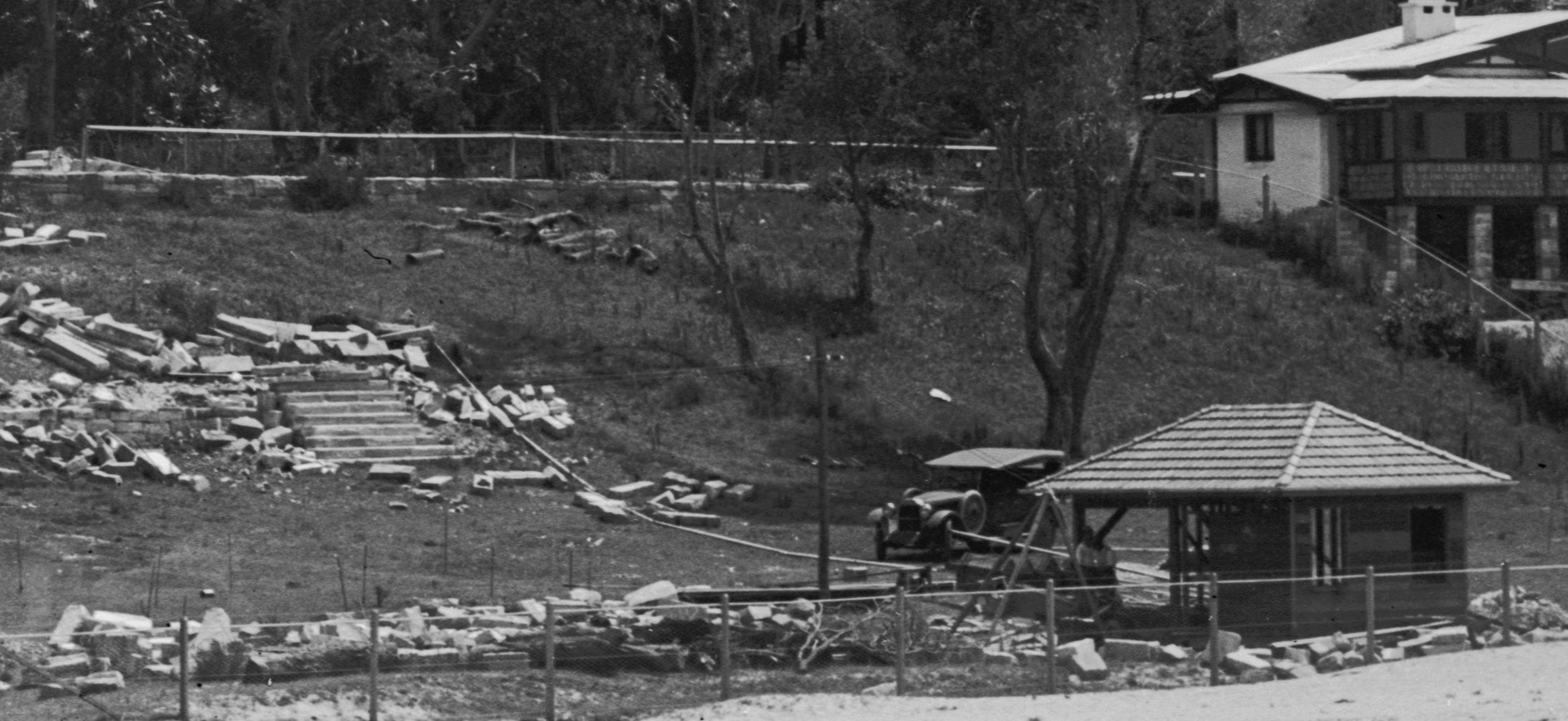
So it would appear that the offices of James Peddle and Thorp were responsible for the drawings and J B Black of Marrickville was the builder. This would fit in with Mr. Peddle's experience in championing this kind of American style bungalow as more suitable for our climate and lifestyle. This also places the construction between March 1920 and completed prior to December 1921. Clearly the first Summer for the Hordern family at 'Kalua' would then be the Season of 1920/1921.

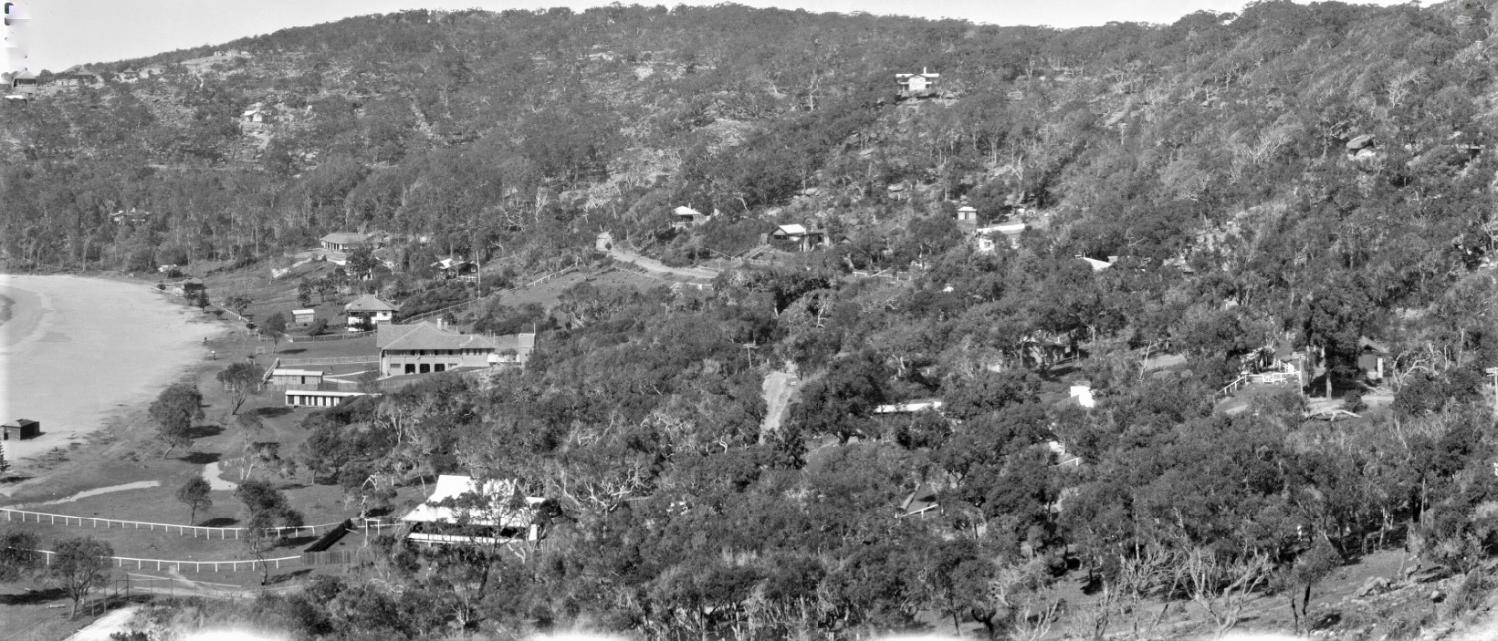
EB Studios (Sydney, N.S.W.). (circa 1924-25). Panorama of Palm Beach, New South Wales, 6 Retrieved from http://nla.gov.au/nla.obj-162484292 - taken from Sunrise Road - views south over towards estuary with Pacific (going up the hill) visible as well as Palm Beach Road where joins Florida and where Livistonia Lane now is.
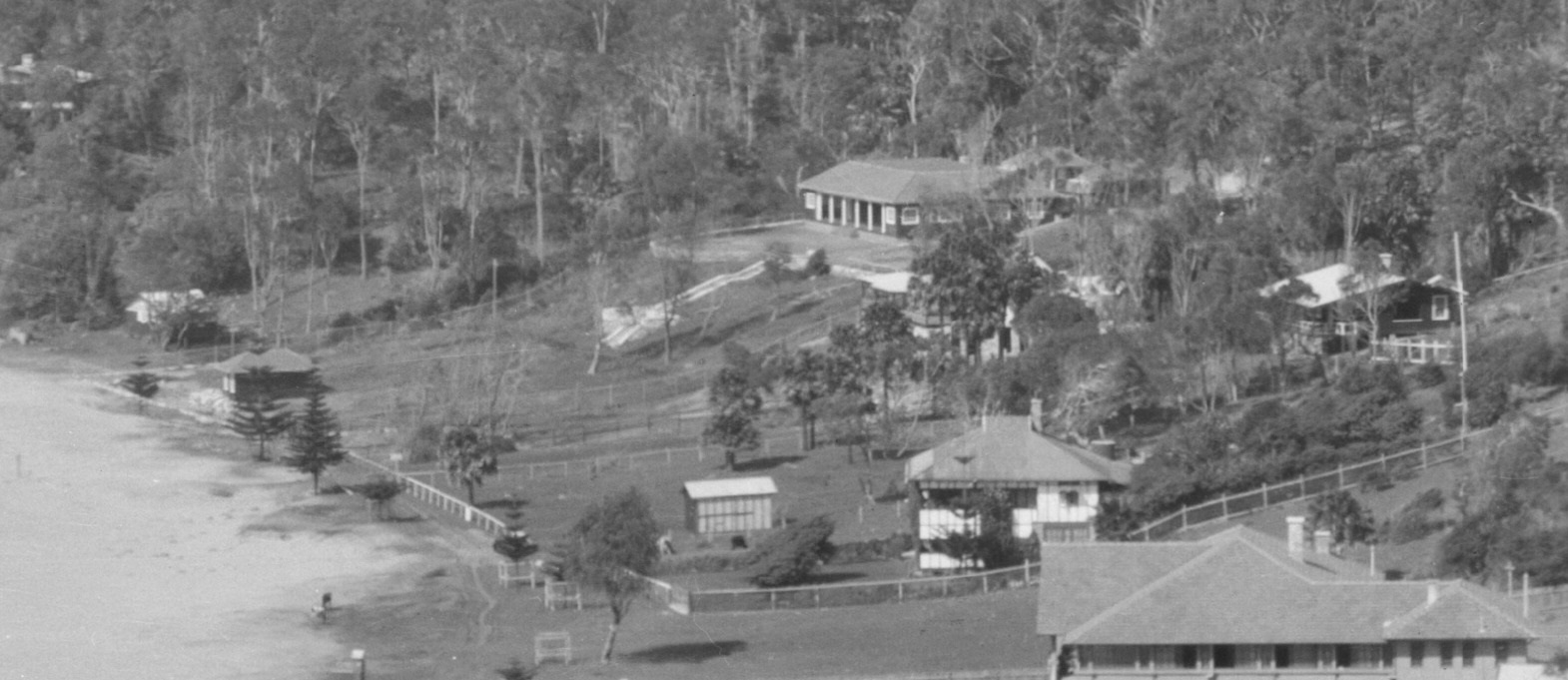
In this section from panorama 6 the footprint of the roof around the back piazza, the roof footprint of the caretakers cottage, and the front of yard building are visible. The bush-house for flowers that would be built at the side of the home is not visible as yet. The steps are finished, as is the building at the fence edge in the front yard.
Part of second images taken, possibly for either 1922 subdivision of lots above Golf Course or when Willmore and Randell acted on behalf of Palm Beach Land Company from July 1924 on. The roof footprint of 'Kalua' can be clearly seen to the south, along with an outline of the sandstone steps. The same panorama appears in a January 8 1926 advertisement in local newspapers:
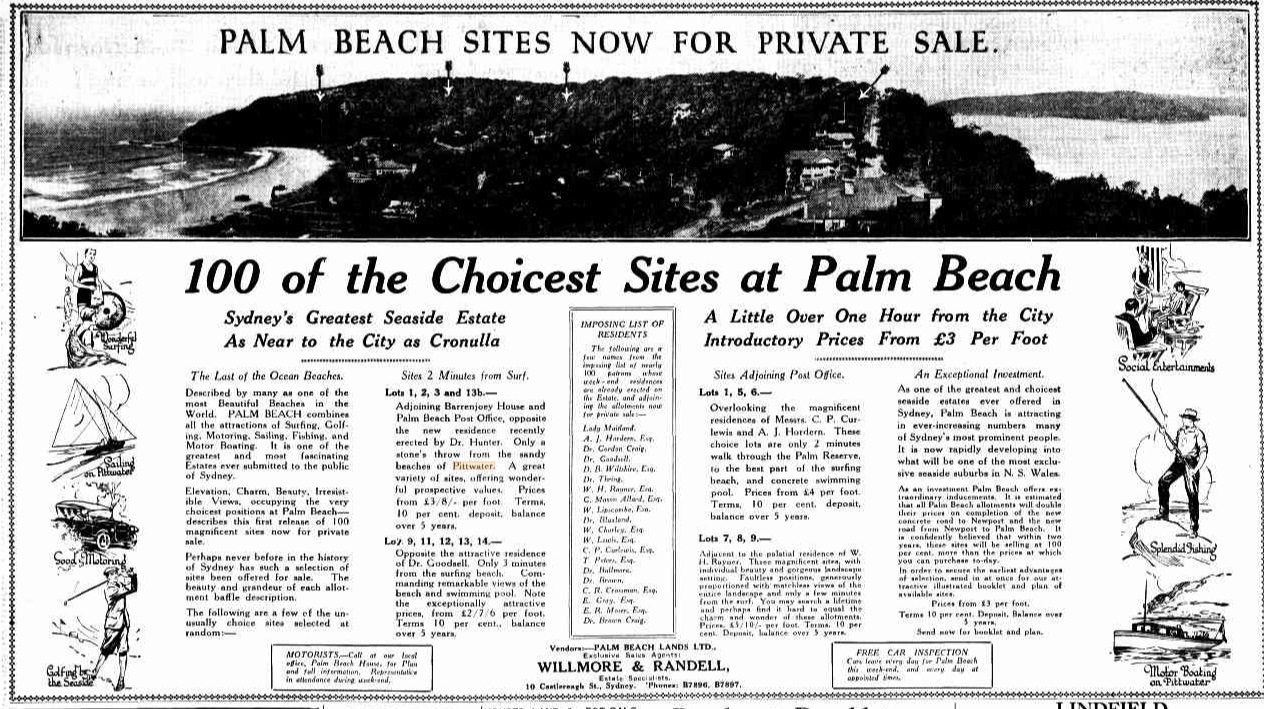
.jpg?timestamp=1706834479852)
EB Studios (Sydney, N.S.W.). (circa 1921-23/24). Panorama of Palm Beach, New South Wales, 7 Retrieved from http://nla.gov.au/nla.obj-162484891 - enlarged sections from to show the Hordern place details.
The Hordern fondness for Hawaiian culture is also recorded in:
Hawaii at the Wentworth
The very best and gayest dinner dance ever given at the Wentworth Cafe was the general verdict passed on the Hawaiian night organised by Mrs. Maclurcan on Friday. Both Sydney and country people alike were delighted with the great hanging Hawaiian baskets (which later spilled a multitude of balloons over the dancers), the fascinating table favors, including most grotesque, but most lovable dolls, and the originality of the caps. It was significant of the spirit of the gathering that not one of the hundreds of guests failed to wear the leis, so that its vivid orange made gay the most sombre frock, and caused the men to look quite festive also.
In addition to the excellent orchestra, which was encored and encored after every dance, there were delightful Hawaiian numbers by a ballet dressed in Hawaiian costumes. Then Mr. Giennie and Miss Johnson were seen in two charming dances.
Mr. and Mrs. Ralph Houston entertained a large party. Mrs. Houston wore a handsome gown of moonlight blue brocaded velvet over gold tissue. Their guests were Mrs. MacMillan from Gippsland, Miss Stephen (Albury), Miss Kath Pasco, Mr. Lionel Griffith (Albury), Mr. Dick Kirby, and Mr. Jim Houston.
In Mr. and Mrs. Reg Inglis' party were Mr. and Mrs. Todman, Mr. and Mrs. F. Pfeiffer, Mr. and Mrs. J. Balfe, Mrs. Spencer Watts, Miss Rolleston, Mr. Clive Smith, Mr. Sid Garrett. Mrs. Inglis wore a frock of black brocade with Chantilly lace sleeves.
Mr. and Mrs. R. K. Waley entertained Mr. and Mrs. Ivo Clarke, Miss N. Matthews, and Mr. J. Hyndes. Mrs. Waley was in blue charmeuse. Mrs. Clarke wore orange silk crepe with a design in black worked on the skirt.
Others in the great ballroom were Miss Argie Mitchell, wearing jade green; Miss Judy Coombe, in black brocaded with silver; Mrs. Leslie Mailler; Mr. and Mrs. A. J. Hordern, Mr. and Mrs. Read, Miss Lily Hickey, Mrs. H. Muston, Mrs. Berk, Mrs. Audette, Mr. T. A. Stirton, Mrs. W. R. Armstrong, Mrs. Percy Walker, Mr. L. Falkiner. Miss J. Clarke, Mrs. Gee, Mrs. Leslie Marshall, Mr. J. Robertson, Doctor and Mrs. Langton, Mr. and Mrs. J. B. Dowling, Mrs. Josephson, Miss Doreen King, Miss Nea Cohen, Mr. Saywell. Hawaii at the Wentworth (1923, July 8). Sunday Times (Sydney, NSW : 1895 - 1930), p. 19. Retrieved from http://nla.gov.au/nla.news-article120544521
Palm Beach during the early 1920's became the 'go to' place for Sydney. This has been occurring in the years prior to then, ever since the Barrenjoey Land Company began subdividing the land into Lots, many of which quickly sold. Chorleys' 'The Rest' had been the host venue for gatherings, while the Palm Beach Boarding House was another that gave people access to the then out-of-the-way and cut off beach which needed to be accessed via the estuary due to the state of the 'track' there:
At 7.30 on Monday morning a. very enthusiastic crowd of 80 to 100 friends assembled on the wharf at Palm Beach, Barranjoey, to bid farewell to Mr. W. Chorley and Mrs. Chorley and their daughters, of 'Mount Pleasant,' Cheltenham. The family have been staying over the holidays at 'The Rest,' which is their pretty seaside residence facing the ocean, and situated at Palm Beach.
At 'The Rest' friends were right royally entertained, and received the Chorley family's usually abundant hospitality. Croquet tournaments were played, surf parties and plenty of music were indulged in, and altogether the holidays were very delightfully spent. There was great rejoicing when Mr. Chorley's private launch came alongside the wharf, which was overcrowded with sincere friends.
The Hon. W. Tyler, of South Australia, made a most humorous speech; and Mr. Chorley responded in his usual happy way, and hoped that they and their friends would all be spared to meet again next Christmas. All joined hands and sang 'Auld lang syne' whilst the launch drew out from the wharf and steamed down the river. PERSONAL PARS. (1915, January 13). The Cumberland Argus and Fruitgrowers Advocate (Parramatta, NSW : 1888 - 1950), p. 3. Retrieved from http://nla.gov.au/nla.news-article86103157
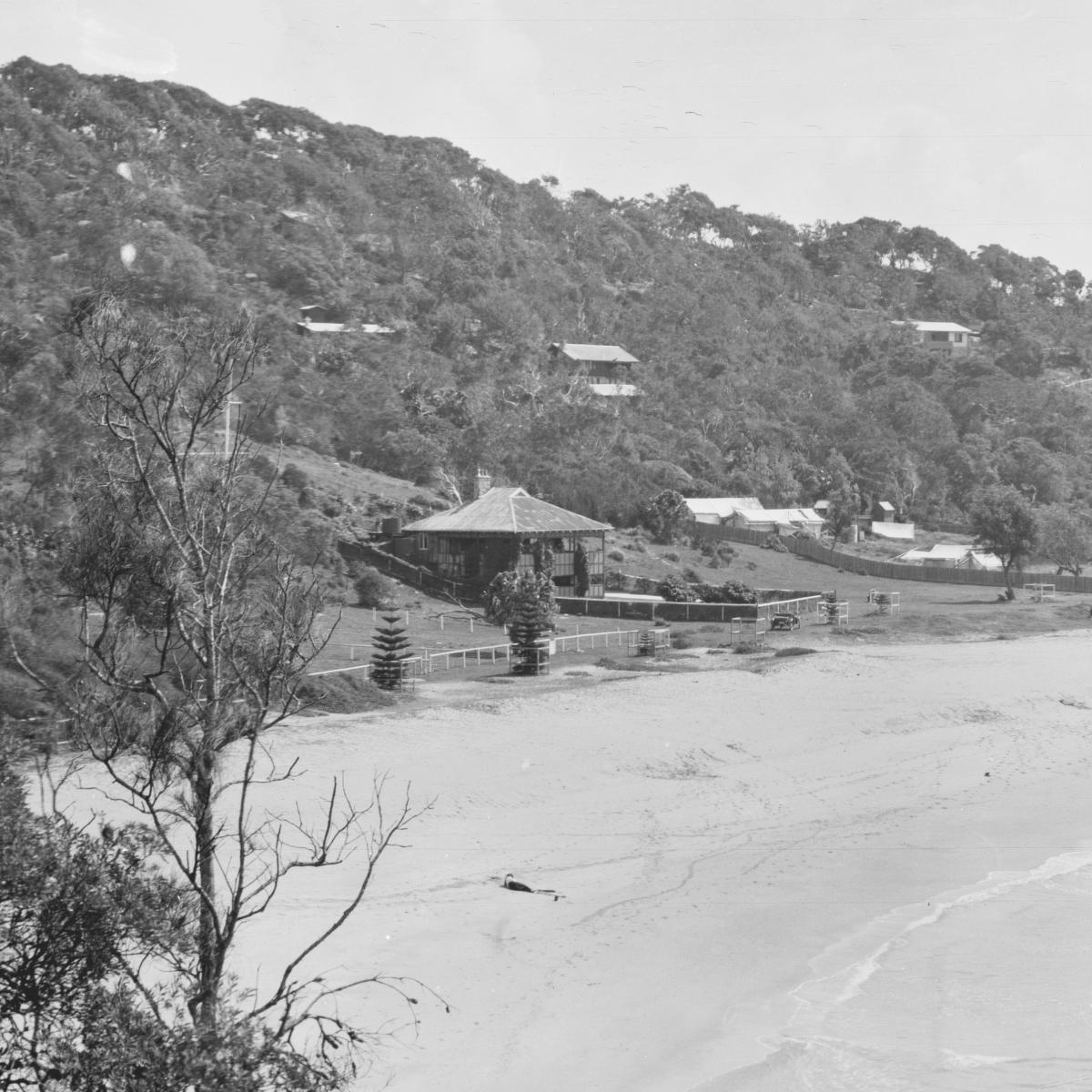
Tragically, people began to lose their lives at this popular beach:
DROWNED AT PALM BEACH
BODY IN THE BREAKERS
A tutor, Walter A. Corry, of Whitton, was found drowned In the surf at Palm Beach late on Tuesday afternoon. He arrived in Sydney recently, and was staying with his sister. Mrs. Budge, in Holdsworth-street, Woollahra, He was a tutor at Mr. J. J. Taylor's station, Whitton, for some years. When the body was recovered the name was unknown, but Identification was established late yesterday by 'Mr. Andrew Sherard, of Whitton, in Sydney, on his way home from Victoria.
The body had not long been in the water when It was recovered. Mr. Meggitt, a resident, was walking along the beach when he saw the body in the breakers. Constable Grant, Mona Vale, was informed, and later he secured it. There was a gash on the forehead which had evidently been caused through contact with rocks. DROWNED AT PALM BEACH (1920, March 11). The Sun (Sydney, NSW : 1910 - 1954), p. 3. Retrieved from http://nla.gov.au/nla.news-article221380215
However, it was the drowning of another just returned Australian from the European World War One theatres of war that sparked action. A young soldier aged just 24, while picnicking at Palm Beach, drowned in heavy surf trying to rescue a swimmer caught in a rip. His death and the death of the woman he dived into save, was instrumental in the formation of the Palm Beach SLSC.
Although her body was later recovered, his was never found.
Newspaper reports carried the tragedy to their readers far and wide, some even reporting the rescuers had to run over the hill to the store at Gow's wharf to telephone for help, there being no Ocean road yet at Palm Beach, the only access, and telephone, was over the Palm Beach road. Jean Curlewis, sister of Adrian Curlewis, in her book 'Beach Beyond', a fiction work based on early days at Palm Beach, speaks about this tragedy. Her brother was on the sand that day, as was good friend, 'Jack' Ralston.
At Black Rock, close to the Palm Beach Pavilion, an information board installed by Pittwater Council, once informed visitors of this man's heroism:
Adrian's daughter Philippa, while speaking about what would run in her account shared here years ago, The Breakers at Beach Beyond 1901 – 2011, spoke about her father being on the beach that day and being witness to the drowning. The incident sparked him, Jack Ralston and other local full-time Palm Beach residents, after a meeting by called by the organisation then known as the Palm Beach Progress Association, and the drowning of another in March of the same year, to hire a life saver for the coming 'season', finding Austin Dellit - a foundation member of 'The Wombats' camp at Collaroy, from which the Collaroy SLSC would be formed in 1911, and soon after form the Palm Beach SLSC.
A little from those pages of the past about this Mr. Marks' service as an ANZAC and that tragic incident - the Ralston spoken of in this first account is the son of John Ralston, one of the Directors of the Palm Beach Land Company:
BEACH TRAGEDY.
A LOST HERO.
GIRL ALSO DROWNED.
MAGNIFICENT RESCUE ATTEMPTS
SYDNEY, Sunday.
An epic tragedy, in which the sadness of death was brightened by cool unflinching heroism, was enacted at Palm Beach, a seaside resort near Broken Bay, this afternoon, when Johanna Rogers, 33 years of age, of Leichhardt, and Lieut.-Colonel Marks lost their lives in the surf.
The picnics party arrived, at the beach, which is far removed from habitation, about mid-day, and shortly afterwards, several of them went into the surf. Johanna Rogers got into difficulties and was carried out to sea.
It was some minutes before her plight was noticed, when two members of the party unhesitatingly plunged in and attempted to swim out to her. But the distance was too great, and the would-be rescuers were compelled, by a common-sense regard for their own lives and recognition of the uselessness of trying to go further without life-lines, to return to the beach, where they fell down helplessly exhausted.
Then a life-line was improvised out of tent ropes and the like, and with this fastened to him, Lieut.-Colonel Marks went out into the breakers. He passed the three lines of surging waves successfully, and was well out into the rolling water beyond, when the line broke. Thereafter the gallant soldier was seen no more.
Other members of the party, undeterred by this tragic event, made repeated efforts to reach the two, fighting for life against current and waves, and eventually a man named Ralston, after a tremendous fight with the pounding waves, reached the girl.
Already very weak from his long and exceptionally hard swim, Ralston seized the still body and doggedly turned back towards the beach.
Then began a battle for life such as has never been seen before on the Australian Pacific coast. Time after time his companions on shore, some already worn out by their efforts, praying for his success, saw him go under; time after time he struggled to the surface again and forged desperately on towards the shore and safety. Fierce waves rolled him over, tossed him about, played with him and the girl which they had claimed as victim, like corks, but he plunged on and on. After what seemed an age to the agonised watchers on the shore, he got into the breakers and was swiftly carried into shallow water. Willing hands pulled him and the girl on to the dry sand, and feverishly set about trying to restore animation in the still body of the girl.
But their efforts were in vain. She was dead.
Ralston soon recovered from his ordeal, and with several others of the party who narrowly escaped drowning themselves, accompanied the saddened party to the nearest habitation, whence the police were communicated with.
There has been no further news of Lieut. Colonel Marks. BEACH TRAGEDY. (1920, January 30). The Urana Independent and Clear Hills Standard (NSW : 1913 - 1921), p. 6. Retrieved from http://nla.gov.au/nla.news-article116182266
PALM BEACH DROWNING
Colonel Marks' Bravery Evidence at Inquest
The circumstances surrounding the fatality at Palm Beach on January 25 were recalled this morning at an inquiry by the City Coroner (Mr. Jamieson) into the deaths of Miss Johanna Mary Rogers and Lieutenant-Colonel Douglas Marks. The latter lost his life in an attempt to save Miss Rogers, who had been carried out by the surf. His body has not yet been recovered.
Dr. S. N. Bray said he was bathing at Palm Beach when the life-savers brought in Miss Rogers' body. Witness tried unsuccessfully for an hour to restore animation.
Herbert Leslie McDonald, an accountant, living at Moruben-road, Mosman, stated that Colonel Marks was his brother-in-law. He was 24 years of age, and was a company manager. Marks was fair swimmer and had been decorated with the D.S.O., M.C., and Order of the White Eagle of Serbia. He arrived home from the war in December 1918, and was unmarried.
Story of Tragedy
"I was with him at Palm Beach on January 25," continued witness. "About 3 p.m. I heard a commotion, and, looking round, saw a woman a long way out in the surf, and two men holding her up. I ran towards the beach. Looking to the sea, I noticed that the men had had to leave the woman, and were coming back.
"Going along the beach, I saw my brother-in-law with a piece of clothes line, with a knot in it, wound round his waist. He was about to go out to the woman, and was accompanied by Messrs. Bromly and Hendry. After they had gone about twenty-five yards the three got into difficulties.
"The current was strong. Bromly called out a warning to the other two. Hendry evidently heard him, and made back for the shore; but Marks went on about another ten yards. He then threw up his hands. Hendry and Bromly had to be assisted out.
Where was the Life Line?
"I rushed in with my clothes on to go to Marks. The proper life-line could not be found. The crowd was holding on the line round Marks. There was a lot of excitement. I got more than half-way to Marks, when I was compelled to re-turn as I was hopeless trying to reach him. By the time I had turned to come in he had disappeared. It was not the usual bathing place."
Edward James Rogers, a butcher, of Leichhardt, said that Miss Rogers was his sister. She could swim, and had been in the habit of going surf bathing.
Horace James Hendry, an accountant, residing at Chatswood, said that he got within 20 yards of Marks when he lost sight of him. "Marks," added witness, "had on sand-shoes, trousers, and shirt, and was sucked down."
Holland Hodgson Wright, a wool appraiser, of Cremorne, stated that he recovered the woman's body. Witness, who is a member of the Cronulla Life Saving Club, said the whole of Palm Beach was dangerous to strangers who did not know it.
The Coroner's Remarks In recording a verdict of accidental death by drowning in each instance, the Coroner said "I feel sure that every-body concerned did their utmost to rescue this unfortunate woman. Unfortunately one of the bravest, Lieutenant-Colonel Marks, lost his life.
"It seems particularly sad that one who performed such glorious deed at the war and came through safely should have lost his life in this manner, but though it is sad in one way in another it appears to be a not unworthy end to a glorious career."
The Coroner also remarked that something should be done to warn visitors of the dangers existing at the beach.
PALM BEACH DROWNING (1920, February 25). Evening News (Sydney, NSW : 1869 - 1931), p. 5. Retrieved from http://nla.gov.au/nla.news-article115869886
By the following Summer:
SURF LIFE-SAVING ASSOCIATION.
At an executive meeting of this association on Monday a good deal of business was put through. Palm Beach Progressive Association notified that they had decided to set up a complete life saving outfit, and will have an expert life saver on the beach. Assistance was asked for from the association, and it was decided to meet them in the matter. The secretary of the S.L.S.A. will confer with the Palm Beach body. ON THE BEACHES (1921, February 18). Arrow (Sydney, NSW : 1916 - 1933), p. 12. Retrieved from http://nla.gov.au/nla.news-article103430118
Next Summer the North Steyne club visited to provide a demonstration and instruction in current life saving techniques at the season's opening. The Surf Life Saving Association, striving to have beaches in the then Warringah Shire protected, provided and promoted such demonstrations on beaches that were without any form of a Surf Life Saving Club.
Shortly after the visit Len Palmer, a member of the Manly Club and frequent visitor to Palm Beach, discussed with the young men who would camp in the Reserve at the south end of the beach that they could support the new lifeguard as volunteers and form their own volunteer surf life saving club. A subsequent meeting at E.P.M. Sheedy's Palm Beach home on November 26th 1921, attended by permanent residents and summer permanents, proposed, and seconded by Arthur Goddard, the formation of a group of volunteer lifesavers and a Club to be named the 'Palm Beach Surf Life Saving Club'.
Those present at this meeting were Pittwater legends and pioneer families; C. Larsen, Walter Rayner, J. Gonslaves, Arthur Goddard, L. Gallagher, Len Palmer, Roy Ellis, H.A. Wilshire, A. Milton, Geoffrey Oatley, Keith Oatley and Austin Dellit. Adrian Curlewis, who had witnessed the drowning the year before and was determined to see change, was a member of the Committee from its outset.
Influential and prominent members of Sydney society and Palm Beach permanent residents at this time were invited and accepted Vice-Presidency of this new club; A.J. Hordern, Thomas Peters, W. Goddard, Dr H.H. Bullmore, Judge Clive Curlewis, William Chorley. W.J. Barnes and R.B. Orchard.
The club badge, which no member could wear on his costume until he had passed his Bronze Medallion, featured a Cabbage Tree Palm on a circular backdrop. The Club's green and black colours stem from those of the First Battalion, AIF and were proposed by Great War veteran J.F. Mant.
Members trained hard this first season with 23 weekenders and permanent residents gaining their Bronze Medallion. They improvised for equipment; their first reel, secured permanently on the beach, homemade, with a ferry cork belt was supplemented in the southern corner a box line fixed to a post had to suffice.
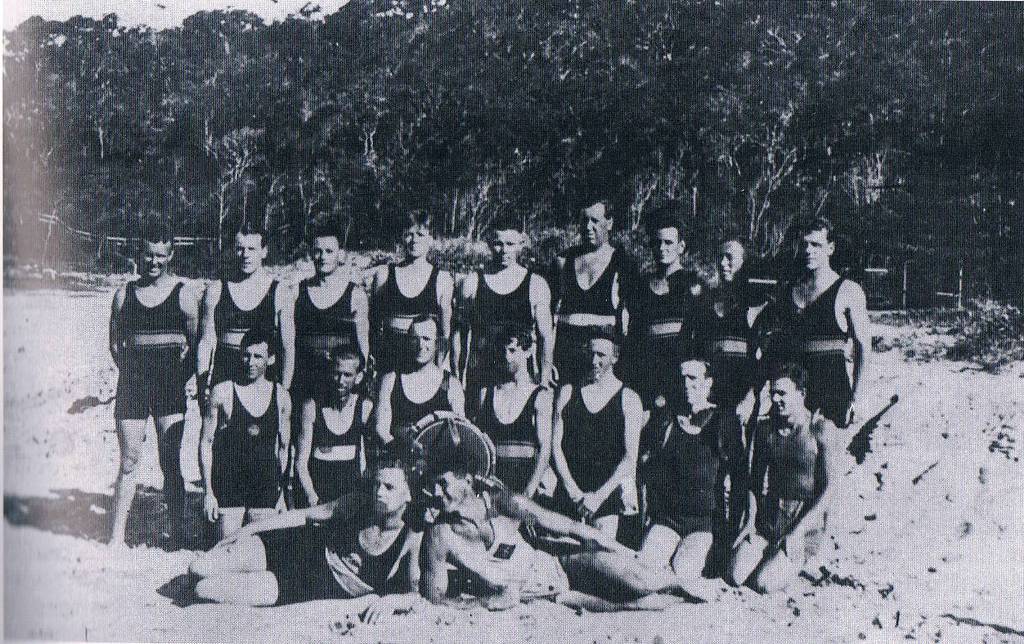
First PBSLSC Bronze examinations and Members squad, 1922. Standing (l to r) Adrian Curlewis, A. Oatley, a. Hopkins, Walter Rayner, C. Larsen, Eric Ayres, p. M. Shaw, Geoffrey Oatley. At Front: F. Larkin, Harry Ayres, Keith Oatley, B. Ellis, C. Sheedy, Laurie Gallagher, Harry Amplett. Front: Len Palmer and Austin Dellit. Photo: Curlewis family.
The first Club House, a shed, was built beside the Peter's residence on land still owned, at that time, by the Barrenjoey Land Company. This was built by members and afforded them a place to change and a place to stow club equipment. It was built to store the club's first surf boat.
Unfortunately the first surf boats were too heavy to be carried too far (they required 12 men to lift and move them) while the southern end of the Palm Beach, with its natural run out, was the best place to launch this craft from. It seemed sensible to leave the boat in the southern corner.
Warringah Council were approached with a request to build a second 'shed' for the boat on the land dedicated to the council by the Barrenjoey Land Company in 1921 at the southern end. In the 1922-23 season, permission granted, the original shed was moved to currently named Hordern Park, then 'Glenburnie Park' as suggested by A J Hordern to the Council, and Austin Dellit, reengaged for his second season, with these original members, carried out extensions and alterations. It was still a shed when completed but now had a verandah. In 1925 a shower room and fence around the clubhouse were added.
However, near neighbours were not impressed, John Thompson Ralston, father of John Malbon Ralston who tried to save Douglas Marks, is recorded in Warringah Shire Council Minutes of Meetings:
PBSLSC -The First Shed and First Surf Boat: Left; Merle Loxton, Laurie Gallagher, Tim Gonsalves and Sydney Gonsalves. H.R. Ayres and Harold 'Midge' Gonsalves. Right; Adrian Curlewis, Len Palmer, M Ormsby. Picture Courtesy Philippa Poole - daughter of Adrian Curlewis.
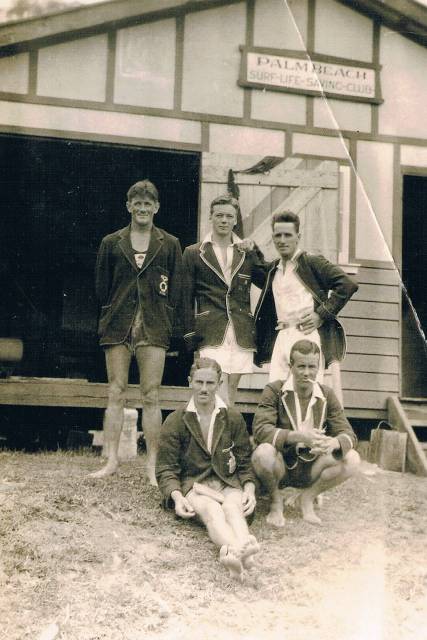
The second shed in current day Hordern Park. Photo: Philippa Poole (daughter of Adrian Curlewis)
.jpg?timestamp=1674413021159)
Hordern home on Palm Beach circa 1921-24 - section from Enemark pano; showing Palm Beach SLSC shed in current day Hordern reserve right beside them
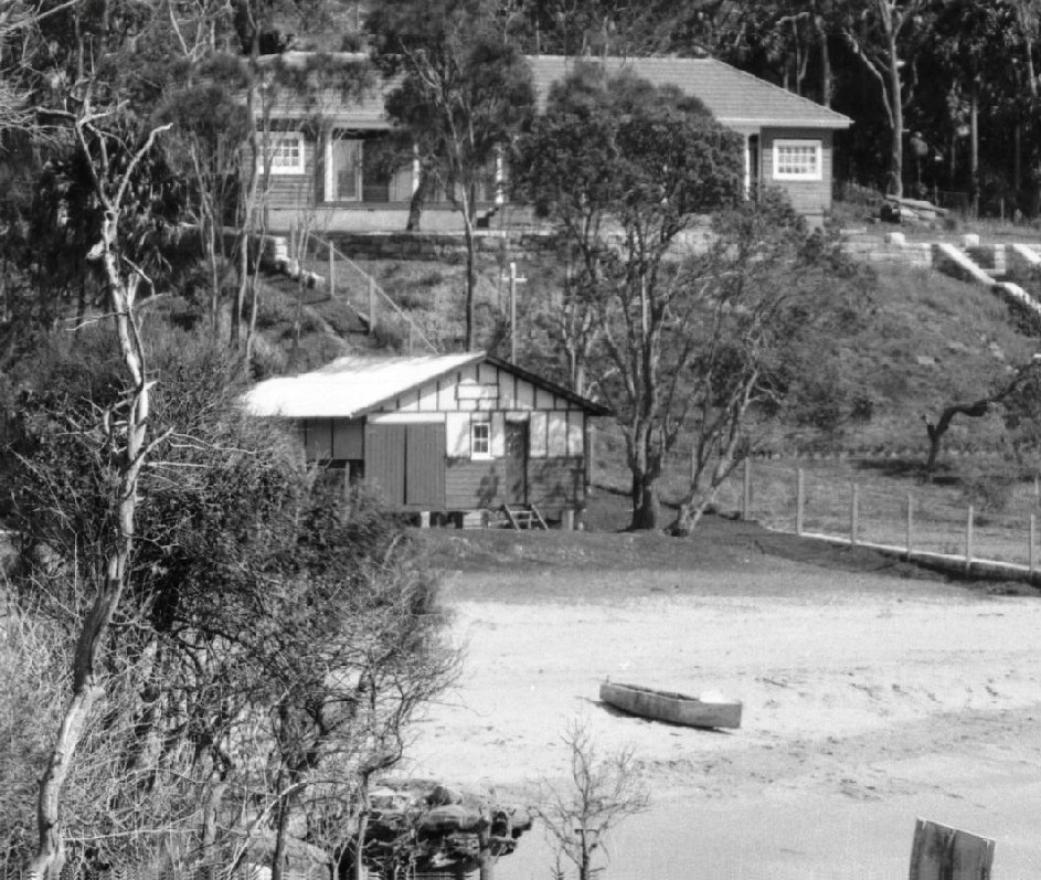
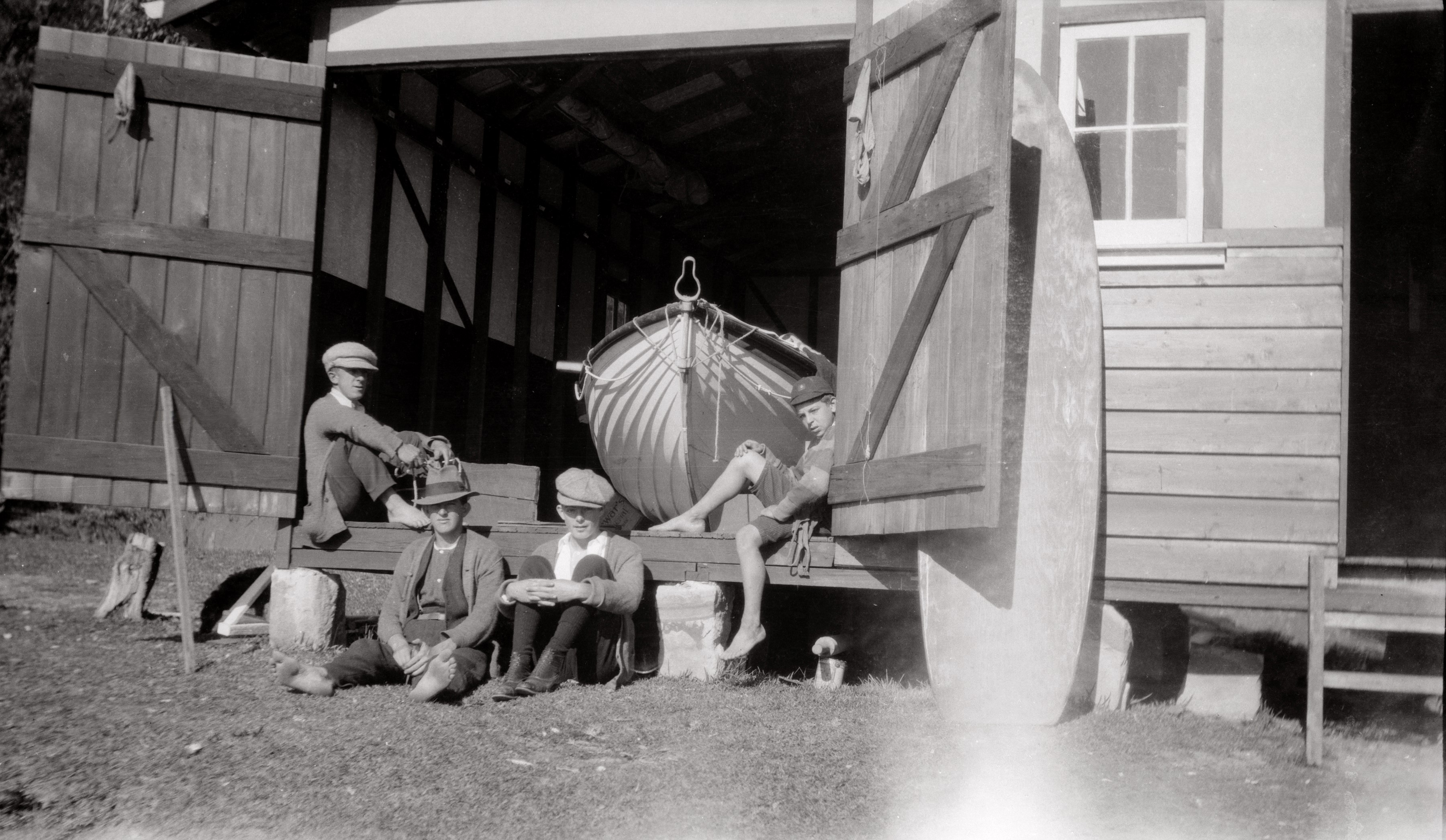
Club members were increasing rapidly too, much of this due to Adrian Curlewis' championing of the club and Palm Beach itself to fellow students at the University of Sydney's Law School and its residential colleges. Visitors and residents were kept safe, some rescued during these first seasons.
Palm Beach was still a fair way from the rest of Sydney then though and after these first seasons, and the proven necessity for full-time lifeguards during Summer, supported by squads of volunteers, membership fell away and Dellit, after four seasons as Palm Beach's Lifeguard, and Instructor for new members, did not take up a fifth season.
Three years, and three different lifesavers later, Captain of the Club, Adrian Curlewis, in examining the problem, knew the Club and Palm Beach residents had to provide better accommodation for the full-time lifeguard then that already in place in the ramshackle shed. He approached Warringah Council to build further extensions which would provide a modicum of privacy for the resident lifesaver during the season.
A.J. Hordern, whose Summer residence was beside the Reserve, had, according to some residents, a growing dislike of this modified second 'ramshackle' shed, especially the way it interfered with the view from his balcony and the noise that came from it - after all, these were young men who, outside of Patrol times, were on holidays on the beach and great mates with the permanent residents who formed part of their crew. Did they get noisy? Of Course they did!! Just get a few handfuls of in their early 20's young men together in the one shed and its surrounds and stand back - you can hear them from the top of the hill.
Alfred offered to finance the building of a new clubhouse as long as it was on a site other then where it was at present. He would then 'lend' one hundred pounds on improving this park.
Pointing out that launching the surf boat to save people was faster using the channel that runs alongside the southern end rocks did not help. Despite support from SLSA, by August 1929 Warringah Shire Councillors presented a litany of their own complaints against the club, many of them hearsay and not based in facts, culminating in the removal of the shed from the public land that is Hordern's Reserve. At a Meeting held on August 7th the Council voted to remove the clubhouse from the reserve and for the construction of another further along the beach.
Further, there would be added costs for this new clubhouse, which the council expected the members to meet, and atop that, the council stated it considered the materials the members had purchased and used to build the second clubhouse as its own property and these could not be sold by the club to meet those costs.
PALM BEACH. DISPUTE ABOUT CLUBHOUSE.
Warringah Shire Council has decided that the Palm Beach Surf Club's club-house must be pulled down and that any new structure must be erected on a more suitable site. The existing club-house, a plain erection on a public reserve, has been the subject of an offer by Mr. J. A. Hordern, who has expressed his willingness to lend the council £100 for improvements to the reserve, and to assist the club financially towards the erection of a new building.
It has been stated that the members of the surf club did not want to move, and Councillor Corkery said that if they would not go, the club should be disbanded and a paid life-saver put on the beach. It would never do to allow the council to be dictated to by the club, which was on the beach for the purpose of life-saving only. The council will have a meeting with Mr. Hordern and the members of the surf club, to discuss the question of finance. PALM BEACH. (1929, July 10). The Sydney Morning Herald(NSW : 1842 - 1954), p. 19. Retrieved from http://nla.gov.au/nla.news-article16546792
PALM BEACH CLUB-HOUSE.
In a letter to the Editor, the captain of the Palm Beach Surf Saving Club (Mr. Kenneth Hunter) states that there has been no dispute with the Warringah Shire Council. Discussions that have taken place with regard to new premises for the club have been of a most harmonious character. PALM BEACH CLUB-HOUSE. (1929, July 11). The Sydney Morning Herald (NSW : 1842 - 1954), p. 12. Retrieved from http://nla.gov.au/nla.news-article16568126
PALM BEACH SURF CLUB HUT.
The Palm Beach Surf Club's hut is to be removed from its present situation in a valuable public reserve to a more suitable site, near the centre of the beach. The Warringah Shire council will erect the new hut, which will cost £300. PALM BEACH SURF CLUB HUT. (1929, August 31). The Sydney Morning Herald (NSW : 1842 - 1954), p. 22. Retrieved from http://nla.gov.au/nla.news-article16579961
By December 1929 this building opened, south of the council dressing sheds. This structure comprised a club room, shower room, casualty room, lavatory, verandah and boatshed. Water came via a well and windmill, with any additions funded by members.
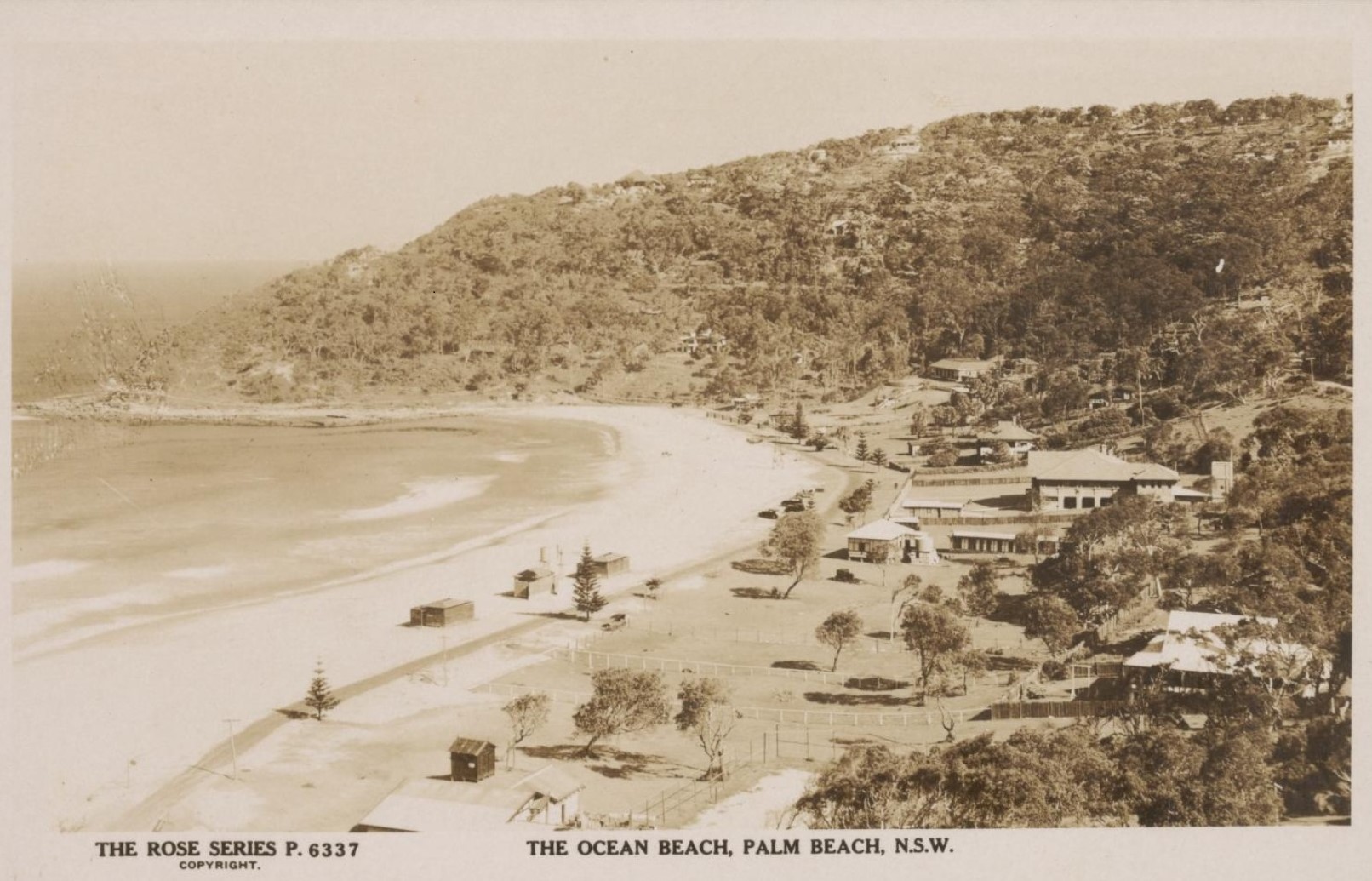
Palm Beach beachfront showing change rooms circa 1921-28. Postcard courtesy National Museum of Australia
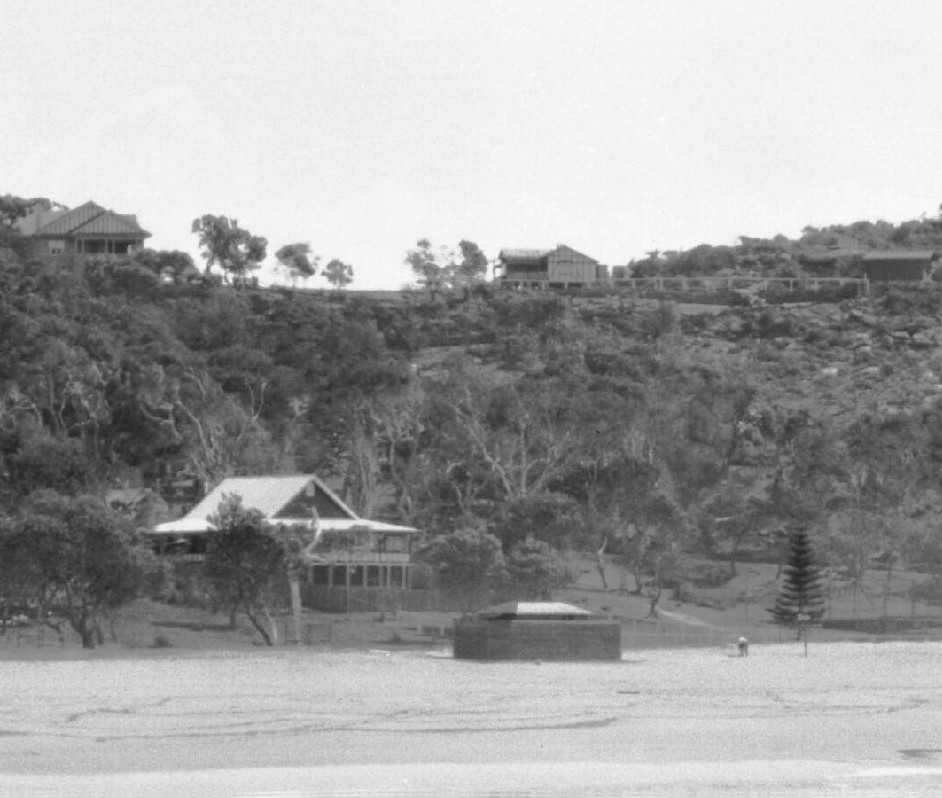
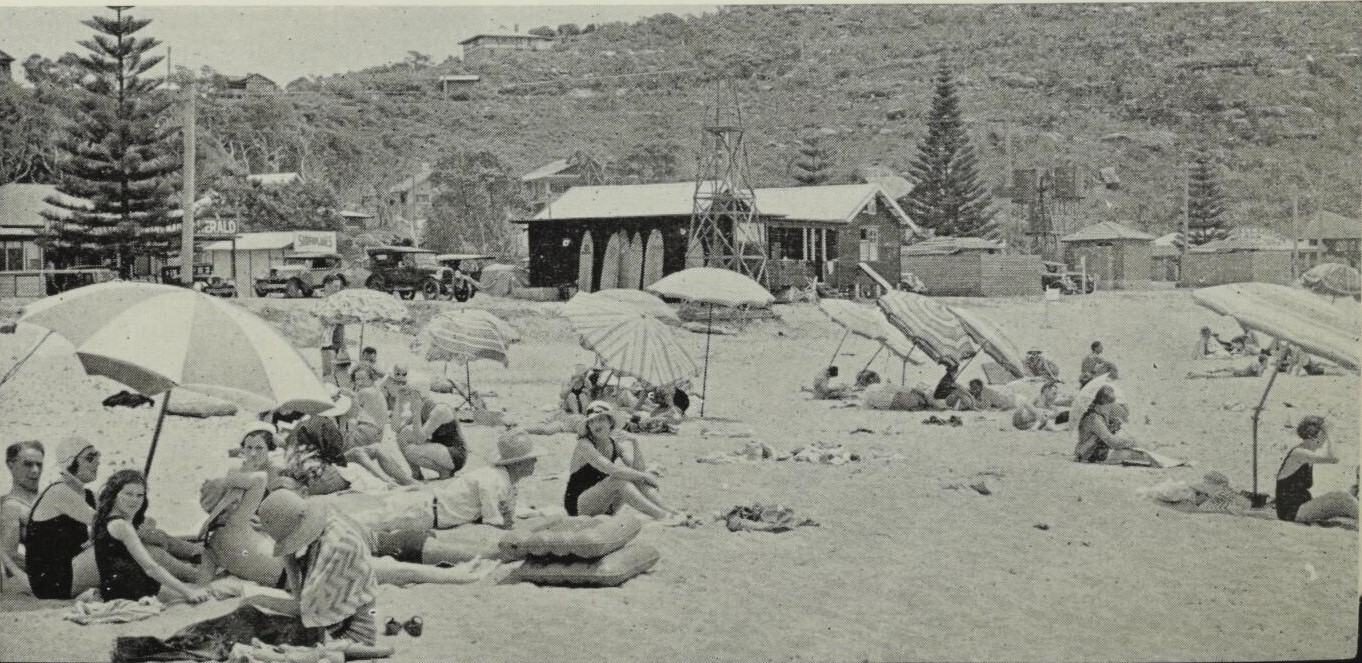
Photo caption: 'Palm Beach as it was' - note PBSLSC bunkhouse/clubhouse building in background with dark walls and light coloured roof. The Club applied to place a room for surfboards underneath but was knocked back by the council. Clearly simply stacking them against the exterior walls for quick access was practised. From: (Vol. 20 No. 2 1 February 1939 ). The Palm Beach myth, The Home : an Australian quarterly Retrieved from http://nla.gov.au/nla.obj-389607884
With the proposed building of 'The Pavilion' the clubhouse was set to be moved again as all those structures on the beach verge would need to be demolished - Warringah Shire Council records show at the Meeting held on June 29th, 1935:
PALM BEACH BUILDING PROPOSAL Deputation from Palm Beach Surf Life Saving Club: Mr. J. M. Ralston, President of the Club, protested that the Club had not been Given an opportunity of considering the proposal, and contended that sleeping accommodation for Club Palm Beach members, should be provided in the new building. Mr. Curlewis,' President of the Surf Life Saving Association, objected to the site proposed by the Council on the ground that the surf in the vicinity was dangerous, and that the position of the Club's accommodation should be in close. proximity to the surfbathing area. Resolved, - That the matter be deferred for two weeks, the Club to be given an opportunity of inspecting the plan and the site. (Crs. Rosa, Sheppard) Resolved, - That Mr. Curlewis and Mr. Ralston be thanked for coming to the meeting to-night, and helping the Council with their suggestions. (Crs. Ross, Shepdard),.
The following year, 1936, the members purchased William Chorley's weekender from his relatives, and there ended council dabbling in Palm Beach SLSC matters. Details are available in: The First Weekenders On The Palm Beach Beachfront + A Look Into Palm Beach SLSC Clubhouses In The Club's 101st Season and Art Deco Inspirations In Palm Beach: The Palladium Dance-Hall, Cafe And Shop - The Surf Pavilion - The Beacon Store
A place for visitors - not just family
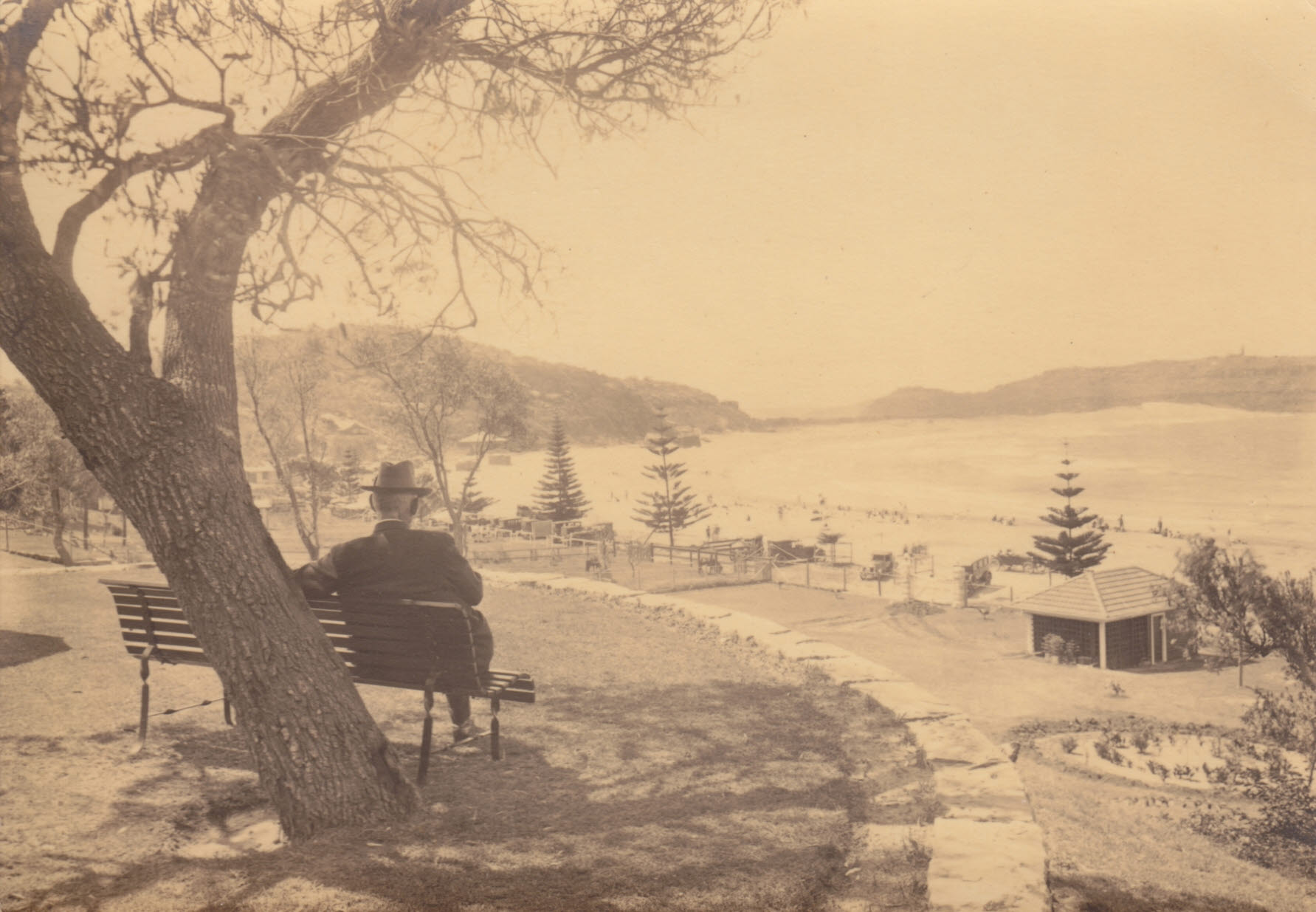
Palm Beach circa 1926-30, from collection of and courtesy John Cowper - taken from Hordern home grounds at Palm Beach and probably showing Governor de Chair enjoying the view over Palm Beach.
The de Chair's first holidayed at Kalua in 1927, although they may have had use of the holiday home prior to then. The family returned for a few days prior to leaving Australia permanently, although the Horderns' had been in residence in February when Mr. Hordern was recuperating. A J and Caroline Hordern had their main home, "Highlands" in Myra Street, Wahroonga - details under Extras.
A magazine article that appeared in a December 1 1927 issue of House and Garden shows the garden at Kalua had not yet become would it during the next few years:
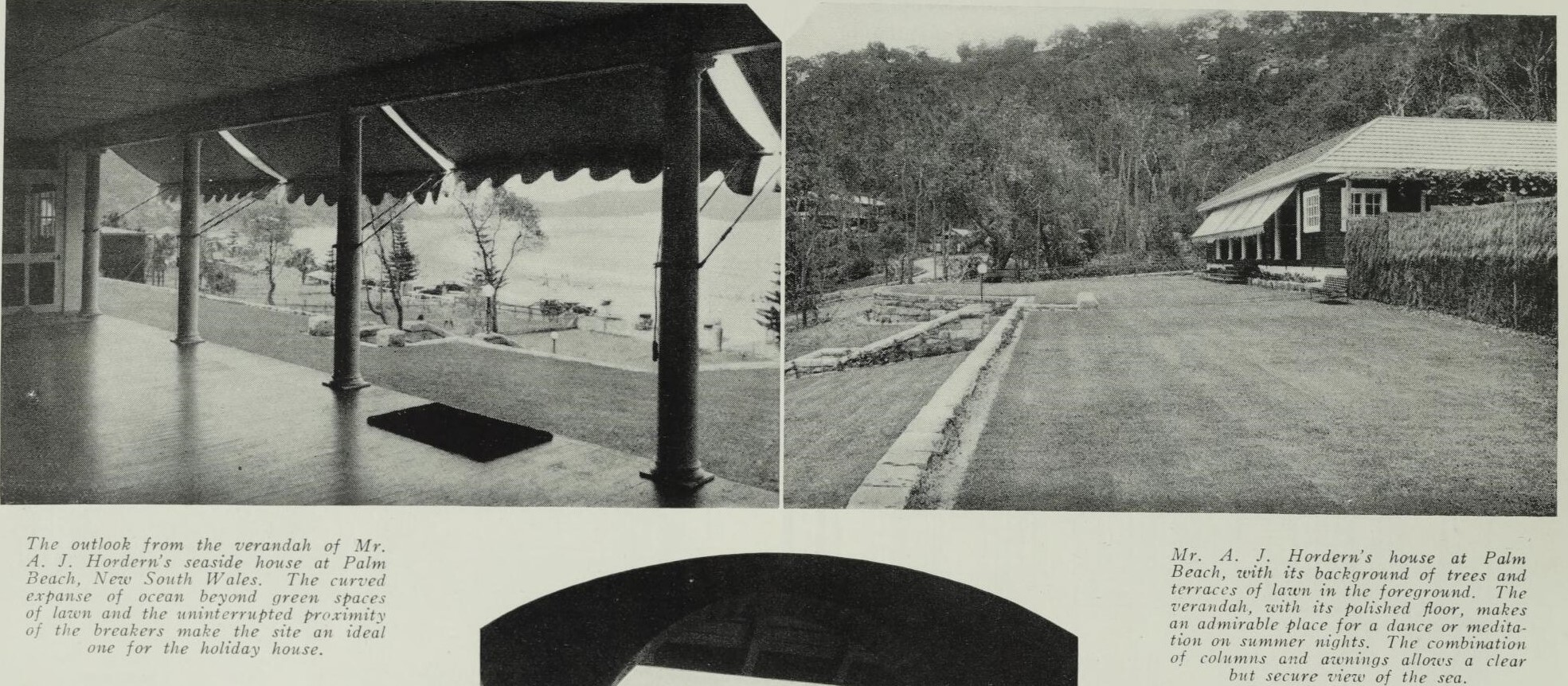
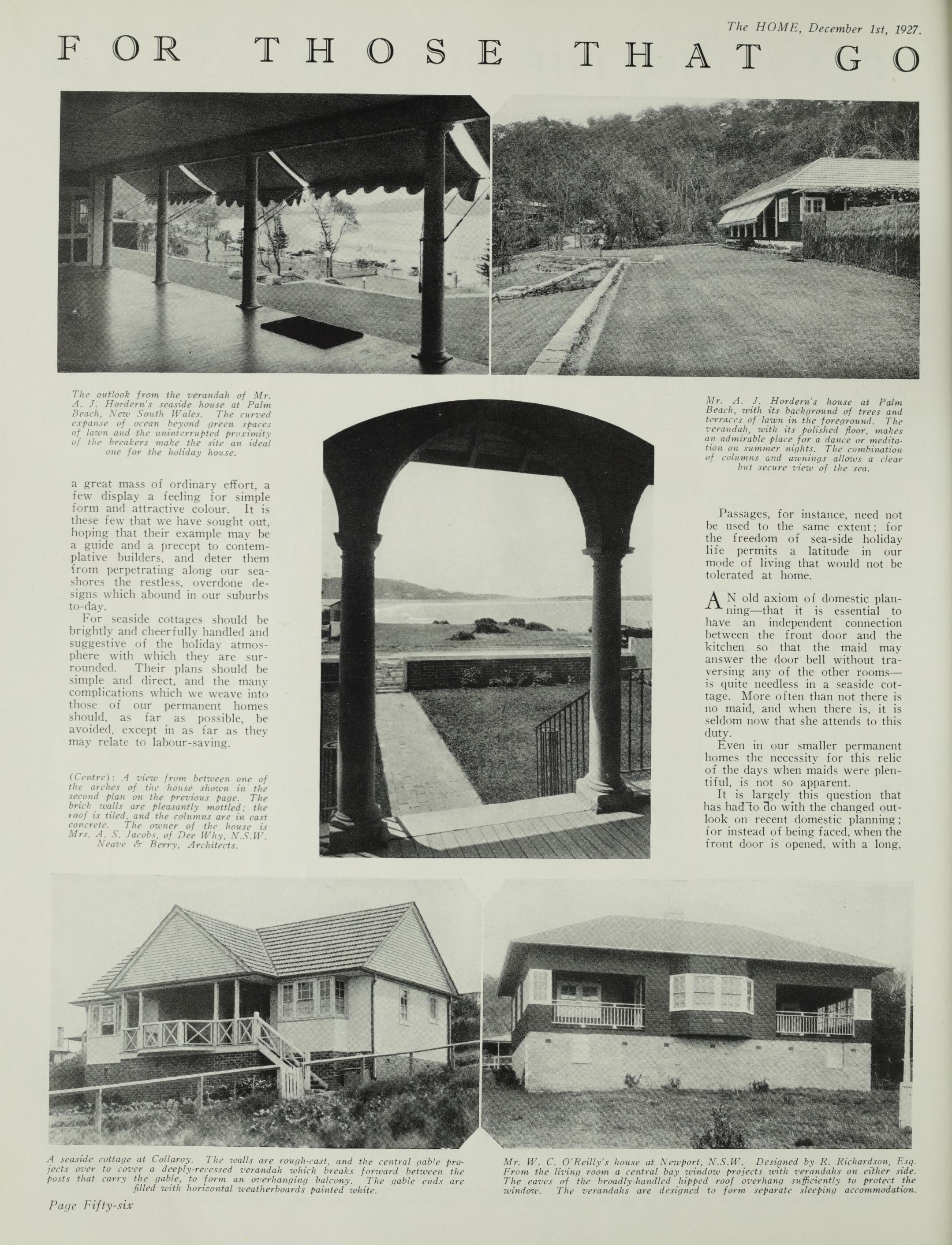
A few notes from the pages of the past on the de Chairs' use of 'Kalua' also provides images of the weekender as it was then :
At Palm Beach. Barrenjoey, there are bungalows are of every design and every type, from Mr. A. J. Hordern's 'Kalua,' which the Vice-Regal party frequently occupy….PALM BEACH (1927, October 21). Evening News (Sydney, NSW : 1869 - 1931), p. 19. Retrieved from http://nla.gov.au/nla.news-article118935107
While the sun blazed merrily over us on Saturday, the Governor's wife, Lady de' Chaír, with Miss Elaine and sailor son Graham, betook themselves to Palm Beach for the surf. Lady de - Chair is a keen surfer, but is careful to cover up her arms from the Australian sun. She is proud of her English fairness. And it is whispered, that she did not at all approve of the skimpy bathing suits which were displayed for almost the first time on the exclusive little beach. Quite out of the way of the world, Palm Beach has become the seaside resort of our very best people, and the de Chairs have the loan of the Edward Hordern's home there for as long as they like, with the cow and the handy man thrown in. SYDNEY WEEK BY WEEK. (1927, November 3). Western Mail (Perth, WA : 1885 - 1954), p. 23. Retrieved from http://nla.gov.au/nla.news-article37671577
Palm Beach.
When the de Chairs are at Palm Beach, they stay In Mr. Albert Hordern's house. So that when Audrey and Pamela Champain were there last week, staying with Mrs. Hordern, they shot the breakers with the surf board that belongs to Miss Elaine de Chair. They also rode the waves on Somerset de Chair's rubber sharks. Palm Beach. (1928, March 5). Leader (Orange, NSW : 1899 - 1945), p. 6. Retrieved from http://nla.gov.au/nla.news-article254409732
VICE-REGAL PARTY'S VISIT TO PALM BEACH BEFORE LEAVING STATE.
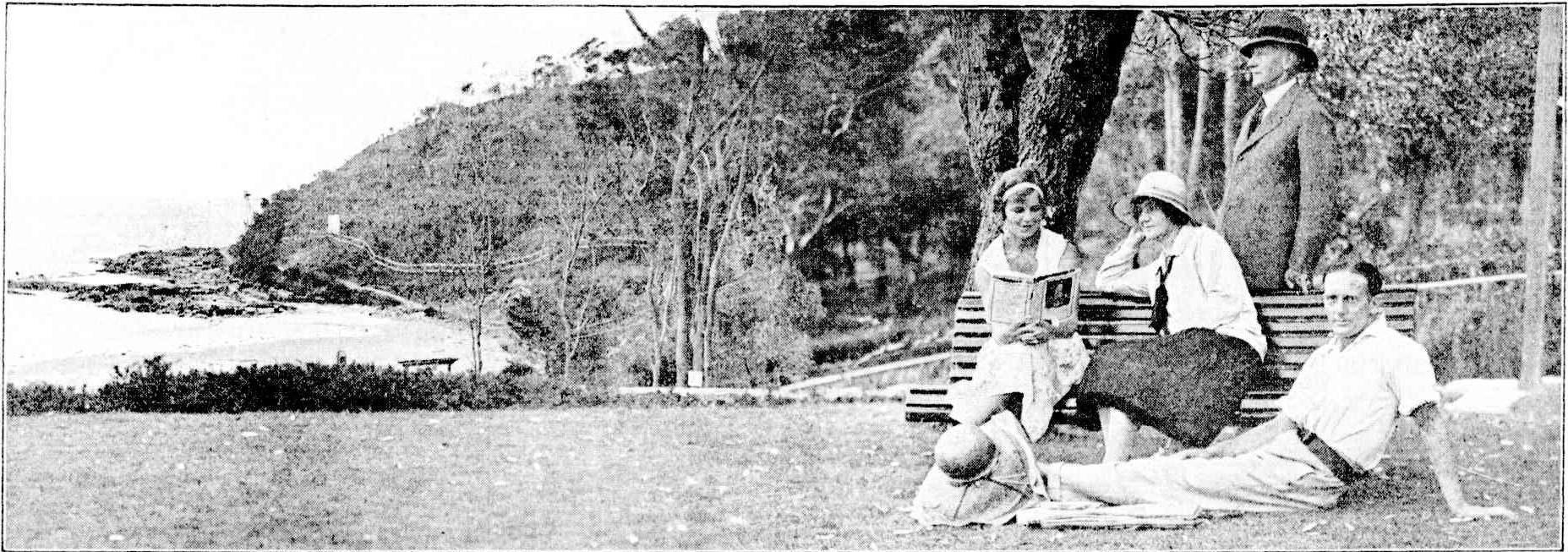
The Governor, Sir Dudley de Chair, and Lady de Chair, have been spending the last few days at Kalua, the Palm Beach home which Mr. and Mrs. Alfred Hordern placed at their disposal for a last holiday in Australia before relinquishing office. Miss Elaine de Chair (left) is seated beside Lady de Chair, the Governor is standing at the back, and Lieut. Graham de Chair, A.D.C, is seated in front. VICE-REGAL PARTY'S VISIT TO PALM BEACH BEFORE LEAVING STATE. (1930, February 27). The Sydney Morning Herald (NSW : 1842 - 1954), p. 14. Retrieved from http://nla.gov.au/nla.news-article16629022
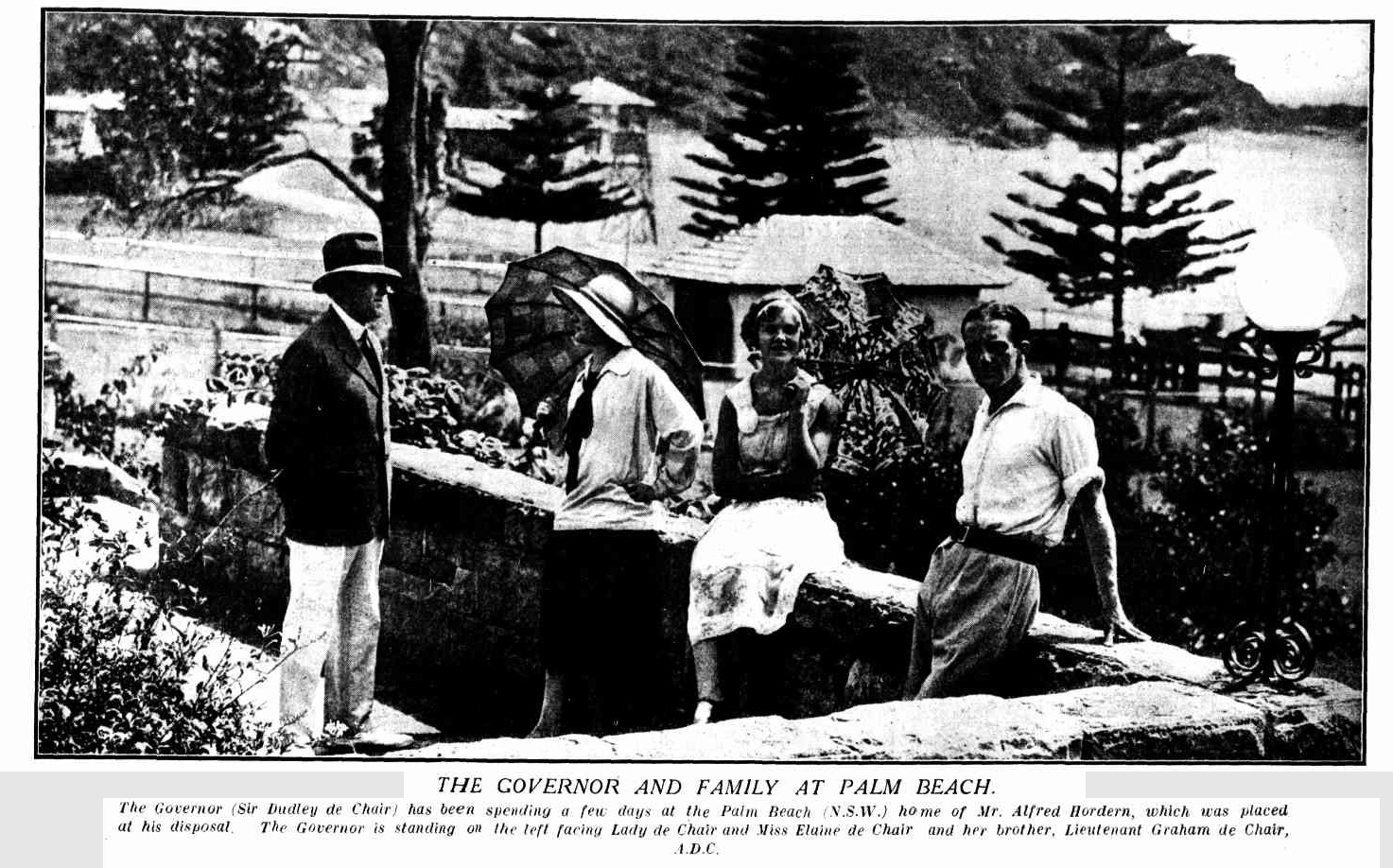
THE GOVERNOR AND FAMILY AT PALM BEACH. The Governor (Sir Dudley de Chair) has been spending a few days at the Palm Beach (N.S.W.) home of Mr. Alfred Hordern, which was placed at his disposal. The Governor is standing on the left facing Lady de Chair and Miss Elaine de Chair and her brother, Lieutenant Graham de Chair, A.D.C. THE GOVERNOR AND FAMILY AT PALM BEACH. (1930, March 5). Sydney Mail (NSW : 1912 - 1938), p. 9. Retrieved from http://nla.gov.au/nla.news-article160633195
VISIT TO QUEENSLAND.
Sir Dudley and Lady de Chair.
TREES FOR REMEMBRANCE.
When the Governor (Sir Dudley de Chair) relinquishes office in April it is his intention to pay a visit, accompanied by Lady de Chair, to the Governor of Queensland (Sir John Goodwin) and Lady Goodwin. Sir Dudley and Lady de Chair will also pay several private visits In Queensland before their departure for England.
During the last few days the Governor and Lady de Chair have been staying at Kalua, Palm Beach, the home of Mr. and Mrs. Alfred Hordern, who kindly placed It at their disposal. Five years ago they spent a happy holiday there. This is the last opportunity they will have of a holiday before leaving New South Wales. Accompanied by Miss Elaine de Chair and attended by Lieutenant Graham de Chair, A.D.C., they will return to Sydney on Saturday. Lady de Chair is most enthusiastic regarding the beauties of Palm Beach, which she declares is the finest beach she has seen in any part of the world.
When Lady de Chair and her daughter left Sydney for Hawaii last year they were the recipients of many gifts of flowers from friends and well-wishers. As the official departure in April will be by train from Sydney, Lady de Chair, while appreciating the thought which might prompt friends sending flowers, is anxious that they shall not send them. She would much prefer that trees or shrubs were planted In memory of the stay of Sir Dudley and herself in Australia. The planting of trees has always been urged by Lady de Chair during her sojourn In New South Wales, as she has seen what has been accomplished by tree-loving peoples in other parts of the world. In this, she believes, Australians have been rather backward.
"Trees mean so much to me and to the members of my family," said Lady de Chair yesterday, "and we would all be so grateful to know that our stay in this beautiful country, which we all regret leaving so much, was remembered In that way." FOR WOMFN VISIT TO QUEENSLAND. (1930, February 27). The Sydney Morning Herald (NSW : 1842 - 1954), p. 5. Retrieved from http://nla.gov.au/nla.news-article16628942
HIS EXCELLENCY THE GOVERNOR AND LADY DE CHAIR AT PALM BEACH
Mr. and Mrs. Alfred Hordern placed their beautiful home, “Kalua” at the disposal of' Sir Dudley and Lady de Chair and for several days they, with Miss Elaine de Chair and Lieutenant Grahame de Chair enjoyed the beauties of Palm Beach.
It is the wish of Lady de Chair that, instead of sending flowers as gifts when they depart from Sydney in April, that trees should be planted in their memory. Lady de Chair is a true tree lover, and has often said that we in Sydney do not give the planting of trees half enough attention. When leaving Sydney in (April the Vice-Regal party will journey to Queensland and here they will be the guests of His Excellency Sir John Goodwin. - The Commonwealth home., Vol. 37 No. 992 (1 March 1930). HIS EXCELLENCY THE GOVERNOR AND LADY DE CHAIR AT PALM BEACH, The Commonwealth home Retrieved from http://nla.gov.au/nla.obj-3126916585
The board here, initials 'K.H.' may be Kitty Hay's board, another lady surfer of Palm Beach at this time, or Keith Hunter of the Palm Beach SLSC, whose brother Peter did so much to ensure surfboards became part of standard equipment for all Australian surf lifesavers.
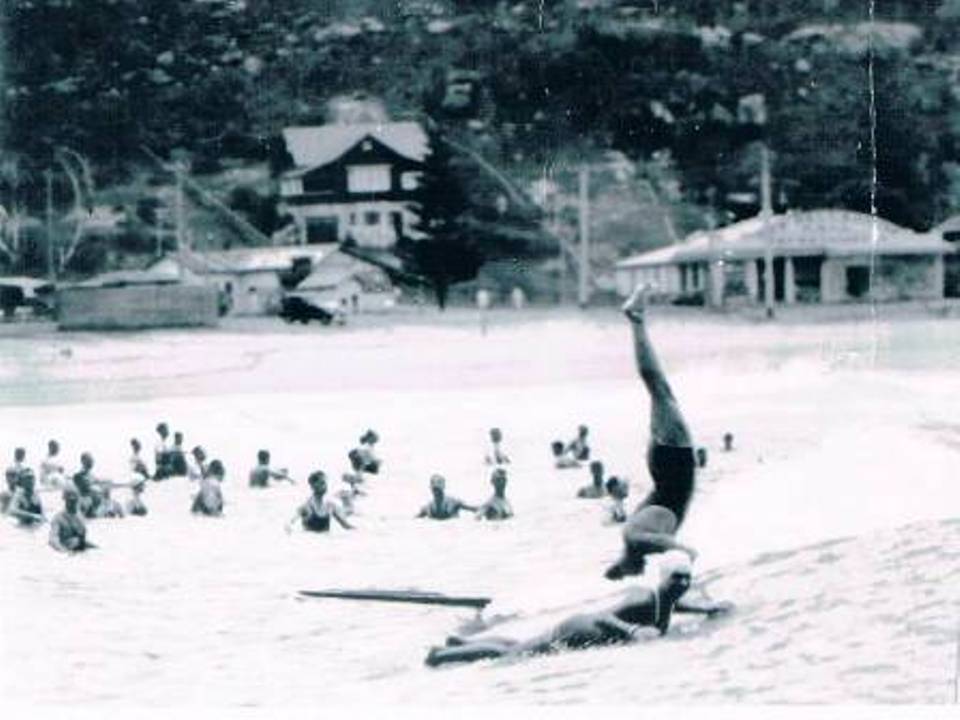
Adrian Curlewis, circa 1930 doing a headstand at Palm Beach - photo courtesy Philippa Poole, daughter of the 'Father of Surf Life Saving'
John Ralston and Peter Hunter were elected to a sub-committee to prepare a submission that would articulate Palm Beach SLSC's endorsement of surfboards as rescue equipment, their Surf Life Saving Australia submission stating the surfboard was ...'unequalled as a complete unit of surf-lifesaving...'
In 2008, a possible second board, the template substantially different to the Freshwater board, was unearthed:"Found in Australia at the Hordern estate, the board pictured here is perhaps one of the most astonishing surfing relics to ever surface.This solid ten foot wood board was presented by Duke Kahanamoku in 1915 to Alfred Roy Hordern as a gift of Aloha in appreciation for his family's hospitality during a visit to Australia."- US Online Surf Auction 2008, item description and images subsequently printed in:Winniman: Vintage Surfboards (2008), pages 10 and 11.Roy with his parents, circa, 1925While Alfred Roy Horden was noted for his "exuberance and recklessness", there is no record of his surfriding exploits in the family's authorised history and it is reported that he enlisted in the army in September 1914, several months before Duke arrived in Australia.'These boys were to become the enfants terribles of the family in their time.Perhaps Carrie devoted more care to the culture of her plants than to her children, who were said to be spoilt and wild and who, together with Lebbeus Hordern, son of Sam, were the legendary scene-stealers of the fourth generation.Roy and Bruce grew up handsome and charming with an exuberance and recklessness which was the antithesis of their father's timidity, and, indeed, of the caution of most of their Hordern cousins.Roy was among the first of these young Horderns to go on active service in World War I; Bruce followed as soon as he was old enough, and on their return they showed little inclination to settle to the draper's life, or to any other mundane existence.Roy, in particular, assumed a flamboyant role, and after his death in Perth as the result of a motor-cycle accident in 1935, was described by the West Australian press as an 'extraordinary' and 'picturesque' personality-a man of 'magnificent build... deep-chested' and with a 'rugged he-man sort of handsomeness'- Lesley Horden: Children of One Family. The Story of Anthony and Ann Hordern and their descendants in Australia 1825-1925. Retford Press, Sydney, 1985, pages 219 and 334.If the board was not gifted, as claimed, certainly the Horden family were financially capable of paying the high price these boards no doubt fetched.However, their connection with surfriding at Palm Beach is not established until 1921 and at this time they had the facilities to have surfboards constructed by in-house cabinet makers such as Buster Quinn.Ref: Winnimam, Jim: Vintage Surfboards 1 - A photo history of surfboards and surfing collectables. US Vintage Surf Auction, November 2008, page 11. Photograph by Caprice Nicole Photography.
If Roy did get this board directly from the 'Duke' he may well have acquired it on his way home or to London in the subsequent years, if not in late 1914 or early 1915. A few paragraphs from reports of that famous time when an Hawaiian demonstrated how they do it in his homeland:
Kahanamoku
At 5 p.m. on Monday, Duke Paoa Kahanamoku and party will be welcomed officially by the N.S.W.A.A.A. at the Hotel Australia. KAHANAMOKU. (1914, December 12 - Saturday). The Daily Telegraph (Sydney, NSW : 1883 - 1930), p. 9. Retrieved from http://nla.gov.au/nla.news-article238878127
GOVERNOR'S FAMILY ENJOYING SURE AND SUNSHINE
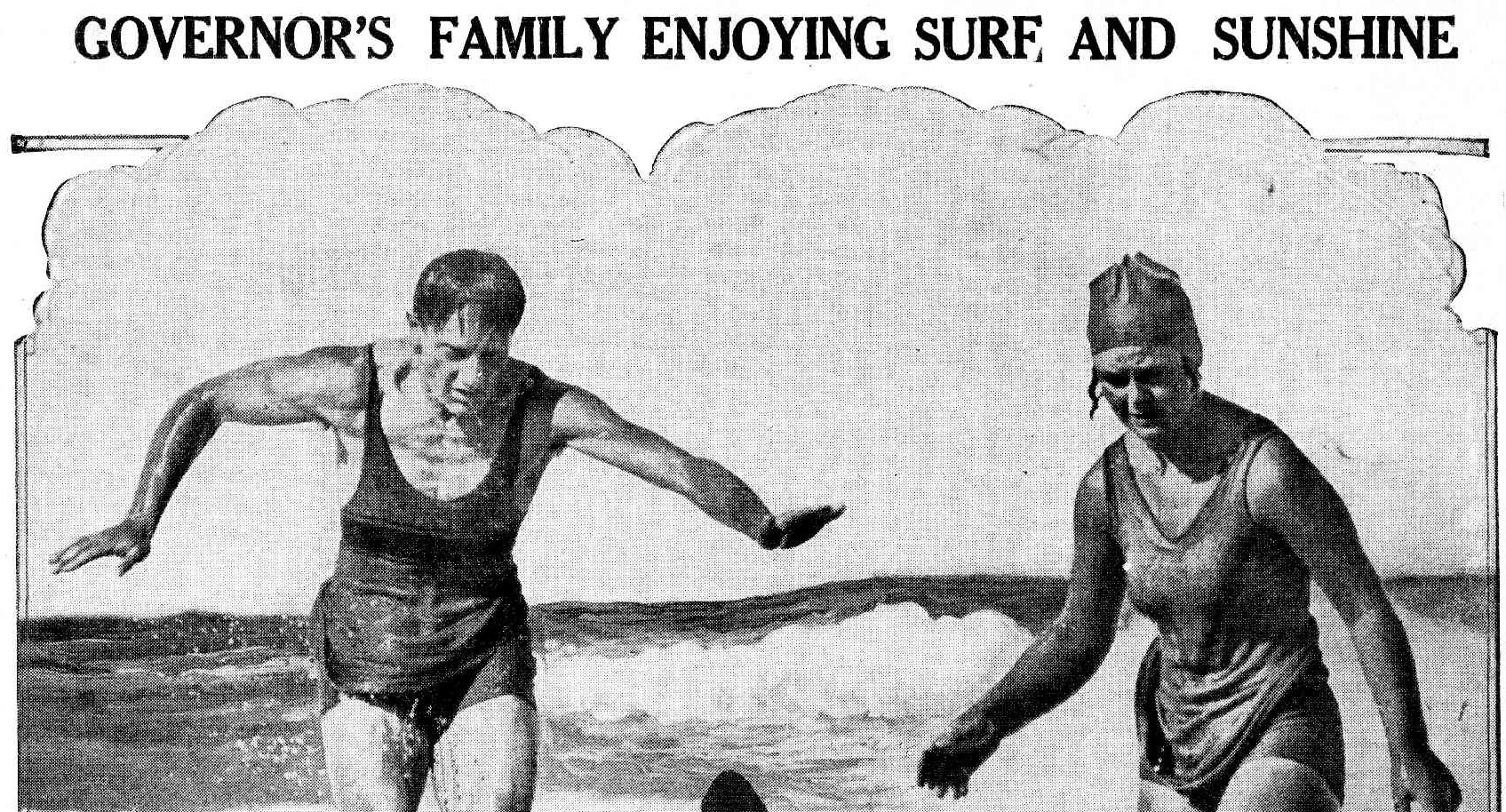
.jpg?timestamp=1705623085473)
A REAL AUSTRALIAN HOLIDAY, the last that they, will spend before returning to England, has been the lot of the Governor and Lady de Chair, at Kalua, the Palm Beach home of Mr.' A. J. Hordern. With them have been Miss Elaine and Lieut. Graham de Chair, who is aide-de-camp to his father. The young people have enjoyed all the thrills of surf-board riding,, at which they have become expert. The picture on the right shows Miss Elaine de Chair coming in cleverly on a comber, with her brother imitating her finished style on the left; while, in the smaller picture, the laughing pair support the board that has provided so many hours of happiness and fun. GOVERNOR'S FAMILY ENJOYING SURE AND SUNSHINE (1930, March 1). Daily Pictorial (Sydney, NSW : 1930 - 1931), p. 1. Retrieved from http://nla.gov.au/nla.news-article246125667
Miss Elaine de Chair and her brother, Lieutenant Graham de Chair, became quite expert at surf-board riding during a recent holiday at Palm Beach, near Sydney. They are the son and daughter of the Governor of New South Wales. a page for women and perhaps MEN. (1930, March 20). Western Mail (Perth, WA : 1885 - 1954), p. 3 (The Western Mail). Retrieved from http://nla.gov.au/nla.news-article38510813
Admiral Sir Dudley Rawson Stratford de Chair KCB KCMG MVO (30 August 1864 – 17 August 1958) was a senior Royal Navy officer and later Governor of New South Wales. De Chair had been interested in serving in a vice regal role as early as 1922, when he put his name forward to the Colonial Office for the position of Governor of South Australia. This position however, went to Sir Tom Bridges instead and the First Lord of the Admiralty, Leo Amery, put de Chair's name forward for the Governor of New South Wales. This position, which had been vacant since the death of Sir Walter Davidson in September 1923, was the same one his uncle, Sir Harry Rawson, had held twenty years earlier, and to which he was appointed on 8 November 1923.
Arriving in Sydney on 28 February 1924, de Chair became governor in relatively calm political times and was warmly received in the city with great fanfare. On de Chair's appointment, the President of the Royal Australian Historical Society, Aubrey Halloran, compared Admiral de Chair to the first Governor, Captain Arthur Phillip: "Our new Governor's reputation as an intrepid sailor and ruler of men evokes from us a hearty welcome and inspires us to place in him the same confidence that [Arthur] Phillip received from his gallant band of fellow-sailors and the English statesmen who sent him."
The political makeup of the state changed not long after his arrival however, when the conservative Nationalist/Progressive coalition government of Sir George Fuller, whom de Chair had got on well with, was defeated at the May 1925 state election by the Labor Party under Jack Lang. De Chair noted to himself that Lang and his party's position comprised "radical and far-reaching legislation, which had not been foreshadowed in their election speeches". He also later wrote that Lang's "lack of scruple gave me a great and unpleasant surprise".
With the Labor Government only holding a single seat majority in the Legislative Assembly and only a handful of members in the upper Legislative Council, one of Lang's main targets was electoral reform. The Legislative Council, comprising members appointed by the Governor for life terms, had long been seen by Lang and the Labor Party as an outdated bastion of conservative privilege holding back their reform agenda. Although previous Labor premiers had managed to work with the status quo, such as requesting appointments from the Governor sufficient to pass certain bills, Lang's more radical political agenda required more drastic action to ensure its passage. Consequently, Lang and his government sought to abolish the council, along the same lines that their Queensland Labor colleagues had done in 1922 to their Legislative Council, by requesting from de Chair enough appointments to establish a Labor majority in the council that would then vote for abolition.
While Lang's attempts ultimately failed, de Chair failed to gain the support of an indifferent Dominions Office. With Lang's departure in 1927, the Nationalist Government of Thomas Bavin invited him in 1929 to stay on as Governor for a further term. De Chair agreed only to a year's extension and retired on 8 April 1930.
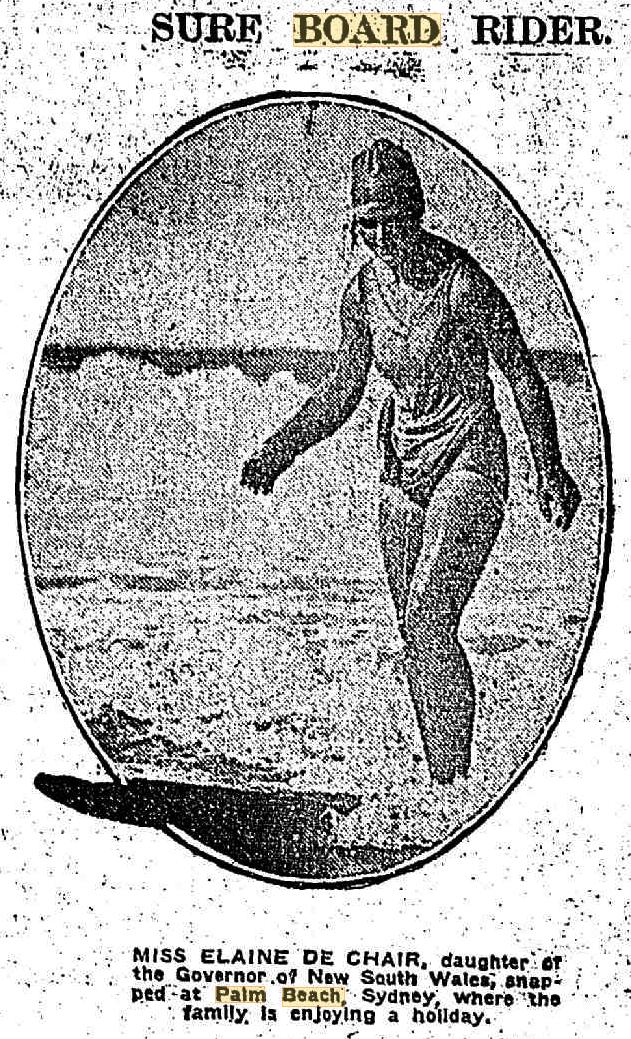
The Horderns did still make use of their Palm Beach home, but the records show they did rent Kalua out to others, with a 1964 article in The Bulletin by David McNicoll noting it was among the most famous Palm Beach residences because of this, with the weekly rental being £35 back in the early stages, considered the most expensive place at that time to rent. The Horderns only seemed to rent the place to people they knew - a few notes from the pages of the past:
Mr. A. J. Hordern must feel quite an interloper in his own home, Kalua, at Palm Beach, for he usually lends it, to some one or other of his lucky friends. Now he is convalescing there himself, recovering from a broken leg. Mrs. Hordern is loving the place, and sends flowers from her lovely garden to her less fortunate friends.
Another of the beautiful homes overlooking the beach belongs to Mr. C. Morris, and is occupied at the moment by the Warwick Fairfax couple and their baby. They, too, enjoy the dream of a garden, ablaze with summer flowers. Barbara Listens In (1931, February 8). Daily Pictorial (Sydney, NSW : 1930 - 1931), p. 19. Retrieved from http://nla.gov.au/nla.news-article246421885
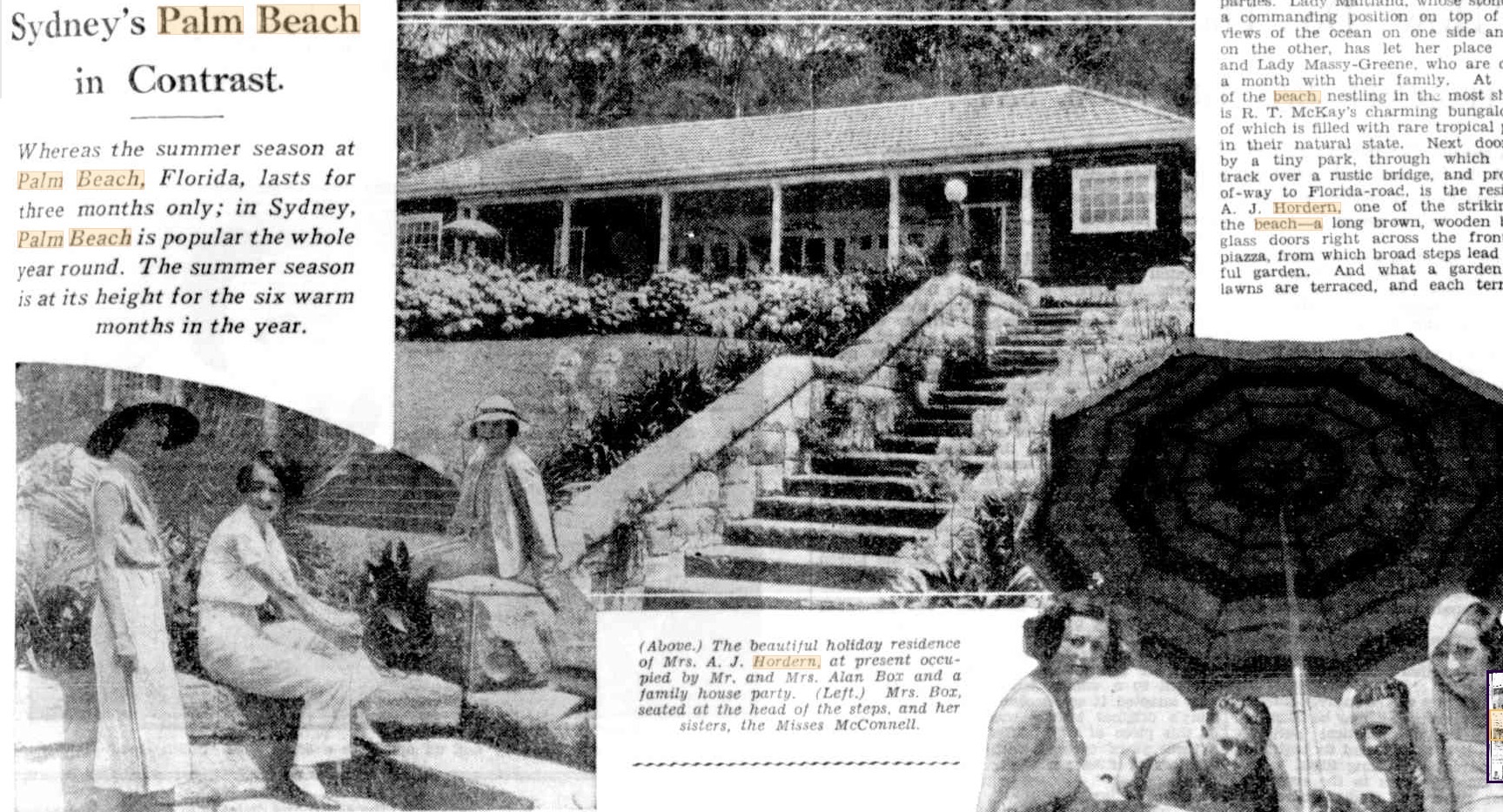
%20Hordern.jpg?timestamp=1706737528108)
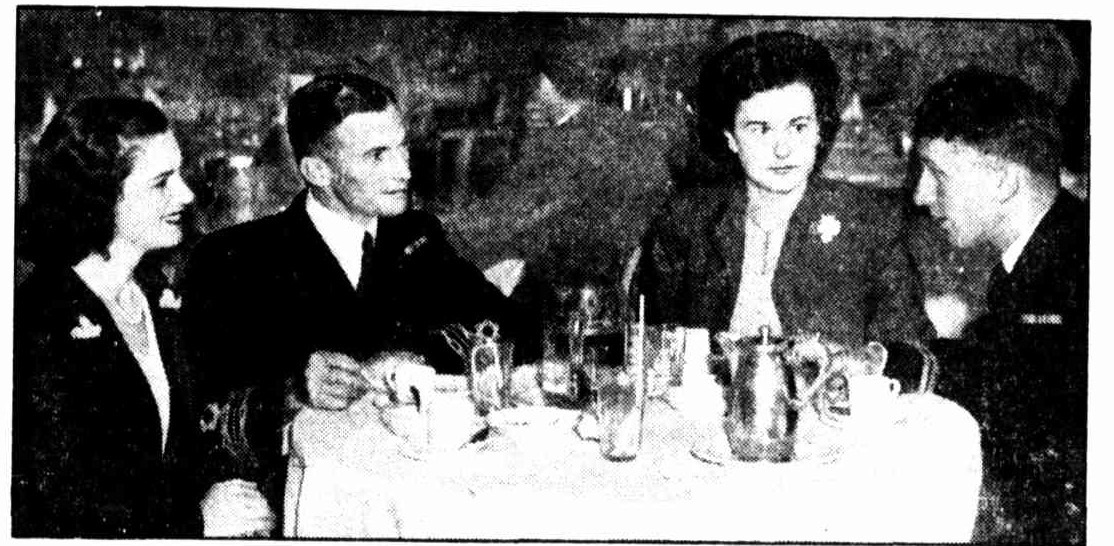
Kalua Open Garden for charity
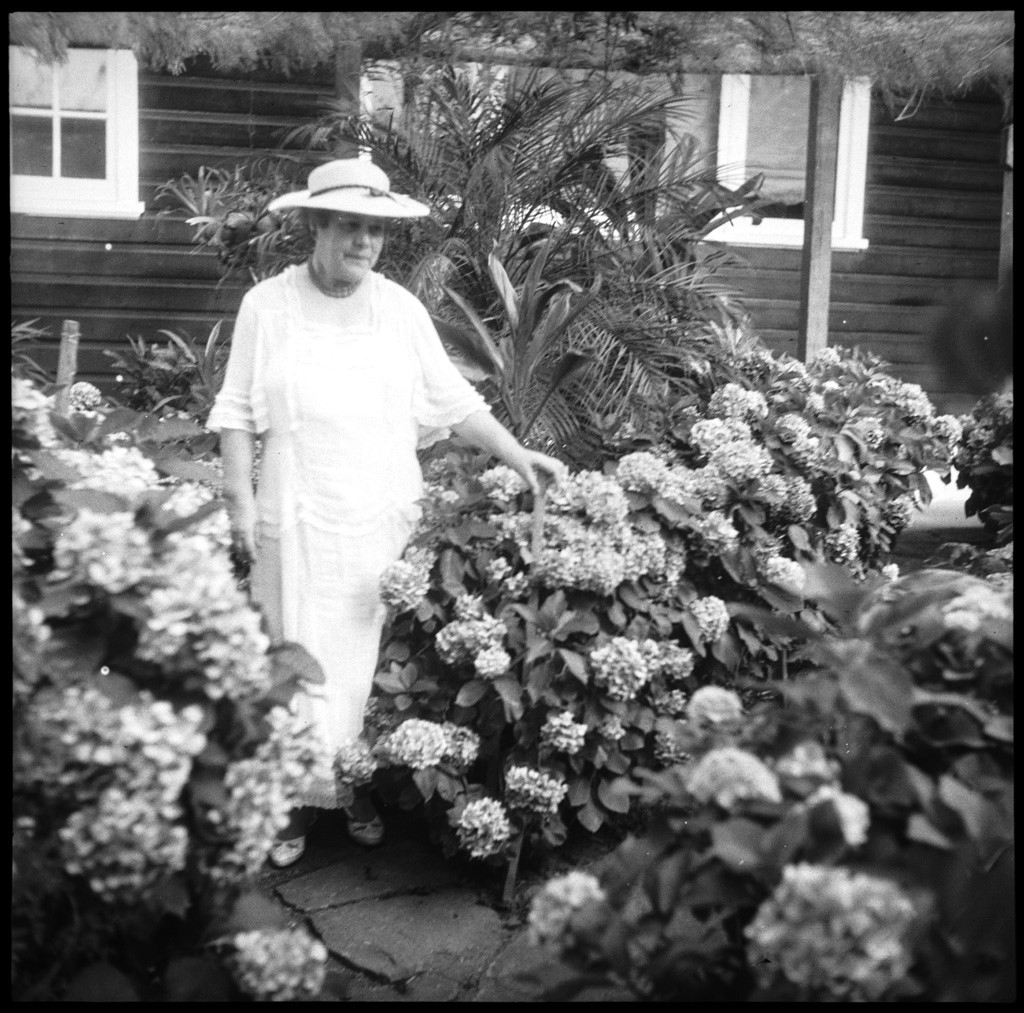
The gardens at Kalua were the site of at least one Open Garden over the years Caroline owned the premises, to raise money for charity. Caroline Hordern had also opened the gardens a the Highlands Hordern home in Wahroonga prior to this - notes under Extras list some of these, along with a few images from newspapers of then to show views and garden at The Highlands.
When her husband passed away it was written:
Cinerarias are fine subjects for borders, beds, pots or boxes. Nothing that we now handle has power to equal their massed attacks. And the best of it all is the plants do wonderfully well from the sea coast to the hard frost line. Last year cinerarias were beautifully brilliant everywhere. The best show of the season was seen in the garden of Mrs. A. J. Hordern, at Waitara. Just thousands of heads were massed close together. THE GARDEN. THE FLOWER GARDEN., The Lone hand Retrieved from http://nla.gov.au/nla.obj-413888364 New Series Vol. 8 No. 2 (1 January 1918)
'Redgum' was John Gilmour Lockley, President of Ku-ring-gai Shire Council from 7 December 1923 – 5 December 1924, who had written about The Highlands from at least 1918 - as shown above. Mr. Lockley wrote several gardening books and, using the pseudonym 'Redgum', wrote about gardening for The Lone Hand, and later, at the Sydney Morning Herald and also had a very popular radio program on gardening up until he passed away.
Cineraria is a genus of flowering plants in the sunflower family, native primarily to southern Africa with a few species farther north. The genus includes herbaceous plants and small sub-shrubs.
Another of 'Redgum's earlier notes on the Hordern garden at Wahroonga:
THE GARDEN.
By J. G. LOCKLEY.
TREE BEGONIAS.
THE newer tree begonias are among the best out-door subjects that can be placed in a mixed border, against a wall, near a fence or a house. They carry a clean, shapely foliage on long, bamboo-like stems, and hang their chandelier-like bunches of blossom in a manner that gives great pleasure to those who own them.
We strongly advise our warm climate gardener friends to seek out these begonias. Once you see them you will never be satisfied until they are gracing your own “glory patch.”
The best collection we have ever seen are growing in the garden of Mrs. A. J. Hordern, at Waitara. Hundreds of plants are artistically grouped in beds close to the silver- grey shingling of the house, or against a background of greenery.
No matter where one sees them they win one’s heart and hold one’s eyes completely. THE GARDEN., The Lone hand Retrieved from http://nla.gov.au/nla.obj-412755973 New Series Vol. 8 No. 4 (1 March 1918)
WONDERFUL GARDEN
Garden-lovers will have an opportunity to-day and to-morrow of viewing the wonderful garden of Mrs. A. J. Hordern at Millewa-avenue, Wahloonga. The garden will be open to the public, and a small charge of sixpence will be collected in aid of the Hornsby Hospital. One feature of this garden is a display of 25,000 hydrangea blooms. WONDERFUL GARDEN (1932, December 17). The Sun (Sydney, NSW : 1910 - 1954), p. 8 (CRICKET STUMPS). Retrieved from http://nla.gov.au/nla.news-article230577613
Her sister-in-law also opened her garden:
Garden Inspection
Chislehurst Centennial-avenue, Chatswood, will open the round of garden inspections this spring, as Mr and Mrs E C Hordern will throw open for public inspection the grounds and gardens of their lovely old home next Saturday The Church of England medical missions will benefit. Archbishop and Mrs Mowli will be present during the afternoon. BRIEFLY. (1934, August 27). The Sydney Morning Herald (NSW : 1842 - 1954), p. 4. Retrieved from http://nla.gov.au/nla.news-article17082573
And at Kalua:
A few articles about a Kalua Open Garden event:
.jpg?timestamp=1706737865524)
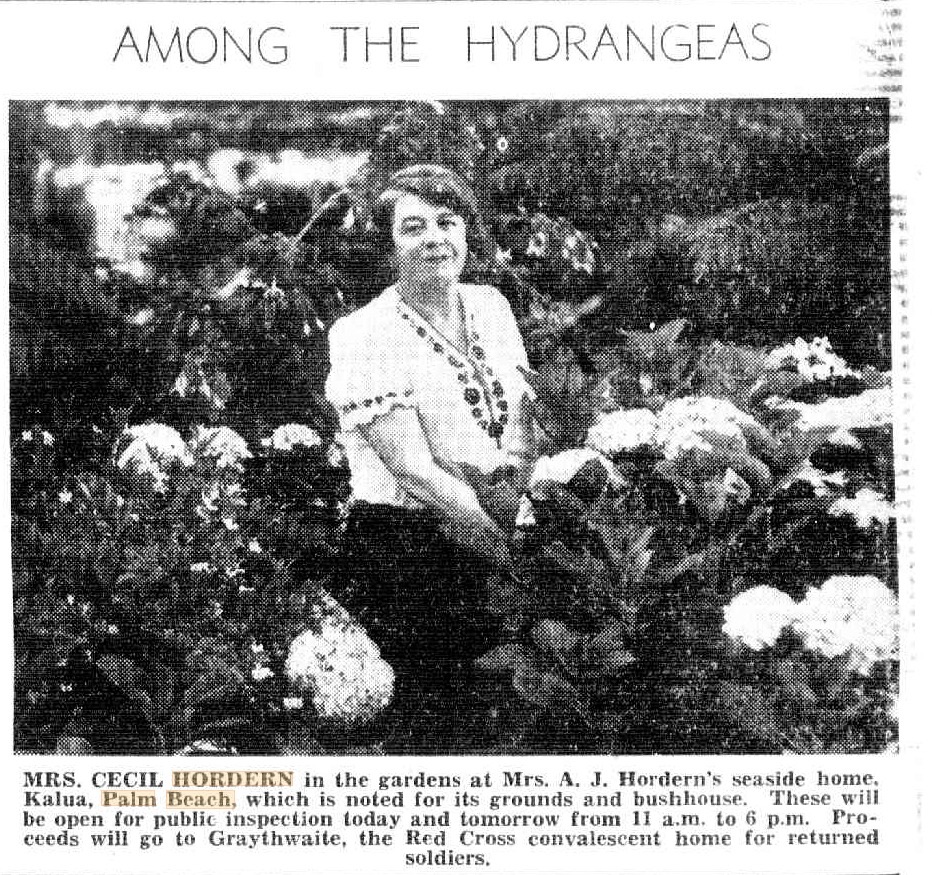
MRS. CECIL HORDERN in the gardens at Mrs. A. J. Hordern’s seaside home, Kalua, Palm Beach, which is noted for its grounds and bushhouse. These will be open for public inspection today and tomorrow from 11 a.m. to 6 p.m. Proceeds will go to Graythwaite, the Red Cross convalescent home for returned soldiers. AMONG THE HYDRANGEAS (1937, December 4). The Daily Telegraph (Sydney, NSW : 1931 - 1954), p. 9. Retrieved from http://nla.gov.au/nla.news-article247331254
AT PALM BEACH
Although the rain spoiled the garden inspection at Mrs. A. J. Hordern's home, Kalua, Palm Beach, on Saturday, a large crowd visited the gardens yesterday. The proceeds will go to Graythwaite, the Red Cross home.
Mrs. Hordern entertained a house party at Kalua this weekend. Her guests included Mrs. Cecil Hordern, Misses Thelma and Dulcie Sheedy, Mr. and Mrs. Clive Savage, Mr. and Mrs. George Hull, Mr. and Mrs. Jim McLeod, Misses Joan and Lorraine See, Mrs. Vero Read, and Messrs. Arthur and Peter Hordern. [ Daily Telegraph (Sydney, NSW : 1931 - 1954), Monday 6 December 1937, page 10]
The above 'three views' is found in a State Library of NSW Album 'Hordern's Home, Palm Beach, 6 December 1937', although obviously photographed prior to appear in a newspaper dated December 1 - the photographs were taken by N. Herfort. Those images also provide a few other aspects of the gardens of Kalua as they were then:
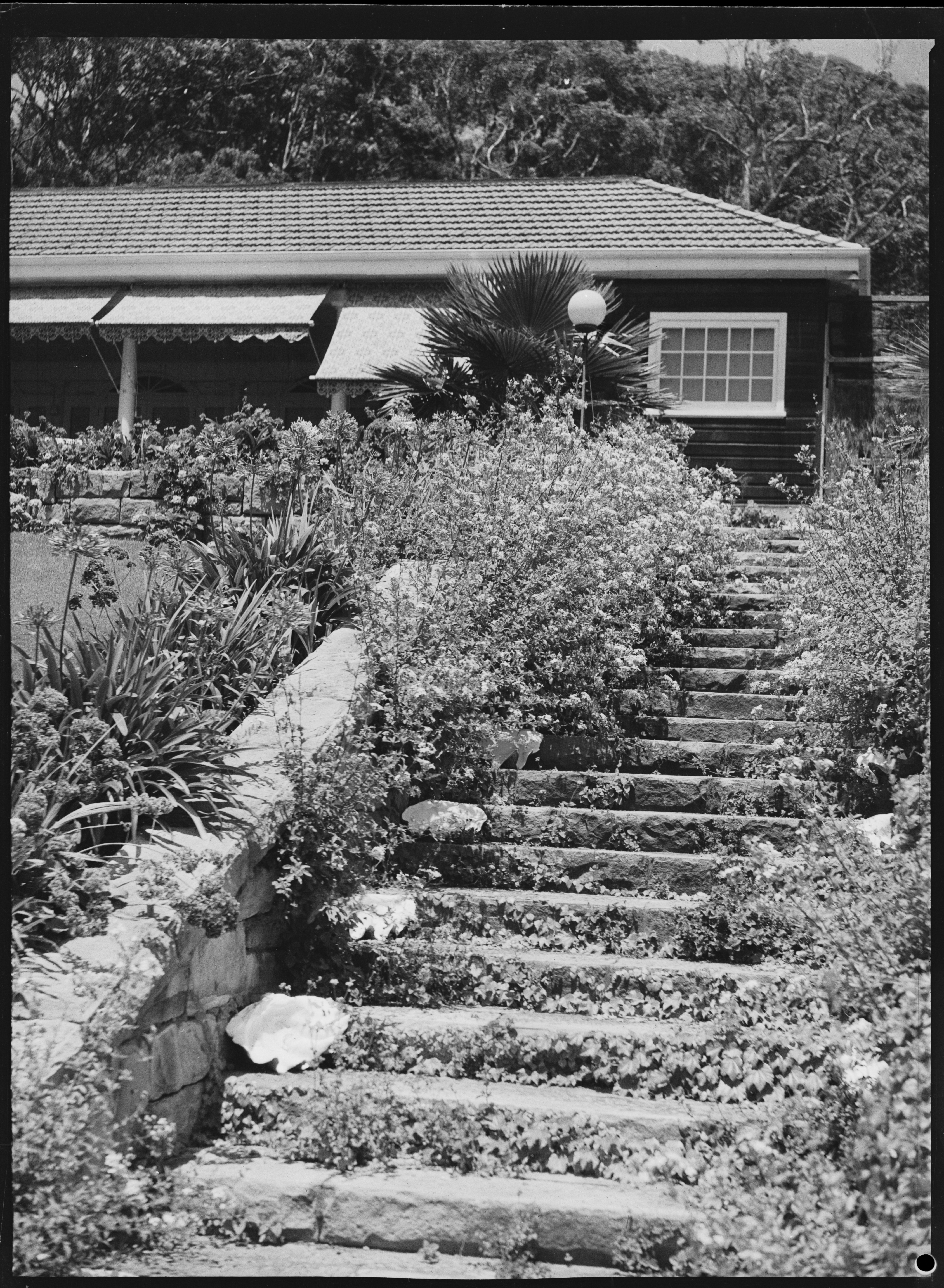
"Kalua", Palm Beach, NSW, owned by the Hordern family, approximately 1937 Item: SLNSW_FL18896304, Courtesy State Library of NSW
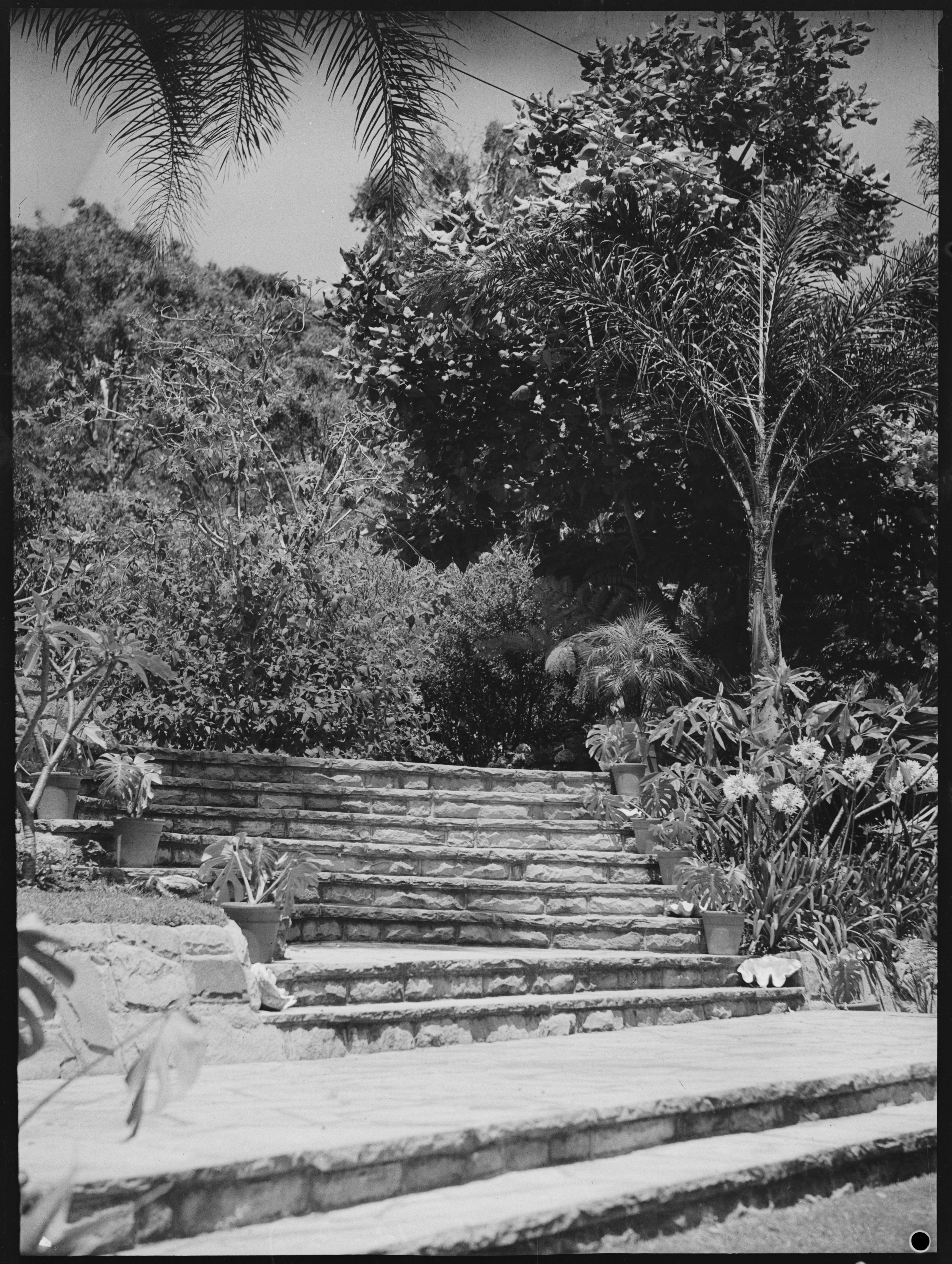
The steps at "Kalua", Palm Beach, NSW, owned by the Hordern family, approximately 1937 Item: SLNSW_FL18896305, Courtesy the Mitchell Library, State Library of NSW
Also Items: SLNSW_FL18896206 and SLNSW_FL18896207 (the 'Bush-house' and view back to the house), SLNSW_FL18896208, SLNSW_FL18896280 and SLNSW_FL18896287, SLNSW_FL18896307, Courtesy the Mitchell Library, State Library of NSW:
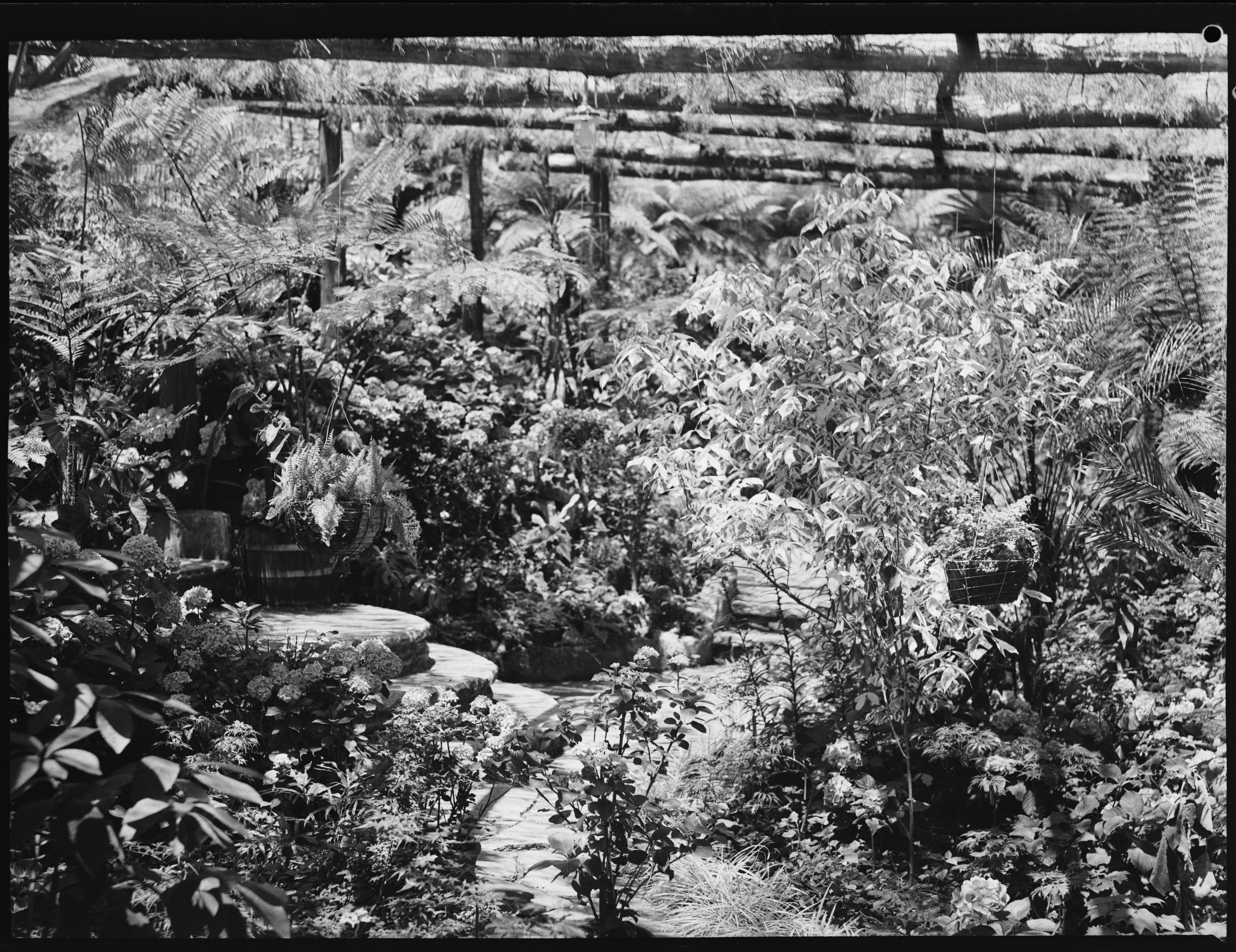
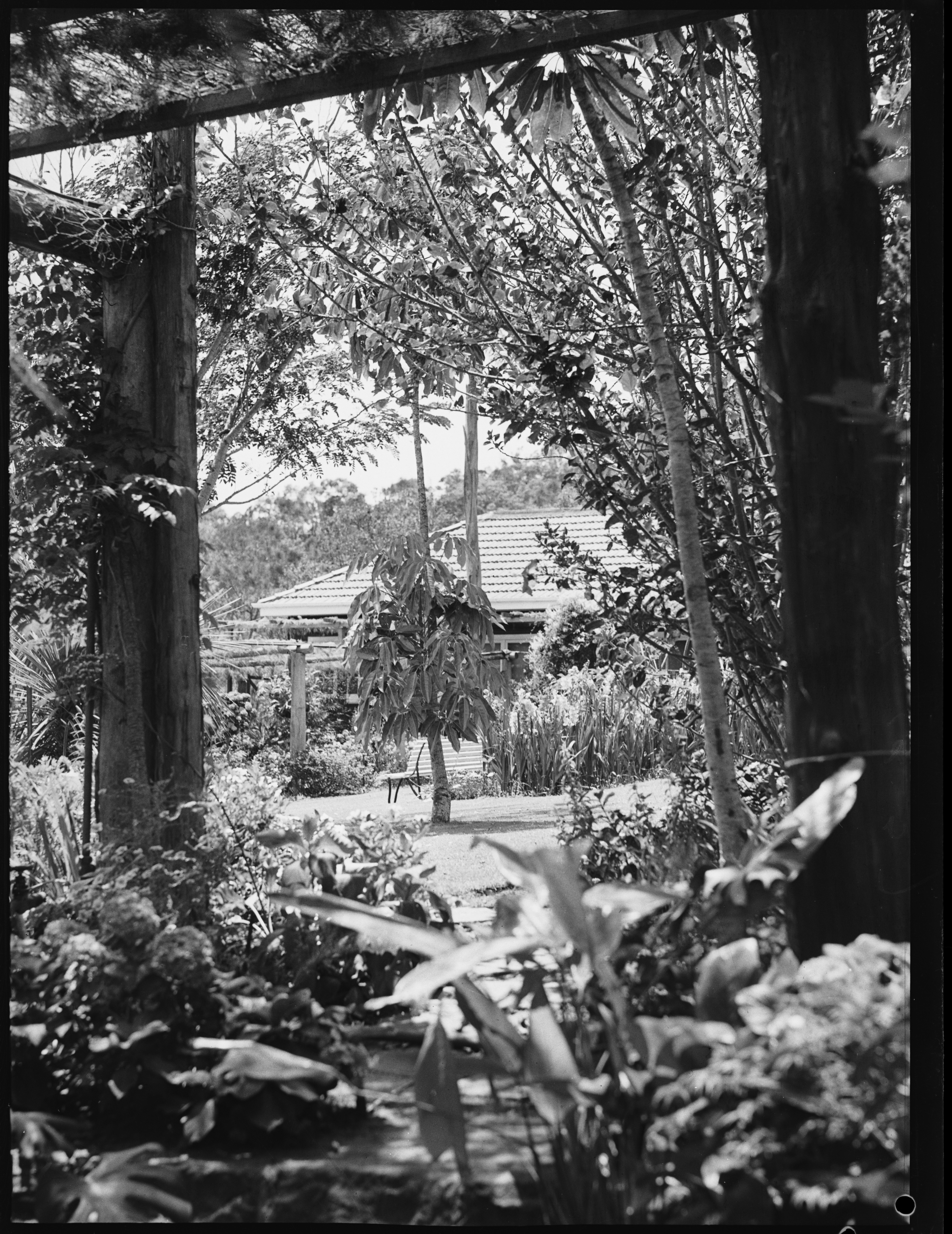
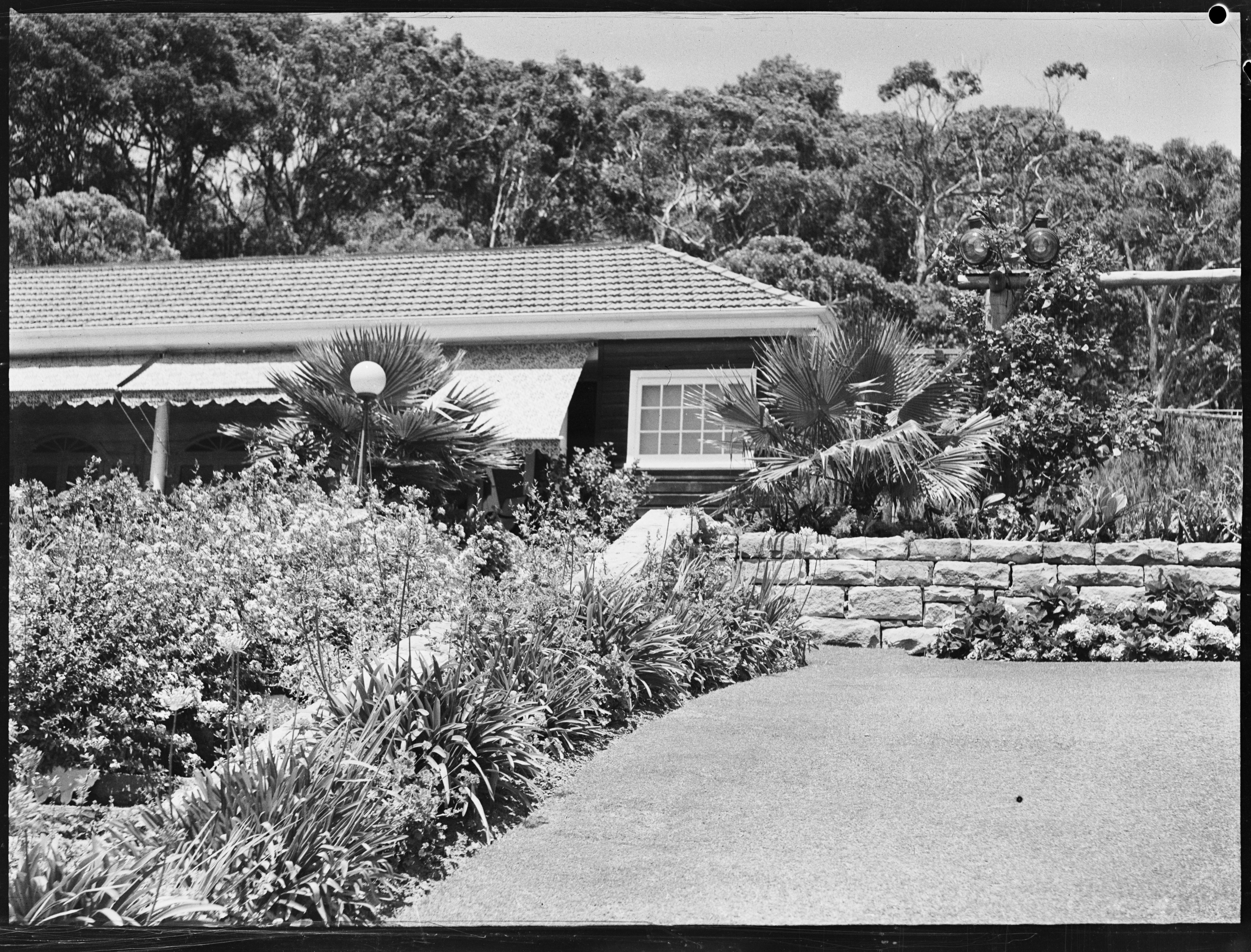
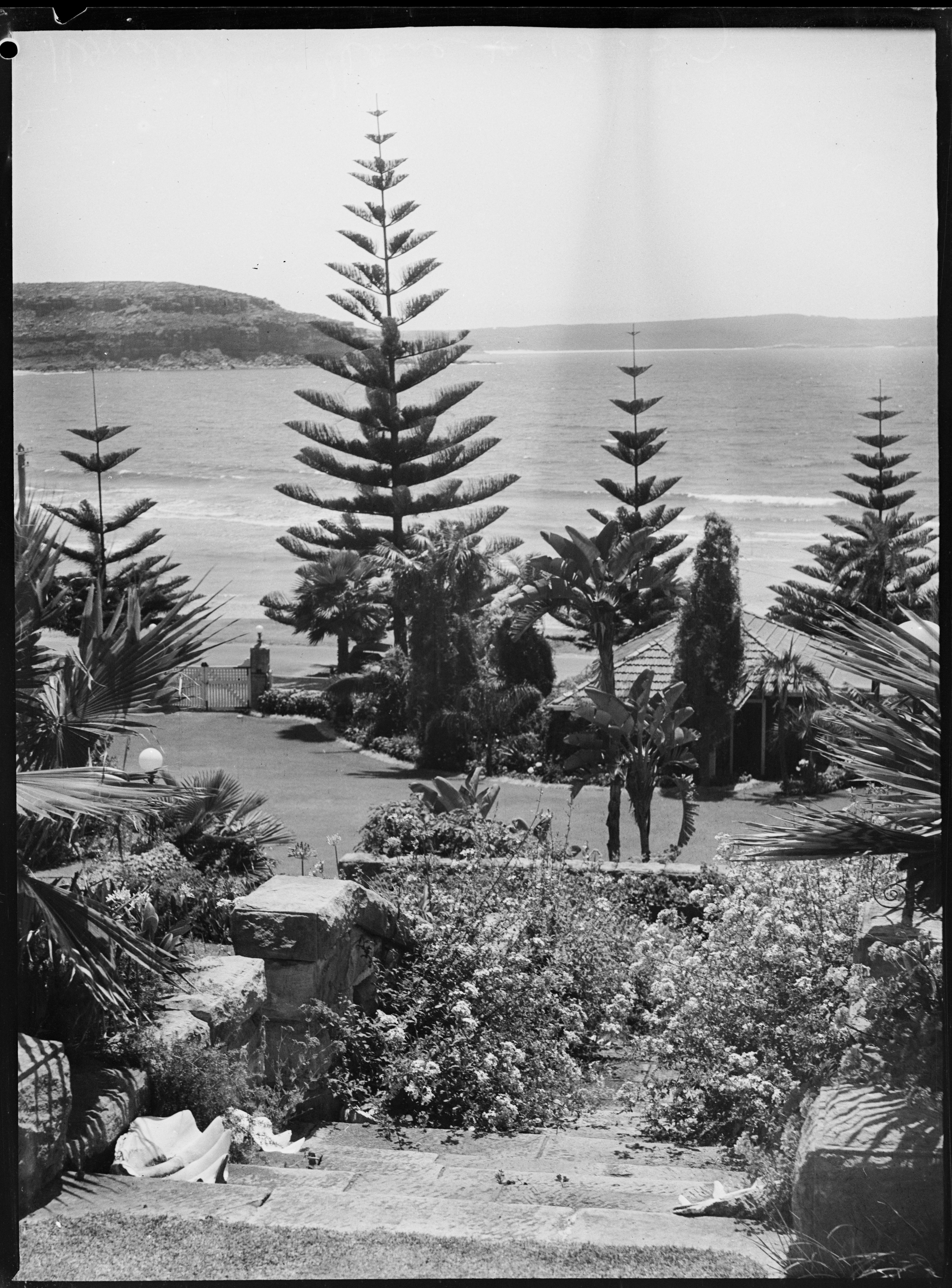
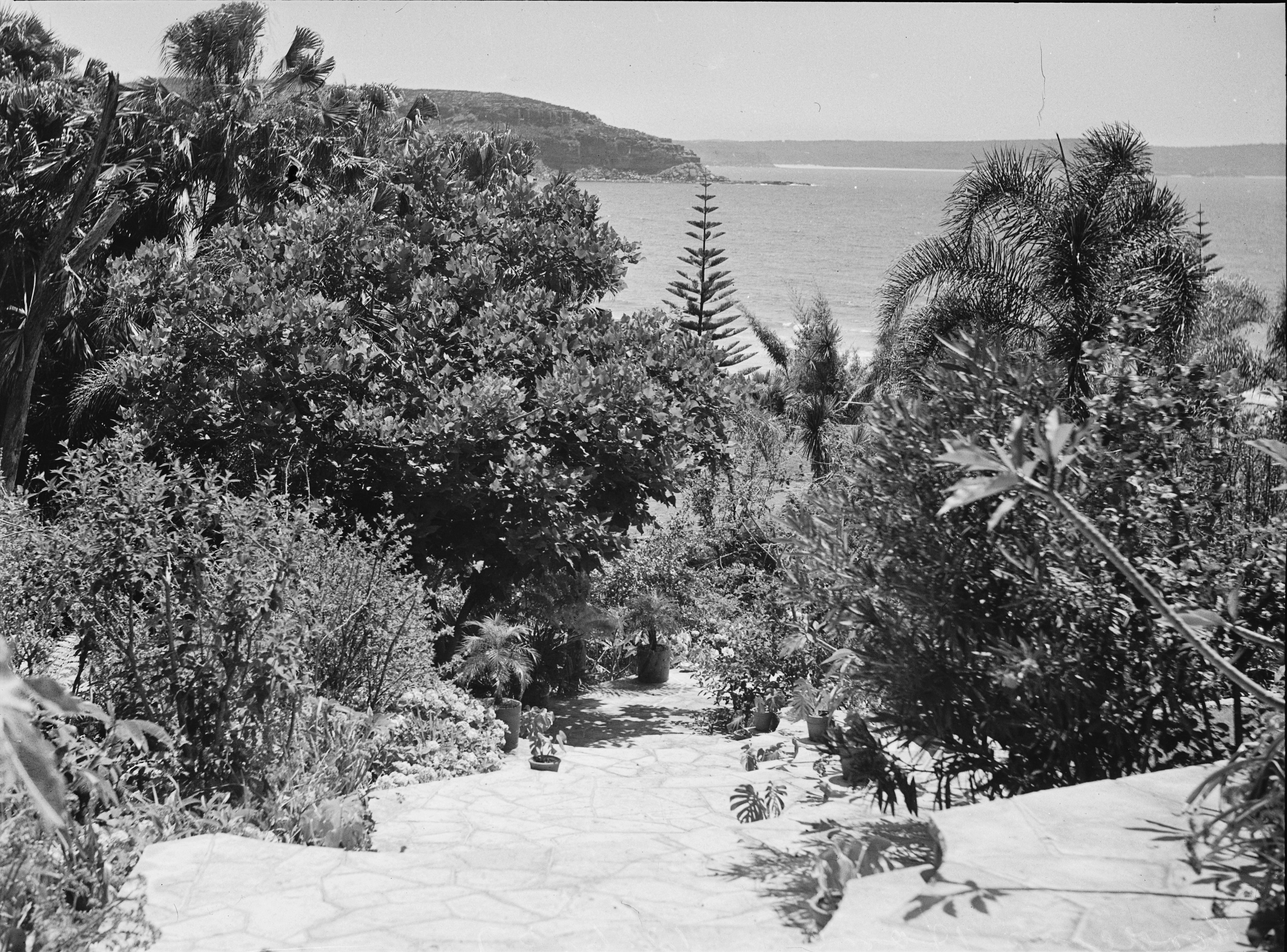
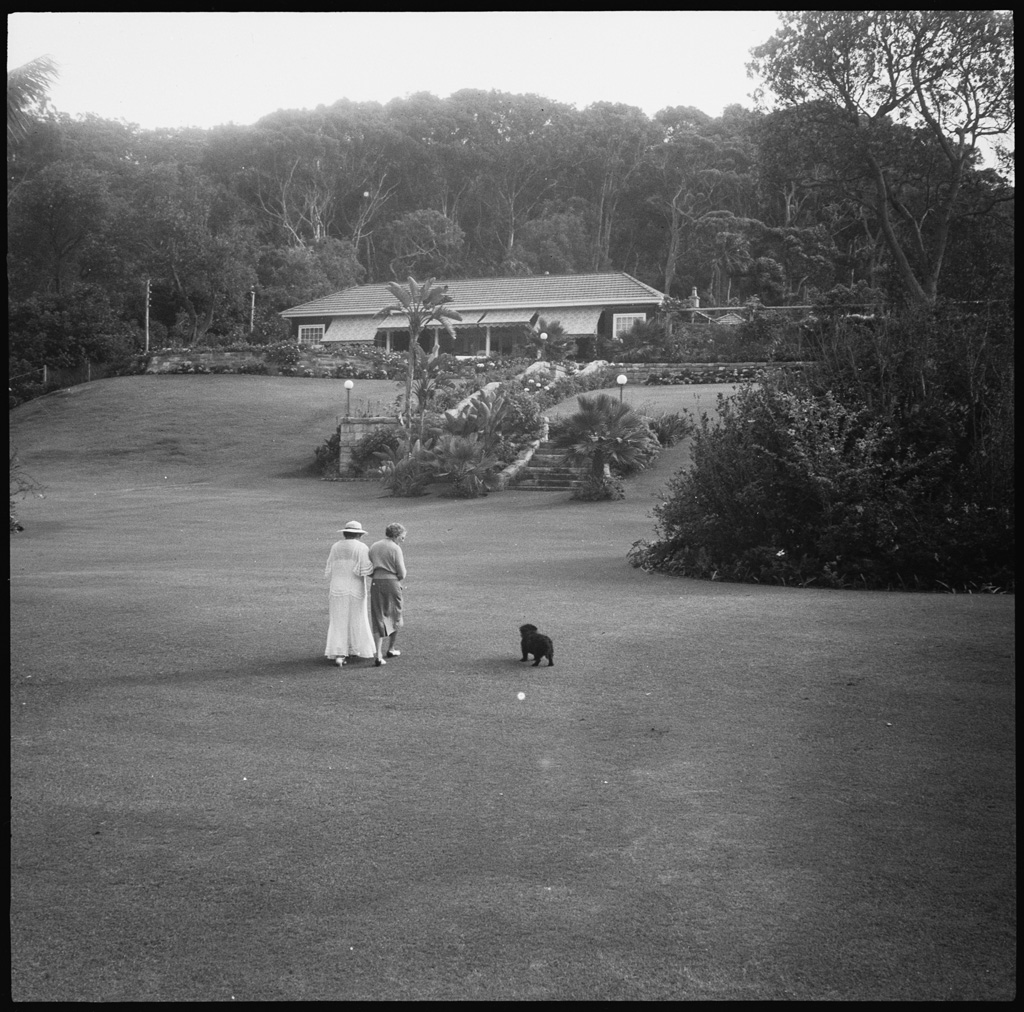
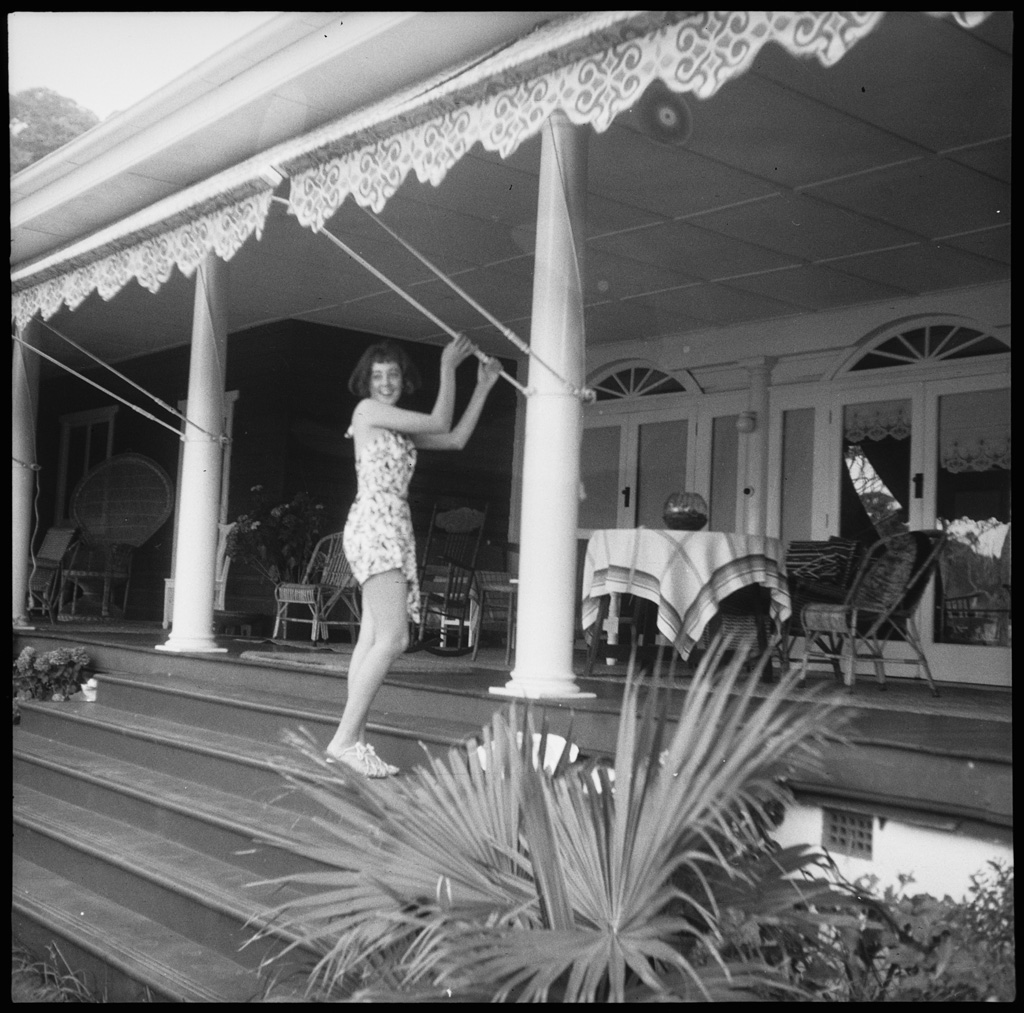
.jpg?timestamp=1706738681565)
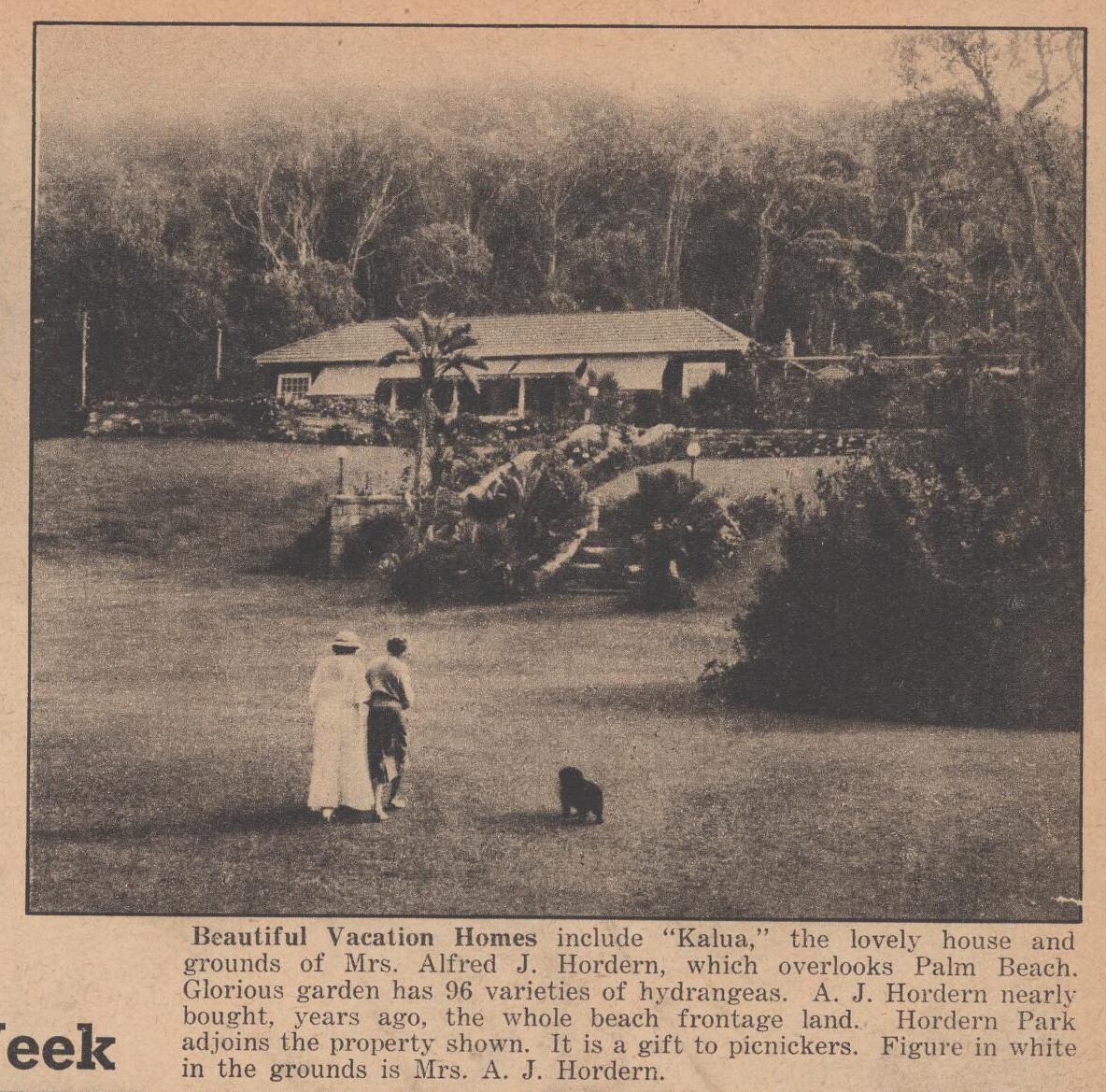
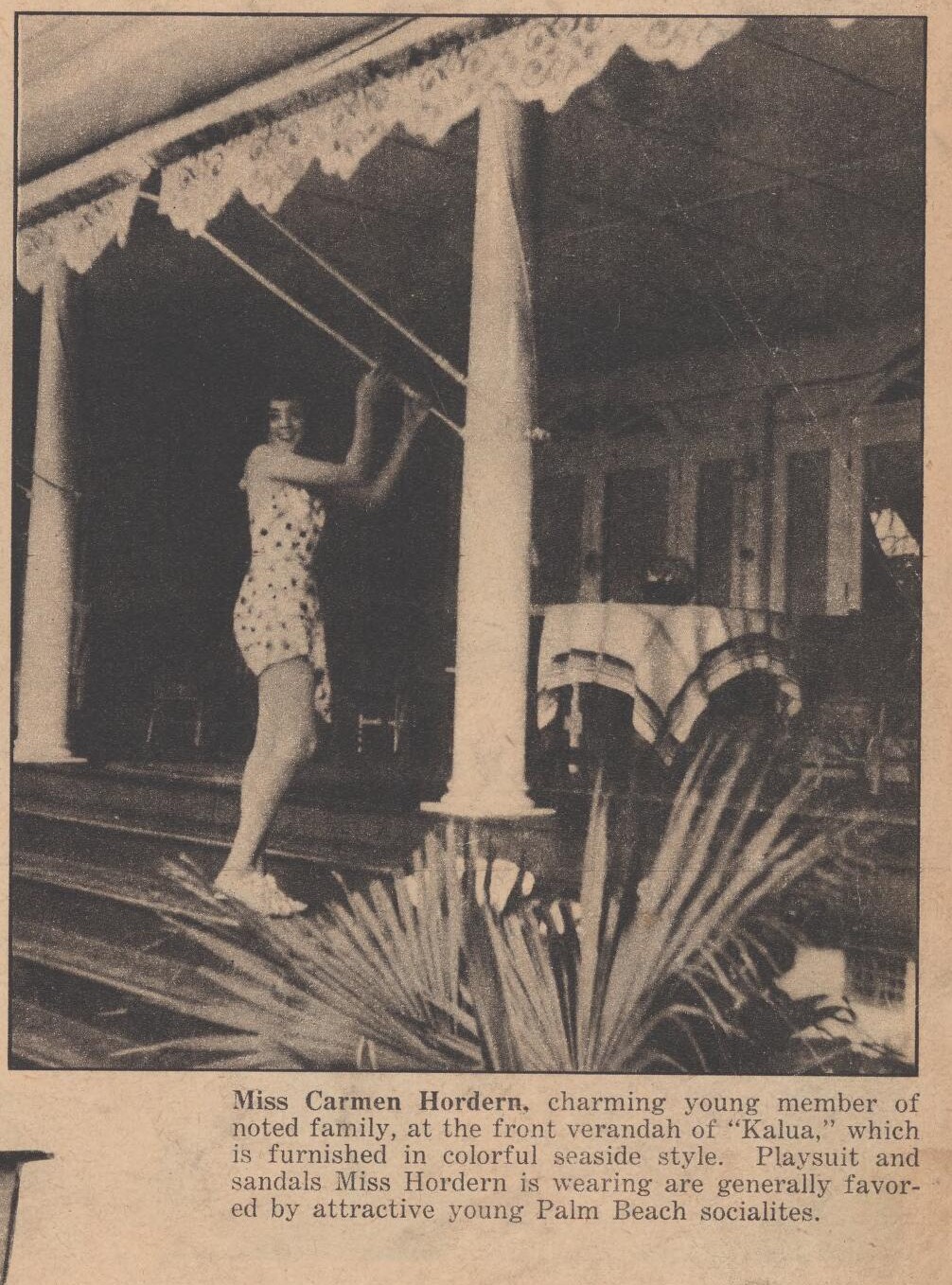
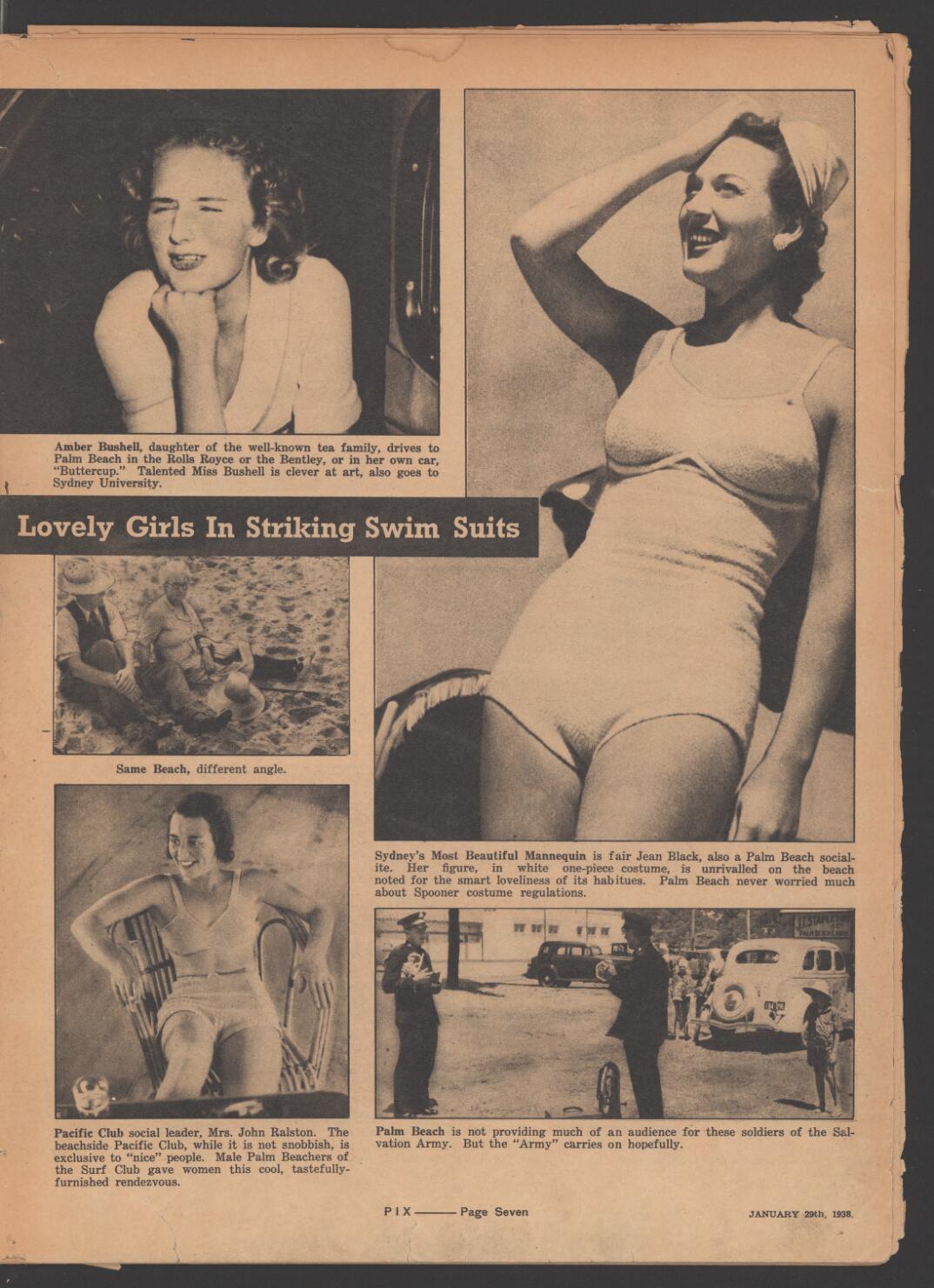
%20larger.jpg?timestamp=1706738732948)
Glenburnie Park becomes Hordern Park
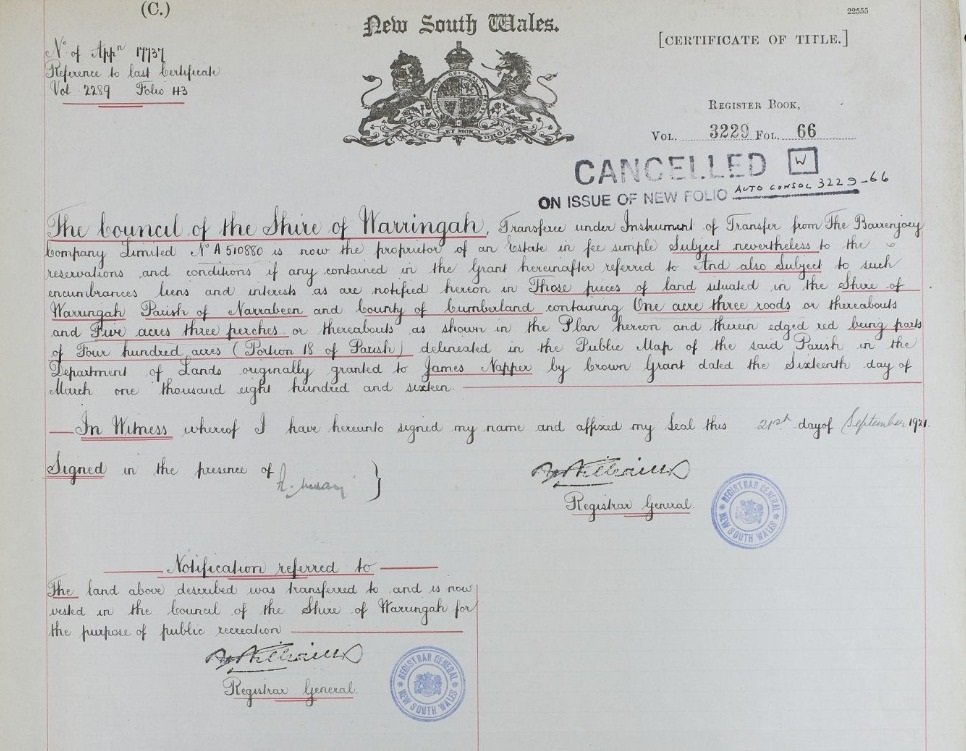
%20Palm%20Beach%20front.jpg?timestamp=1655245854098)
%20Palm%20Beach%20front.jpg?timestamp=1655245877060)
IN THE MATTER OF THE BARRENJOEY COMPANY, LIMITED.
AT an Extraordinary General Meeting of the above named Company, duly convened and held at 92b Pitt street, Sydney, on the nineteenth day of June, one thousand nine hundred and twenty-four, the following Resolution was duly passed, and at a 'subsequent Extraordinary General Meeting of the Members of the said Company, also duly convened and held at the same place', on Monday, the seventh day of July, one thousand nine hundred and twenty-four, the same Resolution was duly confirmed, as a Special Resolution, viz.: —
That as a result of the recent disposal of substantially the whole of the Company's land, it is advisable to wind-up the Company and accordingly that the Company be wound up voluntarily; and at such last-mentioned Meeting the following Extraordinary Resolutions were passed: —
1. That George Mason Allard, John Malbon Ralston, Ernest Ebenezer Way, and Harry Wolstenholme, be appointed Liquidators for the purpose of such winding-up.
2. That their salary be fixed at one hundred and eighty pounds among them for the first year.
3. That, as regards Mr. J. M. Ralston, he shall be entitled, in addition to his remuneration as a Liquidator, to be paid all usual Solicitor's Profit Costs and Disbursements in connection with any legal work which he may be instructed to do by the Liquidators in his capacity as solicitor.
Dated at Sydney, this 17th day of July, 1924.
H. WOLSTENHOLME, Chairman.
Witness,—E. E. G. de Gyulay. £1 12s.
IN THE MATTER OF THE BARRENJOEY COMPANY, LIMITED. (1924, July 18). Government Gazette of the State of New South Wales (Sydney, NSW : 1901 - 2001), p. 3572. Retrieved from http://nla.gov.au/nla.news-article222025488
The Council Meeting of May 26th, 1924 presents some confusion as most of the land held by the Barrenjoey Company had since been transferred to the Palm Beach Lands co. - Mr. Ralston's son ended up clearing all this up, with some of these Lots creating Wilshire Park, but this record shows that the Golf Course subdivisions left a few problems in regard to the accessway:
Councillor Rayner raised the question as to whether, certain reserves at Palm Beach, promised by the Barrenioey Company had actually been dedicated to the Council, and it its resolved, - (Crs. Campbell and Rayner) That the Shire Solicitors be asked to make sure whether Lot 92 has actually been transferred as arranged, also the adjacent right- of-way between lots 83 and 84 running from Ocean Road to Florida Road, also the reserve between Ocean Road and Florida Road adjoining Lots 88 and 89 between them and Lot 177 and that if these have not been dedicated, they lodge a caveat against any dealings with the land. t. Resolved, - (Cra. Rayner, Hewitt) That the Barrenioey Co. do be written to pointing out that it has always been understood to have been, the Company's intention to dedicate Lot. 84 as a public reserve, that they kindly have the matter completed. Resolved, - (Crs. Hitchcock, 0esbe1l) That the Works Committee when next down at Palm Beach look into the matter of the Golf footway leading from the dead-end Of North View Road, 'Golf Links Estate, having been constructed on private lands instead, of the surveyed pathway, and also look into any other matters that may crop up in the meantime, and the Representatives of the Riding be invited to be present.
THE BARRENJOEY COMPANY LIMITED, (In Voluntary Liquidation).
Notice of General Meeting.
NOTICE is hereby given in pursuance of section 141 of the Companies Act, 1899, that a General Meeting of the Members of the abovenamed Company will be held at the registered office, 92b Pitt-street, Sydney, on Tuesday, the 14th day of May, 1929, at 4 o'clock in the afternoon, for the purpose of having an account laid before them showing the manner in which the winding-up has been conducted and the property of the Company disposed of, and of hearing any explanation that may be given by the Liquidators; and also determining by Extraordinary Resolution the manner in which the books, accounts and documents of the Company and the Liquidators thereof shall be disposed of.
Dated the tenth day of April, 1929.
H. WOLSTENHOLME, E. E. WAY, J. M. RALSTON, ) Liquidators. 3281 £1 2s. THE BARRENJOEY COMPANY LIMITED (IN VOLUNTARY LIQUIDATION). (1929, April 12). Government Gazette of the State of New South Wales (Sydney, NSW : 1901 - 2001), p. 1670. Retrieved from http://nla.gov.au/nla.news-article223026442
First directors:
Palm Beach Lands, Ltd., has effected registration with an authorised capital of £15,000, In £1 shares. To traffic in land, house, and other property is the aim of the new company. First directors: R. R. M'Kay, E. B. Harkness, and A. M. K. Scott. COMPANY NEWS. (1924, July 31). The Sydney Morning Herald (NSW : 1842 - 1954), p. 11. Retrieved from http://nla.gov.au/nla.news-article16177971
In fact R T McKay was Chairman of this new company, not R R McKay. This new group enlisted the expertise of Willmore and Randell, who were looking after Avalon Beach subdivisions by then. Their take on selling block of land at Palm Beach was to focus on the company new owners would be among, not the permanent residents.

Misnamed one – is named 'Whale Beach' and actually Palm Beach
EB Studios (Sydney, N.S.W.). (1917). Panorama of Whale Beach, New South Wales Retrieved from http://nla.gov.au/nla.obj-162483691 - view from further back along Sunrise road back towards beach road with Pacific road going up the hill – says ‘Palm Beach No.: 5’ at left hand base of pano. Part of those commissioned by Barrenjoey Land Company - possibly taken around same time those for Whale Beach panoramas and subdivision pamphlets were taken. Palm Beach Land Company cottage sold to Robson Scott on corner of Palm Beach Road and Pacific road opposite what would become stone Maitland home. Peters home still not present on beach, only Chorleys, so certainly circa 1917, but possibly earlier - 1915.
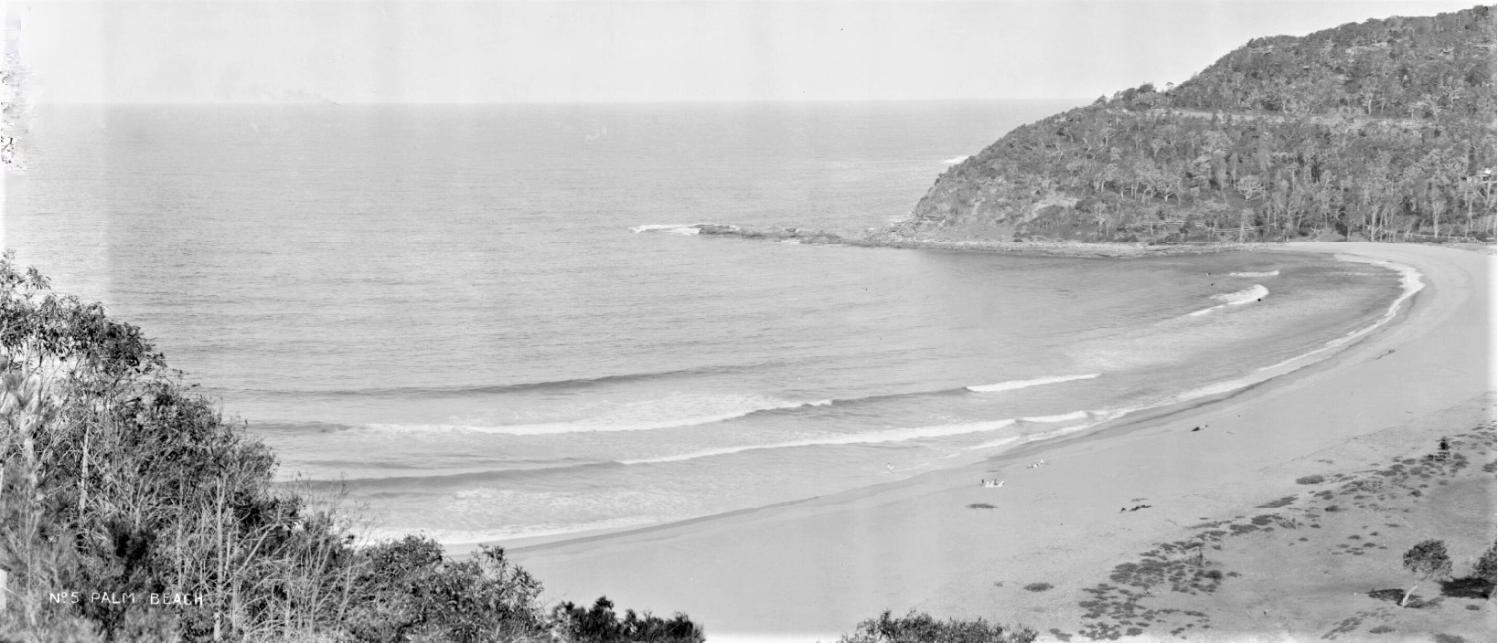
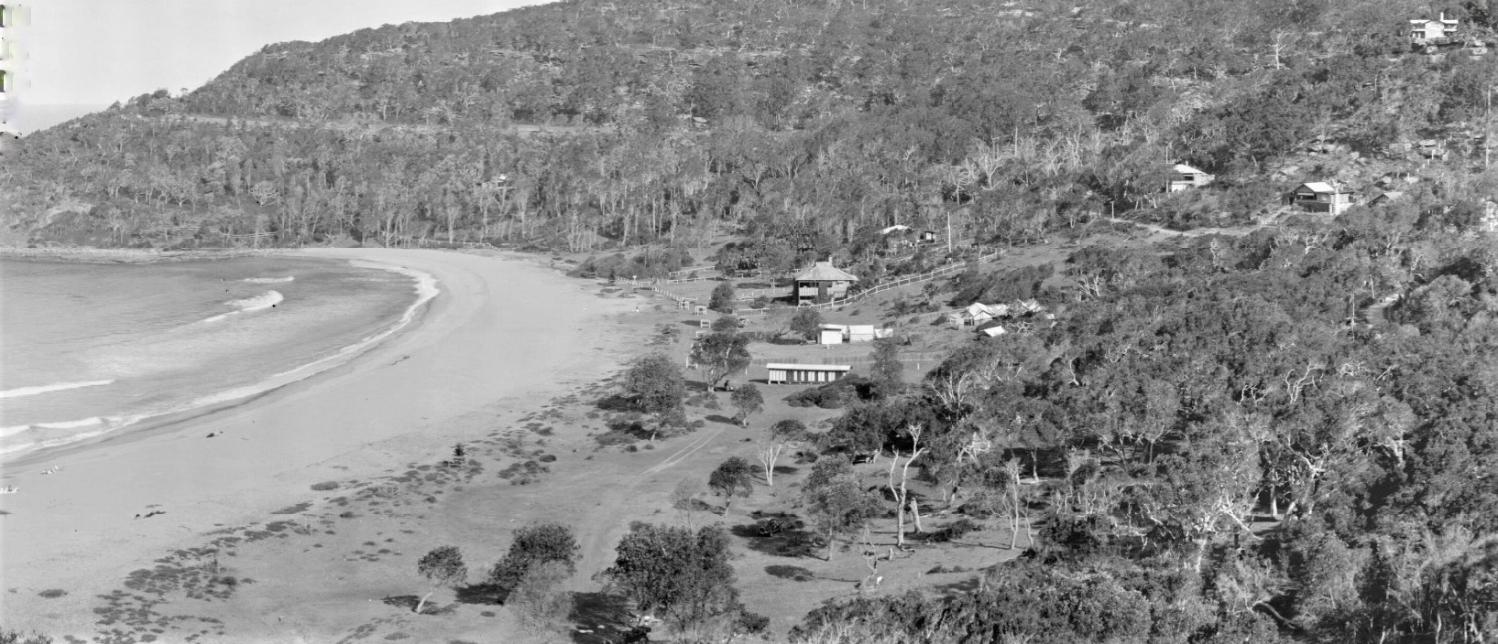
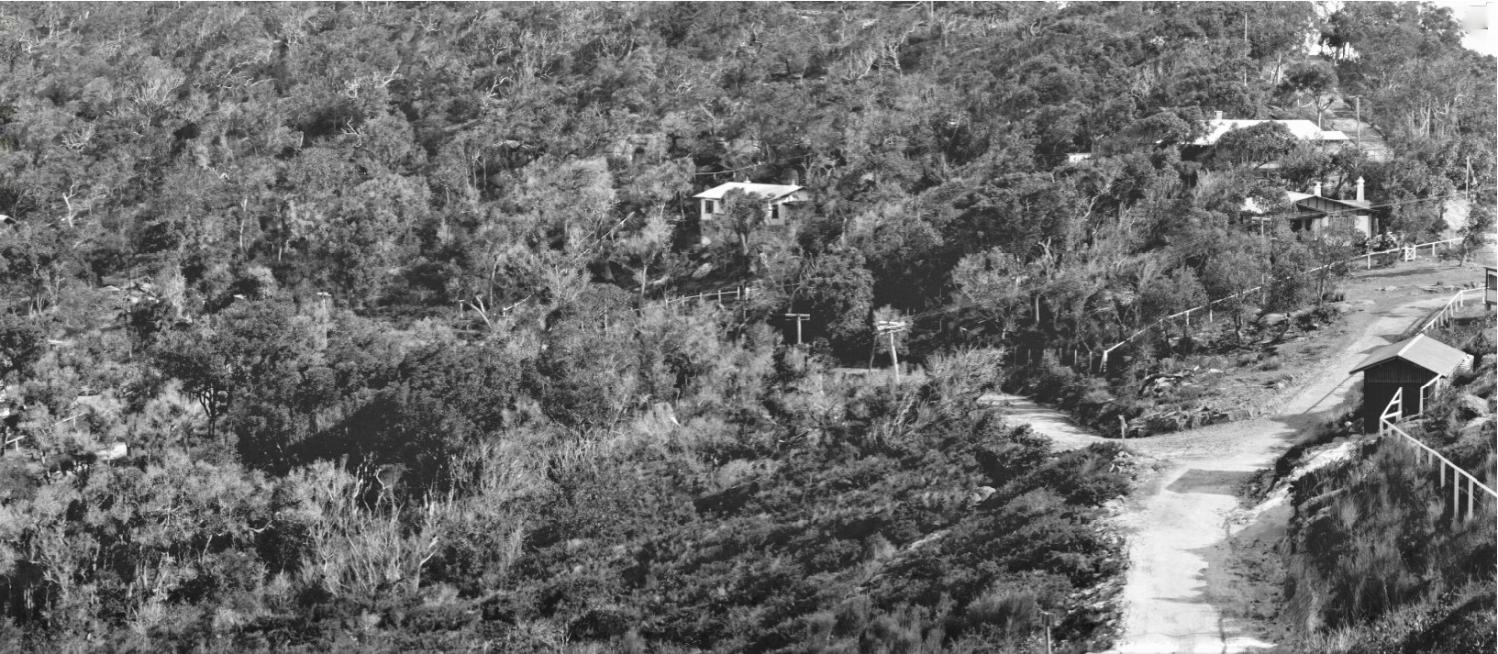
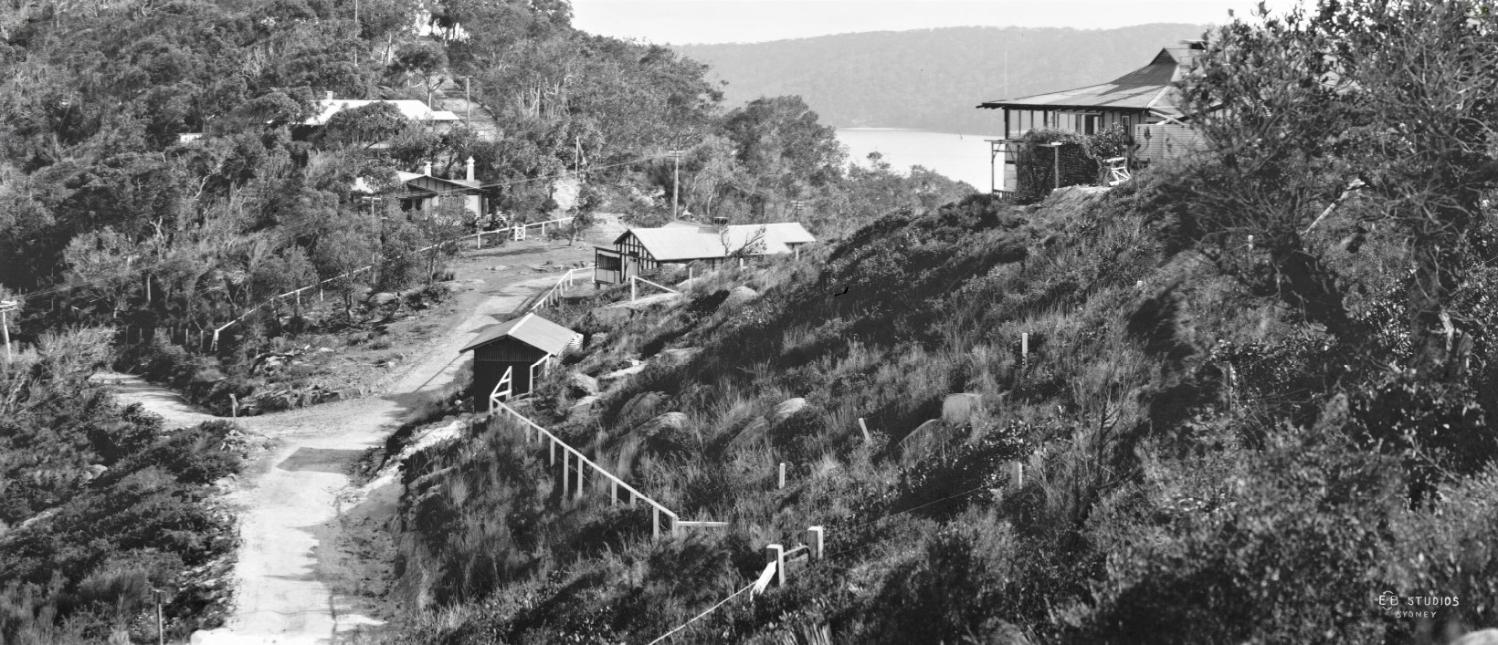
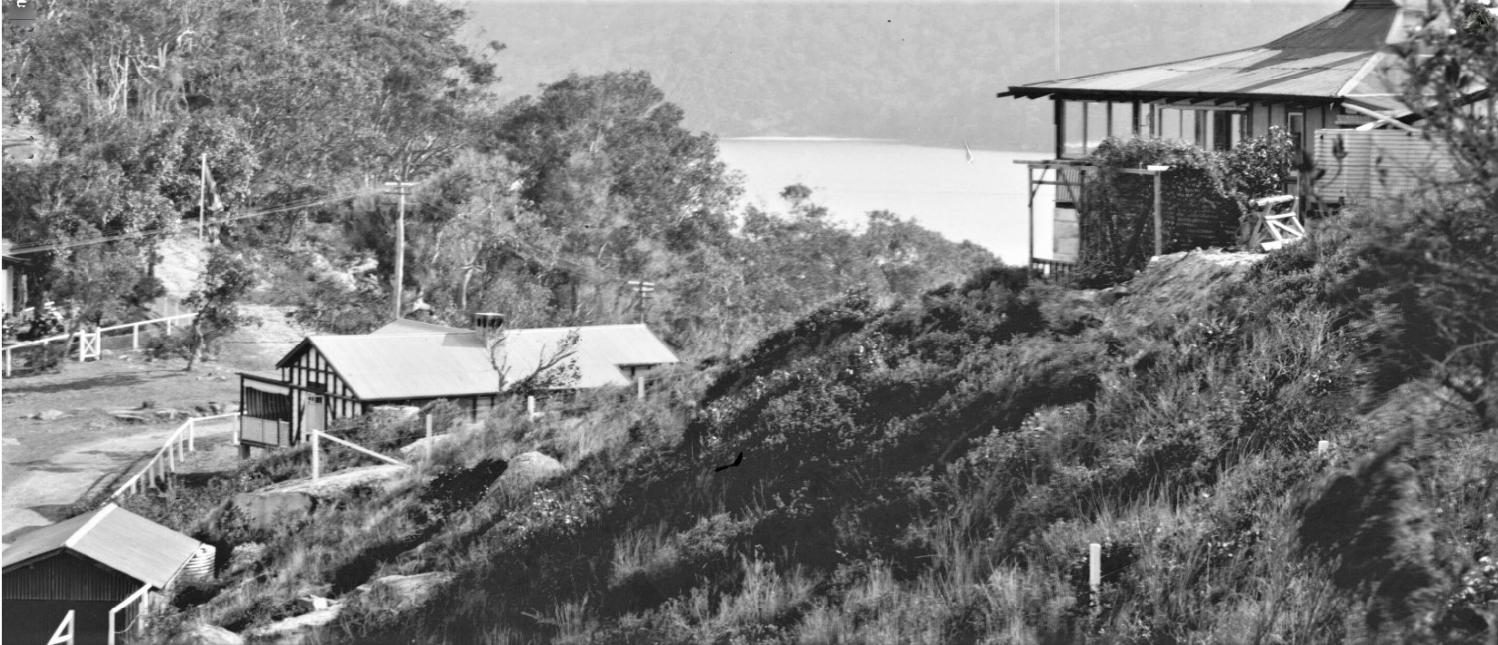
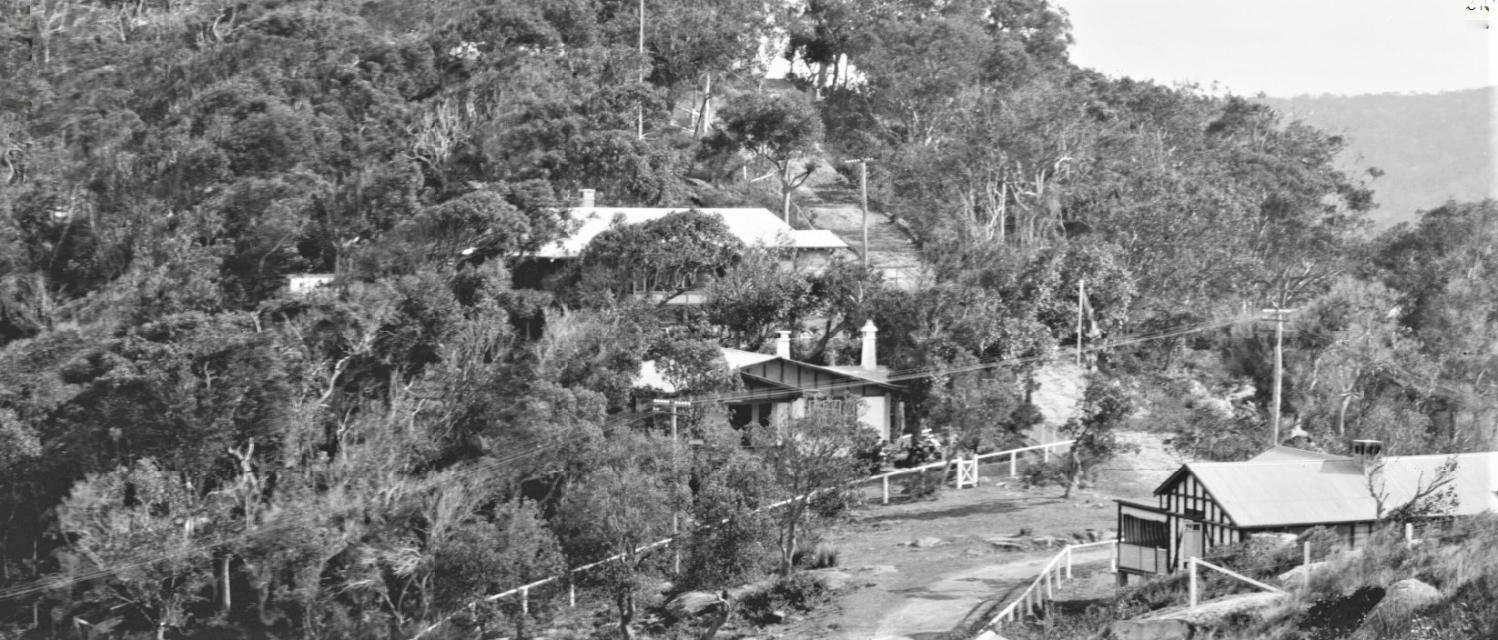
EB Studios (Sydney, N.S.W.). (1917). Panorama of Palm Beach, New South Wales, 6 Retrieved from http://nla.gov.au/nla.obj-162484292 - taken from Sunrise Road - views south over towards estuary with Pacific (going up the hill) visible as well as Palm Beach Road where joins Florida and where Livistonia Lane now is. Part of second images taken, possibly for either 1922 subdivision of lots above Golf Course or when Willmore and Randell acted on behalf of Palm Beach Land Company from 1924-1925 on. The same panorama appears in a December 1926 advertisement in local papers:
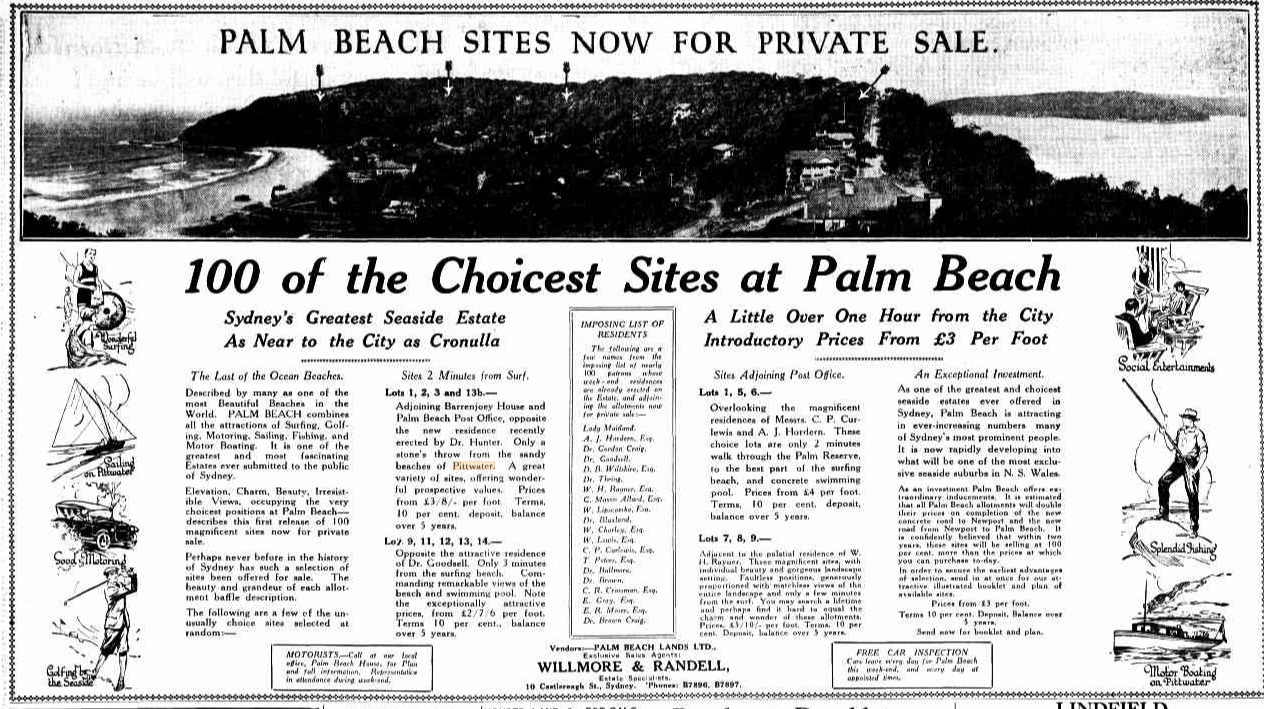
08 Jan 1926 - Advertising - Trove Palm Beach - same Panorama used

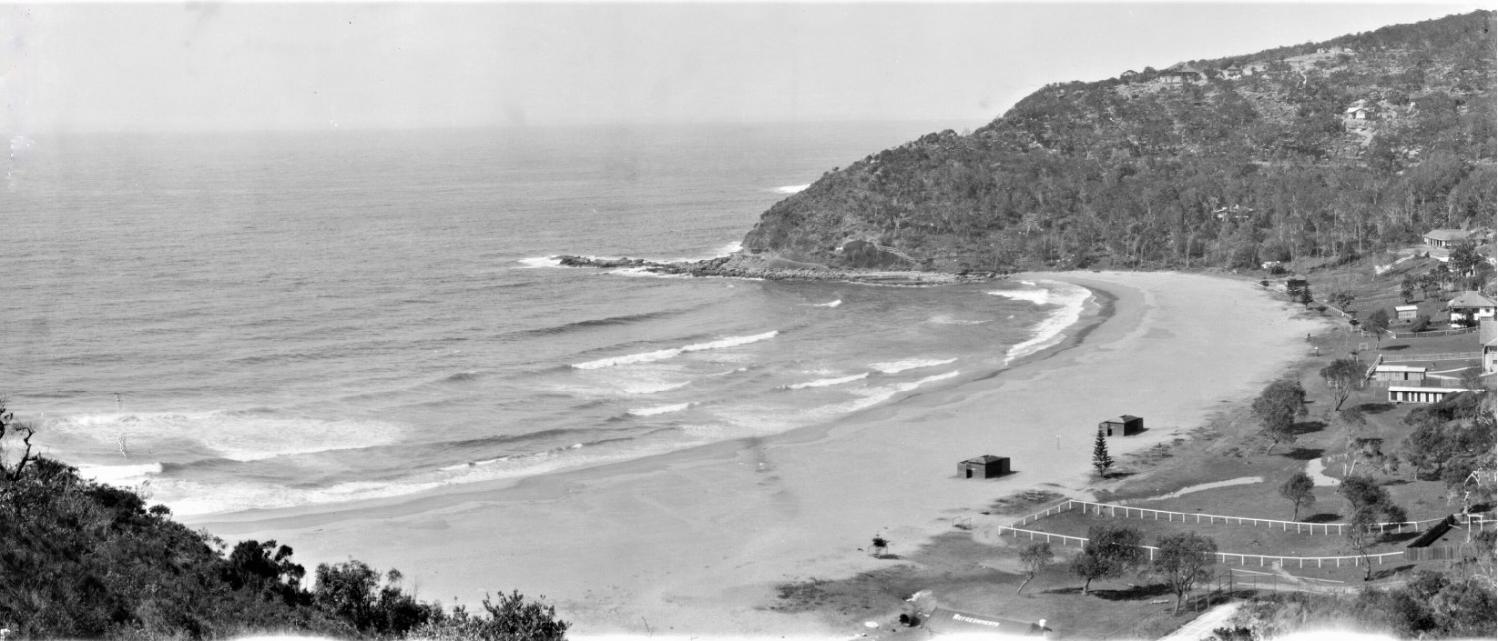
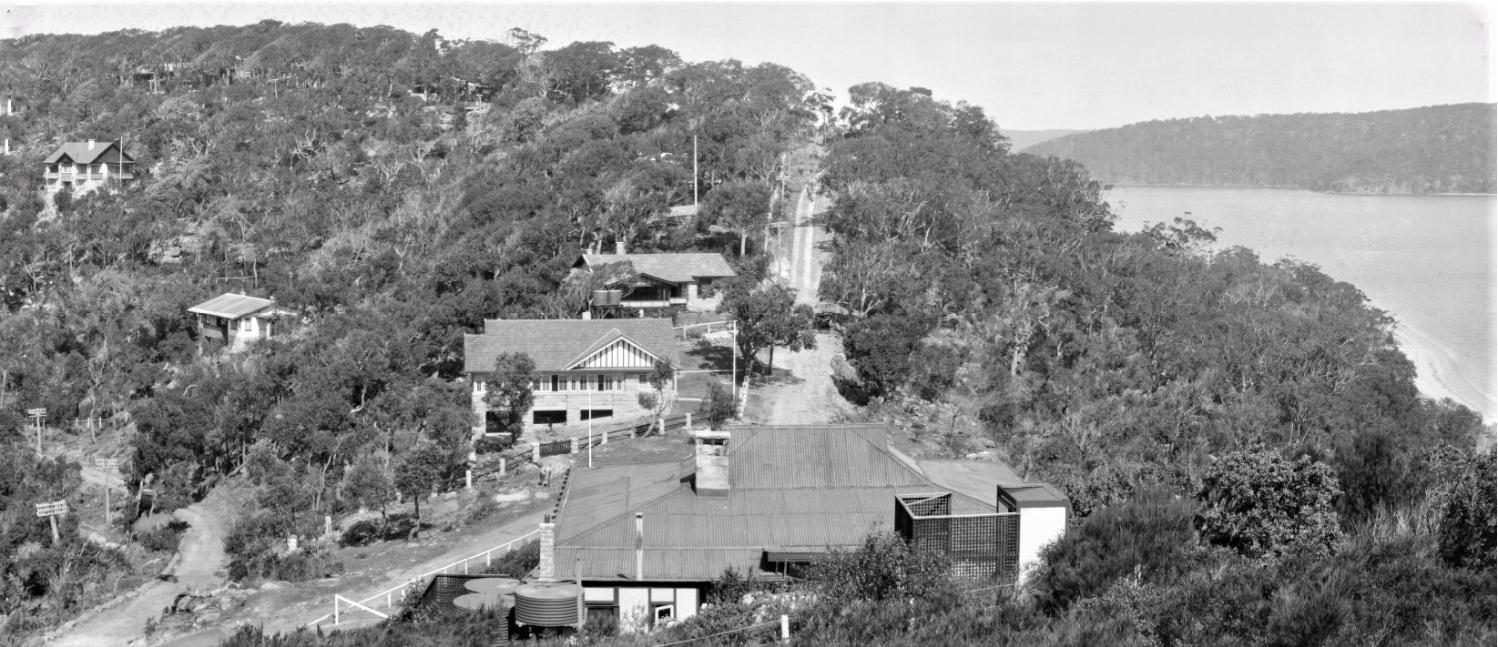
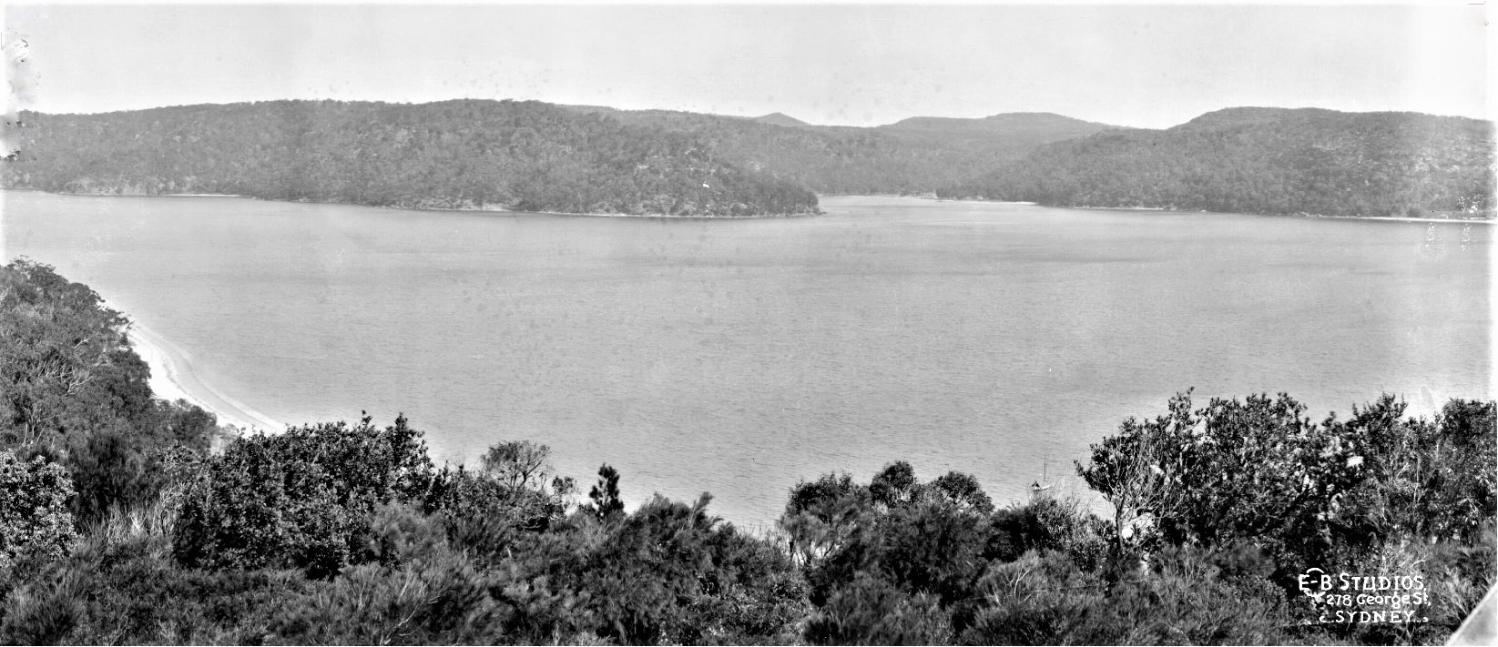

The December 6, 1926 Meeting records:
A letter from A. J. Hordern, offering £10 towards stopping the leak in Palm Beach Rock Bath, and clearing, out the stones, provided the work be completed by November 1st. Resolved, - Contrib-
A. J. Hordern . 3.12.26. drawing attention to the fact that on account of the construction work going on in the vicinity of Gow's Store on the Barrenjoey Rod, vehicular access to Palm Beach is likely to be 'cut off during the Xmas holidays Left with the Engineer to do what he considers best.
OVERSEER WORKS FOR A. RIDING was read and dealt, with as follows :- 6-. Resolved, - (Crs. Simpson, Hitchcock) That £20 extra be voted for making trafficable that portion of Ocean Road (Vote) outside of Gallagher's Contract. 8. Resolved, - (Crs. Simpson, Hitchcock) That the expenditure of £10 for the destruction of the lantana on Wilshire Park be confirmed.9. Resolved, - (Crs. Simpson, Hope) That £38 be voted for repairs to Clareville Wharf, 'as recommended in the report, the job to be made an urgent matter. (Vote) 11. Mr. A. J. Hordern's letter of 3,12.26, offering to advance the Council £100 at 4% for the completion of Palm Beach Rock Bath; provided the work be done by Xmas, was read. , Resolved, (Crs.. Hope, Simpson) That Mr. Hordern's offer be accepted, he be told of the Engineer's difficulties in the matter, and that an earnest endeavour will be made to have it done by the time mentioned.
In 1927:
A. J. Hordern be informed that the cost of making Palm Beach Rock Bath water-tight is just under £50, and the Council will not require his loan to be of any greater amount.
in 1928:
A.J. Hordern. 19/6/28. Submitting two proposals for improvements to public reserves at Palm Beach and offering to lend the necessary money-for three years at ... Referred Reserves to the Works Committee to discuss the matter with Mr. Hordern.
A.J.. Hordern's offer to lend the Council money for the improvement of reserves at Palm Beach Loans and the establishment of a parking area was held over until later in the meeting, in order that the Engineer might submit additional information.
The Shire Engineer verbally reported that the cost of making Palm Beach parking area on the ocean beach reserve at Palm Beach, as it serves suggested by Mr. A.J.Hordern, would be about £150. Resolved a . (Crs. Hitchcock, Cpbell) -'That Mr. Hordern's offer of a loan for this work, and also for improvements to the-reserve adjoining his place, be accepted, and the work be put in hand, as soon as the money is available, tenders to be called for filling.
In the Winter of 1932 Alfred James Hordern passed away:
LATE MR. A. J. HORDERN.
Probate is being sought of the will and codicil of Mr. Alfred James Hordern, of Myra-street, Wahroonga, who died in August last at the age of 73 years. The value of the estate has been sworn for probate at £79,431; these is also certain estate outside New South Wales. The trustees of the estate are the widow (Mrs. Caroline Hordern), Mr. Bruce Alexander Hordern (a son of the testator), Mr. William John Creagh (solicitor), and the Perpetual Trustee Co., Ltd. LATE MR. A. J. HORDERN. (1932, December 14). The Sydney Morning Herald (NSW : 1842 - 1954), p. 9. Retrieved from http://nla.gov.au/nla.news-article16938014
LATE MR A J HORDERN
The estate of Mr Alfred James Hordern, late of Wahroonga, who died on August 15, has been sworn for probate at £79,431. By his will Mr Hordern appointed Mr. W. J. Creagh and the Perpetual Trustee Co Ltd to be trustees and executors and bequeathed and devised his estate for the benefit of his widow and children and other relatives PROBATE OF WILLS. (1932, December 17). The Sydney Morning Herald (NSW : 1842 - 1954), p. 10. Retrieved from http://nla.gov.au/nla.news-article16938723
Minutes of Meeting of Warringah Shire held Monday January 16th 1933:
The following requests, submitted by the Councillors named, were agreed/to:- Glenburnie By Cr. Hitchcock- That the seats in Glenburnie Park, Palm Beach, which were damaged by vandals, be reinstated by the Inspector.
At the Monday 13th September 1933 Warringah Shire Council Minutes of Meetings record a name change for Glenburnie Park to honour the input of Mr. Hordern:
The following requests, submitted by the Councillors named, were agreed to .... By Cr, Hitchcock, seconded by Cr.-Austin - That the name "Glenburnie Park" be altered to "A. J. Hordern Park" in recognition of the keen interest taken in the reserve by the late Mr. Hordern, and of the money expended by him in maintaining it.
However, that re-naming clearly took some time to be formalised. The Minutes of Meeting of Warringah Shire Council held on Monday. 23rd October. 1933 record the Horderns kept on looking after Palm each reserves:
Wilshire Park - Palm Beach, _Engineer's report para. 8 to this meeting: Cr. Hitchcock reported that Mrs. A. J. Hordern had informed him that if she were allowed to use this stone, she would in return look after the reserve. Resolved; That Mrs. Hordern's request be granted, provided she keeps the reserve in order, and that a letter be sent to H. and F. Gonsalves, warning then against taking material from the Council's properties. (Crs. Hughes, Austin)
Warringah Shire Council minutes of Meetings of November 20th, 1933: By Cr. Hitchcock - That the preparation of plans for drainage at Wilshire Park and Glenburnie Park be expedited. Careel Park; by Cr. Hitchcock - That plans for dredging Careel Park be prepared as soon as possible.
In the Minutes of Meeting of Warringah Shire held Monday December 4th 1933:
Wilshire Park Drainage: Deferred until Engineer Wilshire plans for Glenburnie Park drainage, and widening the this vicinity.
Although Alfred James Hordern is stated to have had a love of his gardens, and is credited with planting the first Norfolk pines along Palm Beach, it is more likely Caroline who undertook organising gardeners for this work and her husband whose standing in the community of Sydney leant more weight to any requests or matters about his family.
Warringah Shire Council records from Meetings show:
R.T.McKay. 16/4/34, requesting that the long oak trees which are decayed at the bottom, on Hordern Park, Park Beach, be cut down, as they are about to fall and will destroy young trees planted by Mr. Hordern, or will injure his fence. Resolved, - That Mr. R. Howlett be given permission to remove the trees. (Crs. Hitchcock., Hughes) 64. Same, 16/4/34, requesting that the Water tables in Florida Road between Scott Road and the park, and between his place and Mrs. Hordern’s place, be improved, suggesting that the material from the gutter on the southern side of Florida Road be placed on the raised area on the north side. Resolved, - That a short section of Florida Road, about 2 chains, be ballasted to prevent the water crossing the road, the cost to be deducted from the Florida road vote. 65. R.L. Mortimer, 16/4/34, requesting an estimate of the cost of gravelling and tarring the frontage of his stores at Mona Vale. Referred to the Engineer for report.
However, this 1937 photos shows the name change was accepted by the State Government and the sign erected, and even provide a glimpse of Kalua right next door:
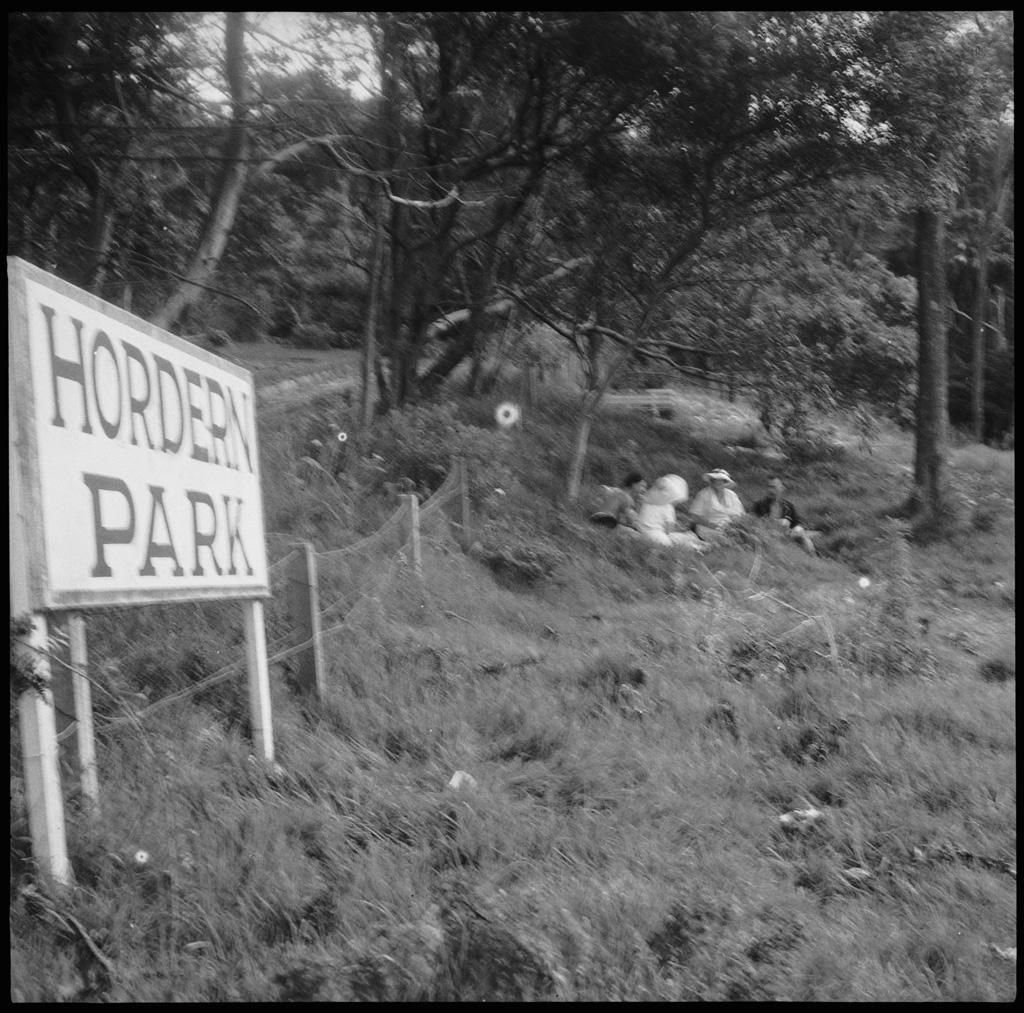
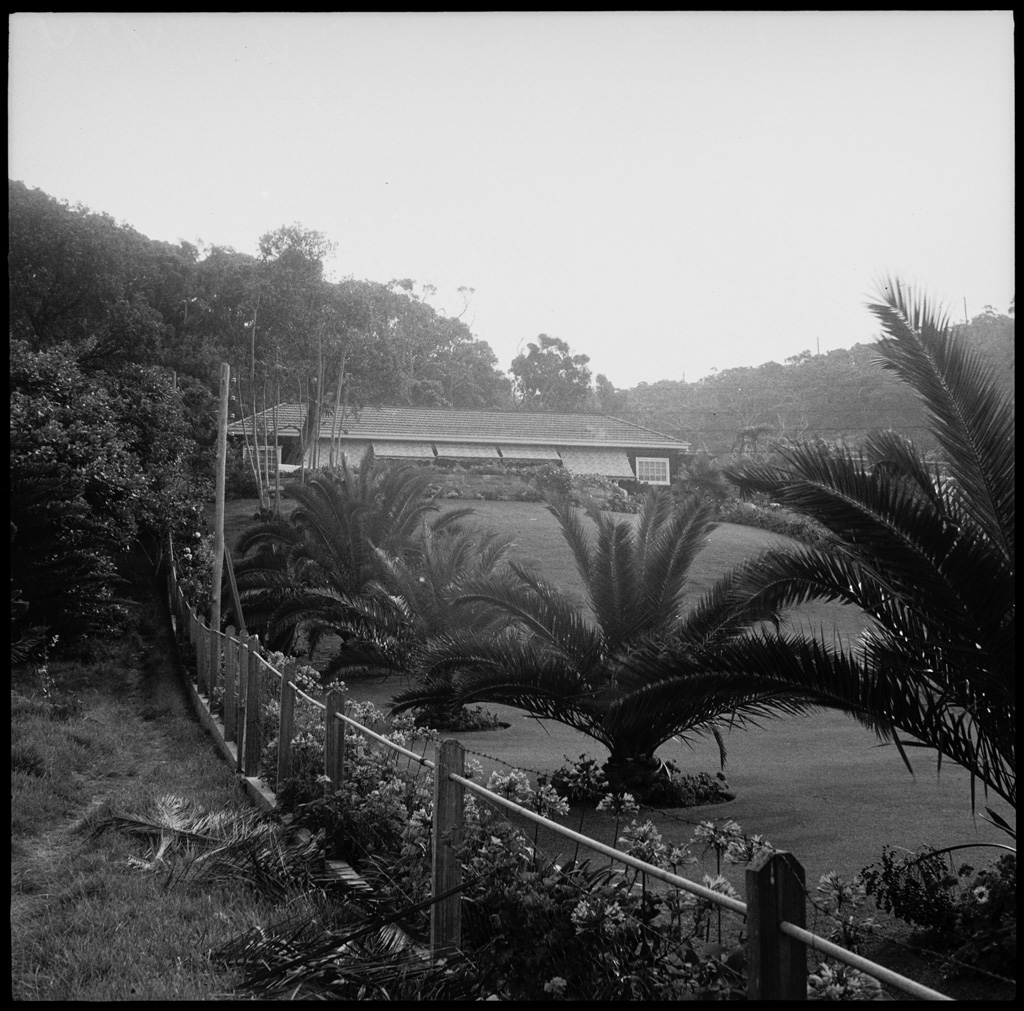
From Album Palm Beach, December 1 1937 and January 6 1938 / photographed by Ray Olson - these are Pix magazine photographs, and taken or published in 1937 and 1938, courtesy Mitchell Library, State Library of New South Wales and courtesy ACP Magazines Ltd.
There have also been numerous records referring to the Norfolk Pine trees on the beach frontage being a project provided by A J Hordern between 1914-15, prior to the Horderns actually purchasing land at Palm Beach.
The authors of the Governor Phillip Park Plan of Management research found that these had been planted between 1930 to 1935, either when he was infirm (or having a broken leg and recuperating at Kalua) or after he had passed away - in August 1932. They certainly are not present in photographs until the mid to late 1920's and early 1930s, and even by the mid-1930's are still quite small compared to their current height and girth:
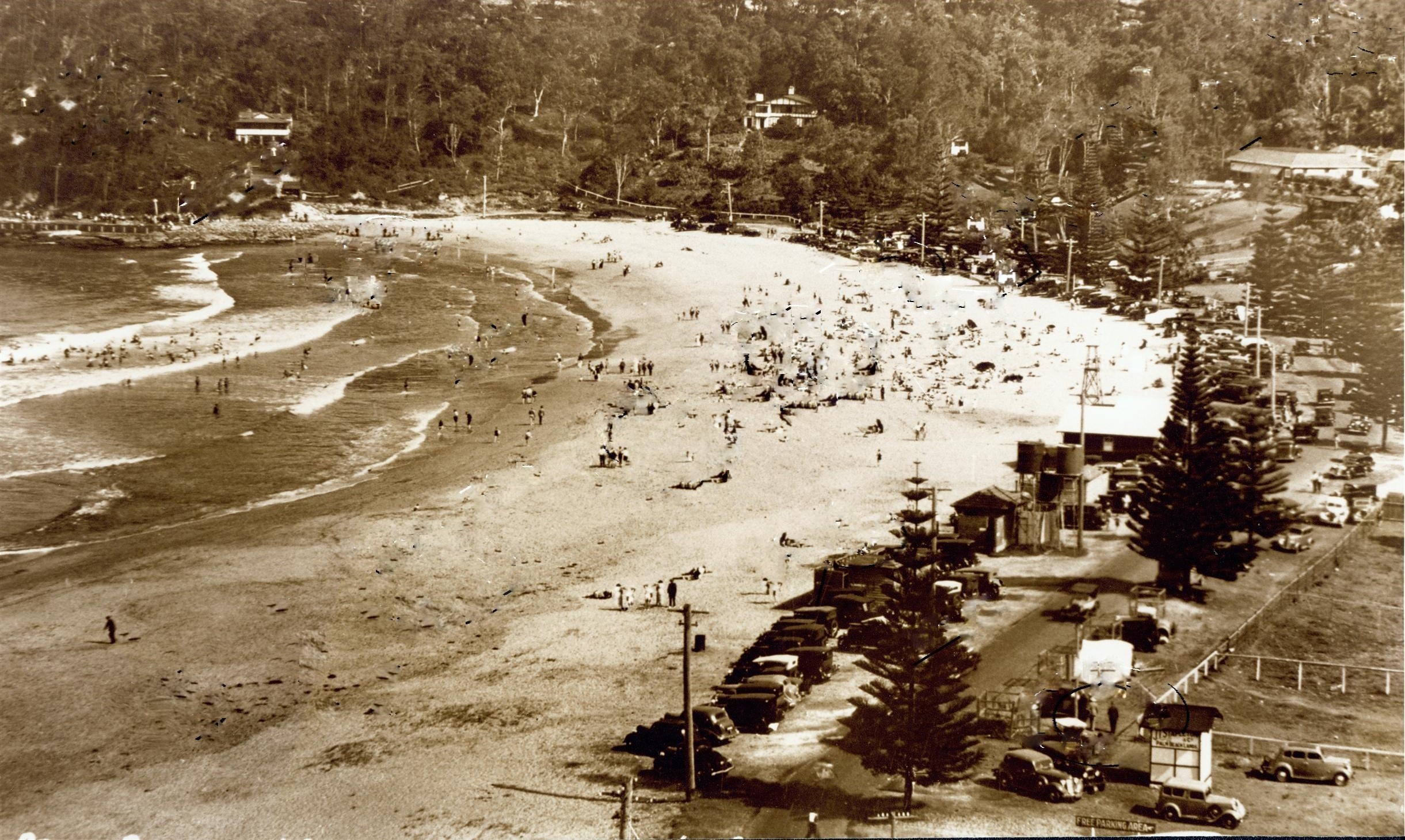
Palm Beach beachfront, circa 1935, changerooms and PBSLSC bunkhouse/clubhouse prior to the building of the 1936/1937 opened PB Pavilion. Kalua's roof footprint and front lawn can be seen to the upper right. Photo: PON library
However at the Meeting held on 15th August 1926 the Minutes record some credence to this:
A J Hordern 10.8.26. requesting permission to plant three Norfolk Island Pines on Ocean Road, in front of his place and six wattles on the Park parallel with his southern fence; Resolved - (Crs; Hitchcock Simpson)That he be granted permission.
Although Mr. Hordern's reason for doing so would still be about peace and privacy and a screening of his home, and this occurring prior to the Palm Beach SLSC 'shed' in the then Glenburnie park being transferred and rebuilt further along the beach, he certainly began something that spread.
A search of Warringah Shire Council records finds the council was also the initiator of planting Norfolk Pines along seascaped areas, although residents also applied for, and were granted, trees to plant along our beaches. A few more examples:
Minutes of Meeting of 19th September, 1927:
That arrangements for the planting of trees in Soldiers Avenue be left in the hands of Cr. Atkins and the Inspector. . . . . -'-_(Crs. Atkins, Greenwood)That Gardener Hirsch be sent down to Palm Beach to superintend the planting of trees on Governor Phillip Park. 6. Resolved (Crs. Campbell, Hope) a That Gardener Hirsch be appointed to attend to the gardens at the Council Chambers in addition to attending to the gardens on streets and reserves Resolved (Crs. Atkins, Parr) That 12 Norfolk Island Pines be planted in Birdwood Park
7th of August 1929:
Resolved - That an avenue of Norfolk Island pines be planted in Noble Street Mona Vale.
Monday June 20th 1932:
Mona Vale Progress Assoc. 10/6/32, (a) stating that the High schoo1 site selected by, the Education Department meets with the :approval of the-Association; (b) requesting that footpaths be defined in MonaVale, and that for a start, a to the path be formed from 'The. Bamboos' to Bassett Street, and from Mona Vale Junction for Cabbage Tree Road; (c) requesting that the Council supply 30 advanced Norfolk Pines for Mona Vale Beach, to . be planted and cared for by the citizens: (d). requesting that the spoil from the drainage scheme at Mona Vale be utilised for improving and enlarging the parking. area at Mona Vale Beach, and for promoting the growth of the trees to be planted; (c) requesting that the 'Tea Pot Inn' on Newport Beach resumed area be made available for the purposes of beach improvements at Mona Vale, the citizens to remove the structure;. (f)' suggesting that the electric lighting of the pool and sheds On Mona Vale Beach be now proceeded with; (g) drawing attention to the condition of Noble Street; (h) suggesting, for purposes of economy, that the street lights be turned off three nights before, and three nights after full moon; and (i) requesting that an investigation be made into the sanitary service
The 30 trees were supplied - the 'spoil' from the drainage scheme would have come from 'The Black Swamp' area. See: The Black Swamp Camping Reserve Becomes Kitchener Park, Beeby Park & Mona Vale Golf Course - Pittwater Creeks series opener
At the Meeting held 7th of November 1932:
Makim Memorial Palms:. The recommendation that palms be removed from the Manly Garden Estate for the Makim Memorial and Jacka Park was approved. The recommendation that 12 Norfolk Island Pines and 12 DeIophostemons be purchased for replacement purposes was adopted.-:
In the Minutes of the Meeting held Tuesday 9th of July 1935:
By Cr. Rous: That additional Norfolk Inland Pines Tree- be planted on Deewhy Beach Reserves and reservation in planting accordance with a plan to be submitted to Council; and (b) that the treeguards at present in use on Deewhy Beach cud the eastern end of Oaks Avenue be removed and used for the protection of such trees, Cr. Nicholas seconded. Carried.
November 19th, 1936:
Re Planting Norfolk Island Pines on parking area on Harbord Tree- Beach Reserve: Resolved: That twenty trees be planted, and planting the necessary soil be supplied to the Gardener for that purpose. (Crs. Campbell, Ross) Re application by W. Hooper of Barrenjoey Road, Palm Beach, License for a barber's shop license: Resolved, - That the license be granted. (Crs. Sheppard, Hewitt)
This continued along our beachfronts, including those planted at Avalon Beach, which were initially to pay tribute to those who had served and lost their lives in World war Two. See; Avalon Beach Norfolk Pines: To Honour Those Who Served – Anzac Day 2023 History Precursors
It seems A J Hordern's original plantings idea spread and still provide shade for many people today. Another reason we still have a park at Palm Beach named to remember his contributions to Palm Beach.
Hordern Park in January 2024
Hordern Park + creek runoff onto the beach: May 29, 2023
Kalua Changes hands - the later years
Caroline passed away in 1938, leaving her estate to Bruce, her sole surviving son. Roy had died in a motorcycle accident, fortunately after his dad passed away, but not before his mum:
FATAL CRASH ON MOUNTS BAY ROAD MOTOR CYCLIST KILLED
A fatal accident occurred in Mount's Bay-road this afternoon when Alfred Roy Hordern (about 43), of 1004 Hay-street, a motor cyclist, collided with a car. The deceased was riding his motor cycle and sidecar along Mount's Bay-road, and when rounding the bend near the Narrows he collided with a car driven by Billy Edwards, well known in musical circles. Hordern was thrown violently to the ground, and it was at once seen that he was badly injured in the head. He was taken to the Perth Hospital, where on arrival it was found that he was dead. Later the body was identified. It is stated that Hordern has a brother Bruce Hordern of the Graham Paige Motor Co., Sydney. His father died some months ago and his mother is at present touring in Japan. Hordern was employed as a bird salesman by Barrow Lynton and Co. FATAL CRASH (1935, December 21). Mirror (Perth, WA : 1921 - 1956), p. 6. Retrieved from http://nla.gov.au/nla.news-article75496621
HORDERN.—September 9, 1938, at her residence, The Highlands, Wahroonga, Caroline Hordern. Family Notices (1938, September 10). The Sydney Morning Herald (NSW : 1842 - 1954), p. 10. Retrieved from http://nla.gov.au/nla.news-article17517688
HORDERN.-The Funeral of the late Mrs. CAROLINE HORDERN will leave her late residence, The Highlands, Wahroonga. THIS SATURDAY, at 1.30 p.m., for the Presbyterian Cemetery, Field of Mars. WOOD COFFILL LIMITED. Family Notices (1938, September 10). The Sydney Morning Herald (NSW : 1842 - 1954), p. 9. Retrieved from http://nla.gov.au/nla.news-article17517670
MRS. C. HORDERN'S WILL.
Mrs. Caroline Hordern formerly of Wahroonga, who died on September 9, a widow left the whole of her estate real and personal to her son, Mr. Bruce Alexander Hordern and appointed him sole executor of her will. Mrs Hordern's estate was sworn for probate at £30,750. MRS. C. HORDERN'S WILL. (1939, February 10). The Sydney Morning Herald (NSW : 1842 - 1954), p. 6. Retrieved from http://nla.gov.au/nla.news-article17547838
Bruce had divorced and remarried:
HORDERN V HORDERN
Winifred Frances Hordern (formerly Perryman) prayed for a decree for restitution of conjugal lights directed to Bruce Alexander Hordern. The parties were married at a registry office in London in March 1921. A decree was granted as prayed Mr Maunsell Turner (instiucted by Messrs J W Maund and Kelynack) appeared for the petitioner. IN DIVORCE. (1930, December 20). The Sydney Morning Herald (NSW : 1842 - 1954), p. 12. Retrieved from http://nla.gov.au/nla.news-article16740167
WINIFRED FRANCES HORDERN (formerly Perryman) was yesterday granted a decree for dissolution of her marriage with Bruce Alexander Hordern, on the ground of his failure to comply with an order for restitution of conjugal rights made last year. Glances At Courts (1931, October 23). The Daily Telegraph (Sydney, NSW : 1931 - 1954), p. 8. Retrieved from http://nla.gov.au/nla.news-article246559447
Winifred Frances Hordern (formerly Perryman) v. Bruce Alexander Hordern. Marriage, March, 1921, in London, Registrar's office. Issue: desertion. Decree nisi. IN DIVORCE. (1931, October 23). The Sydney Morning Herald (NSW : 1842 - 1954), p. 5. Retrieved from http://nla.gov.au/nla.news-article16815731
Winifred Frances Hordern v Bruce Alexander Hordern, IN DIVORCE. (1932, May 11). The Sydney Morning Herald (NSW : 1842 - 1954), p. 8. Retrieved from http://nla.gov.au/nla.news-article16862432
TAILORED GOWN AND FURS
Quietly Married
SO well had the secret of their wedding plans been kept, that the announcement of the marriage of Miss Ailsa Scholer and Mr. Bruce Hordern, which took place yesterday afternoon, came as a surprise even to their closest friends. After the ceremony members of both families were entertained at a reception at the home of the bride's mother, Mrs. A. Campbell, of Alta Vista, Cremorne. '
The bride, who is the only daughter of Mrs. Campbell and the late Mr. A. M. Scholer, looked charming in a frock of dusty pink wool sheer and hat to match, with silver fox furs and a spray of orchids. She was given away by Mr. A. Campbell. Mr. Mervyn Scholer. brother of the bride, attended the bridegroom, who is the younger son of the late Mr. A. J. Hordern and Mrs. Hordern, of The Highlands, Wahroonga.
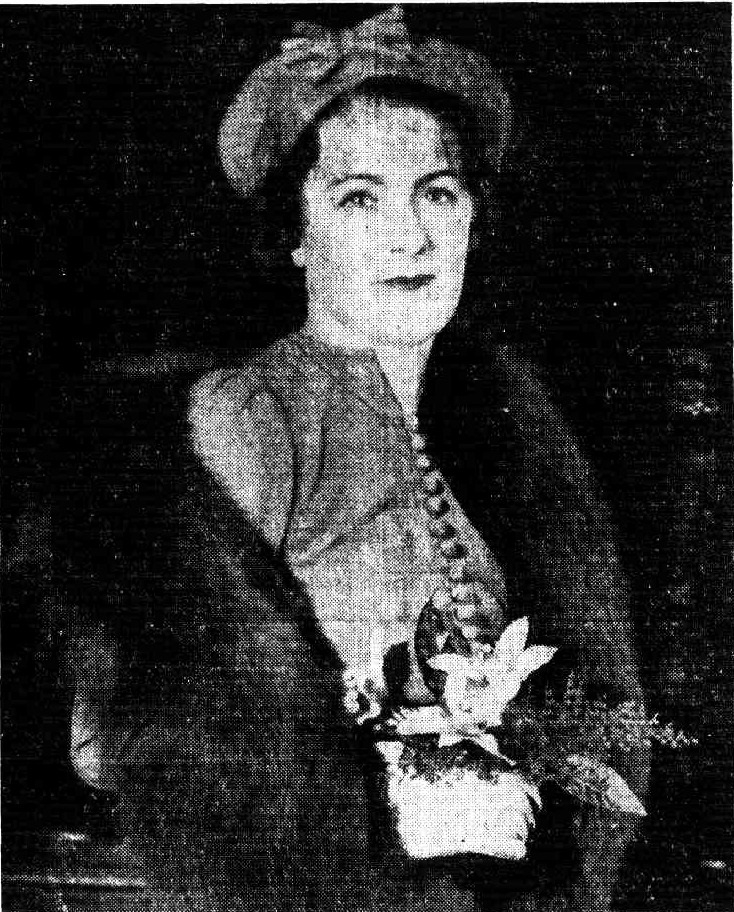
MRS. BRUCE HORDERN, photographed just before her wedding, which was quietly celebrated yesterday afternoon. She was Miss Ailsa Scholer. — Dayne. TAILORED GOWN AND FURS (1937, July 23). The Daily Telegraph (Sydney, NSW : 1931 - 1954), p. 11. Retrieved from http://nla.gov.au/nla.news-article247213167
SCHOLER—TALBOT
The Chapel of the Church of England Grammar School, North Sydney, was chosen for the wedding of Miss Joan Elizabeth Talbot and Mr. Mervyn Garnet Scholer, only son of the late Mr. O. M. Scholer and of Mrs. A. Campbell, of Cremorne. The bridegroom was a former pupil of the school.
After the ceremony, performed by the school chaplain (the Rev. Nigel Beckett Backhouse), a reception was held at "The Highlands," Wahroonga, the home of the bridegroom's sister, Mrs. Bruce Hordern.
The bride, who was given away by Dr. Brooke Kelly, is the only daughter of the late W. P. Talbot and of Mrs. C. G. Talbot, of North Sydney. Her frock of parchment brocaded satin was made on tailored lines, and featured a cut-in circular train. She added a veil of cut tulle, held by a coronet of orange blossoms, and she carried a bouquet of stephanotis and Lily of the Valley.
Mrs. Boyce Pizzey was matron of honour, and Misses Beryl Ingham, Carmen Hordern, and Nancy Bundock, bridesmaids. All wore draped frocks of eau de nil organza, made with full skirts, and appliqued with true-lovers' knots. They added haloes of mauve flowers, and carried mauve gladioli and irises.
Mr. Jim Pratt was best man, and Messrs. Ken Hudson, Boyce Pizzey, and Neville Malley groomsmen. The bride's mother was a daughter of the late Duncan McIntyre, of Wardell, and a sister of Mrs W. Rudgley, also of Wardell. Family Notices (1939, March 28). Northern Star (Lismore, NSW : 1876 - 1954), p. 5. Retrieved from http://nla.gov.au/nla.news-article95487782
Bruce Alexander Hordern passed away in 1945, still in his 40's:
HORDERN.—June 24, 1945, Bruce Alexander, most dearly loved husband of Ailsa Hordern, of Kalua, Palm Beach, and loving father of Carmen.
HORDERN.—June 24, 1945, Bruce Alexander Hordern, dearly loved son-in-law of Mrs. A. Campbell, of Cremorne and brother-in-law of Mervyn Schober.
HORDERN.—June 24, 1945, Bruce Alexander Hordern, much loved nephew of Miss Flora C. Smith, of Cremorne. Family Notices (1945, June 25). The Sydney Morning Herald (NSW : 1842 - 1954), p. 10. Retrieved from http://nla.gov.au/nla.news-article27937962
RE will of BRUCE ALEXANDER HORDERN, late of Kalua, Palm Beach, gentleman, deceased.—Probate granted by Supreme Court of New South Wales on 13th December, 1945. —Pursuant to the Wills, Probate and Administration Act, Act, 1898-1940 (Testator's Family Maintenance and Guardianship of Infants Act, 1916-1938, and Trustee Act, 1925-1940), Perpetual Trustee Company Limited, the executor of the will of the said Bruce Alexander Hordern, who died on 24th June, 1945, hereby gives notice that creditors and others having any claim against or to the estate of the said deceased are required to send particulars of their claims to the said executor at 33-39 Hunter-street Sydney, on or before the 13th March next at the expiration of which time the said executor will distribute the assets of the said deceased to the persons entitled, having regard only to the claims of which it then has notice.—Dated 28th December, 1945. For Perpetual Trustee Company Limited, H. V. DOUGLASS, Managing Director. Priddle, Gosling, Dalrymple & Sillar, Proctors. 1419—£1. RE will of BRUCE ALEXANDER HORDERN, late of (1946, January 11). Government Gazette of the State of New South Wales (Sydney, NSW : 1901 - 2001), p. 86. Retrieved from http://nla.gov.au/nla.news-article224760517
2621b. STRIPED MARLIN CAUGHT AT PALM BEACH
An amateur fisherman, Mr. Anthony Hordern, caught a striped marlin off Palm Beach yesterday which weighed 2621b. and measured 10ft. 7in. It is the biggest marlin ever caught at Palm Beach. Mr. A. Goddard, marine manager at Palm Beach for the Port Jackson Company, said last night:
"It was the most beautiful marlin I have seen. Mr. Hordern was off Palm- Beach in his boat Nightfall when he hooked the fish. Mr. E. G. Theodore, fishing from the same boat, held the previous record for a marlin caught at Palm Beach.
Last year he landed one that weighed 2521b. "The marlin landed today put up such a tremendous fight that it took Mr. Hordern an hour to bring it alongside. "He hooked it about 3 p.m., and had it alongside at 4 p.m. "His boatman was Mr. Ron Hammil, who took the fish to Sydney to sell. Marlin a splendid fish for the table." 262lb. STRIPED MARLIN CAUGHT AT PALM BEACH (1946, February 25). The Daily Telegraph (Sydney, NSW : 1931 - 1954), p. 5. Retrieved December 7, 2023, from http://nla.gov.au/nla.news-article248474178
Kalua continued to be rented out during this time:
MILORD'S RED SHORTS.
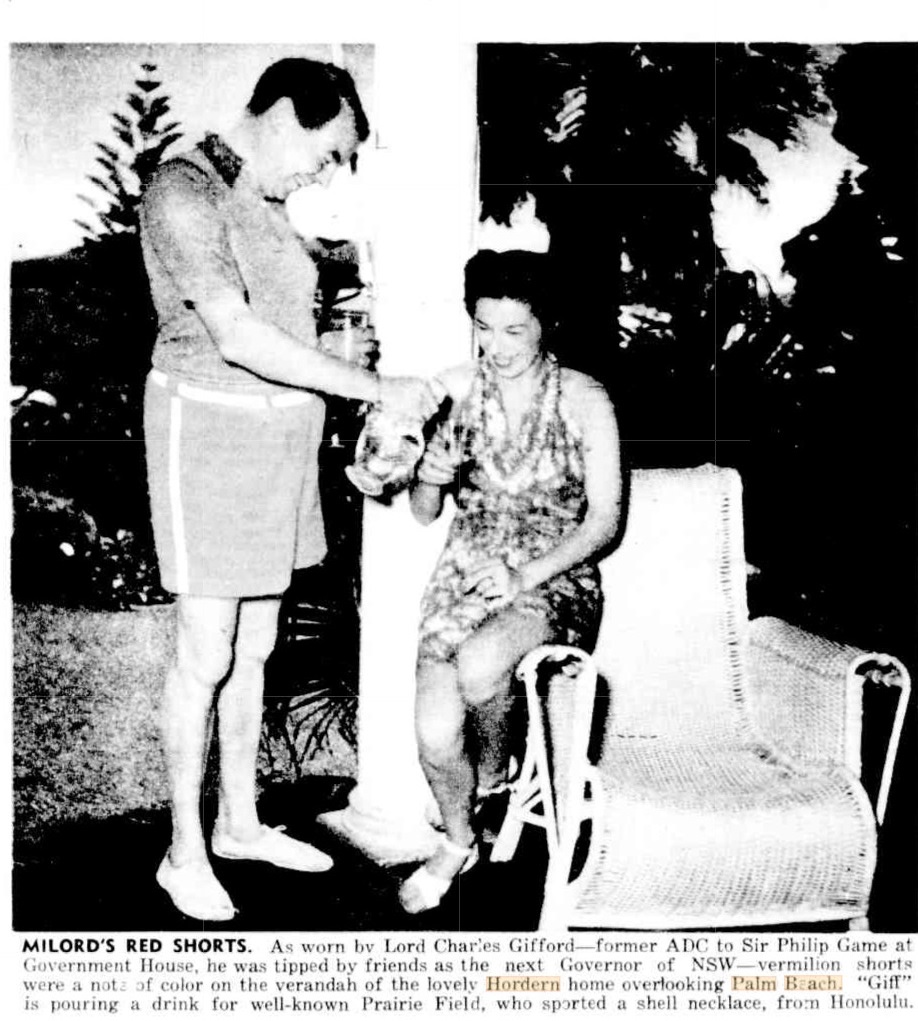
As worn by Lord Charles Gifford — former ADC to Sir Philip Game at Government House, he was tipped by friends as the next Governor of NSW — vermilion shorts were a note of color on the verandah of the lovely Hordern home overlooking Palm Beach. "Giff" is pouring a drink for well-known Prairie Field, who sported a shell necklace, from Honolulu. No title (1946, February 17). The Sun (Sydney, NSW : 1910 - 1954), p. 9 (SUPPLEMENT TO THE COLOR MAGAZINE SUPPLEMENT). Retrieved from http://nla.gov.au/nla.news-article228798365
so far this week has been at Palm Beach. Partyism was rife and ail absorbed the usual P.B. informality: — plus as much of everything else as one could get. Of course the biggest and brightest ''do" was on New, Year s Eve when 700 revellers invaded the Pacific Club.
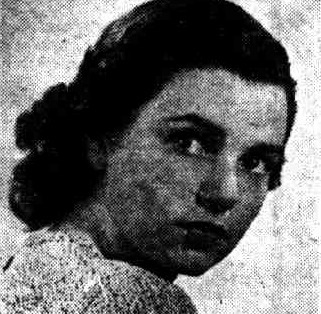
Among, those wearing exotic clothes was lovely Lucy Lowry (right). She is hostess for brother George Falkiner at the Horderns' fascinating home. SPOTLIGHT ON Society (1946, January 3). Daily Mirror (Sydney, NSW : 1941 - 1955), p. 16 (Late Final Extra 2). Retrieved from http://nla.gov.au/nla.news-article272641065
After Bruce passed away his widow Ailsa and daughter Carmen were the owners of the estate. The Highlands was sold in 1948, the same year Carmen married:
CARMEN HORDERN, only daughter of the late Mr. Bruce Hordern, of Kalua, Palm Beach, was married on Friday at St. Philip's Church to Douglas Perkins, of Killara. Carmen's lovely wedding gown had a bouffant skirt of white tulle with a lace top. Her long tulle veil was held by a head dress of tiger lilies.
Guests drank the health of the bride and bridegroom at the Royal Sydney Golf Club. Mrs. Peter Della-Porta came from Melbourne to be matron of honor and Jane and Sarah Crawford were flower-girls. Arthur Hordern gave the bride away, and George Crawford was best man. Sandra's Weekend Diary (1948, February 22). The Daily Telegraph (Sydney, NSW : 1931 - 1954), p. 27. Retrieved from http://nla.gov.au/nla.news-article248284032
PERKINS (Hordern).—December 31, at St. Luke's Hospital, to Carmen and Douglas-a daughter (Janice Patricia). Family Notices (1950, January 11). The Sydney Morning Herald (NSW : 1842 - 1954), p. 28. Retrieved from http://nla.gov.au/nla.news-article18142097
PERKINS (Hordern).-At St. Luke's Hospital, to Carmen, wife of Douglas Perkins, a son. Family Notices (1954, October 7). The Sydney Morning Herald (NSW : 1842 - 1954), p. 24. Retrieved from http://nla.gov.au/nla.news-article18460334
Ailsa kept Kalua intact until 1955 when Lot 86 was subdivided and sold. Vol/Fol 2754-135 Lot 86 shows parts B and D of these were retained by the family:

.jpg?timestamp=1706750198559)
.jpg?timestamp=1706749338654)
.jpg?timestamp=1706749508277)
.jpg?timestamp=1706749573791)
.jpg?timestamp=1706749610464)
The rest of the land and home was held by the Hordern family until sold to businessman Ian Joye family for $330,000 in 1978 - a bit of a bargain for those who recall listings for HUGE blocks and basic homes in Avalon Beach being advertised for around $80 thousand during the late 1970's and early 1980's.
Mat Goddard (February 11, 2024):
My Father (and later on myself and he) worked on Kalua for many years when it was owned by Ian Joye, he put the top storey on it and did additions and renovations to pretty much every part of it, including building a scaled replica of the house as a cubby house for the kids. I spent many hours working there.
Malcolm Lambe (February 11, 2024): Kalua memories - when I was caretaker in 1979 Ian Joye had recently bought it - year before I think - after selling his 10% of Winthrop Investments to Alan Bond for $30 Mill.
One of the first things he did was to install a small pool on the northern side of the house - probably in what was the "bushhouse".
They had to dig out a stand of Raphis Palms to accommodate it. The gardener asked Judy Joye if he could have some but she demurred. Said she wanted all of them and could he stack them up the end of the property under Florida Road.
He told her they didn't like direct sunlight and she would have to shade them. She did nothing with them so the whole lot eventually died. They would have been worth thousands. All were a couple of metres tall. These are very slow-growing palms.
Inside the house was a Hawaiian-style indoor garden - "lanai" - under a glass roof - attached to the dining room. One of my tasks was to regularly mist it.
A lanai or lānai is a type of roofed, open-sided veranda, patio, or porch originating in Hawaii. Many homes, apartment buildings, hotels and restaurants in Hawaii are built with one or more lānais. In Hawaii, the term's use has grown colloquially to encompass any sort of outdoor living area connected to or adjacent to an interior space—whether roofed or not—including apartment and hotel balconies. It may be screened in or not.
The Joye family held onto the property until placing it on the market in 2011. By January 2012 they were having a farewell party in the home. This time it sold to the Laurie Sutton family, recorded as changing hands on 28 April 2012. This time the price reached was reportedly $23 million.
The Real Estate Listings described the the five-bedroom, six-bathroom house, three-bedroom guesthouse along with studio cabana, pool and tennis court on a 5,500-square-metre block overlooking Cabbage Tree Boat Harbour (10 bedrooms, 8 bathrooms and room for 4 cars all up) as:
Built c1920, Kalua was one of the first properties constructed in Palm Beach, guaranteeing its historical significance. The main residence was built and held for some 60 years by the distinguished Hordern family and was purchased by current owners the Joye family in 1978. Folklore has it that the Hordern family sent their architect by sea to Oahu, Hawaii, to copy "stick by stick and stone by stone" the impressive Dillingham plantation residence. Hence it was named Kalua, which means 'double' in Hawaiian. At the time of construction there were no roads into Palm Beach so all materials, including soil, had to be barged in from Newport. The original sandstone steps still take you up from the beach to the house.
Reminiscent of a bygone era and retaining all of its classic appeal, the elegantly relaxed 1920s plantation-style home is a sprawling, flexible family residence framed by wide entertaining verandas. It encompasses six generous bedrooms, five with ensuites, including privately accessible helpers' quarters accommodating 1-2 staff. The entire upper level is devoted to the master retreat, encompassing his and hers dressing rooms, a marble ensuite, an entertainment cabinet, a private outdoor shower terrace and a second large terrace with premier views. Multiple entertaining spaces include a grand lounge room, a generous atrium-style dining room, a family room and a charming gas kitchen featuring solid timber cabinetry, Carrara marble bench tops, commercial ovens and sitting area with a gas fireplace. The gracious residence is enhanced by touches such as jarrah, tallowood and kauri floors and a wood-burning fireplace in the lounge room.
A second completely private residence has been designed specifically to accommodate an on-site caretaker's family. It is also perfect for guests or extended family members. Constructed from Australian hardwoods, the two-storey building has private access through the adjacent parkland down to the beach. It contains three bedrooms, two bathrooms and a black granite kitchen. Enhanced by cathedral glass ceilings, park views and wide recycled blackbutt floorboards, its living space is warmed by a gas fire. To facilitate maintenance work, there is a large dedicated workshop, a second utility room and a washroom for tradespeople.
A self-contained beach cabana is located down by the property's beachfront entrance, enjoying level access across to the water. Set up as a bunkhouse to accommodate multiple beds, it provides a wonderful teenager's retreat or recreation area, complete with its own kitchen and bathroom. New planning laws make it highly unlikely that new properties would be able to build anything of this nature in a position so close to the beachfront, making it a prized asset of the estate.
Kalua's meandering, idyllic grounds are nothing short of breath-taking. They provide a secluded oasis in which you can entertain your guests or relax in total privacy, complete with sprawling front and rear lawns, towering trees and a variety of alfresco living spaces. Set adjacent to the house, a gas-heated pool is framed by a large timber deck soaking up the northerly sun. Original sandstone steps take you down to the north-south tennis court - the only championship sized court in the Palm Beach area. The property is dotted with a multitude of significant flora, including angophoras, cabbage tree palms and Washington palms. Additional amenities include a Jacuzzi, a children's playhouse, a swing set, an outdoor beach shower and four-car covered security parking with plenty of room for additional vehicles.
Photos dated 2011: courtesy www.realestate.com.au
Kalua was built as an Hawaiian plantation-style home. These residences of the period are known for their spacious lanais and steep-pitched, double-hipped roofs with extended eaves.
The style known as Hawaiian plantation architecture:
- Features low profile wood frames, vertical plank siding and large porticos.
- Roofs were the most distinguishable parts of Hawaiian plantation structures as they were wide-hipped or bell cast and had eaves that were deep bracketed.
The style gets its name from the sugarcane and pineapple plantations which employed the design for labourer homesteads.
The Suttons had undertaken renovations and extensions - approved by Pittwater Council in June 2013.
Their drawings show the Joyes had also changed Kalua during their decades as owners, most notably adding in a parents retreat upstairs in the roof cavity, with windows facing towards the ocean discreetly peeping out from the roofline and tiles, which have also undergone a change in colour.
Tragically Mr. Sutton lost his battle with brain cancer in November 2023.
Even with these changes 'Kalua' the Hordern built home at Palm Beach, has been a Pittwater Summer House for well over a century now, while the Park next door, named for the gentle private man who did so much to preserve and improve the early facilities at Palm Beach, marks a contribution worth remembering and protecting for future generations.
Kalua, Palm Beach, Ocean Road front view, January 2024
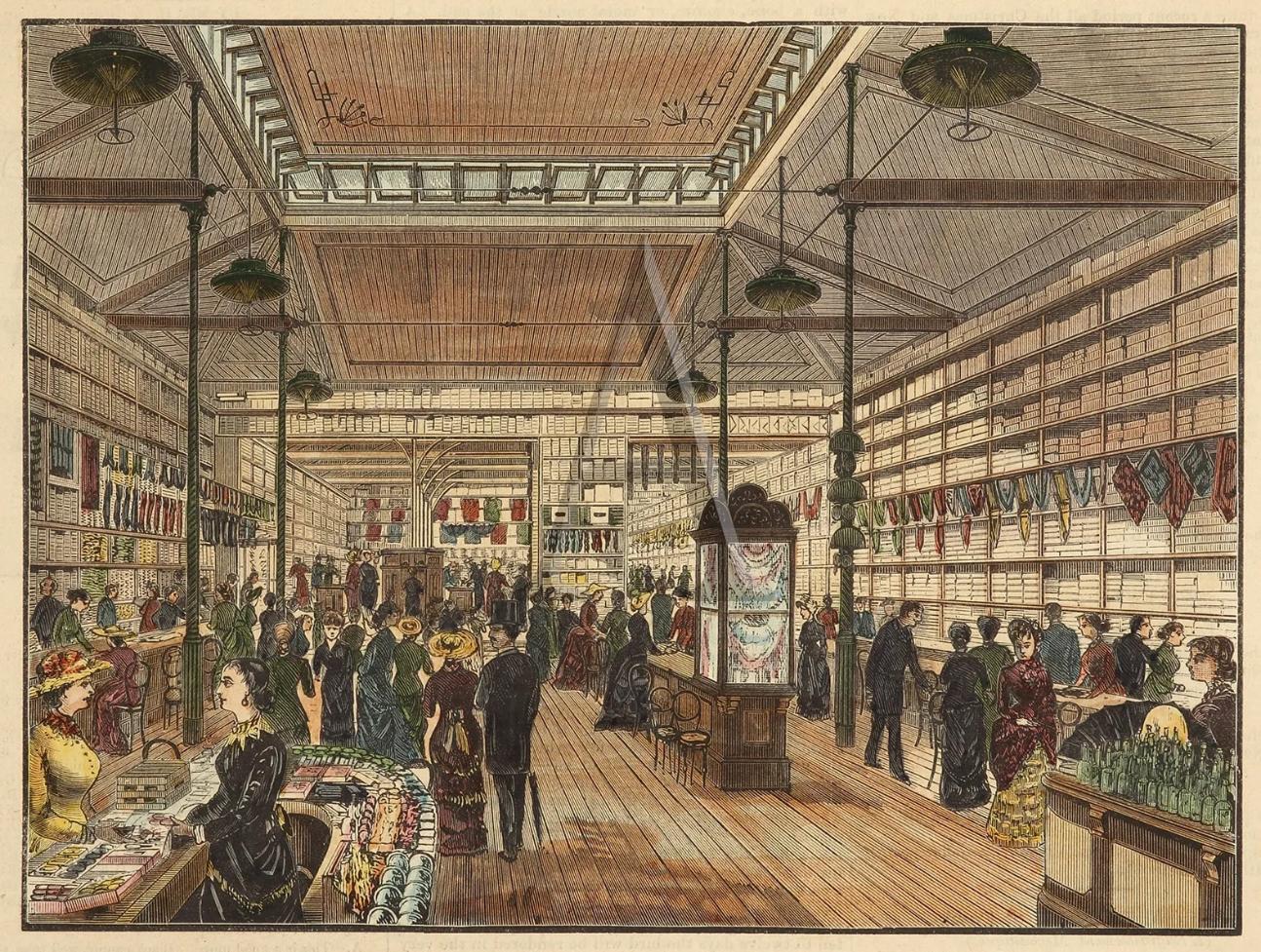
References - Extras

|
Kalua Palm Beach Hordern home research notes 2023-2024.pdf Size : 1271.542 Kb Type : pdf |
- TROVE - National Library of Australia
- The First Weekenders On The Palm Beach Beachfront + A Look Into Palm Beach SLSC Clubhouses In The Club's 101st Season
- The Rise Of The Surfboard As Life Saving Rescue Equipment: Some History
- Palm Beach Jetty - Gow's Wharf
- Palm Beach Surf Life Saving Club Part I - The Sheds
- Palm Beach Pavilion To Be Renamed The Lieutenant Colonel Douglas Marks DSO, MC Pavilion
- Palm Beach Pavilion Renaming Dedication Honours Lieutenant Colonel Douglas Marks DSO, MC
- Pittwater Roads II: Where The Streets Have Your Name - Palm Beach
- Wilshire Park Palm Beach: Some History + Photos From May 2022
- Art Deco Inspirations In Palm Beach: The Palladium Dance-Hall, Cafe And Shop - The Surf Pavilion - The Beacon Store
- Pittwater Reserves: The Green Ways Hordern And Wilshire Parks To McKay Reserve – From Beach To Estuary
- Photographers Of Early Pittwater: David 'Rex' Hazlewood
- Avalon Beach Norfolk Pines: To Honour Those Who Served – Anzac Day 2023 History Precursors
- Palm Beach Golf Course: Some History
- Early Pittwater Surfers: Alrema Becke, Queen Of Palm Beach
Duke Kahanamoku, the brilliant Hawaiian swimmer, is to visit Australia next season. The Australian Swimming Union has contributed a sum towards his expenses. He will be accompanied by a manager and swimming companion. SUNDRY SPORTS. (1914, April 23). The Australian Worker (Sydney, NSW : 1913 - 1950), p. 9. Retrieved from http://nla.gov.au/nla.news-article145941607
Barrenjoey Land Company closes and grants approval for further land sales to:
Alfred James Hordern - 'retires' after this:
NOTICE is hereby given that the partnership existing between us, the undersigned, Edward Carr Hordern and Alfred James Hordern, trading as Hordern Brothers, Pitt-street, Sydney, has been dissolved by mutual consent. Arrangements have been made with Hordern Brothers Limited, who have taken over the business, which will be carried on at Nos. 203 to 211 Pitt-street, Sydney, to pay all liabilities of and called all debts owing; to the old firm.
Dated this sixth day of June, 1922.
E. CARR HORDERN.
Witness to the signature of Edward Carr Hordern,—
D. W. Roxburgh, Solicitor, Sydney.
ALFRED JAMES HORDERN.
Witness to the signature of Alfred James Hordern,—
A. M. Hemsley, Solicitor, Sydney.
NOTICE is hereby given that the partnership existing between us, the undersigned, Edward Carr Hordern (1922, June 9). Government Gazette of the State of New South Wales (Sydney, NSW : 1901 - 2001), p. 3304. Retrieved from http://nla.gov.au/nla.news-article225142429
NEW COMPANIES
HORDERN BROTHERS, LTD.
With authorised capital of £400,000 in shares of £1 each, Hordern Brothers, Limited, has been registered in New South Wales. The newly-created organisation Intends to carry on business as drapers and furnishing and general warehousemen in all its branches. The first board of directors is to comprise E. C. Hordern, E. D. Hordern, M. B. Hordern, C. S. Hordern, and F. J. Smith. NEW COMPANIES (1922, June 7). The Daily Telegraph (Sydney, NSW : 1883 - 1930), p. 9. Retrieved from http://nla.gov.au/nla.news-article245741320
COUNTRY EXCHANGES
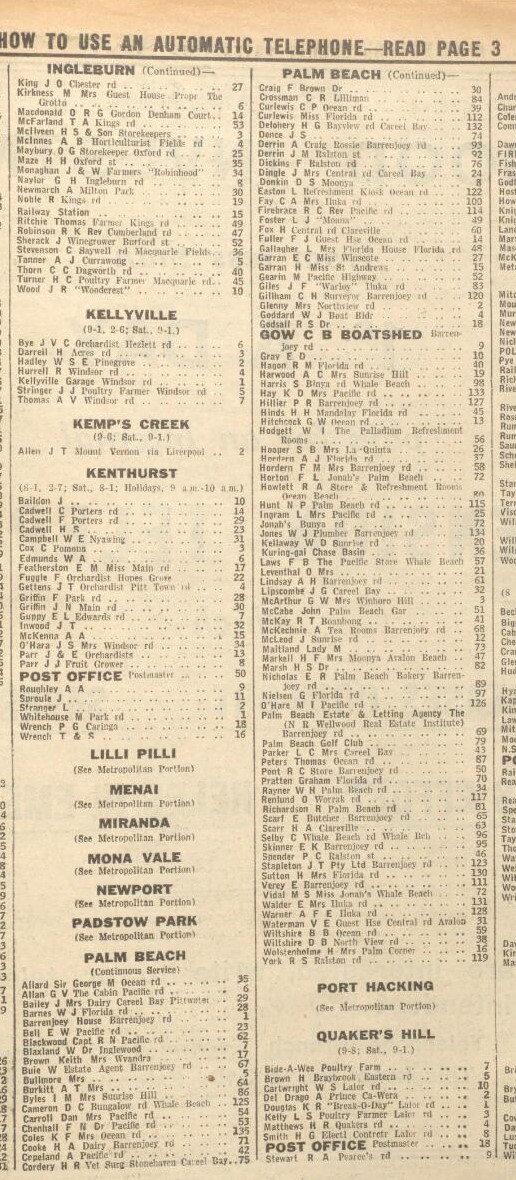
Mona Vale subscribers requiring (contact) with Palm Beach should dial “XW 99.” Other Metropolitan subscribers should call “E 1076." Telecom Australia & Telstra Corporation. (November 1938). COUNTRY EXCHANGES, Sydney telephone directory Retrieved from http://nla.gov.au/nla.obj-1051062140
Note two Horderns are listed at Palm Beach - A J Hordern at Florida road, which indicates the back driveway was main access point for family - and phone number '37'.
A Mrs F M Hordern, Barrenjoey Road (Pittwater side) with phone number '58'.
Carl Gow number '9' for the Boatshed, William Goddard '4', Mrs. Glenny (Northview road) no '2', George 'Scotty' Allan at The Cabin, number '6' and Barrenjoey House now has number '1', which had commenced as the boarding house number back in early 1920's. Worth noting that both the Vidals (Jonahs) and the Horton family are listed for Jonah's during this year as '72', indicating the owners/builders were also present when Jonahs was run by Horton family.
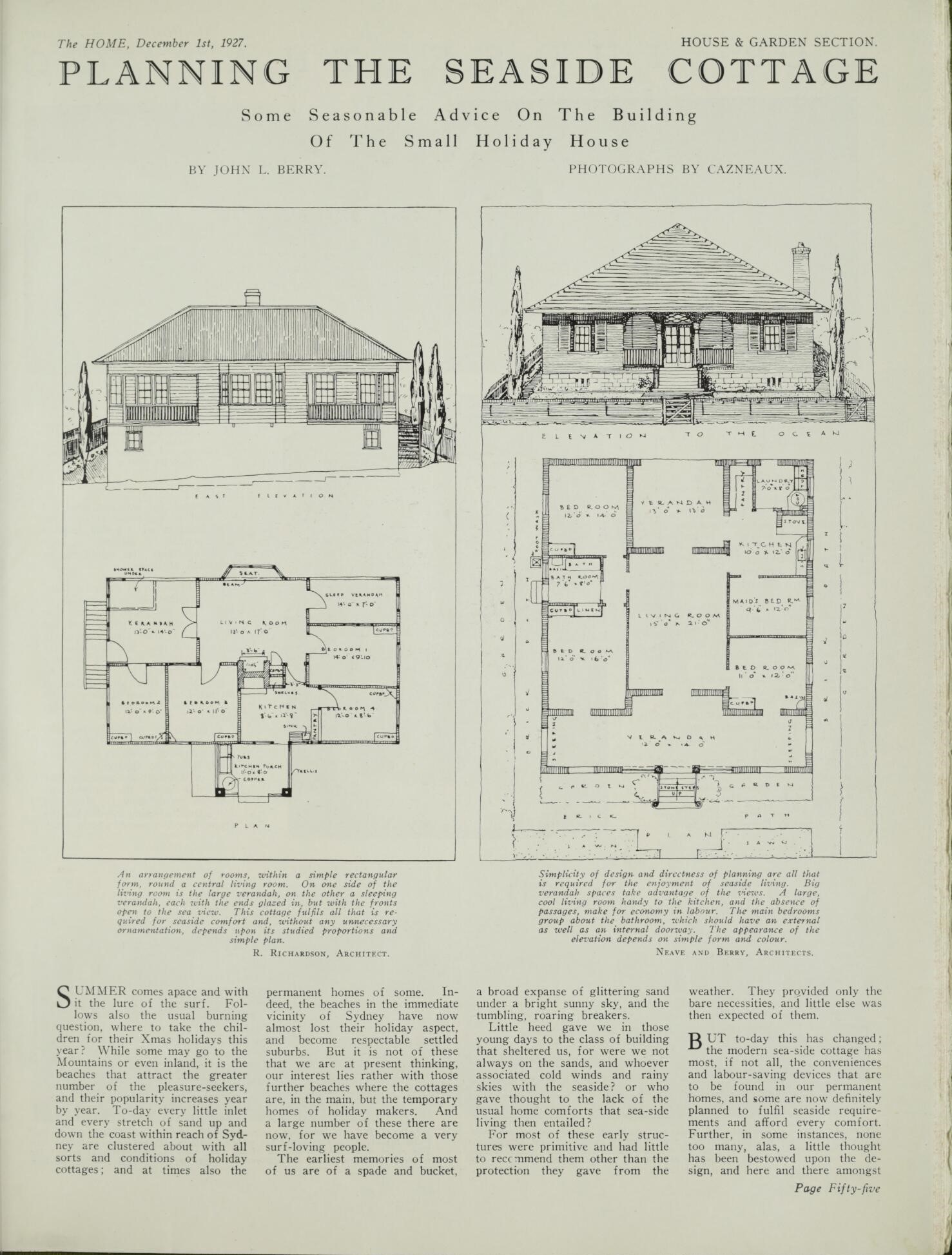
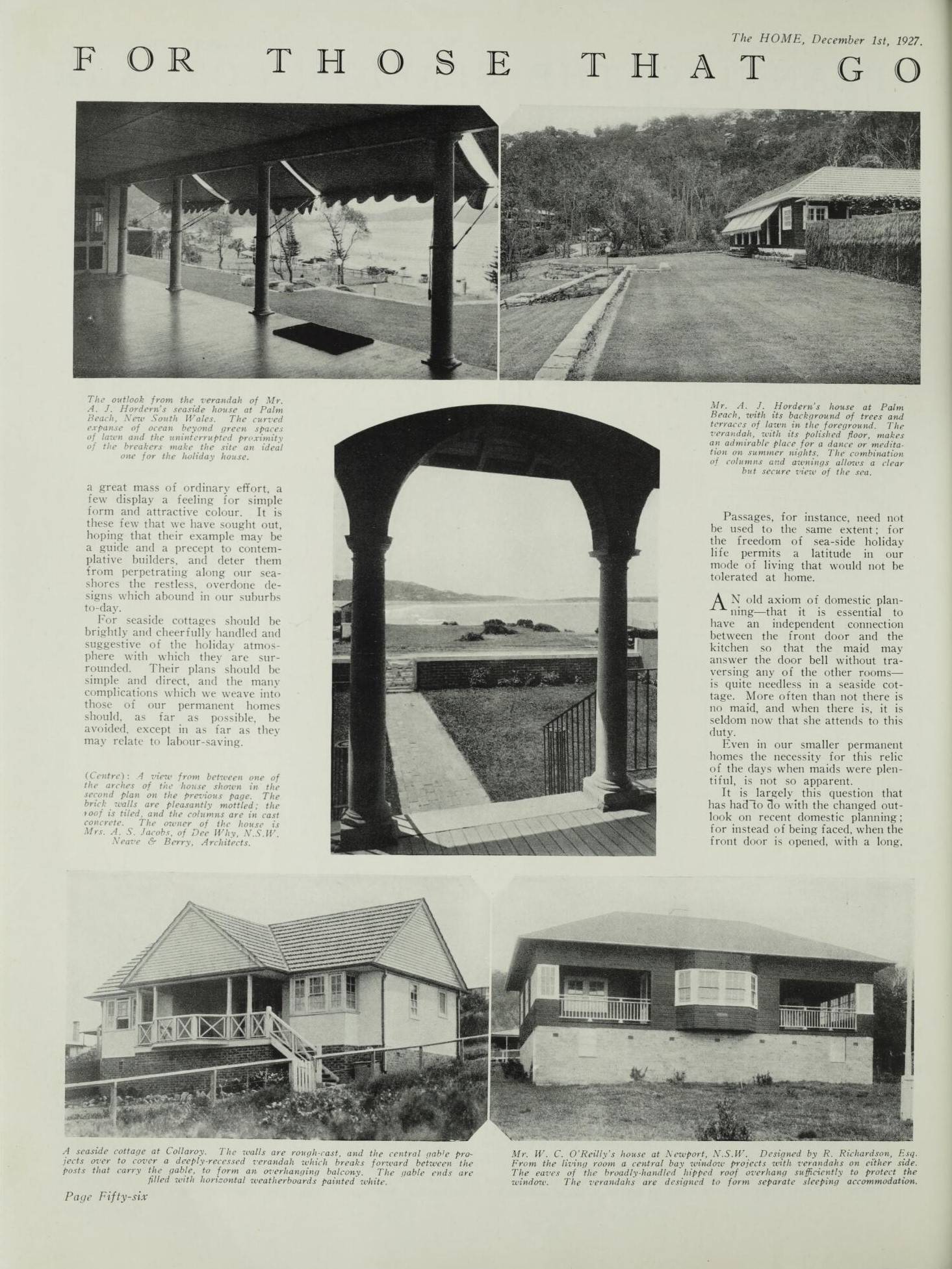
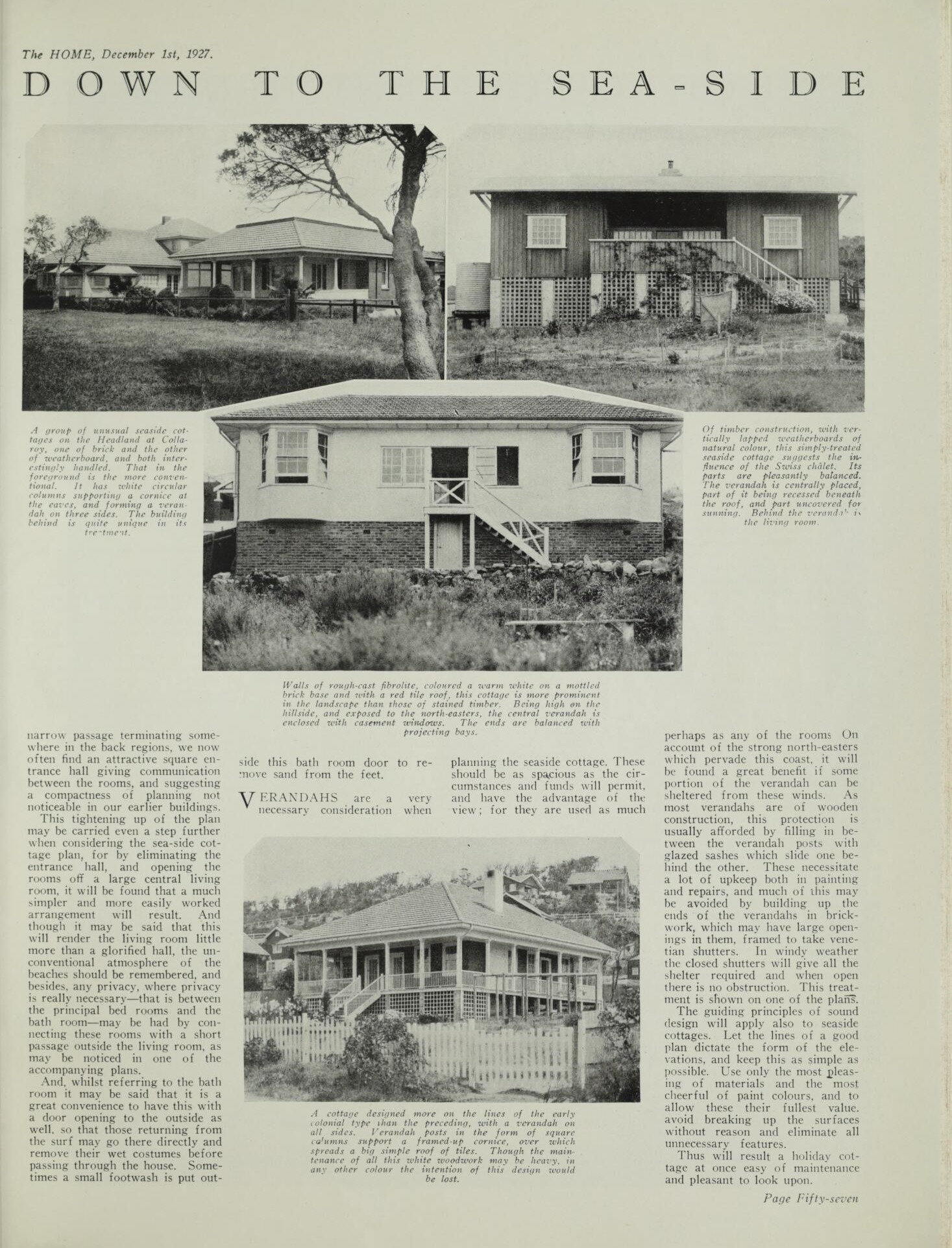
HOUSE & GARDEN SECTION. PLANNING THE SEASIDE COTTAGE FOR THOSE THAT GO DOWN TO THE SEA-SIDE, The Home : an Australian quarterly. Vol. 8 No. 12 (1 December 1927). Retrieved from http://nla.gov.au/nla.obj-385234842 - 3 pages of article, also shows houses at Dee Why and Collaroy as examples. Note other Architectural firms quickly took on this form of plantation bungalow for seaside areas along with suburban lots.
Highlands, Wahroonga
The name 'Highlands' honours Carline's Scottish heritage.
The land encompassing the site was a part of the original land grant of 2000 acres to John Terry Hughes in 1842. Hughes arrived in Sydney from England in 1824 and received a series of land grants throughout Sydney. He died in 1851, nine years after receiving the land in the Waitara area. From the 1850s onwards the land was gradually sold off and in 1884 it was purchased by William Penny who in the following year sold the land to an architect named George Cotton Clark. Clark sold a portion of the land to the state for the construction of a railway and 1887 he sold the remained of the land to John Frederick Hill.
Caroline Hordern purchased the land from Hill in 1894. Caroline Hordern and her husband Alfred James Hordern lived in a cottage in Wahroonga while their house Highlands was being constructed.
.jpg?timestamp=1705599949543)
.jpg?timestamp=1705599978179)
.jpg?timestamp=1705600011031)
Certificate of title Vol/Fol: 1134-93 - Source: Historic Land Records Viewer, hlrv.nswlrs.com.au
In 1924 two acres of the Highlands Estate on the corner of Junction Road (now Edgeworth David Avenue) and Myra Street, was transferred from Caroline Hordern to the Minister of Education:
Waitara Public School - 2 acres: Certificate of title Vol/Fol: 3621-154 - Source: Historic Land Records Viewer, hlrv.nswlrs.com.au.
The remains, Certificate of title Vol/Fol 3701-59, shows the Horderns still own 25+ acres, which was sold off in late 1933.
Highlands is a heritage-listed private residence located at 9 Highlands Avenue, Wahroonga in the Hornsby Shire local government area of New South Wales, Australia. It was designed by John Horbury Hunt and built from 1890 to 1893. It was added to the New South Wales State Heritage Register on 2 April 1999.
Alfred (1859–1932) married Caroline Doig (1870–1938) in 1890. Caroline was the daughter of Alexander, a planter in Levaka, Fiji, and merchant of Sydney. Some state this was where she was born, others state London.
Plans for Highlands would have already been drawn up or the house may already have been under construction. Caroline obviously had a hand in the plans.
Lesley Horden said of Alfred that;
"There is nothing in his letters to suggest he had the aestheticism or the spirit of innovation which would move him to commission such an architect. He was not a man to take risks or flout convention, and the robust and distinctive style of this house... bears little relation to his nervous personality."
Caroline, however, is described as an artistic and well-educated woman, attributes reflected in Highlands. Other evidence of her influence of the plans is the second kitchen, located next to the household kitchen, which allowed her to "indulge in a culinary orgy." For Caroline, cooking was a creative outlet and was not for the purpose of feeding her family. Once her masterpieces had been formed they were given to local hospitals to feed patients.
The garden was also created and maintained by Caroline, with the help of up to 14 gardeners. The original garden, how much modified, featured colour. Of note was the gravel driveway bordered by hydrangeas, in 1931 the garden was said to contain 100 varieties. Another feature was a 6.4-metre-long (21 ft) bed of lily-of-the-valley. The garden was not just ornamental, there were extensive kitchen garden beds and, in 1903, Caroline had a grape house constructed. She was also an avid collector and would bring back exotics from her travels in the Pacific Islands and Europe. This had its down side, it is said she introduced a weed of the Oxalidaceace family to Australia.
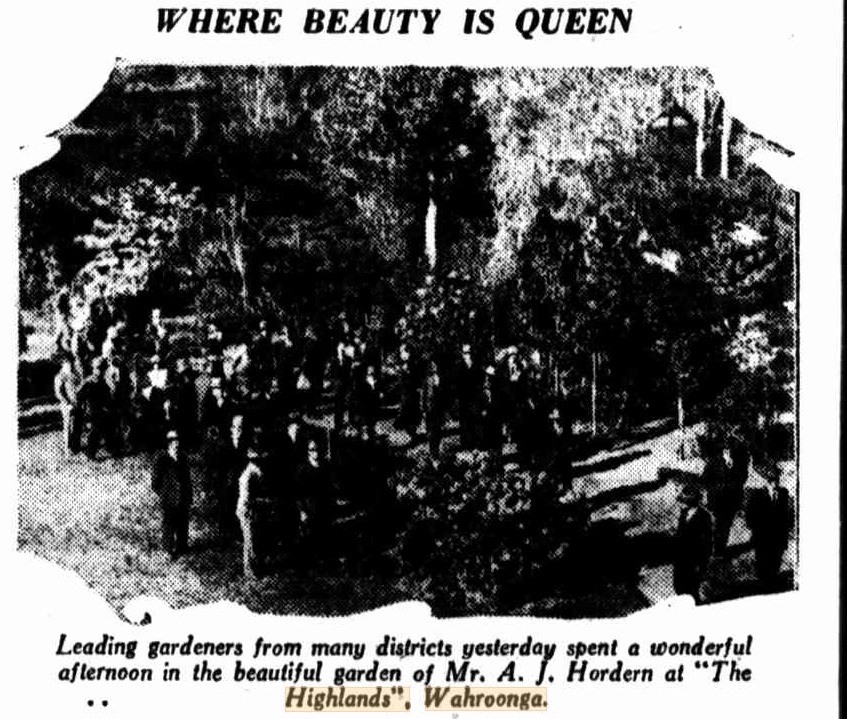
WHERE BEAUTY IS QUEEN (1929, October 6). The Sun (Sydney, NSW : 1910 - 1954), p. 2. Retrieved from http://nla.gov.au/nla.news-article223496629
Although it is noted in the official records that Alfred Roy junior and Bruce may not have maintained the house as when it was purchased by Mr and Mrs Norman Jones in 1948 it was in a dilapidated state, it should be noted that they had both passed away years prior to this. The Jones replaced the shingle roof with concrete tiles in the 1960s as part of their restoration.
This distinctive two-storey house comprises two conjoining components. The prominent part is the house proper, the kitchen wing sits a separate pyramidal roof. The separation of these two functional centres was advanced for its time. Both roofs were originally shingled, like the walls. The wall shingles curve out over verandahs and openings, to shed water away from the walls. This is a feature of several of Hunt's Shingle Style houses. The verandahs are supported by massive timber posts, minimally decorated. The verandahs are recessed under the eaves, another design element commonly used by Hunt.
Internally, a small stair hall opens into the sitting room on the right and the drawing room on the left. The drawing room was formerly a dining room. Behind the hall was originally Mrs. Hordern's kitchen, but has since been converted into the dining room.
The bedrooms on the second floor open off the stairwell, with the verandah facing north off the main bedroom.
Extensive alterations have been made to the kitchen wing. This wing contains a feature not seen in Hunt's other houses - a wide half-glass door. Reynolds and Hughes describe "the structural brace is treated as a glazing member, to which the normal glazing bars are subservient."
The chimney stack is another unusual feature, "a tall, buttressed slab of brickwork which appears almost freestanding." Externally, the original roof shingles have been replaced by grey roof tiles.
The main framing, including window openings is of NSW hardwood, while the window sashes and doors are cedar.
The house was originally situated on 25 acres, but subdivisions have left it on a substantially smaller allotment, with the rear of the house to the street.
The garden, although significantly altered, contains a notable period Hoop Pine and provides a sympathetic setting to the house.
INCENSE
FIVE ACRES OF GARDEN
A. J. HORDERN'S PRIDE
Costing almost a fortune to maintain, one of the finest private gardens in the. State is that of Mr. A. J. Hord-ern, at The Highlands, Wahroonga.
No fewer than seven gardeners are-employed all the year round, and, altogether, about, five acres are under cultivation.
Members of the Horticultural Association, at Mr. Hordern's invitation, visited The Highlands yesterday afternoon. Within the shelter of a miniature forest- of tall gums, the garden presented a perfect orchestration of color. Rhododendrons fully' 30ft. high, which were planted 35 years ago, a stately Canary Island palm, planted at the same time, Japanese maples, wisteria, magnificent azaleas, blossoms and buds, purple and pale, drenched the air with their perfume, In the almost Incomparable shade house rare and costly Imported orchids bloomed. The visitors, who included the Curator of the Botanic Gardens (Mr. E. N. Ward) were greatly impressed with the perfect blending in the colors. INCENSE (1929, October 6). The Sun (Sydney, NSW : 1910 - 1954), p. 7. Retrieved from http://nla.gov.au/nla.news-article223496392
Here too, Caroline Hordern opened the gardens to raise funds for local institutions - this first example indicates Alfred and Caroline Hordern also had contact with the next Governor of NSW after the de Chairs left.
Air Vice-Marshal Sir Philip Woolcott Game, GCB, GCVO, GBE, KCMG, DSO (30 March 1876 – 4 February 1961) was a Royal Air Force commander, who later served as Governor of New South Wales and Commissioner of Police of the Metropolis (London). Game was appointed Governor of New South Wales in March 1930. He arrived in Sydney with his family in May 1930. On 30 June 1930, Game was appointed by King George V a Knight of Grace of the Venerable Order of St John (KStJ).

Sir Philip and Lady Game are farewelled by Premier Stevens on board RMS Niagara, upon their departure on 15 January 1935. Photo courtesy Mitchell Library, State Library of New South Wales
BRISK BUSINESS
At "Highlands" Fete.
FOR GRAYTHWAITE HOME.
Napoleon once accused the English of being "a nation of shopkeepers," and doubtless, we In Australia have Inherited some of the quali-ties of our forebears However that may be, we certainly know how to sell goods, which Is proved over and over again by the huge amounts of money raised annually by garden fetes And, after all, what are the stalls at a garden fete if they are not miniature open air shops?
The bazaar held at The Highlands, the home of Mrs A J Hordern, at Wahroonga, on Saturday, was no exception Helpers at the various stalls were already doing a brisk trade when Lady Game arrived at 3 o'clock to per-form the opening ceremony The proceeds are in aid of the Graythwaite Home for disabled soldiers at North Sydney, and it is for this cause that Mrs Hordern and her son, Mr Bruce Hordern, have lent their beautiful gardens, which will remain open for a week.
Lady Game was received by Mrs A J Hordern and Mrs Cecil Hordern with Mrs N G McNeil and Mrs Leslie. An exquisite bouquet of pale yellow roses, gathered from the Highlands gardens, was presented her by Miss Carmen Hordern.
In her opening speech, Lady Game said ' The first thing we notice about the disabled soldiers at Graythwaite is their wonderful cheerfulness and content, and combining these, their wonderful braveness The first time I visited Graythwaite " she said "I met one of the Diggers, I asked him to tell me about himself and the things he had been through and he said 'You know, I only remember the good bits ' That has always stayed with me "
The official guests also included Mrs Cox, Mr John Mackay Dame Eadith Walker, Dame Mary Hughes, Mrs Ronald Mackay, the Rev. and Mrs Hugh Hordern.
The coloured stalls decorated with flags and flowers and erected like a small gipsy village In the midst of a garden of rhododen-drons and Chinese azaleas, made a pictur-esque setting for the many helpers who In red gingham aprons, peddled their wares through the gardens.
Those In charge of stalls included Mrs E A Armstrong and Mrs F Spicer (hoop-la), Mrs T W Nicholls, Mrs F Brennan, and Mrs Garnet Simpson (fish pond lucky dips), Miss Winsome Henderson (flower stall), Mrs E Hordern (cocktail bar), Mrs Vero Read and Mrs H McNall (fancy stall), Mrs Alec Raven and Mrs N G McNeil (produce stall), Mrs Dan Kelly (cigarettes), Mrs P Wood and Mrs C Hordern (packet stall) and Mrs L, Esdaile (sweet stall).
Among others present were Miss Maud Russell, who designed the wrappers for the lucky packets, for which such valuable prizes were given as sea trips, aeroplane flights gramo-phones, wirelesses, and a writing desk Mr Walter White, Admiral and Mrs Stevenson Mrs A P Humphries, the Rev Noble Bur-ton and Mrs Burton Mrs George Christie, Miss Nancy Clark, Mrs W N Mcconochie, Mrs W C Adams Mrs Stanley Crick Mrs E E Brown Mrs Hemphill, Miss Helen Hughes, Miss Margaret Burton, Miss Bobby White Miss Mary Hordern, Mr and Mrs Primrose Colonel Dudley Smith and Captain de Groote who was in charge of the band and the gate.
In the evening the garden was converted into a fairyland by means of flood-lighting. BRISK BUSINESS (1933, October 16). The Sydney Morning Herald (NSW : 1842 - 1954), p. 4. Retrieved from http://nla.gov.au/nla.news-article17015736
MRS. A. J. HORDERN. of "The Highlands," Wahroonga, will open her garden for public inspection next Saturday afternoon, from 3.30 p.m., to assist the funds of the Kindergarten Union. Afternoon tea will be served.
There are over 10,000 hydrangeas in full bloom, showing about 300 different varieties. The garden will be open on Sunday afternoon for the Turramurra branch of the Red Cross Society. North Shore (1932, December 4). The Sun (Sydney, NSW : 1910 - 1954), p. 33. Retrieved from http://nla.gov.au/nla.news-article230570050
MRS. A. J. HORDERN, of "The Highlands," Wahroonga, threw her lovely garden open for public inspection yesterday afternoon to raise funds for the Turramurra branch of the Red Cross Society. Thousands of hydrangeas of every colour and variety are in bloom in the garden, which is one of the show places of Wahroonga. Admission is by a silver coin. North Shore (1932, December 11). The Sun (Sydney, NSW : 1910 - 1954), p. 29. Retrieved from http://nla.gov.au/nla.news-article230579362
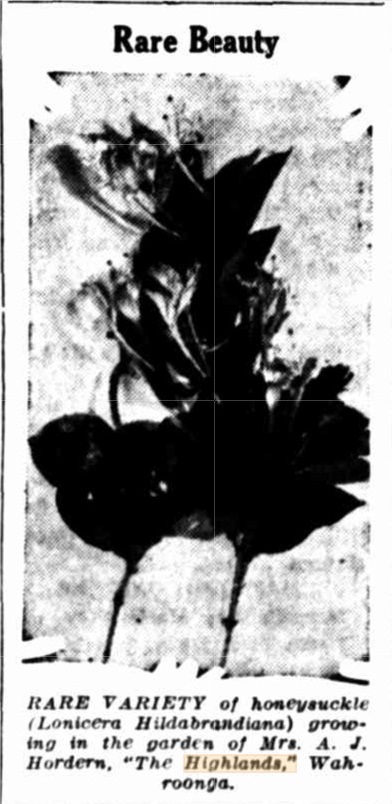
Rare Beauty (1933, November 25). The Newcastle Sun (NSW : 1918 - 1954), p. 2. Retrieved from http://nla.gov.au/nla.news-article165078742
A BUSH POOL IN A WAHROONGA GARDEN.
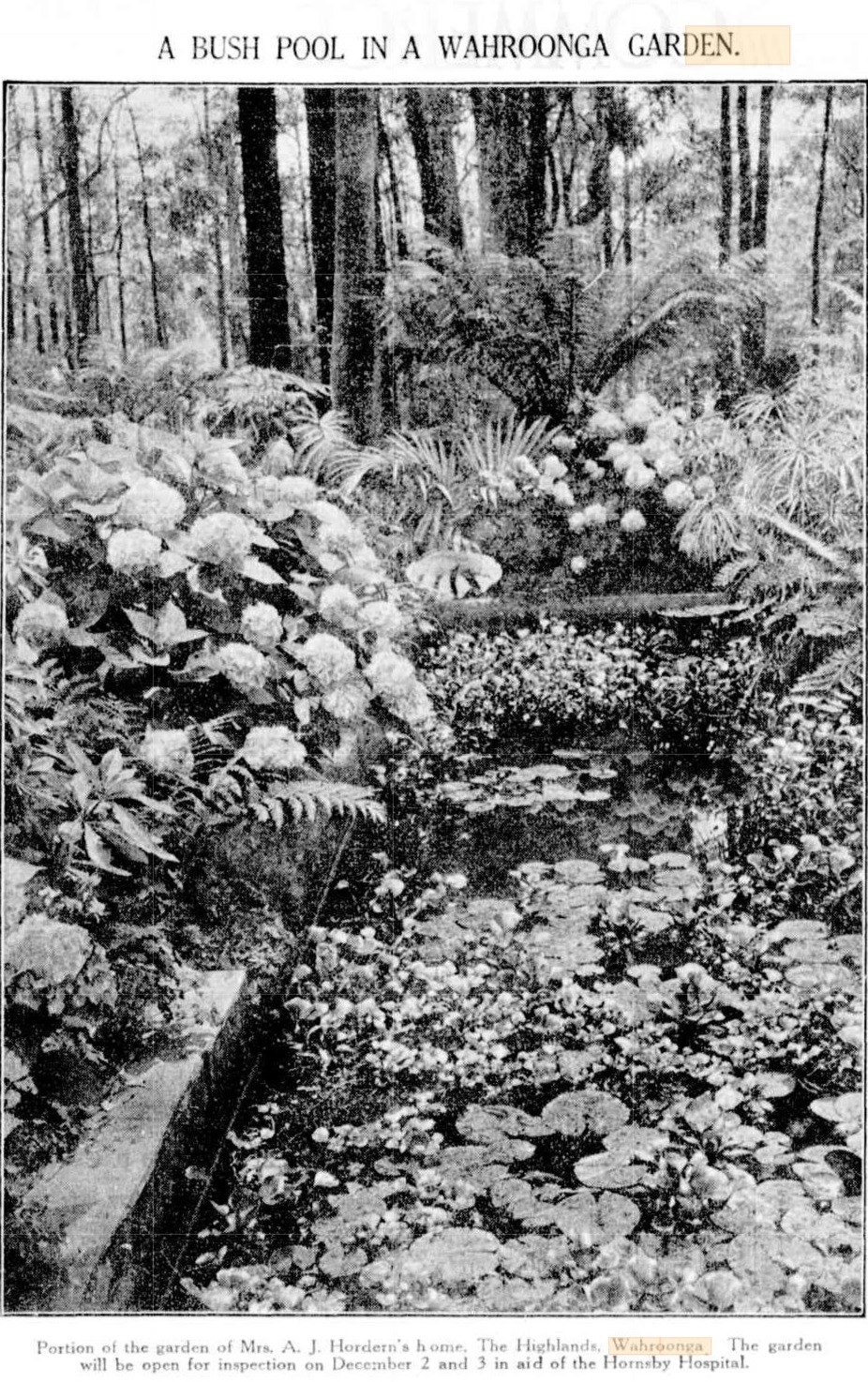
Portion of the garden of Mrs. A. J. Hordern's home, The Highlands, Wahroonga. The garden will be open for inspection on December 2 and 3 in aid of the Hornsby Hospital. A BUSH POOL IN A WAHROONGA GARDEN. (1933, November 29). The Sydney Morning Herald (NSW : 1842 - 1954), p. 16. Retrieved from http://nla.gov.au/nla.news-article17028180
GARDEN THRONGED.
Thousands See "Highlands" Hydrangeas.
Though it was estimated by the police officers on duty there that over ten thousand people inspected the wonderful gardens at the home of Mrs. A. J. Hordern, The High-lands, Wahroonga, yesterday after-noon, Mrs. Hordern stated last night that not one plant had been damaged in the inspection, in spite of the fact that the paths and green houses were so thronged at times that "one-way" traffic had to be observed.
Altogether, during the week-end, thirteen thousand people passed through the grounds, and the Hornsby and District Hospital, for which the inspection was arranged, will benefit by the sum of several hundreds of pounds.
The gardens at The Highlands are famed for their beautiful hydrangeas, of which there are literally thousands, and with perfect weather as an additional attraction, the blooms seemed to reflect some of the intense blue of the sky and, looking through a vista of tree ferns and maples on the undulating sea of blue, was like looking Into a Japanese print, so defined were the contrasts of colourings, the rich relief of rusty maple leaves intensifying the colours of the blooms.
The afternoon was arranged by the Waitara auxiliary, which includes on its committee Mrs. S. A. Storey and Mr. H. S. Blackler (Joint presidents), Mrs C. J. Jagoe and Mrs. N. J. Hicks (joint secretaries), and Mr. P. Stringer (treasurer). GARDEN THRONGED. (1933, December 4). The Sydney Morning Herald (NSW : 1842 - 1954), p. 4. Retrieved from http://nla.gov.au/nla.news-article17029331
HOME SITES AT WAHROONGA
Horderns' grounds to be cut up
To own a home of his own — that is every man's dream of the future. The home of the dream is a bright and cheery place In pleasant surroundings.
At Wahroonga home sites are being auctioned by Richardson and Wrench on November 25. The land is part of the grounds of "The Highlands," the well-known home of the Horderns, and is lightly timbered with native Australian trees. HOME SITES AT WAHROONGA (1933, November 17). The Daily Telegraph (Sydney, NSW : 1931 - 1954), p. 11. Retrieved from http://nla.gov.au/nla.news-article247174402
As at 20 September 2006, Highlands was a fine example of John Horbury Hunt's interpretation of the Shingle Style. The house displays many of the elements common to Hunt's Shingle Style houses, including recessed verandahs and sweeping skirts to deposit water well away from the walls. In contrast to these common elements, Highlands also displays several unusual features, a half-glass door and distinctive chimney stack being the most prominent.
Highlands is significant as evidence of women shaping architecture. Mrs Caroline Hordern was a keen cook and the two-storey kitchen wing was heavily influenced by her. The landscaping was also of her creation and Mrs. Horden introduced many exotics from the Pacific Islands to adorn the garden.
Highlands was listed on the New South Wales State Heritage Register on 2 April 1999 having satisfied the following criteria;
The place is important in demonstrating the principal characteristics of a class of cultural or natural places/environments in New South Wales.
Highlands is representative of John Horbury Hunt's interpretation of the Shingle Style. While each of Hunt's houses has distinctive elements, Highlands displays features common to his Shingle Style houses, namely recessed verandahs and shingles sweeping away from openings to carry water away. Highlands is currently the only Shingle Style house of this scale on the State Heritage Register.
'Highlands' References:
- "Highlands". New South Wales State Heritage Register. Department of Planning & Environment. H00034. Retrieved 1 June 2018. Text is licensed by State of New South Wales (Department of Planning and Environment) under CC-BY 4.0 licence
- Horden, Lesley (1985). Children of One Family: the story of Anthony and Ann Hordern and their descendants in Australia, 1825-1925.
- Reynolds, Peter; Muir, Lesley; Hughes, Joy (2002). John Horbury Hunt: Radical Architect 1838-1904.
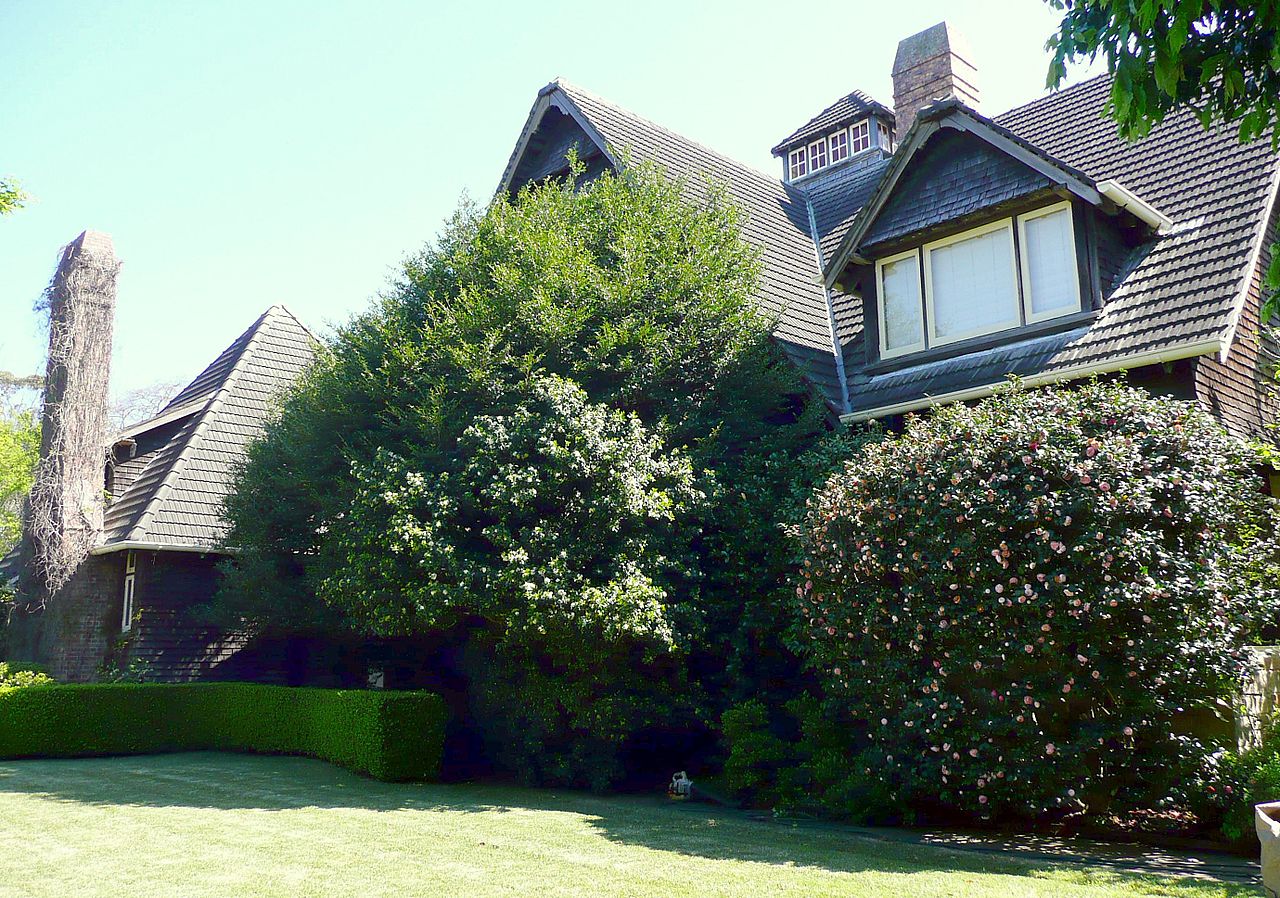
Highlands, Wahroonga, Sydney (this image has been altered by Sardaka, 2014-1-7, including straightening, sharpening and warming of colours)
John Horbury Hunt (1838 – 30 December 1904), often referred to as Horbury Hunt, was a Canadian-born Australian architect who worked in Sydney and rural New South Wales from 1863. Born in Saint John, New Brunswick, the son of a builder, Hunt was trained in Boston, Massachusetts but then migrated to Australia in 1863. He worked in Sydney with Edmund Blacket for seven years prior to pursuing his own practice. His output was extremely varied and included cathedrals, churches, chapels, houses, homesteads, stables and schools. Probably his first building designed in Australia was the Superintendent's Residence at the Prince of Wales Hospital, Randwick, designed in 1863. A few years later he designed the Catherine Hayes Hospital, which was also built at the Prince of Wales Hospital, with the design modified by Thomas Rowe. Hunt's other works include the Convent of the Sacred Heart, now Kincoppal School, in the Sydney suburb of Vaucluse; and Tivoli, now part of Kambala, in the suburb of Rose Bay. In Armidale, he designed St Peter's Anglican Cathedral and Booloominbah and Trevenna which are now both part of the University of New England.
Hunt's distinctive, radical architecture was considered to be twenty years in advance of his peers, some of it unequalled in the world at that time, and sowed the seeds of some aspects of modern architecture in Australia. It has been said that "Undoubtedly men such as Hunt... have, through their buildings and their ideas, stiffened the intellectual backbone of Australian architecture. He was instrumental in bringing the North American Shingle Style to Australia. The outstanding example of this style was Highlands, a two-storey home designed by Hunt and built for Alfred Hordern in 1891. Situated in Highlands Avenue, Wahroonga, Sydney, Highlands is listed on the Register of the National Estate. Another notable example is Pibrac, designed by Hunt for Frederick Ecclestone du Faur. Pibrac is also on the Register of the National Estate.
Hunt was ruined by the Depression of the 1890s. He died in Royal Prince Alfred Hospital, Camperdown, eleven days after admission suffering from Bright's disease (a kidney disease). His personal effects, recorded in the hospital Admission Book, consisted of a metal box, three gold rings, a silver pencil and a pair of spectacles. He was buried at South Head Cemetery, Vaucluse (the story that he was buried in a tomb with his wife and pet pony is a popular myth).
He was close to destitute at the time of his death. His home, Cranbrook Cottage, had been repossessed by the mortgagor; it was demolished in 1925 to make room for the widening of New South Head Road. The site of the cottage is marked by a small rock garden, named Horbury Hunt Place. Riversdale House in Burradoo, now part of Chevalier College, still survives and is thought to be similar in design to Cranbrook Cottage, having been commissioned by Henry Osborne around the same period (c1875). - Wikipedia

John Horbury Hunt and his wife outside 'Cranbrook Cottage', Bellevue Hill, Sydney. SLS NSW Photo
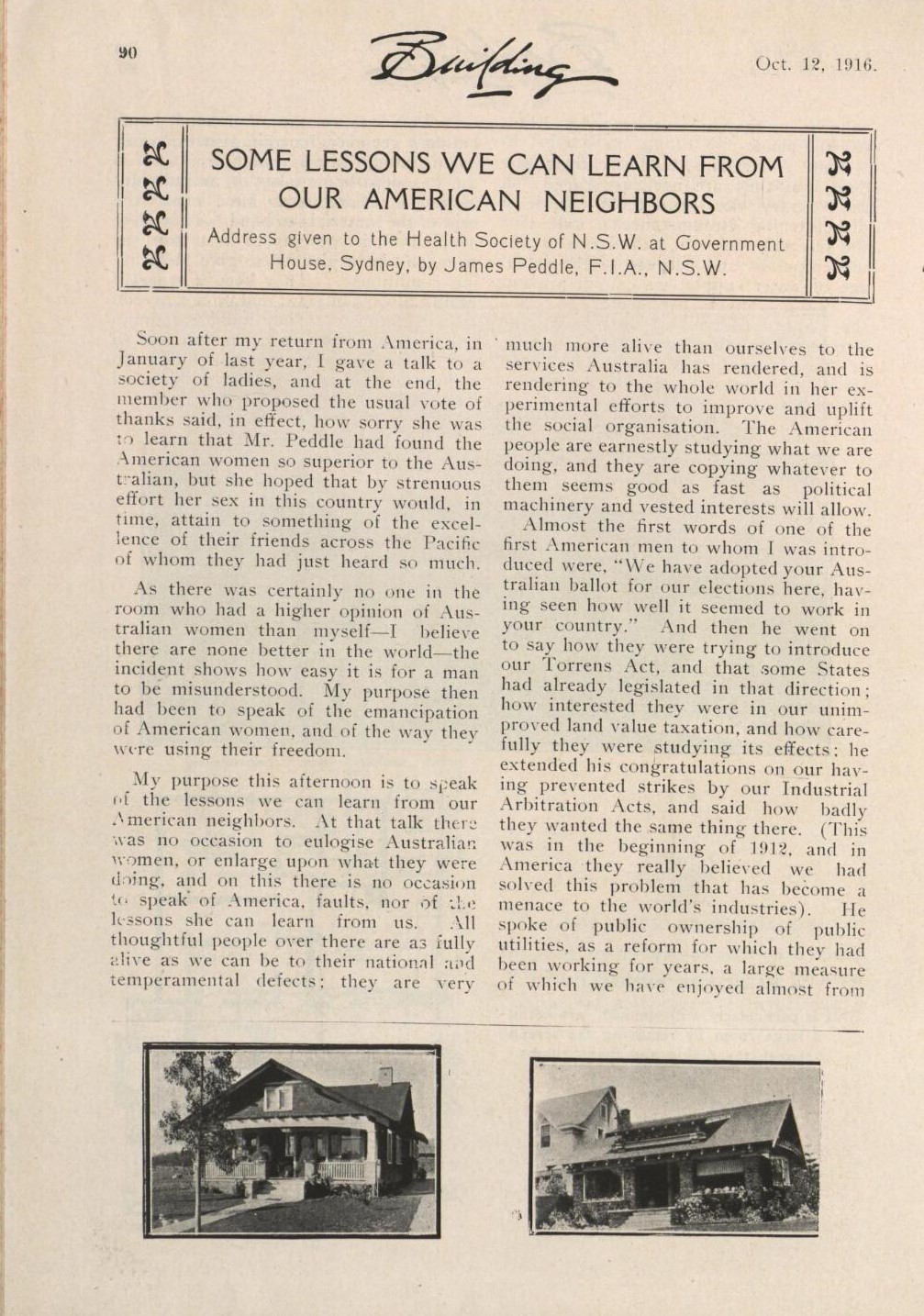
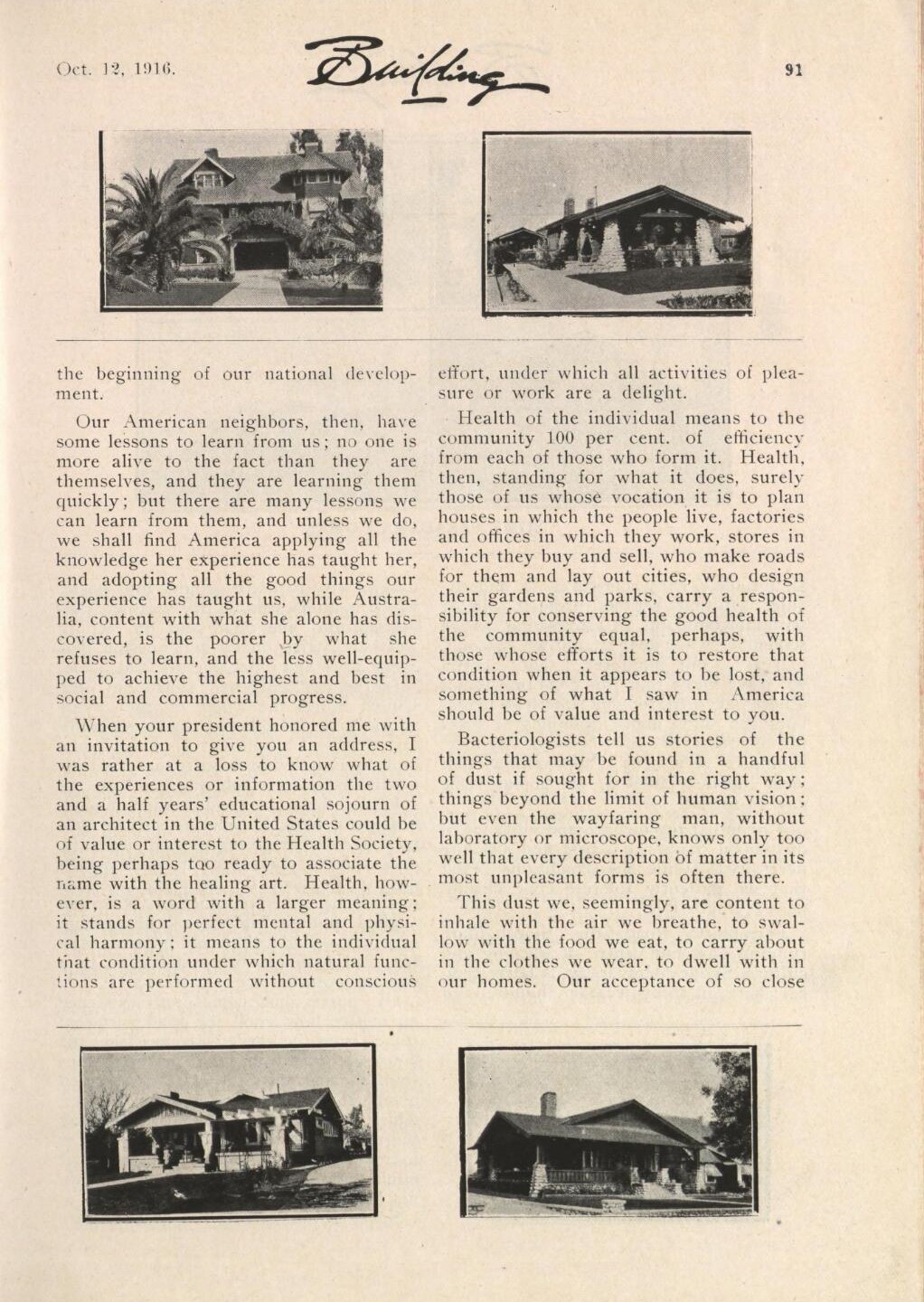
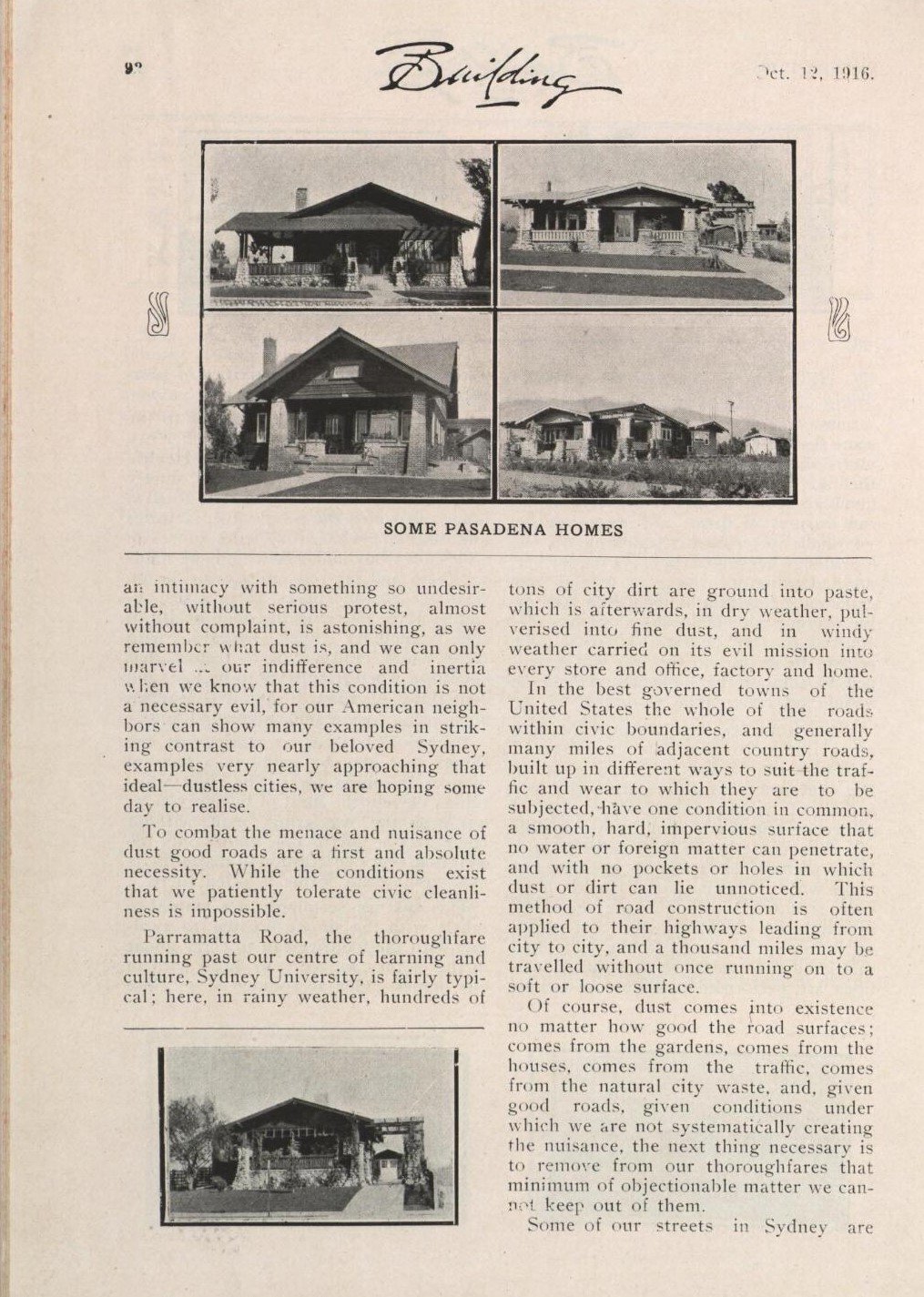
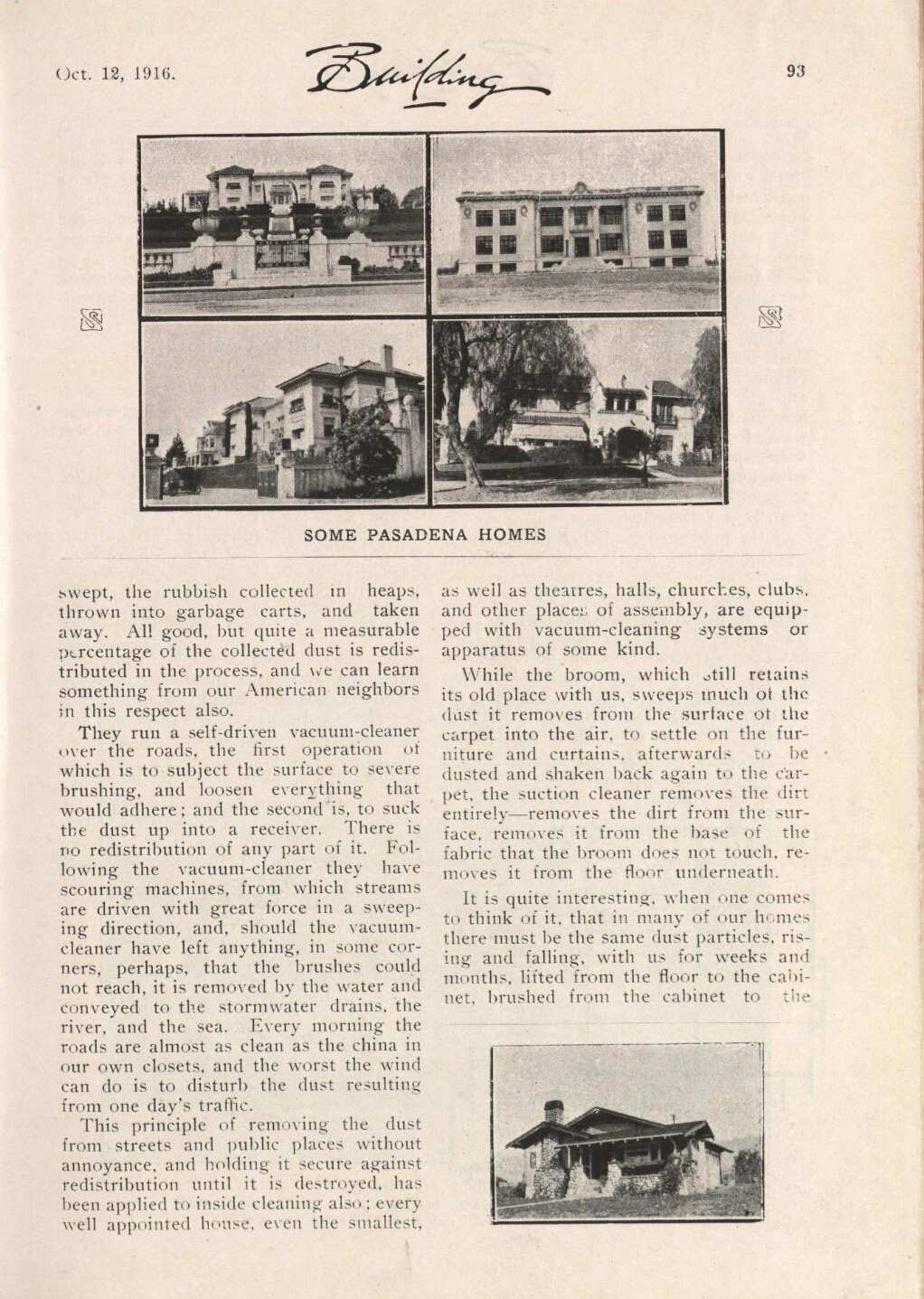
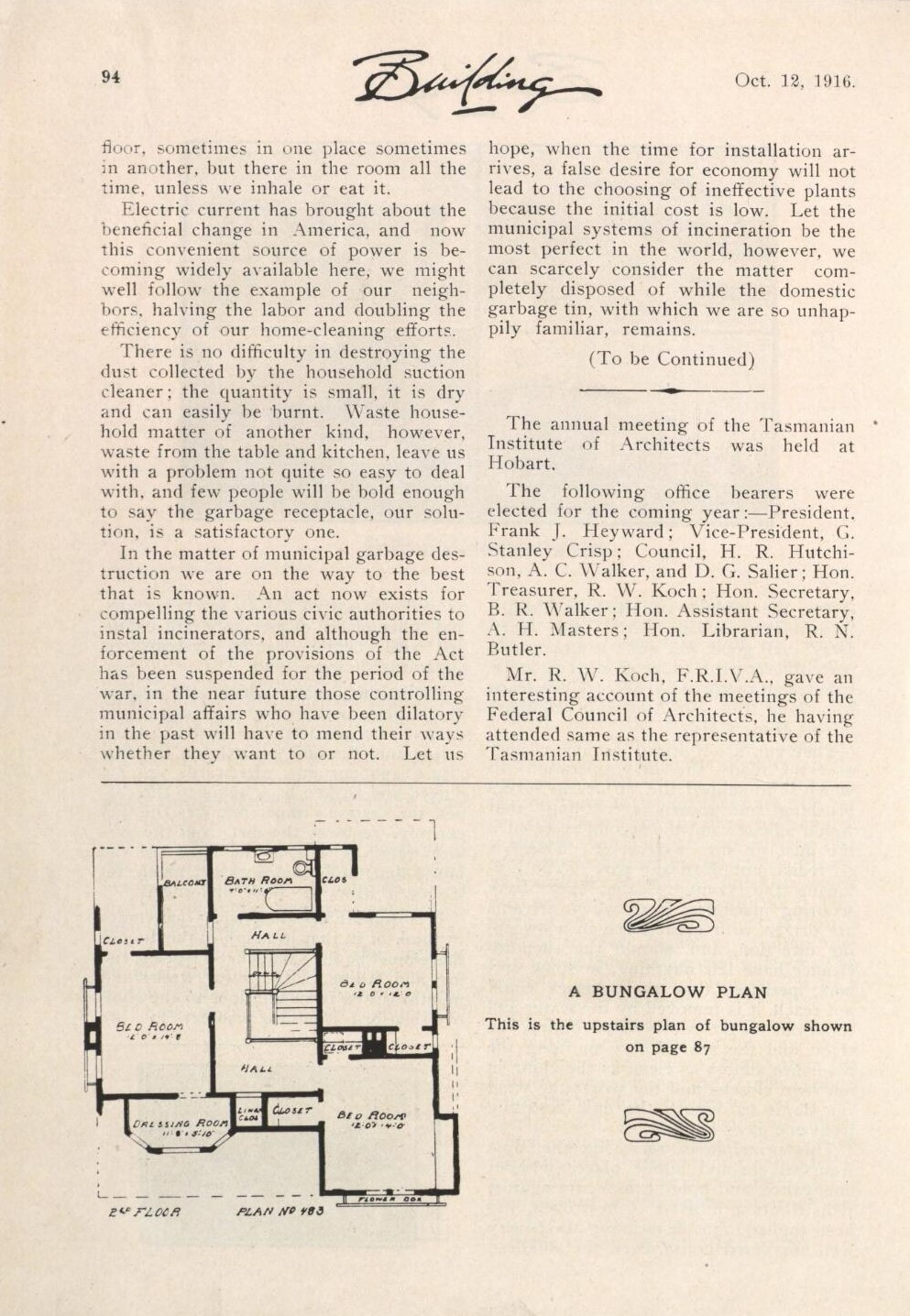
SOME LESSONS WE CAN LEARN FROM OUR AMERICAN NEIGHBORS Address given to the Health Society of N.S.W. at Government House, Sydney, by James Peddle, F.I.A., N.S.W. (12 October 1916) Federated Builders' Association of Australia & Master Builders' Federation of Australia. (first published 1907). SOME LESSONS WE CAN LEARN FROM OUR AMERICAN NEIGHBORS Address given to the Health Society of N.S.W. at Government House, Sydney, by James Peddle, F.I.A., N.S.W., Building : the magazine for the architect, builder, property owner and merchant Retrieved from http://nla.gov.au/nla.obj-273752220
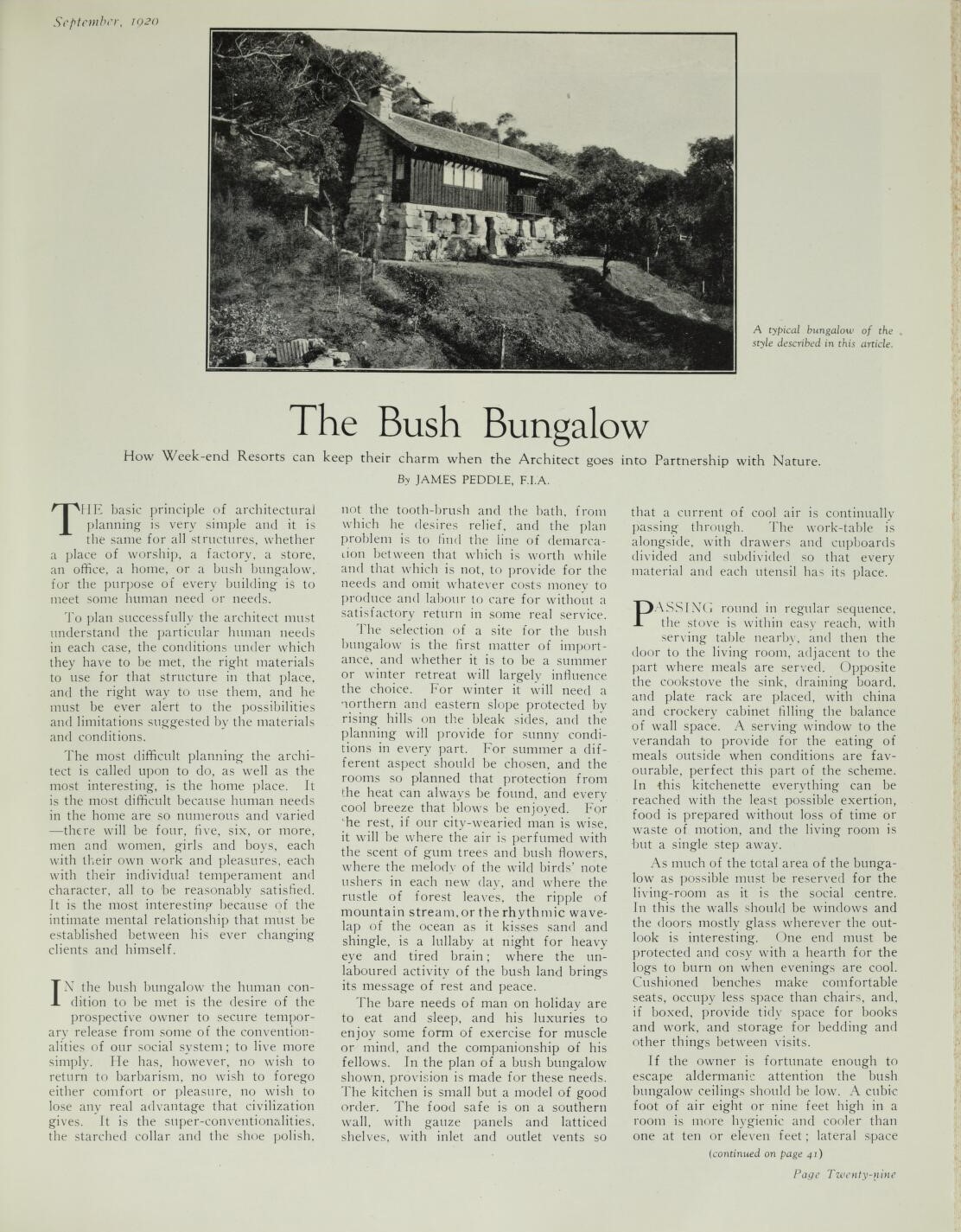
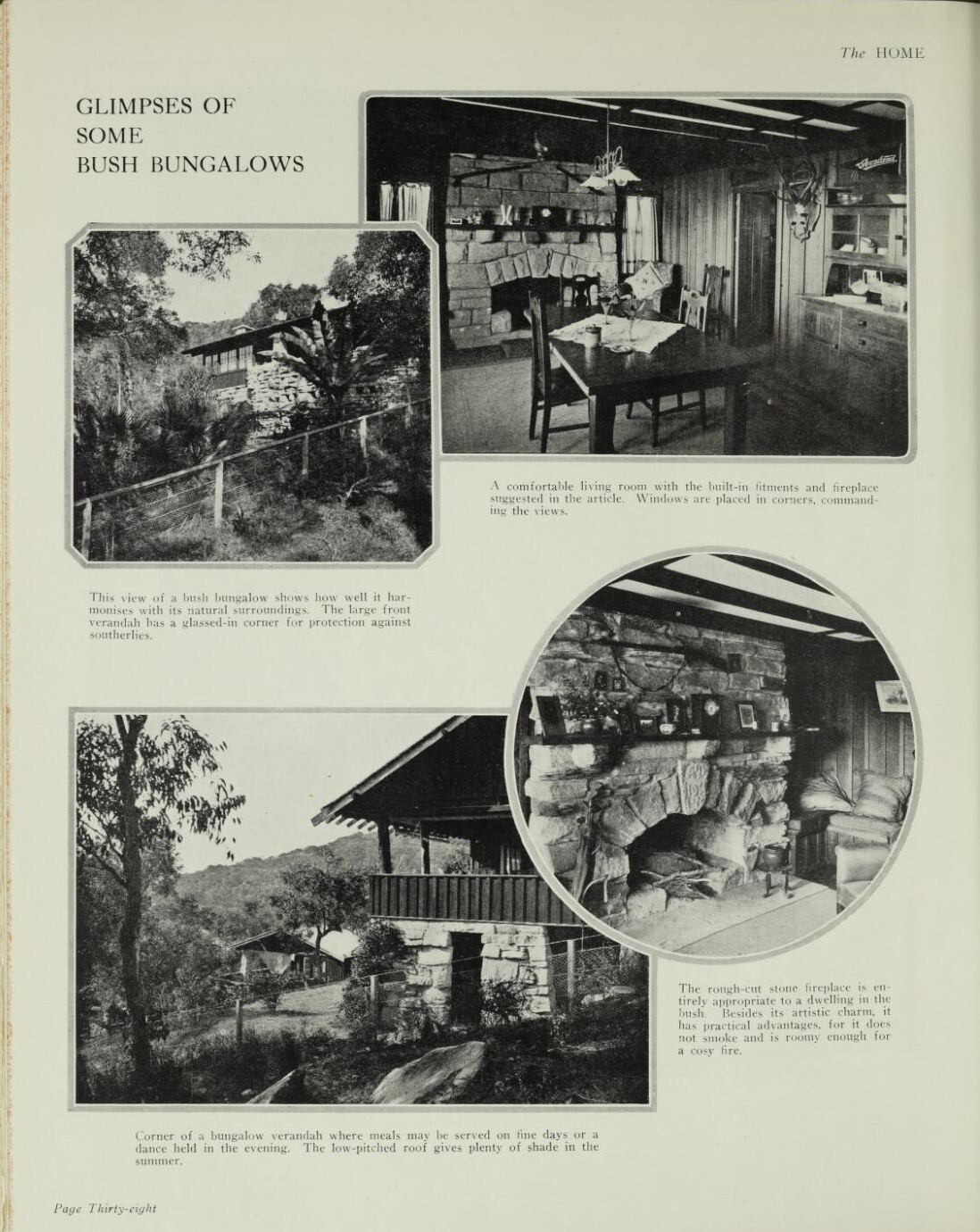
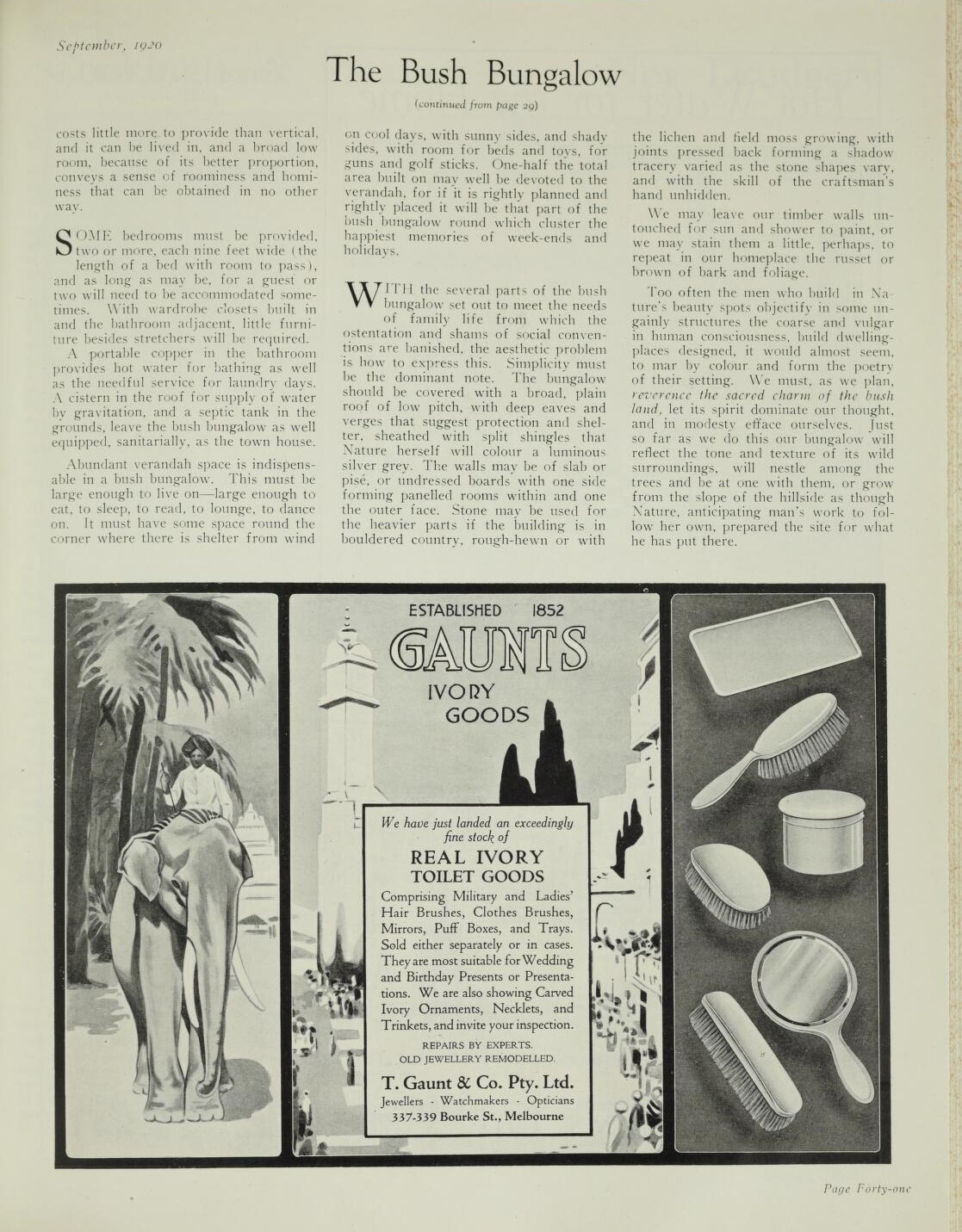
James Peddle “The Bush Bungalow” in The Home, September 1920, pp.28-29, 41 (1920). The Bush Bungalow, The Home : an Australian quarterly Retrieved from http://nla.gov.au/nla.obj-396365004
James Peddle Obituary in Building, 1931:
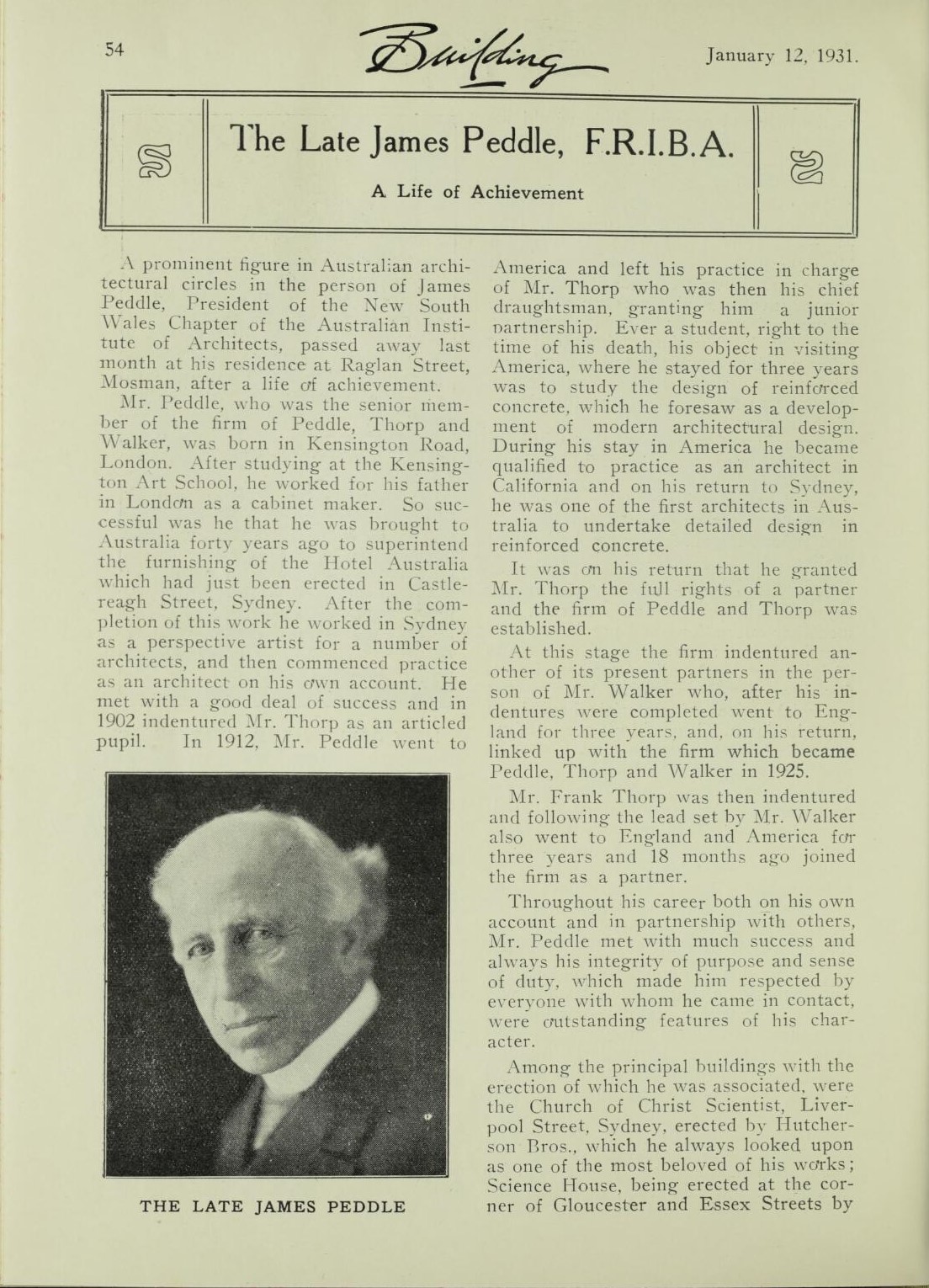
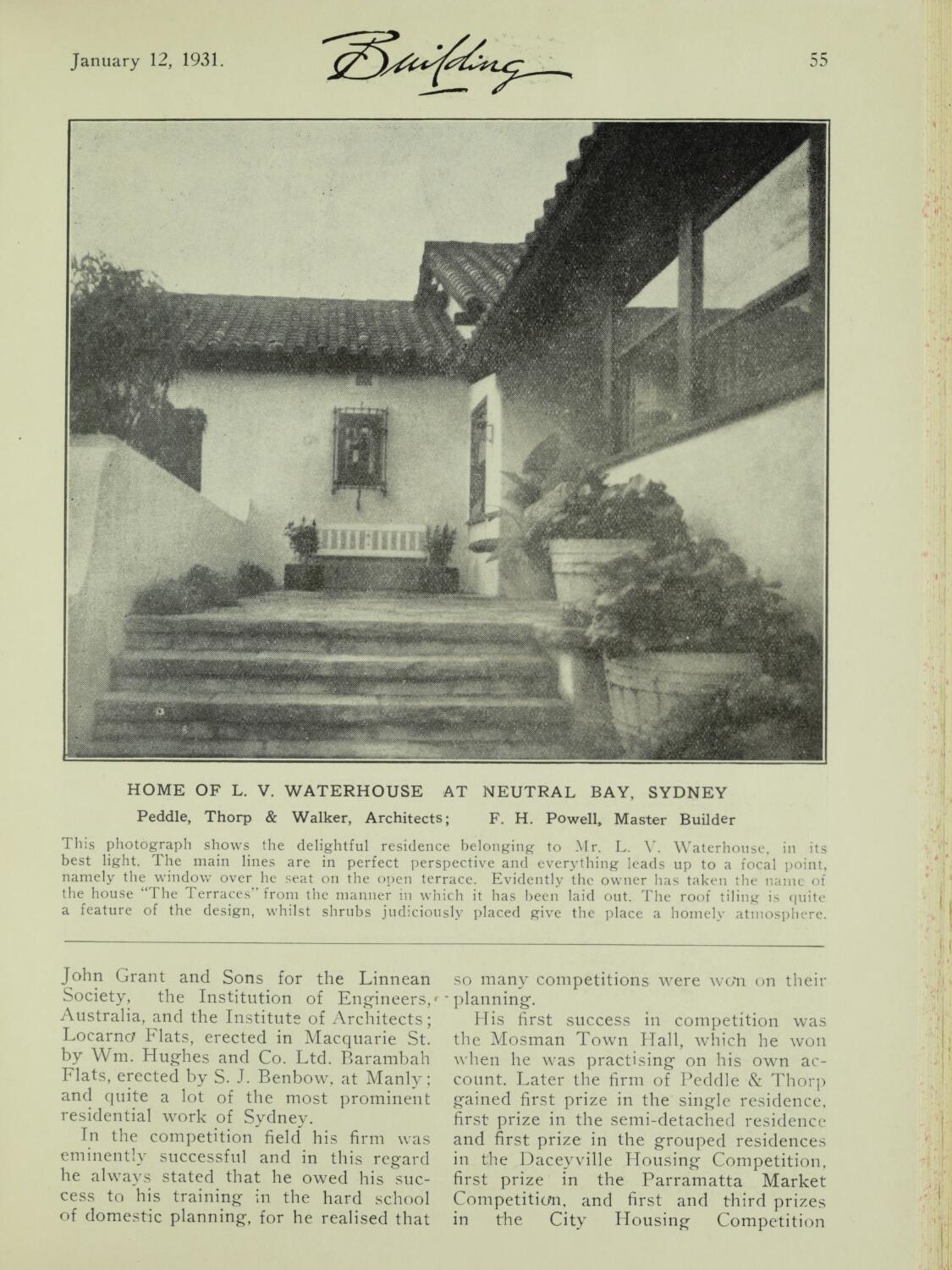
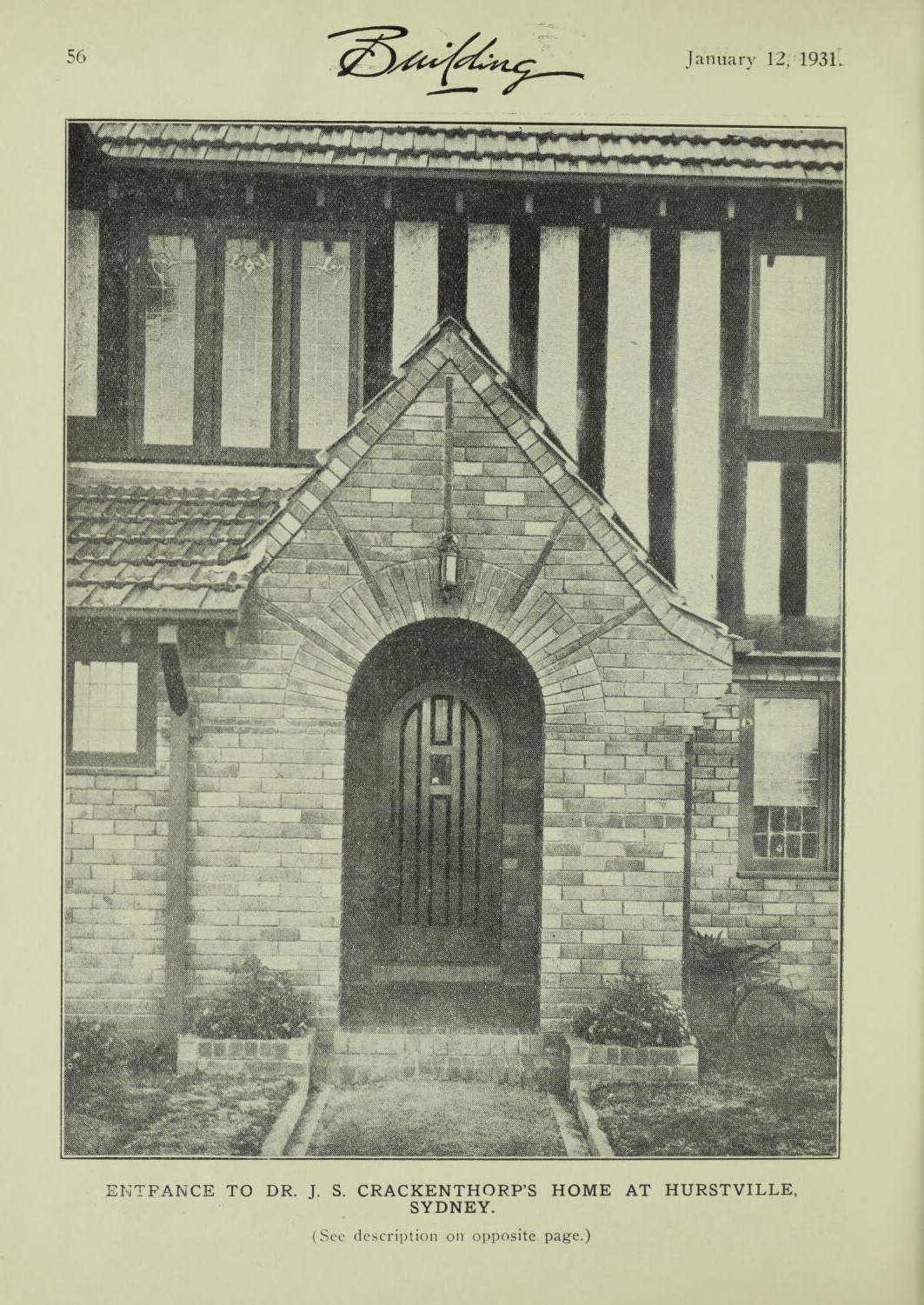
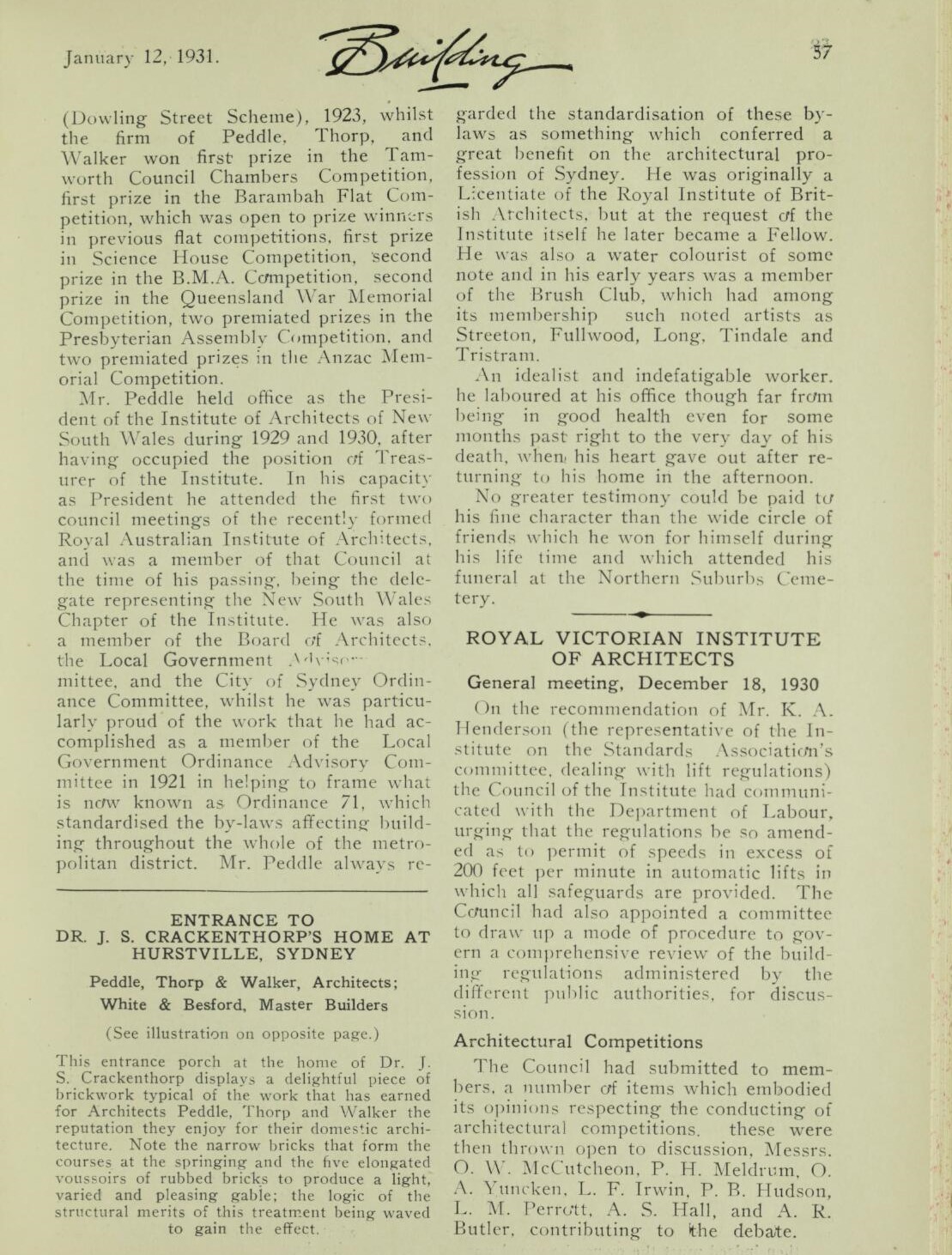
Alfred Roy Hordern
ENGAGEMENT.
The engagement is announced of Annie, youngest daughter of Mr. and Mrs. Oscar G. Roberts, Mount Errington, Hornsby, to Alfred Roy, eldest son of Mr. and Mrs. A. J. Hordern, The Highlands, Wahroonga. ENGAGEMENT. (1914, September 19). The Sydney Morning Herald (NSW : 1842 - 1954), p. 8. Retrieved from http://nla.gov.au/nla.news-article15562643
HORDERN'S HAREM OF HUSSIES AND HOUSEMAIDS
Son of Pitt St. Draper Prefers Paddling With Phyllis at Palm Beach to Society of Wife — Mr Justice Owen's Caustic Criticism of Alfy's Moral Character — or Rather the Lack of It
COURT REFUSES ORDER FOR ACCESS TO CHILD
ON the face of things, there seemed to be no reason why Alfred Roy Hordern, a son of one of the merchant princes of Pitt-street, should turn away from his young wife to philander amongst the flappers, except that he was a libertine, and had always been one since his marriage, as the sheaf of letters which his wife had discovered amply testified.
THE authors of the various letters — if one could judge from their scholastic ability or lack of it, their indifferent spelling, and their poor calligraphy, were schoolgirls, and indifferent ones at that.
MOST of the letters were in a round, scrawling hand, like a third form schoolboy's, whilst others were in the weak, skimpy feminine hand that was evidently unused to holding tho pen.
IN one thing, however, they were very similar. The writers were all devotedly in love with the big scion of commercial rectitude, and were only suspicious of the possible consequences of an acquaintanceship, which most of them knew was barred by the proprieties and common sense.
Mrs. Daisy Phyllis Hordern, good-looking and ladylike, with just as fine a complexion as one might meet in a day's walk through the city, which has always been renowned for its amiable and good looking young women, is now only 28 years of age. After being married seven years, Mrs. Hordern realised the uselessness of such a husband as Alfred Roy Hordern, unless she were satisfied to continue playing second fiddle to his illicit loves, which no self-respecting woman could do. Consequently she applied to Mr. Justice Owen at the Divorce Court for a decree extending freedom and cutting the legal tie that bound her to such a wretched mate.
Mr. Curtis (C. Servetopulos) appeared for petitioner, whilst Mr. Hardwick (Creagh & Creagh) appeared for the husband on the question of access to the only child. There being so many Horderns in Sydney, it is only fair to mention that Alfred Roy is the son of Alfred James Hordern, draper, of Pitt-street, and is thirty-three years of age. His little wife, who beforehand was a Miss Willis, the daughter of an hotelkeeper, deceased, was twenty-one at the date of the wedding, and Hordern was five years older. The marriage took place at the St. Pancras register office London, on February 16, 1917. Petitioner had known her husband only three or four months, but he was such an ardent lover that the time was long enough.
He had been on active service with the A.I.F., but having developed some affection of the eyes was rusticating in London when fate threw them together. At first she knew him as Roy Munro, but after a short acquaintance he divulged his correct name to her.
Love-Sick Lover's Letters.
After the marriage they remained in England for a couple of years, and from the very start Hordern rigidly upheld the traditions of the well-to-do libertine. Within a few months ot the nuptial betrothing she returned home to her fiat to find him there with a strange And with her wifely intuition she noticed that her hairbrush had just been used, and her bed had been disturbed. However, as she was on the way to be laid aside, and was fearful of becoming too much upset over the happening, she refrained from kicking up the anticipated terrible fuss.
Later on, however, when she spotted her noble merchant in the street with the same woman, she naturally inquired who the woman was and Hordern obliged with the Information that he had known her in Australia.
Next she discovered in her flat — where Hordern hadn't taken much pains to conceal them, a number of letters from lovesick femininity addressed In envelopes which bore her husband's writing, to Roy Munro — evidencing that he had taken pains enough to write his own address for the sportive wenches. Inside the envelopes, however, were sickeningly-worded effusions from the nondescripts, who were possibly enamored with the liberal manner in which lie had treated them— as they referred to it.
Flighty Five.
Mr. Curtis pointed out that the writers were five different women owning or adopting the flighty names of Beattie, Ivy, Daisy. Lil and Muriel, and any sensible person reading them could draw only one inference, such as might be drawn from the following one, taken at random from the bundle:
Bloomsbury. 4/10/l17.
Dearest Roy, — As I have not heard from you I rearly (sic) can not wait any longer, as i am madly in love with you and I am quite a drlffercnt (sic) girl now at this very moment you are the World to me, and the dearest of Boys; my heart goes with you until next we meet, which. I do hope -will be very soone. Write soone won't you dear. Yours Most Lovingly, Efflie.
Roses red, Violets blue, Pinks are sweet, and so are you. If you love me as I love you. Nothing in this world will part us two.
Wife Keeps 'Mum.'
Their son and heir came on December 16, 1917, recited Mrs. Hordern, and she kept her own counsel about the discovered correspondence, but stuck to it nonetheless.
They reached back to Australia in February, 1919. and lived for some months at Hordern's father's home. Following this they took a house at Killara, In which healthy suburb they lived two years. But here her domestic life was rendered nauseous by some interloping female everlastingly ringing up Hordern on the telephone. She complained to him of the telephone attendant's rudeness, and expressed a wish that the annoyance should cease. But this lady was by no means the only pebble on the beach, for one night, on seeking her husband, she found him sitting in the maid's room on the bed. The door was open, and the maid was there. However, she upbraided him for being there, and told him the maid must go next day.
Some weeks later they removed to Shirley-road. Wollstonecraft. but the change of scene made no change in Alfred Roy. Some nights, after he had retired, he would rise again and be absent from the room for an hour, more or less, returning with an explanation that he had been to the kitchen.
Tempted by the Maid.
One night she went looking for him, and heard his voice in the maid's room, the door of which was locked. Then she heard a noise as If he was jumping from the window. When she sought information about it, he said the maid had dared him to kiss her. There was always trouble of that nature. Yet she forgave him over and over until her patience was exhausted.
There was nothing of his ancient namesake about this Alfred, who was never so hard pressed as to have to mind cakes for his shelter, and was certainly more of a favorite with the maids of low degree.
Since last November, Hordern had often looked upon the wine when it was red, and was practically out every night until late. Once he stayed away for five days and nights, and put forward the excuse that he had been called away on business to Melbourne. But subsequently certain taxi bills came In, and the inference did not match his excuse.
Besides his growing thirst his temper grew worse, and one night last May he arrived home in a terrible rage, breathing vengeance and threatening to shoot somebody or other. However, she confiscated his loaded revolver, but still stuck to him, until she found another letter which showed her plainly what a -worthless article he was, despite his affluent circumstances. Nearly Broke My Heart. This letter, which was addressed:
'Mr. Roy Hordern, Royal Prince Alfred Yacht Club, Castlereagh-street, Sydney,'
Said: Thursday. My Dearest Roy, — I am writing to ask you to please forgive me for the way I went on Wednesday. You will understand I did not know what I was doing. I waited for you on the boat to ask you but did not see you, so I thought you might not want to see me again. Last night I nearly broke my heart thinking of what you said, Anyhow, I will always love you, whether you love me or not. Please wait for me to ring up to-morrow at the But now, Roy, I am frightened no longer. Would you meet me on Saturday if possible — or if you want to? Why I would not say yes to you yesterday was because I was told you got a girl at Hordern Bros.' into trouble. But I do not believe that, as I am convinced now you wouldn't. You hurt me yesterday, Roy, saying I did not love you. I do, and I know the only way of proving it would be to do what you asked me. would not believe me. Please believe me. Roy, as I truly love you. Had I not loved you I would never have gone to the 'Cave' with you.
I came to school, but I cannot do any work. I am sick with longing to see if you'll forgive me. Perhaps you will not believe me, but I can You know I trusted you. ),y letting you get close to me yesterday. But I am all right now, and I hope your surprise Is over. Your cool manner to me nearly drove me mad. Roy, if you still love me wait tor me to ring, as I still love you.— Yours lovingly, TWINKLE. I wish to still be your twinkle. XX XXXXXXXX P.S . —When I kissed you good-bye yesterday you must have known I still loved you.
Mrs. Daisy Phyllis Hordern. (sketch)
Private D's at Work.
The wretched misery of being linked with such an apology of a husband determined Mrs. Hordern to endeavor to discover a way out of the moral Augean stable, which, like Hercules, she was powerless to clean up except by altering the circumstances. She employed private detectives to get on his track and ascertain what her rover's week-end absences
This chapter was better related by Alfred Watson, an ex-constable, now turned private detective. He was engaged by Mrs. Hordern on July 28 last, and next day she pointed out her husband to him at Shirley-road, Wollstonecraft.
He shortly saw the unsuspecting and didn't-care-a-damn merchant at the Royal Prince Alfred Yacht Club, whence he went, accompanied by a woman, to a restaurant and then to the Piccadiliy picture-theatre In the afternoon.
Off to Chowder.
On August 22 he waited outside the Yacht Club for Hordern's appearance and tracked him to Circular Quay with a woman— the same woman who had the luck to be referred to In the petition as a woman unknown. Looking about, they chose the steamer to Clifton Gardens, and, once down there, made themselves snug behind one of the little summer-houses.
Mrs. Hordern was telephoned for, and on her arrival In a car a search was made for Hordern and the wench, but the pursuers failed to discover them. They had vanished In the dark. However, they caught sight of them leaving by the 10.5 p.m. boat; and Watson, tracked the woman to Milson's-avenue, Cremorne, but couldn't make positive Into which gate she dodged.
On Saturday, August 23, Hordern was seen In Castlereagh-street with the same woman about 1 o'clock. Watson trailed them all the way to Palm Beach, and noticed that both carried suitcases, as though they meant to stay.. Accordingly he arranged a visit with Mrs. Hordern and others next day.
Frolics at Palm Beach.
About 11 o'clock next day the party reconnoitred Hordern's week-end cottage by the ocean and saw him sitting on the verandah with his illicit flame. Afterwards they went surfing together, and at half-past five, some time after, the unholy couple had come back in their bathing costumes to the cottage, the four of them made a tour In force. Into the house they passed noiselessly, and peered into the rooms. In the second bedroom on the right they discovered the pair had retired. Hordern asked his wife, 'Who are your friends?' 'They are friends of mine,' she answered, and backed from the room. An exploration of the house revealed no other person there. Mrs. Pearl Watson, who frequently assists her husband in mooning after lovers astray, and securing evidence for dlvorco cases, confirmed his narrative. As did Arthur Mitchell, another private detective.
Hordern Cooks His Bundle.
Mr. Hardwick intimated that his client, Hordern, would not give evidence. Mr. Curtis, for Mrs. Hordern, asked that no order giving access to the child be made.
Mr. Hardwick: I understand that petitioner is agreeable to allow It.
His Honor: I cannot see, on the evidence before me, that he is fit to have access. I cannot see any distinction between a guilty man and a guilty woman. Why should I contaminate a child's life with the presence of a man of such conduct? However, I cannot stop the parties themselves permitting it.
Mr Hardwick: We have had access.
His Honor: That is not the right view. Show me if I am wrong. I am open to conviction. Mr. Hardwick: He can't contaminate his child.
His Honor: He has disgraced his house and his marriage ties in every conceivable way, and the Court is asked to grant him a privilege.
Mr. Hardwick: Because he has disgraced himself is it likely that he would disgrace his child?
The Moral Standard.
His Honor: What standard of morals can the man have?
Mr. Hardwick: There is quite a difference in -
His Honor: What Is the difference between adultery by a man and adultery by a woman?
Mr. Hardwick: Well, is there a human being without a spark of filial affection? Even if respondent is as bad as has been related, his child may require him, and petitioner is agreeable to his having access.
His Honor: But that is different to asking me to make an order giving him the right.
Mr. Hardwick: If your Honor feels that way I can't press it.
His Honor: What I do doesn't affect her full rights. If she gives him the right she can do so. But I can't compel her to give him a right he doesn't deserve.
After granting a decree nisi, with costs, his Honor reserved liberty to Hordern to apply within 14 days for access.
'Such immorality has been disclosed in this case,' he said, 'that the Court cannot give respondent the right to see the chlld, but if the wife can forgive what has happened, to the extent of allowing him access, it rests with her. Later on, if he can satisfy me that he is living a decent life, he can apply.' His Honor: I can relieve you of that by saying that even If there had been an agreement about it there would have been no order made.
Mr. Curtis said he now understood that petitioner's solicitors did not oppose access. HORDERN'S HAREM OF HUSSIES AND HOUSEMAIDS (1924, November 2). Truth (Sydney, NSW : 1894 - 1954), p. 9. Retrieved from http://nla.gov.au/nla.news-article168712790
Daisy remarried: 719/1927 TRUMAN JOHN S HORDERN DAISY P SYDNEY
Roy moved to Western Australia, although he appears to have made a few more jaunts overseas - a few notes:
"Once a sportsman, always one," is the motto of Roy Hordern, a sprig of the old familiar tree trunk of the Sydney Hordern. Truly the Hordern seen so often about Perth in his smart left hand-drive sedan is an example of that dictum. The why and the where-fore of "having an American car with .an opposite drive to-the English countries'', was the result of a bet made at a big wild Hollywood party. Roy Hordern, a smart, handsome, olive-skinned blue-eyed sport, a second nephew, once removed, to Sam, of the big emporium, was the guest of honor at a shivoo at which some of the biggest screen stars were present, and .the subject of left and right band drives cropped up.
Roy Hordern, who had never till then driven a car in America, having his own driver, made a thousand dollar wager that he would drive a left-hand car at the first time of trying, and would follow any local driver at any speed in any direction.
None other than Douglas Fairbanks took him up and started out towards Los Angeles, Roy Hordern following. The next thing the latter knew was that Fairbanks had driven his car on to the great King's Highway, running from Los Angeles to Frisco. Roy Hordern kept close behind him, picking up petrol and an occasional drink and a snack, till Fairbanks, rushing his leading car to the dock ran on to a gangway leading to the cargo deck of a steamer shortly leaving for New Zealand and Sydney. After leaving the cars on deck, the twain, Hordern and Fairbanks, joined the captain (an Australian) in a few friendly snifters, with the result that they were still aboard when the steamer pulled out' of the dock to the outer road-stead. Fairbanks and Hordern got back In a pilot boat, leaving the cars aboard. Later on. Hordern fixed up by buying the one he drove, Fairbanks making him a present of the other. On arriving back In Australia Roy Hordern gave his brother one of the cars. He still has the other.
"Boy" Charlton, the one-time champion swimmer, is not blessed with a voice commensurate with his natatorial prowess. Dreadfully nasal even al-lowing for the probable tinniness of the Australian talking machine) the Boy grates upon the aural nerves of those that hear him. For a long time he had been away up on a far inland farm, and had indulged In hard toil that may not have done his swimming muscles any good. In his recent pictures, how-ever, he looks fit and well, and seemingly almost as active-as of yore. His come-back will be welcomed by hundreds of thousands of good Australians. PEEPS AT PEOPLE (1932, January 10). Sunday Times (Perth, WA : 1902 - 1954), p. 7. Retrieved from http://nla.gov.au/nla.news-article58655590
FATAL CRASH ON MOUNTS BAY ROAD MOTOR CYCLIST KILLED
A fatal accident occurred in Mount's Bay-road this afternoon when Alfred Roy Hordern (about 43), of 1004 Hay-street, a motor cyclist, collided with a car. The deceased was riding his motor cycle and sidecar along Mount's Bay-road, and when rounding the bend near the Narrows he collided with a car driven by Billy Edwards, well known in musical circles. Hordern was thrown violently to the ground, and it was at once seen that he was badly injured in the head. He was taken to the Perth Hospital, where on arrival it was found that he was dead. Later the body was identified. It is stated that Hordern has a brother Bruce Hordern of the Graham Paige Motor Co., Sydney. His father died some months ago and his mother is at present touring in Japan. Hordern was employed as a bird salesman by Barrow Lynton and Co. FATAL CRASH (1935, December 21). Mirror (Perth, WA : 1921 - 1956), p. 6. Retrieved from http://nla.gov.au/nla.news-article75496621
HORDERN. — On December 21, at Perth, as the result of an accident, Roy Alfred Hordern, elder son of Mrs. and the late Alfred James Hordern, of Highlands, Wahroonga, N.S.W.; aged 43 years.
HORDERN. — In loving memory of Roy, late of Wahroonga, Sydney, beloved pal of Alice and Mick Jaggard, died on December '21, 1935 as result of accident. Sydney papers please copy. Ever remembered.
HORDERN. — On December 21. as the result of an accident, Roy Alfred, dearly beloved friend Of Marjory Pengelly.
HORDERN.— On December 21, as the result of an accident, Roy Alfred, a true friend of Glory and John Linton. Family Notices (1935, December 23). The West Australian (Perth, WA : 1879 - 1954), p. 1. Retrieved from http://nla.gov.au/nla.news-article32961516
LINKED WITH N S W.
KILLED MOTOR: CYCLIST IN PERTH RELATED TO HORDERNS
PERTH, Sunday.— Alfred Roy Hordern, 44, of Hay Street, Perth, who was killed when his motor cycle collided with a car on Mounts Bay Road, was better known here as Roy Hordern. It is understood he came here from the islands, and that he was related to the well-known Sydney family. The first connection of the Hordern family with- this State was with the construction of the Great Southern Railway. There is in Albany a monument erected to the memory of Samuel Hordern,- an uncle of the man who met his death In tragic circumstances in Perth yesterday. LINKED WITH N.S.W. (1935, December 23). The Daily Telegraph (Sydney, NSW : 1931 - 1954), p. 7. Retrieved from http://nla.gov.au/nla.news-article246590872
Picturesque Hordern Killed In Smash
AUSTRALIA lost an extraordinary personality when Alfred Roy Hordern, of the Horderns of Sydney, was killed in a motor smash in Perth on December 21. Hordern, who had cut a picturesque dash in Perth during the last decade, and around whose personality there remained to his tragic death the glamor of mystery, was widely known in the western city as a prepossessing man about town.
WHEN he came to Perth about ten years ago, he quickly made himself conspicuous by his mania for speed in a powerful left-hand steering car which he bought from America, and his huge Alsatian dogs, which accompanied him into city offices and hotels. He was of magnificent build. He was deep-chested, and his features had a rugged he-man sort of handsomeness. When the American Roly-Poly pseudo champions Invaded Perth several years ago Hordern took the opportunity of using them to keep himself fit and every day spent an hour or so with one or another of them -in the gymnasium. It was claimed that in the gym he had frequently demonstrated he was much too much for one of the "squeeze" artists, who had a world's championship title tacked on to his name.
As a bachelor he always rented large houses. He shifted about from one locality to another a great deal, but he Indulged his flair for furnishing his residences in Oriental fashion. In the rooms there were few pieces of furniture according to Western Ideas, but the floors were littered with rugs and exotic lounging cushions. He came to Perth after spending many years in America, and, while there, had once driven a car from San Francisco to New York
Duck "Ranch"
After coming to W.A. he twice motored across the continent to Sydney. Though he had no special need to work, at odd times he would become infected with the craze for "raising" live-stock of some kind. Once it was pigs, and he bought an elaborate place at Belmont. Another time he went in for a duck "ranch." A few weeks before his death, he decided to help a friend who was in business in the city. It was a small-goods business and Hordern agreed to take on the delivery about the suburbs. It was while he was engaged on this, using a motor-cycle and box, he was terribly injured, one of his massive arms being practically severed. He died within minutes. It was a strange thing that for several hours after Hordern's body had been taken to the Morgue it remained unidentified. It was a detective, who knew him who eventually named him.
Dress was another of Hordern's ode whims. Usually he was to be seen wearing an open neck lumber jacket riding breeches, and Canadian lace-up boots This. In fact, was how he was dressed when he died. Picturesque Hordern Killed In Smash (1936, January 4). Smith's Weekly (Sydney, NSW : 1919 - 1950), p. 10. Retrieved from http://nla.gov.au/nla.news-article235830163
MOTOR CYCLIST'S DEATH.
Loss of Control Suggested.
An inquest was conducted by Mr. F. F. Horgan, S.M., at the Perth Courthouse yesterday into the death of Alfred Roy Hordern (43). Storeman, of 1004 Hay street, Perth, who was killed when his motor cycle collided with a motor car on Mount's Bay-road on December 21. The Coroner returned a verdict of accidental death, finding that no blame was attachable to the driver of the motor car, William Charles Edwards, of 23 Bayroad, Claremont.
Mr. D. M. Cleland appeared for Edwards and Mr. Ross McDonald for the relatives of Hordern.
Sergeant Lynes examined the witnesses. William Patrick Harris, a resident medical officer at the Perth Hospital, said that on December 21 Hordern was brought to the hospital, when he was found to be dead. Witness conducted a post-mortem examination on December 23. Death was due to fracture of the right ribs, some of which had penetrated the chest wall, lacerating the right lung and liver.
Jesse James Ernest Archdeacon said that about 1.30 pm. on December 21 he was riding a motor cycle west in Mount's Bay-road, following Edwards's motor car, which was travelling at about 25 miles an hour on its correct side. As the car approached the bend opposite to the Narrows he saw a motor cycle with a sidecar for the carriage of goods, travelling fairly fast in the opposite direction on its correct side. The rider seemed to try to pull closer to the kerb. The sidecar wheel lifted from the ground and the rider appeared to lose control, for the cycle headed for the car. Witness lost sight of the motor cycle for a space, but be heard a crash and next moment saw the rider lying on the road on the south side ofthe tramlines. Leonard Francis Hawkins, who saw the accident from King's Park, estimated Hordern's speed at 40 to 50 miles an hour. He said that the motor cycle was running on the tram line when the sidecar lifted. The motor car moved even further to its left. The cyclist was heading straight for the motor car and witness could see him leaning over trying to bring the sidecar on to the ground. The motor cycle struck the car and Hordern was thrown on the road and the motor cycle ran on alone for about 15 yards before stopping. The motor car did not strike Hordern.
To Mr. McDonald: He thought that the motor cycle's wheel was caught in the tramline and that this helped to make it unmanageable. Plainclothes Constable Grey, of the traffic branch, described the condition of the vehicles after the accident. To Mr. McDonald: In a left-hand turn, a motor cycle with a sidecar in the hands of an inexperienced cyclist, tended to lift its sidecar and, if it did so. would veer to the right.
Hordern had obtained his motor cyclist's licence about a week before the accident. William Charles Edwards said that he first saw the motor cycle when it was about 50 yards away. There was a heavy westerly wind blowing through the Narrows at the time and he thought that the wind sot under the sidecar, lifting it and driving the motor cycle from its course. MOTOR CYCLIST'S DEATH. (1936, January 21). The West Australian (Perth, WA : 1879 - 1954), p. 11. Retrieved from http://nla.gov.au/nla.news-article32969287
Son of Daisy and Roy:
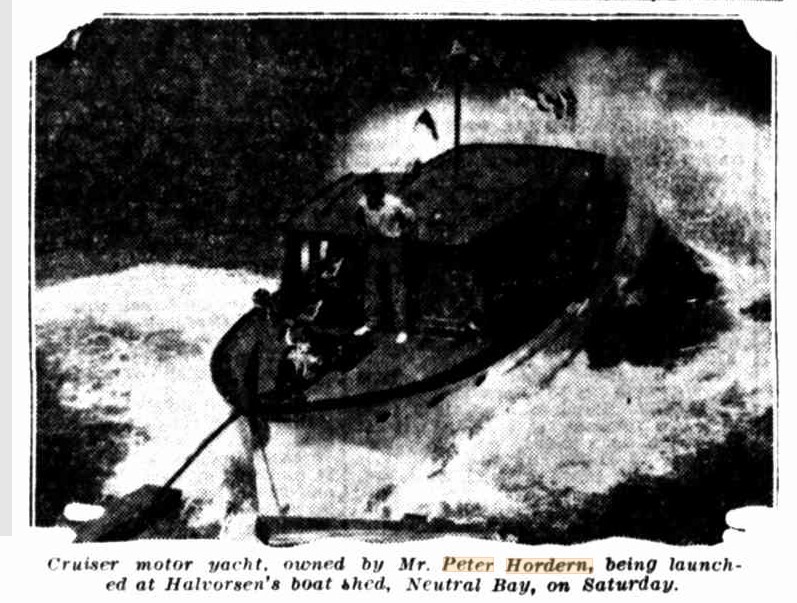
Cruiser motor yacht, owned by Mr. Peter Hordern, being launched at Halvorsen's boat shed, Neutral Bay, on Saturday. No title (1933, September 12). The Newcastle Sun (NSW : 1918 - 1954), p. 4. Retrieved from http://nla.gov.au/nla.news-article165347902 - he had a boat at age 15 (?!)
Alfred Peter Burdett Hordern
Hordern. Gender, M. Age, 22. Decorations. Date of Death, 25-04-1940. Next of Kin, Son of Alfred Roy and Daisy Phyllis Hordern.
Service: Royal Air Force
Service Number : 41418
Aircraft: Handley Page Hampden I
Burial/Memorial Country: United Kingdom
Burial/Memorial Place: Runnymede Memorial
Grave Reference: Panel 8.
Rank Pilot Officer
Unit No. 49 Squadron (RAF)
Date of Death 25 April 1940
Cause of Death Missing
Circumstances: The airplane departed RAF Scampton on operations to the Frisian Islands. While approaching the Sylt Island at night, the airplane was shot down by the pilot of a Me.109 and crashed into the sea. All four crew members were killed.
Crew:
P/O Arthur Herbert Benson, pilot,
P/O Alfred Peter Burdett Hordern, pilot,
Sgt Robert Ian Leonard MacKenzie, observer,
LAC J. D. Openshaw, wireless operator and air gunner.
Probable cause: Shot down by a German fighter. Shot down at 0110hrs in the area of Hörnum/Sylt by Ofw Hermann Förster of 11(N)./JG2 flying a Me 109. Crashed between Hallig Suderoog and Suderoog Sands, off the Schleswig coast, Germany.
The 49th Squadron of UK in its records states:
This would prove to be the squadron's most costly and saddest nights of the war so far; 8 Hampdens fought their way through terrible weather to the now familiar gardening areas in Kiel Bay. Only one aircraft dropped vegetables successfully, the remainder failed due to the bad conditions. Returning home the squadron was diverted to Montrose where 4 aircraft landed and a fifth landed at Leuchars. 3 aircraft and crews were missing. The reason why two of the aircraft failed to return will never be known, but the third gained the unenviable distinction of being the first bomber to be shot down by a German night fighter.
Hampden P1319, flown by P/O Arthur Benson fell victim to Fw Förster, a member of IV[N]/JG.2, the very first German night fighter unit. This unit operated Messerschmitt Bf 109D's which had the cockpit hoods removed. The Hampden came down in the North Sea off Sylt. The body of Sgt Robert Mackenzie was washed ashore on 30 May near Rantum, and now rests in the Kiel War Cemetery; the rest of the crew were never recovered.
Joining Air Force
MR. PETER HORDERN, who will leave in the Mooltan on Saturday to join the Royal Air Force, was the guest of honor at a farewell party at Romano s last night, arranged by Miss Twinkle Blau.
Among those present were Mr. and Mrs. John Ralston, Mr. and Mrs Bruce Hordern, Mr. and Mrs. J. S. Truman, Misses Valmai Arnott, Gwen Pratten, Kathleen Noss, Robin Eakin, Betty Munro, Margaret Phillips, Joyce Lucas, Bee Pvoer, Joan See, Joan Talbot, Messrs; Gilbert Pratten, Dick Coombe, Gordon King, Fenton Braund, Desmond Carr, Bob Swift, Mervyn Scholler, John Suttor; Arthur and Jack Hordern, and Ian Platt-Hepworth. LIFE OF SYDNEY (1938, August 19). The Daily Telegraph (Sydney, NSW : 1931 - 1954), p. 12. Retrieved from http://nla.gov.au/nla.news-article247350063
PROBATE PROBLEM OF MISSING AIR MAN
SYDNEY, Wednesday. -A young Australian airman who flew over the North Sea last year and did not come back has raised a major problem in New South Wales probate jurisdiction. National security regulations are being prepared to remove an obstacle which otherwise may hamper the granting of probate in similar cases. The airman was Alfred Peter Burdett Hordern, of Neutral Bay, who in 1938, at the age of 20, left Australia to join the R.A.F. in England.
Application, the first of its kind here. is being made by his mother, Mrs. Doris Phyllis Truman, of Kurraba Rd. Neutral Bay, for leave to swear to his death. Her affidavit discloses that on Anzac Day, 1940, Hordern went out on patrol duty. A few days later his mother received a cable from the British Air Ministry, "Regret to inform you that your son. Pilot-Officer Hordern, is reported missing as a result of air operations on April 25, 1940. Any further information will be immediately conveyed to you."
Death Presumed
On December 27, 1940, the Air Ministry's letter read, "In view of the lapse of time and the absence of further news, it must regretfully be concluded that he has lost his life. and that his death will be presumed to have occurred on April 25, 1940."
Pilot-Officer Hordern had been receiving an income payable to him under the will of his grandfather, the late Alfred James Hordern, a former city business man. The problem for the probate officials arises from the fact that in New South Wales strong evidence is required before a missing man is presumed dead-evidence that will satisfy a judge beyond reasonable doubt. PROBATE PROBLEM OF MISSING AIRMAN (1941, April 30). News (Adelaide, SA : 1923 - 1954), p. 3. Retrieved from http://nla.gov.au/nla.news-article131967353
PROBATE PROBLEM
AUSTRALIAN AIRMAN WHO FAILED TO RETURN SYDNEY.
Thursday. The New South Wales probate jurisdiction is faced with the problem of deciding whether a young Australian airman who flew over the North Sea last year and did not return may be presumed to be dead. The airman was Alfred Peter Burdett Hordern who, In 1939, at the age of 20 years, left Australia to join the R.A.F. in England.
The British Air Ministry reported that Flying-Officer Hordern was missing as a result of air operations on April 25, 1940, and later announced that his death could be presumed to have occurred on that date. The matter was held over until next week when something definite may be known regarding National Security Act regulations to cover this problem. PROBATE PROBLEM (1941, April 30). Daily Advertiser (Wagga Wagga, NSW : 1911 - 1954), p. 2. Retrieved from http://nla.gov.au/nla.news-article144528611
LEAVE TO SWEAR TO DEATHS OF PILOTS GRANTED
SYDNEY, Monday: — Leave to swear to the deaths of two Australian air pilots who disappeared while on active service was granted to-day in the Probate Court by Mr. justice Nicholas.
The pilots, who it is believed were shot down at sea by enemy gunfire, were Pilot-Officer Alfred Peter Burdett Hordern. formerly of the RAF, and Flight-Lieutenant George John Clarke, of the Fleet Air Arm.
Pilot-Officer Hordern went to England in 1938 and joined the R.A.F. He took part in operations over the North Sea during April 1940, but did not return. Flight-Lieutenant Clarke was formerly employed by W. R. Carpenter and Co. Ltd. as a commercial pilot. He was appointed to the Fleet Air Arm in 1939 and was reported missing on September 25, 1940, from H.M.S. Australia at Dakar. LEAVE TO SWEAR TO DEATHS OF PILOTS GRANTED (1941, May 6). Tweed Daily (Murwillumbah, NSW : 1914 - 1949), p. 5. Retrieved from http://nla.gov.au/nla.news-article192801504
Warrawee’s Marsden Carr Hordern (OKG38) OAM VRD, 102, who began at the School in 1929 and graduated in 1938. Mr Hordern – student 329 – attended Knox alongside brothers Hugh (OKG38) and John (OKG41).
“My cousin Peter Hordern (OKG36) was the first Knox boy killed in active service during the Second World War. War broke out and he went over to Europe and joined the Air Force and was killed.”

Alfred Peter Burdett Hordern Image kindly provided by: Knox Grammar School Archive and Museum, Series 12 – Non-commissioned photographs.
Records show that British-born Pilot Officer Alfred Peter Burdett Hordern was 22 and disappeared, presumed killed, during operations over the North Sea on Anzac Day in 1940, during the Battles of Narvik. From: https://www.knox.nsw.edu.au/centenary/stories/knoxs-oldest-old-boy-marsden-hordern-shares-his-fondest-memories
John Hordern and Anthony Hordern (father) - Family Notes
Anthony HORDERN (parents Unknown) was born in 1788 in Staffordshire England and died on 6 Jun 1869 in Melbourne Colony of Victoria at age 81.
He emigrated in 1825, to the Colony of New South Wales. Sydney Gazette Thu 3 Mar 1825 p. 2 - Text:
The long looked-for Phoenix, Captain Dixon (formerly of the Regalia and Venerable), arrived at Hobart Town on the 26th January....(Steerage)...Mr and Mrs Horsden [sic] and 4 children...
Anthony married Ann WOODHEAD [20134] [MRIN: 8013], daughter of John WOODHEAD [32465] and Unknown, in 1817. Ann was born in 1794 in Retford Nottinghamshire England, died on 18 Jan 1871 in Paddington Colony of New South Wales at age 77, and was buried in St Jude's Randwick Sydney Colony of New South Wales.
Children from this marriage were:
i. Anthony HORDERN [20125] was born in 1819 and died in 1876 in Sydney Colony of New South Wales at age 57.
ii. John HORDERN [32466] was born in 1819 and died in 1864 at age 45.
iii. Elizabeth HORDERN [32467] was born in 1821 and died in 1906 at age 85.
iv. Thomas Gilbert HORDERN [32468] was born in 1823 and died in 1825 at age 2.
v. Lebbeus HORDERN [32469] was born in 1826 in Colony of New South Wales and died in 1881 in Colony of New South Wales at age 55.
vi. Mary Ann HORDERN [32470] was born in 1829 in Colony of New South Wales and died in 1872 at age 43.
vii. William HORDERN [32471] was born in 1831 in Colony of New South Wales and died on 8 Oct 1881 in Hawthorn Melbourne Colony of Victoria at age 50.
viii. James HORDERN [32472] was born in 1833 in Colony of New South Wales and died in 1834 in Colony of New South Wales at age 1.
x. Alfred HORDERN [32473] was born in 1835 in Colony of New South Wales and died in 1836 in Colony of New South Wales at age 1.
x. Edward HORDERN [32474] was born in Jun 1838 and died in 1883 in Sydney Colony of New South Wales at age 45.
November 1828 (aged 40 years) Census:
Hordern, Anthony, 42, came free, Phoenix, 1824, Protestant, coachmaker, Pitt Street Sydney
Hordern, Ann, 38, came free, Phoenix, 1824
Hordern, Anthony, 9, came free, Phoenix, 1824
Hordern, John, 9, came free, Phoenix, 1824
Hordern, Elizabeth, 7, came free, Phoenix, 1824
Hordern, Lebbeus, 2, born in the colony
John HORDERN was born in 1819 and died in 1864 at age 45. John married Rebecca CARR [32479] [MRIN: 12037], daughter of John CARR [36420] and Ann [36421], in 1845 in St Andrew's Sydney Colony of New South Wales. Rebecca was born in 1827 and died in 1875 in Newtown Sydney Colony of New South Wales at age 48.
Children from this marriage were:
i. John Lebbeus HORDERN [36422] was born in 1848 and died in 1910 at age 62.
ii. William C HORDERN [36423] was born in February 1850 .
iii. Edward Carr HORDERN [32480] was born in 1853 and died in 1940 in Chatswood Sydney NSW Australia at age 87.
iv. Eda Rebecca HORDERN [36424] was born in 1856 and died in 1922 in Hornsby Sydney NSW Australia at age 66.
v. Alfred James HORDERN [32481] was born in 1859 in Glebe Sydney Colony of New South Wales and died in 1932 in Hornsby Sydney NSW Australia at age 73.
Empire (Sydney) Tue 29 Mar 1864 p. 4 - Text:
An inquest on the body of the late Mr. John Hordern was held before the City Coroner yesterday. The deceased was married, and 41 years of age. He was in independent circumstances, and lived at O'Connell Town. For several months his mind had been impaired, and his friends had him placed in the private asylum at Regentville. A short time ago it was thought that he was sufficiently recovered, and he was taken home.
On Thursday last he laboured under nervous excitement, and during the last few days stopped at the house of his brother, Mr Lebbius Hordern. On Sunday he appeared quite rational at the breakfast table, and afterwards he was accompanied by his brother to a front room, where he shaved himself. After doing so, he closed the razor, and walked with it in his hand into the back room. He was there scarcely a moment, when he drew the razor across his throat, inflicting a frightful gash.
Mr. Lebbeus Hordern hearing a splashing noise in the room, ran in and saw what had occurred. Dr. Eichler was called in at once, and Drs. Bland and Warren were subsequently in attendance. Dr. Eichler, on examining deceased's throat, found two distinct wounds on both sides, severing the windpipe, gullet and several arteries. He united both superficially, and kept the wound open as much as he could to allow breathing. One of the small arteries commenced suddenly to bleed again, when the blood ran into the windpipe, and before he could secure it suffocation took place, such being the immediate cause of death. Had the sudden resurgence of the bleeding not taken place his life might have been saved. Verdict "Committed suicide by cutting his throat with a razor while labouring under a fit of temporary insanity.
Another account:
Distressing Suicide. — Yesterday Mr. John Hordern, of Newtown, died at the drapery establishment of his brothers — Messrs L. and E. Hordern, Brickfield-hill — under circumstances of a very distressing nature. About a quarter to eleven o'clock yesterday morning, Mr. L. Hordern's attention was arrested by his hearing a noise coming from his bedroom in which his brother was, and on going there he was horrified to find him laying on the floor weltering in his blood. When Mr. Hordern had recovered from the consternation into which he had been thrown, he sent for medical aid, and in the absence of Dr M'Phee, who lives next door, a gentleman from his dispensary at once repaired to the room. The deceased had cut his throat with a razor,- which was lying near. Mr. Hordern, who was not unconscious, was placed on a bed, and in a short time Drs. O'Brien, Bland, and Eichler, who had been sent for, were in attendance. To avert the fatal effect of the wound was seen to be impossible, but all that could be done to prolong life and afford relief to the sufferer was effected. The deceased lingered until half-past two o'clock p.m., when he expired. — Herald, March 28, 1864
CORONER'S INQUESTS.
Coroner's Inquest. — The City Coroner, held an inquest at the Crown Inn, Brickfield-Hill, on Monday, respecting the death of Mr. John Hordern, which occurred on Sunday afternoon. The particulars of this deplored incident were these : — About eleven o clock on the morning of the 27th ultimo, Mr. L. Hordern’s attention was arrested by his hearing a confused noise coming from the bedroom in which his deceased brother was, and on entering, it was found that the deceased had cut his throat with a razor, which was lying near. Mr, Hordern, who was not unconscious, was placed on a bed, and in a short time Drs. O'Brien, Bland, M'Fhee, and Eichler, who had been sent for, were in attendance. To avert the fatal effect of the wound was seen to be impossible, but all that could be done to prolong life and afford relief to the sufferer was effected. The deceased lingered until half-past two o'clock when he expired. The jury found that the deceased, aged forty-four years, committed suicide by cutting his throat on the 27th March, whilst labouring from a fit of temporary insanity.' CORONER'S INQUESTS. (1864, April 2). Sydney Mail (NSW : 1860 - 1871), p. 3. Retrieved from http://nla.gov.au/nla.news-article166654813
MARRIAGE.
HORDERN—BULL.—On the 12th instant, by special license, at Christ Church, by the Rev. Canon Walsh, M.A., Anthony, eldest son of Mr. Anthony Hordern, junior, of George-street, Sydney, and the eldest grandson of Anthony Hordern, senior, esq. of Russell-street, Melbourne, Victoria, to Elizabeth Mary, fourth daughter of John Bull, Esq., of Liverpool, New South Wales. Family Notices (1864, October 14). Empire (Sydney, NSW : 1850 - 1875), p. 1. Retrieved from http://nla.gov.au/nla.news-article60560797
FUNERAL.—The Friends of Mr. EDWARD HORDERN (Draper), are respectfully invited to attend the funeral of his late beloved WIFE, EMILY JANE ; to move from his residence, No. 674, George-street South, THIS (Thursday) AFTERNOON, at half-past two o'clock precisely. JOHN HILL and CO., Undertakers, King and Riley streets. Family Notices (1865, December 21). The Sydney Morning Herald (NSW : 1842 - 1954), p. 16. Retrieved from http://nla.gov.au/nla.news-article13123584
DEATH. HORDERN— July 15, at her residence, Kingston, Newtown, Rebecca, relict of the late Mr. John Hordern, aged 48 years. Family Notices (1875, July 16). Evening News (Sydney, NSW : 1869 - 1931), p. 2. Retrieved from http://nla.gov.au/nla.news-article130497047
In the Supreme Court of New South Wales.
ECCLESIASTICAL JURISDICTION.
In the goods, chattels, credits, estate, and effects of Rebecca Hordern, late of Albermarle-street, Newtown, near Sydney, in the Colony of New South Wales, widow, deceased.
NOTICE is hereby given, that after the expiration of fourteen days from the publication hereof, application will be made to this Honorable Court, in its Ecclesiastical Jurisdiction, that administration of all the goods, chattels, credits, estate, and effects of the abovenamed Rebecca Hordern, deceased, may be granted to John Lebbeus Hordern and Edward Carr Hordern, the eldest and second sons of the abovenamed deceased.—Dated this 20th day of January, a.d. 1876.
PIGOTT & TRICKETT,
Proctors for the Administrators, 129, King-street, Sydney. 388 6s. 6d. ECCLESIASTICAL JURISDICTION. (1876, January 21). New South Wales Government Gazette (Sydney, NSW : 1832 - 1900), p. 261. Retrieved from http://nla.gov.au/nla.news-article223644834
DEATHS.
On the 9th instant, at his residence, Russell-street, Melbourne, Mr. Anthony Hordern, senior, aged 80 years. The deceased was the beloved father of Messrs. Anthony, Lebbeus, and Edward Hordern, and Mrs. Robert Clowes, of this city. Family Notices (1869, June 12). Empire (Sydney, NSW : 1850 - 1875), p. 1. Retrieved from http://nla.gov.au/nla.news-article60835468
HORDERN.—On the 9th June, at his late residence, No. 86 Russell-street, Mr Anthony Hordern, aged eighty years ; father of Mr Wm. Hordern, of this city, and of the Messrs Hordern Brothers, of Sydney, N. S. Wales. Family Notices (1869, June 11). The Age (Melbourne, Vic. : 1854 - 1954), p. 2. Retrieved from http://nla.gov.au/nla.news-article188573730
THE Friends of the late Mr. ANTHONY HORDERN, Senr., are respectfully invited to follow his remains to the place of interment, Melbourne General Cemetery. The funeral to leave his late residence, 86 Russell-street, Melbourne, on SATURDAY, the 12th inst., at two o'clock p.m. JOHN SLEIGHT, Undertaker, 83 Collins-street east. Family Notices (1869, June 11). The Age (Melbourne, Vic. : 1854 - 1954), p. 1. Retrieved from http://nla.gov.au/nla.news-article188573738
William Hordern, the brother that moved to Melbourne, had married a Cicecila Monger. He passed away in 1881.
THE Friends of the late Mr. WILLIAM HORDERN are respectfully invited to follow his remains to their last resting-place, in the Boroondara general cemetery, Kew. Friends will please meet at the Wesleyan Church, Burwood-road, Hawthorn, THIS DAY, Monday, the 10th inst., at half-past Two O'Clock, when, after the usual service has been conducted by the Rev. Mr. Fitchett, the procession will form and proceed to the cemetery. WILLIAM GEORGE RAVEN, undertaker, Nos. 203 and 205 Smith street, Fitzroy. Family Notices (1881, October 10). The Argus (Melbourne, Vic. : 1848 - 1957), p. 8. Retrieved from http://nla.gov.au/nla.news-article5985476
HORDERN.—On the 1st inst., at Naples, on his way to Australia, Lebbeus, third son of the late Anthony Hordern, sen., and brother of the late William Hordern of this city, aged 55 years. Family Notices (1881, November 19). The Argus (Melbourne, Vic. : 1848 - 1957), p. 1. Retrieved from http://nla.gov.au/nla.news-article11524342
Marriages.
HORDERN — SMITH. — On the 25th May, at Saint Barnabas's Church, Balwyn, by the Rev. H. F. Tucker, at Christ Church, South Yarra, assisted by the Rev. H. E. Taylor, incumbent of the church, Sebbeus, second son of the late William Hordern, of Stromshall, Upper Hawthorn, to Louie Dewson, second daughter of B. Doughty Smith, of Noorong, Surrey Hills. Family Notices (1887, May 31). The Age (Melbourne, Vic. : 1854 - 1954), p. 1. Retrieved from http://nla.gov.au/nla.news-article190637571
Edward Hordern.
The establishment of Mr. Edward Hordern, 668 and 670 Brickfield Hill, George-street, Sydney, is one of the oldest businesses in the Australian colonies, being founded in the year 1823, and continued with success ever since that date. A glance at the price-list of this firm in itself will satisfy intending customers of what bargains may be made there, and also of the quality of the goods offered. The Manchester department contains all kinds of sheetings, pillow cottons, calicoes, towel lings, curtains, flannels, blankets, shirting, quilts, prints, &e., and the clothing department is filled to repletion with monks tailor-made suits In tweeds, serges and other material, trousers of every kind, boys and youths clothes, sailor and knicker suits, over coats and many other lines. The mercery department has a huge catalogue all to itself, and the ladies will find that every value Is to be obtained from the department set aside for them to visit. The hosiery and fancy departments, haberdashery,- dress, silk, and miscellaneous departments all have a great store of good things, and amongst their specialties are ladies' alpaca and pique skirts, washing blouses, dress holland skirts, and gloves. And all on a scale of extended liberality good enough to suit the most fastidious. Edward Hordern. (1898, December 17). The Australian Star (Sydney, NSW : 1887 - 1909), p. 10. Retrieved from http://nla.gov.au/nla.news-article228454182
DEATH OF MR. J. L. HORDERN.
THROWN FROM A HORSE.
Mr. J. L. Hordern, senior partner of the firm of Hordern Brothers, Pitt-street, Sydney, died in Auckland on Wednesday night. Mr. Hordern was in New Zealand on a holiday. When at Auckland, on his way back to Sydney, he was thrown from a horse, and while he was lying up as a result of this accident pneumonia supervened. Mr. E. Carr Hordern, his brother, left Sydney for Auckland on Saturday in order to see him. The business of Hordern Brothers, in Pitt-street, was closed yesterday.
Mr. John Lebbeus Hordern was a native of Sydney. He was about 60 years of age, and was the eldest son of John Hordern, who was a twin brother of the late Mr. Anthony Hordern, and one of the original members of the Hordern family in Australia, and who in the early days kept a shop at the corner of Charlotte-place and George-street. Mr. J. L. Hordorn, his son, was founder of Hordern Brothers' business in Pitt-street. He is a brother of Mr. E. Carr Hordern and Mr. Alfred J. Hordern, the other partners in the firm of Hordern Brothers, and a cousin ot the late Mr. Samuel Hordern. He had one unmarried sister.
Mr. Hordern was one of the trustees of the Master Retailers' Association. At the meeting of the council of the association yesterday a resolution was passed expressing sympathy with his firm and his relatives, and recording appreciation of his services to the association since it was started. DEATH OF ME. J. L. HORDERN. (1910, February 25). The Sydney Morning Herald (NSW : 1842 - 1954), p. 6. Retrieved from http://nla.gov.au/nla.news-article15149484
DEATH OF MR. J. L. HORDERN.
Mr. J. L Hordern, of Hordern Bros., died on Wednesday in New Zealand from pneumonia, aged 60. Deceased was travelling for the benefit of his health, and a short time ago had both legs broken at Auckland through a horse falling on him. Pneumonia supervened. DEATH OF MR. J. L. HORDERN. (1910, February 26). Dubbo Dispatch and Wellington Independent (NSW : 1887 - 1932), p. 4. Retrieved from http://nla.gov.au/nla.news-article228549227
FUNERAL OF MR. J. L HORDERN
The funeral of the late John Lebbeus Hordern took place on Saturday morning, leaving the residence of his brother, at Chatswood, for Gore Hill Cemetery. The chief mourners were his two brothers, Messrs. Edward Carr Hordern and Alfred James Hordern and his sister Miss Hordern. The officiating clergyman was Rev. H. G. J. Howe. The funeral was of an entirely private character, only his immediate relatives and some of the older employees of the firm of Hordern Brothers being present. Mr. Hordern died at Auckland on February 23, aged 61, of pneumonia and heart failure, while on a holiday trip in New Zealand. His body was brought back by the steamer Maheno, arriving on Friday last. FUNERAL OF MR. J. L HORDERN (1910, March 7). Evening News (Sydney, NSW : 1869 - 1931), p. 8. Retrieved from http://nla.gov.au/nla.news-article116054764
MR.. J. L. HORDERN LEAVES £74,615.
Probate has been granted in respect of the estate of the late Mr. John Lebbcuo Hordern, of the firm of Messrs. Hordern Bros., of Pitt-street, Sydney, who died at Auckland (N.Z.) on February 23. The net- value of- the estate was sworn at £74 615 7s 10d. of which £19,016 13s 4d represented real estate. MR. J. L. HORDERN LEAVES £74,615. (1910, May 29). Sunday Times (Sydney, NSW : 1895 - 1930), p. 12. Retrieved from http://nla.gov.au/nla.news-article123826516
THE LATE MR. J. L. HORDERN.
VALUE OF ESTATE, £74,615.
Probate has been granted In respect of the estate of the late Mr. John Lebbeus Hordern, of the Arm of Messrs. Hordern Bros., of Pitt-street, Sydney; who died at Auckland (N.Z.) on February 23. The net value of the estate was sworn at £74,01G 7s 10d', of which £19,060 i3s is represented real estate.
The will was executed on October 23, 1908. Edward Carr Hordern and Alfred James Hordern, brothers, and Eda Rebecca Hordern, sister of the testator, were appointed trustees and executors. They were em-powered under' the will to sell, call In, and convert Into cash the real estate whenever thought fit. The will stated that it would be lawful-for the trustees to concur in winding up the business of Hordern Bros., subject to the terms of the partnership; or, if desirable to enter into any new arrangement respecting-the business. In the event of the former, or the disposal of the testator's interest, the trustees were directed to make such arrangements as might be deemed desirable. They were directed to stand possessed of the moneys arising from the estate, and to hold them upon trust as to three equal one-sixth parts for Edward Carr Hordern absolutely; is to two equal one-sixth parts for Alfred James Hordern absolutely; and as to the remaining one-sixth for his sister, E. R. Hordern. As to the latter, it was directed that she should receive the Income of her portion for life, and after her death, the capital as well as the Interest to pass to her children. In the event of her dying with-out Issue the share-to be divided between E. C. and. A. J. Hordern in equal parts. THE LATE MR. J. L. HORDERN. (1910, May 28). The Sydney Morning Herald (NSW : 1842 - 1954), p. 13. Retrieved from http://nla.gov.au/nla.news-article28142838
Scots Church - Melbourne
The Reverend James Forbes was recruited to come to Australia as a Presbyterian minister by the Rev. John Dunmore Lang, arriving in Melbourne from Sydney via boat on 20 January 1838. He found that a retired Church of Scotland minister, the Rev. James Clow, had arrived on 25 December 1837 and had commenced an afternoon service from 2 pm and 4 pm according to Presbyterian forms in a basic building constructed west of William Street and north of Little Collins Street. Clow had been a Church of Scotland chaplain in Bombay, India but had retired and was of independent means. He had intended to settle in South Australia but when he stopped en route in Hobart the positive reports about Port Phillip led him to visit the Port Phillip District in October 1837 and then settle permanently.
On 3 February 1838 a meeting of members and friends of the Church of Scotland was held with James Clow in the chair. It was resolved to build a church and that £300 be raised in order to obtain the matching grant available under the Church Act. This is regarded as the official birthday of Presbyterianism in Victoria and of the foundation of the Scots' Church. A committee of James Clow (treasurer), James Forbes and Skene Graig (secretaries) was appointed to collect subscriptions and to take the steps to obtain a church site. The sum of £139.19.0 was subscribed on the spot.
The Scots' Church secured a 2.0-acre (8,100 m2) site on the corner of Collins and Russell streets as a government grant. When the site was allocated, the elders objected that it was "too far out of town". The foundation stone of the first purpose built church building was laid on 22 January 1841 and the church was opened on 3 October 1841. It was designed to seat 500 and the contract sum was £2,485 without plastering, gallery, vestry or fittings. The building was opened with temporary seating. Plastering was carried out the following year, proper pews, gallery and vestry were added in 1849 and a spire some years later.
The first church building was demolished partly because of concerns that the tower and spire would collapse after it developed huge cracks and became crooked. During the ministry of the Revd Peter Menzies (1868–74) the building was too small for the congregation but, in any case, a building more suited to the site and the social position of the congregation was considered appropriate.
Dillingham Ranch: North Shore, Waialua, Hawaii, United States of America
This naturally peaceful 2,700 acre property on the sunny North Shore of Oahu is a private working cattle ranch, equestrian center (and former polo fields) and agricultural gem. Wild peacocks and a variety of native Hawaiian birds wander among exotic fauna such as mango, monkeypod, citrus, macadamia nut and coconut groves.
The Estate House boasts a 3,000 square foot dining room with a stonewall fireplace, hardwood floors, high ceiling beams, lovely French doors and statuesque pillars. Your eye rests upon lush groves and lawns up to the beautiful Waianae mountain range and the sky beyond. Attached to the main house is a state of the art 700 square foot professional grade kitchen with a separate vendor entrance. Different ceremony sites surrounding the eight-room house offer options such as the Central Courtyard, the Hundred Year Old Banyan Trees, and the Avenue of Royal Palms, but other photo and ceremony options on the sprawling property include Dillingham Lake, the Cross Country Course, and the largest Coconut Grove in Hawaii.
The prominent Dillingham family originally built the Estate House in 1917 as their private summer retreat, and for many generations the house has welcomed people through her doors and surrounded her guests with natural beauty. Recently renovated and restored back the original period condition, she keeps the old Hawaii feel and charm alive. Come discover Dillingham Ranch, Oahu's hidden gem.
From: Dillingham plantation residence Oahu, Hawaii from www.venuereport.com
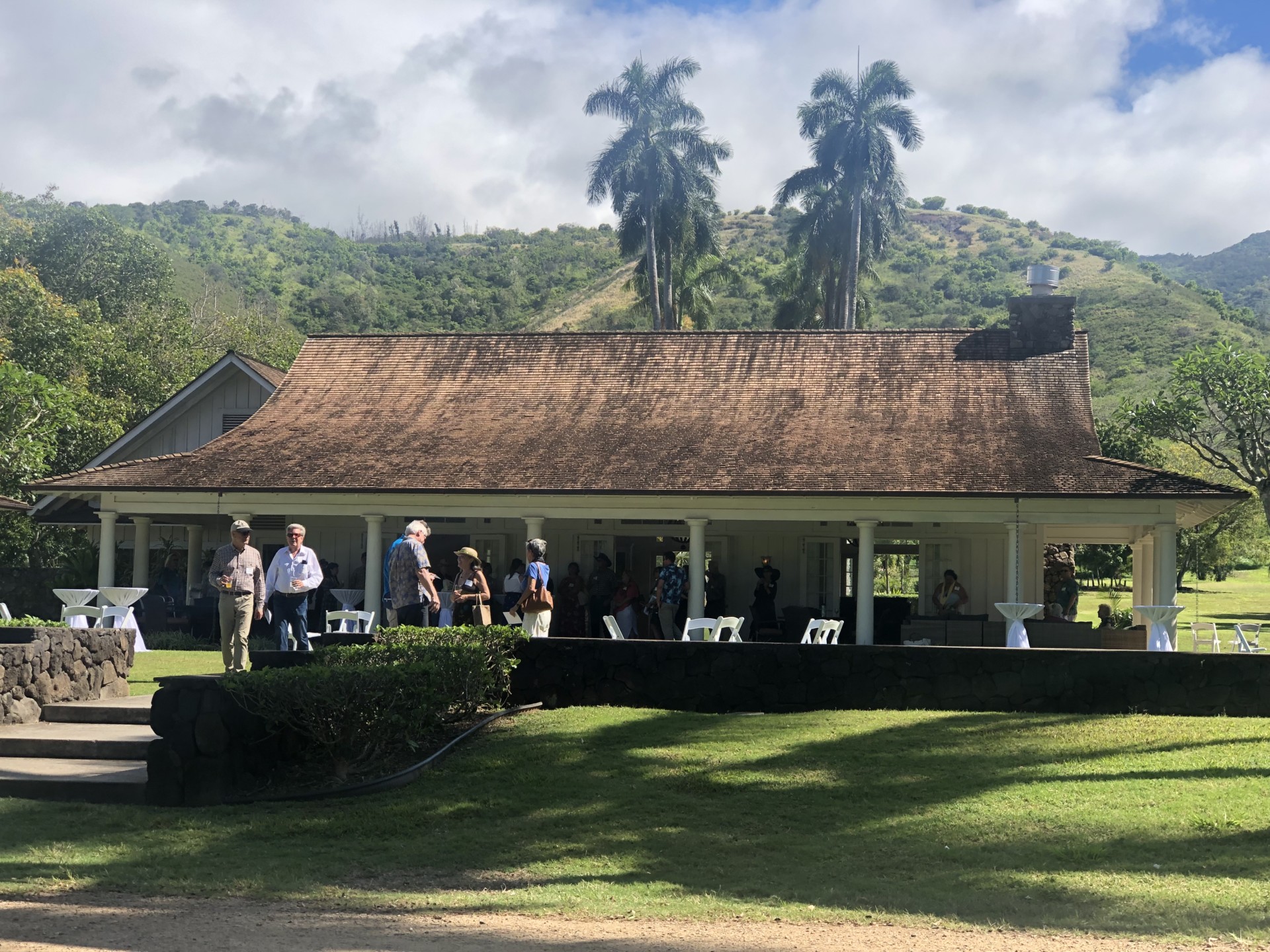
Dillngham home from and courtesy Historic Hawai‘i Foundation.- picture taken Saturday, May 11 2019 at historic Dillingham Ranch Open House to raise funds for the Foundation - retrieved from (more photos): https://historichawaii.org/2019/04/15/dillinghamranchopenhouse/#
Walter Francis Dillingham (April 5, 1875 – October 22, 1963) called the Baron of Hawaii Industry, was an industrialist and businessman from Honolulu, Hawaii. He gained favours from Hawaii politicians to develop urban Honolulu.
.jpg?timestamp=1706830595879)
Dillingham was born in Honolulu, in the Kingdom of Hawaii. His father was Benjamin Dillingham who founded the Oahu Railway and Land Company. His mother was Emma Louise Smith, daughter of missionary Lowell Smith. In 1889 he moved to the United States to attend school in Auburndale, Massachusetts, and then Harvard University 1898–1900. He first worked as a clerk for his father, and then managed the Dowsett Company and founded Hawaiian Dredging Company. In 1904 his father was hospitalized and he managed the OR&L. From 1907–1913, the Governor of the Territory of Hawaii was Walter F. Frear who was married to Dillingham's sister Mary Emma.
In 1909 he constructed a dry dock at Pearl Harbor which eventually became part of the US Navy base. He also enlarged the ports of Kahului and Hilo.
On May 2, 1910 he married Louise Olga Gaylord in Florence, Italy. After his father died in 1918, he and his brother Harold Garfield Dillingham inherited the family businesses. During World War I he worked for the US Army Motor Transport Corps in Washington, DC.
Dillingham served on several commissions for the Territory of Hawaii, including the tax appeal court 1908–1910.
In 1919, Dillingham built a large house at Papaʻenaʻena, an ancient Hawaiian altar to the surf and place of human sacrifice to the god Kūkaʻilimoku, on the slopes of Diamond Head. The home, called La Pietra, is now a private academy for girls. It was named after the estate of his wife's relatives where they were married, Villa La Pietra.
Dillingham drained the wetlands of Waikīkī in the early 1920s and created the Ala Wai Canal, on whose banks the Hawaiʻi Convention Center was built. He helped suppress Japanese Hawaiian plantation workers' calls for better labor conditions during the Oahu Sugar Strike of 1920, as chair of the Hawaii Emergency Labor Commission. The Hawaiian Sugar Planters' Association-sponsored commission petitioned the U.S. Senate to lift an 1882 ban on importing workers from China, hoping to use Chinese migrant laborers to replace the Japanese and break the strike.
HAWAII.
NEW YORK, June 7.
The Washington correspondent of the 'Saw Talk Tides' states that Mr. Harry Baldwin, the new Hawaiian delegate to Congress, in testifying before the Senate Committee of Labour, said that the American control of Hawaii was measured as a result of the ever-increasing Japanese population, which already constituted forty-three per cent of the entire population. Mr- Baldwin urged the passage of the joint resolution introduced, by Senator Dillingham, giving the President power to suspend the Chinese immigration restriction in Hawaii for five years in order to secure a balance. HAWAII. (1922, June 17). The Capricornian (Rockhampton, Qld. : 1875 - 1929), p. 8. Retrieved from http://nla.gov.au/nla.news-article71950847
Dillingham is also seen as controversial for comments which by today's standards would be considered racist after the Massie Trial of 1933, which resulted in the killing of a native Hawaiian and the beating of a Japanese Hawaiian by a mob of angry (and never-prosecuted) whites.
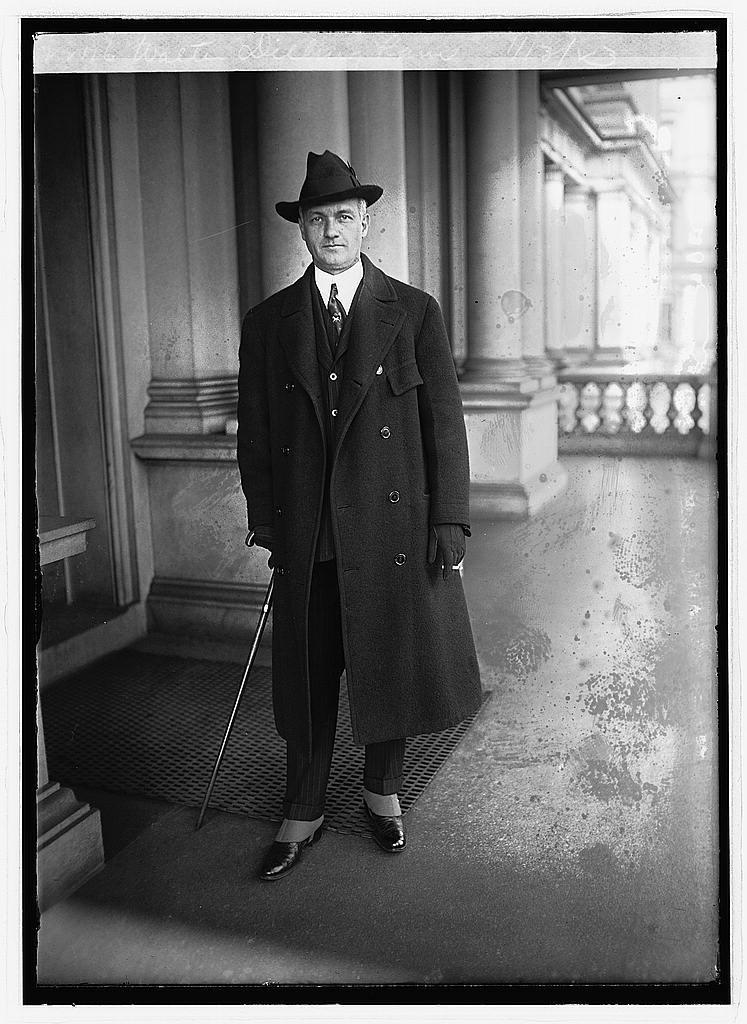
Walter Dillingham, 1/13/23, Digital ID: (digital file from original) npcc 23757 http://hdl.loc.gov/loc.pnp/npcc.23757. Reproduction Number: LC-DIG-npcc-23757 (digital file from original). Repository: Library of Congress Prints and Photographs Division Washington, D.C. 20540 USA http://hdl.loc.gov/loc.pnp/pp.print - with thanks.
In 1948, Dillingham Airfield, a small Air Force base near Mokulēʻia, Hawaii was named for his son Captain Henry Gaylord Dillingham, a B-29 pilot who was killed in action over Kawasaki, Japan on July 25, 1945.
His son Benjamin Franklin Dillingham II (1916–1998) ran with the Hawaii Republican Party against Daniel Inouye for the Senate in 1962 and lieutenant governor in 1974 but lost both elections. The other Senator from Hawaii, Hiram Fong, gave the eulogy at his funeral after his death October 22, 1963. Fong said he lived a life that spanned the full spectrum of Hawaiian history". Dillingham is buried at the Valley of the Temples Memorial Park in Kāneʻohe.
In 1961, his son Lowell Smith Dillingham (1911–1987) merged the remains of the Oahu Railway and Land Company and the Hawaiian Dredging and Construction Company to form the Dillingham Corporation. It was sold to private investors in 1983 for $347 million.
A daughter Elizabeth Dillingham (1921–2011) married investment banker Myron Arms Wick Jr. (1915—1990) in 1940.
There is an Australian connection and a Hordern family connection through the passion for polo:
Australian Polo Team in Hawaii.
HONOLULU. 4th December.
The Australian and Hawaiian polo players will leave Honolulu on 6th January to enter tournaments at Los Angeles, Santa Barbara, Delmonte and San Mateo. The team comprises Messrs. Pearson, Skene and Beveridge (Australia), Edwin Baldwin and Walter Dillingham (Hawaii) under Mr. Skene's captaincy. Mr. Skene declares that this is the best mounted team known on the Pacific coast in years. They were taking fifty ponies, which were the best he had ever seen. Mr. Pearson said the team hoped to have good luck on the Pacific coast. Australian Polo Team in Hawaii. (1928, December 6). The Age (Melbourne, Vic. : 1854 - 1954), p. 6. Retrieved from http://nla.gov.au/nla.news-article204248238
POLO IN U.S. A
AUSTRALIANS - BEATEN Captain Pearson Unlucky
A San Francisco message states that the Australians were again beaten in the Pacific Coast Championship , series. The winners — Eastcott team —scored 15 goals to 10, Captain Pearson, of the Australian team, had bad luck. He had a severe fall in the course of the play, and fractured his collarbone.
The Midwick team, which had defeated Australia-Hawaii in the first match by 11 to 10, scored a similar victory over the Greentrees team in the semi-final of the championship. The first game in which the visitors took part is said to have been one of the most fiercely contested ever seen on the Pacific Coast.
The Midwick team, which had defeated Australia-Hawaii by 11 goals to 10, an extra having to be played to decide the issue, met the San Carlos team in the final of the Pacific Coast championship. After a good game, San Carlos defeated- Midwick by seven goals to five.
VICTORIAN TOURNAMENT. The Moonee Valley Polo Club is holding a' tournament from February 25 to March l. A number of well-known N.S. Wales players are reported to be going to Victoria for the fixture. Messrs. G. Foster, D. H. G. Munro, D. G. Munro. and T. F. Ross will make a team from this State. Ross (Harden) is a champion polo player, and the others (who are attached to the Inverell Club are also rapidly improving exponents of the game.
THE WANDERERS. It is reported that the Wanderers' team; which is captained by A. Hordern, will have a changed line-up this season. H. C.# Osborne; of the Sydney Club, will play in the No. 3 position' instead of Ranald Munro, who is abroad. The ex-Glen Innes Club players, Rex White Mid Go!. Fred. J. . White, will be in the No. 1 and No. 2 positions, respectively, while Hordern will play back.
AUSTRALIANS BEAT EASTCOTT. -A New York cable states that the Australian-Hawaii team on Monday defeated Eastcott at Delmonte. It was a one-sided display, and the visitors won by 13 goals to 4. Pearson and Dillingham were in the team again, but were not seen to much advantage. Skene and Baldwin, however, were in great form, and scored 11 goals between them and 7, respectively. The teamwork of the Australians was superb, and in this department they completely outclassed their opponents. POLO IN U.S.A. (1929, February 20). Referee (Sydney, NSW : 1886 - 1939), p. 16. Retrieved from http://nla.gov.au/nla.news-article136214087
AUSTRALIAN POLO PLAYERS IN CALIFORNIA.
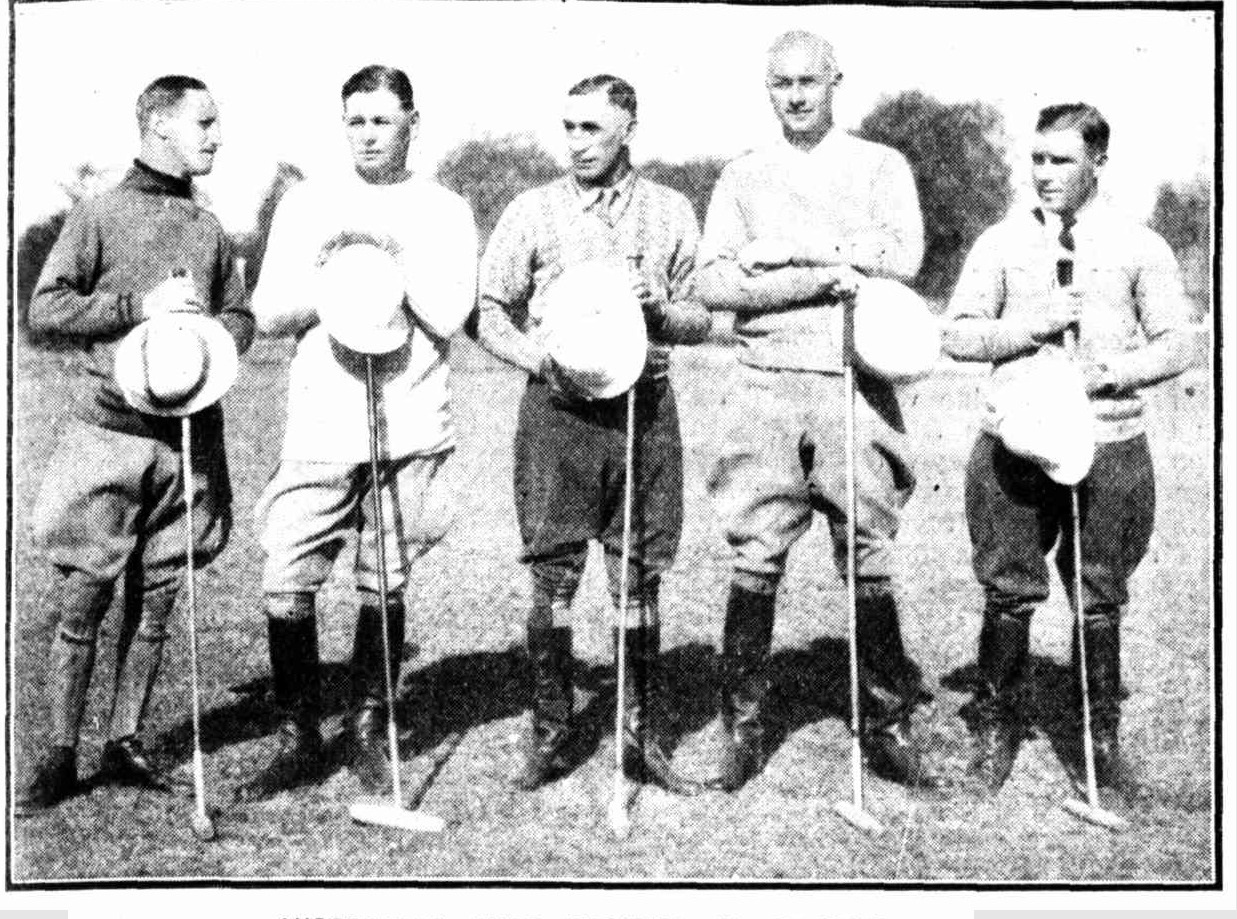
The Australian-Hawaii polo team which combined at Honolulu at the end of last year to play in tournaments at various places in California. A photo at the Midwick Country Club, Los Angeles. Reading from the Left : Capt. Stuart Pearson, Edward Baldwin (Hawaii), Curtis Skene, Walter Dillingham (Hawaii), and Fred Beveridge. AUSTRALIAN POLO PLAYERS IN CALIFORNIA. (1929, April 10). Sydney Mail (NSW : 1912 - 1938), p. 11. Retrieved from http://nla.gov.au/nla.news-article166259805
HAWAII AFFAIRS.
NEW STEAMER LINE.
LONDON, March 1.—The United States Senate has decided not to hold an executive session with the view of dealing with the question of the annexation of Hawaii.
The treaty presented to Congress by President Harrison, recommending the annexation of the islands, has therefore virtually been shelved.
LONDON, March 3.—Owing to the directly conflicting interests of shipowners and shippers, little progress is being made at the Bills of Lading Conference.
LONDON, March 3.—Princess Kaiulani, niece of the deposed Queen Lilioukalani and heiress to the throne of Hawaii, has made a fresh appeal to the United States not to deprive her of her right of succession by annexation. CABLE MESSAGES. Miscellaneous. (1893, March 11). Australian Town and Country Journal (Sydney, NSW : 1870 - 1919), p. 11. Retrieved from http://nla.gov.au/nla.news-article71196356
Liliʻuokalani (Hawaiian pronunciation: [liˌliʔuokəˈlɐni]; Lydia Liliʻu Loloku Walania Kamakaʻeha; September 2, 1838 – November 11, 1917) was the only queen regnant and the last sovereign monarch of the Hawaiian Kingdom, ruling from January 29, 1891, until the overthrow of the Hawaiian Kingdom on January 17, 1893. The composer of "Aloha ʻOe" and numerous other works, she wrote her autobiography Hawaiʻi's Story by Hawaiʻi's Queen during her imprisonment following the overthrow.
Liliʻuokalani was born in 1838 in Honolulu, on the island of Oʻahu. While her natural parents were Analea Keohokālole and Caesar Kapaʻakea, she was hānai (informally adopted) at birth by Abner Pākī and Laura Kōnia and raised with their daughter Bernice Pauahi Bishop. Baptized as a Christian and educated at the Royal School, she and her siblings and cousins were proclaimed eligible for the throne by King Kamehameha III. She was married to American-born John Owen Dominis, who later became the Governor of Oʻahu. The couple had no biological children but adopted several. After the accession of her brother David Kalākaua to the throne in 1874, she and her siblings were given Western style titles of Prince and Princess. In 1877, after her younger brother Leleiohoku II's death, she was proclaimed as heir apparent to the throne. During the Golden Jubilee of Queen Victoria, she represented her brother as an official envoy to the United Kingdom.
Liliʻuokalani ascended to the throne on January 29, 1891, nine days after her brother's death. During her reign, she attempted to draft a new constitution which would restore the power of the monarchy and the voting rights of the economically disenfranchised. Threatened by her attempts to abrogate the Bayonet Constitution, pro-American elements in Hawaiʻi overthrew the monarchy on January 17, 1893. The overthrow was bolstered by the landing of US Marines under John L. Stevens to protect American interests, which rendered the monarchy unable to protect itself.
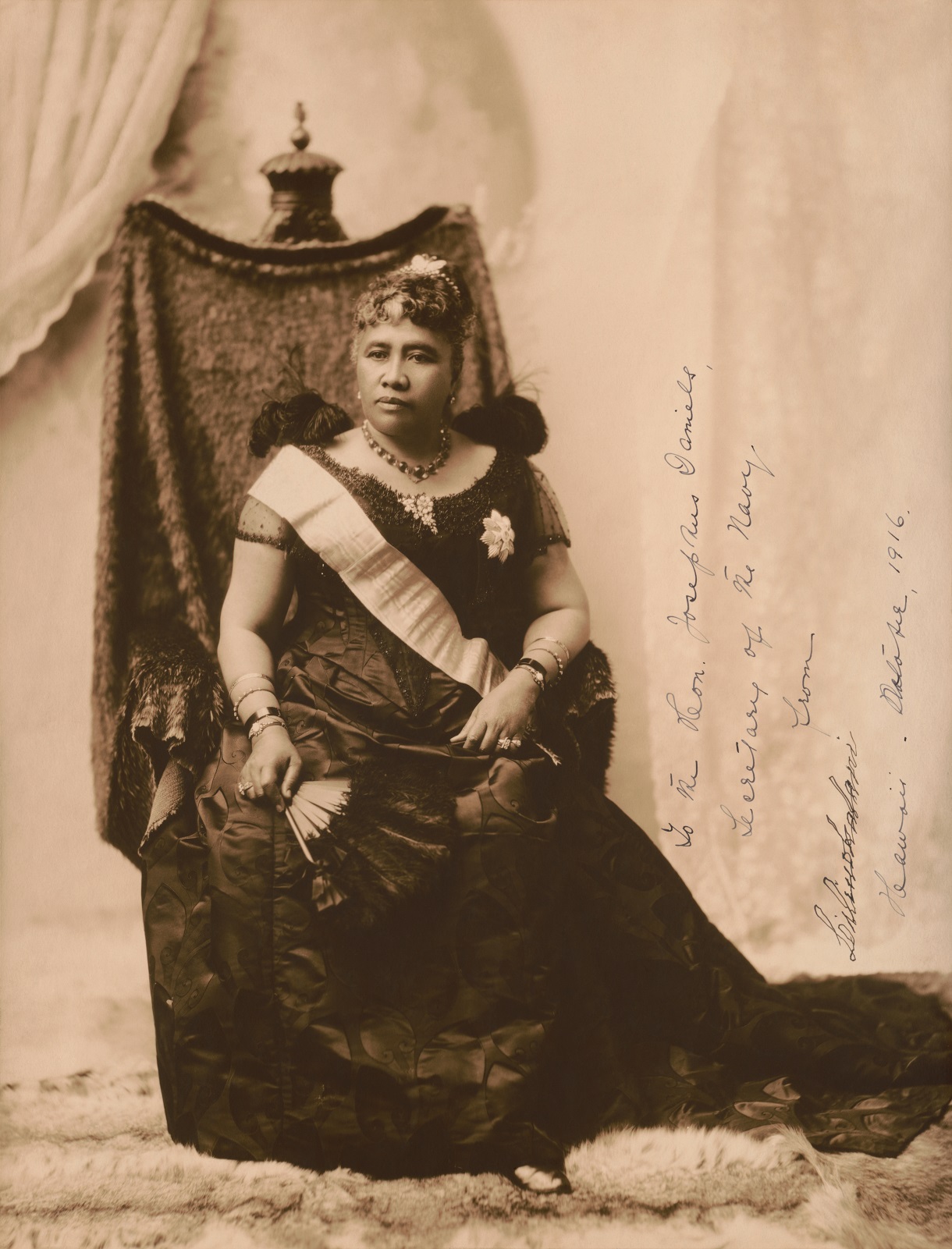
Signed photograph of Liliuokalani, the last sovereign of the Hawaiian kingdom. Notation on recto: "To the Hon. Josephus Daniels, Secretary of the Navy, from Liliuokalani, Hawaii, October 1916." photo by James J. Williams - taken in circa 1891. This image is available from the United States Library of Congress's Prints and Photographs division under the digital ID ppmsca.53150.
The coup d'état established the Republic of Hawaiʻi, but the ultimate goal was the annexation of the islands to the United States, which was temporarily blocked by President Grover Cleveland. After an unsuccessful uprising to restore the monarchy, the oligarchical government placed the former queen under house arrest at the ʻIolani Palace. On January 24, 1895, Liliʻuokalani was forced to abdicate the Hawaiian throne, officially ending the deposed monarchy. Attempts were made to restore the monarchy and oppose annexation, but with the outbreak of the Spanish–American War, the United States annexed Hawaiʻi. Living out the remainder of her later life as a private citizen, Liliʻuokalani died at her residence, Washington Place, in Honolulu in 1917. From Wikipedia
TOADS FROM HAWAII.
Importation Prohibited.
RIVAL CANE BEETLES AS PESTS.
CANBERRA, November 29.
Fears that Australia might be overrun by giant toads have resulted in the prohibition of the importation of toads from Hawaii intended by the Queensland Government for an onslaught on the hordes of cane beetles in the Northern sugar areas. The Director General of Health (Dr. Cumpston) said to-day that some time ago the Health Department permitted the Queensland Government to import a number of these toads for experimental purposes. Since then the department had become worried that the toads would become an even greater pest than the cane beetles they were to destroy. Therefore, all further toads were prohibited entry pending investigation by the Council for Scientific and Industrial Research. TOADS FROM HAWAII. (1935, November 30). Queensland Times (Ipswich, Qld. : 1909 - 1954), p. 10 (DAILY.). Retrieved from http://nla.gov.au/nla.news-article118344361
Hawaii-Lush Playground
HONOLULU: There are two Honolulu's. There's the lush, tourist, dream-world Honolulu of the superb hotels and surf and palms and soft music.
And there's the workaday Honolulu, the bustling crowded capital of the Hawaiian Island, involved with worries and problems about which the tourist never hears — and never will if the Honolulu Visitors' Bureau can help it.
This workaday Honolulu is the preoccupation of the business community, the pineapple and sugar interests, industrialists, cattle ranchers, and the heads of the armed services which, with the tourists, provide a large part of the Territory's income.
Uppermost in most Hawaiian minds these days is the big question of statehood— whether or not the Territory of Hawaii is to become the 49th star on the American flag.
You hear statehood everywhere—you read about it in every paper.
At the present moment everyone is excited because the Statehood Bill comes to the floor of the US. Senate on May 18, and the prospects of the Bill passing seem good.
Lest like myself, your knowledge of Hawaii is limited to knowing that the natives knocked off Captain Cook, let me give you a quick fill in.
The Republic of Hawaii was created in 1894 and the US. annexed it in 1898. In 1900 the Organic Act was passed giving Hawaii a form of territorial government.
In 1949 the local legislature drew up a model State Constitution, which the voters ratified in ,1950.
At; present Hawaii" has a delegate- in the House of Representatives, but he's just like our members for the A.C.T.. and the Northern Territory—vocal but voteless.
The bulk of Hawaiians are keen to get statehood—the sooner the better.
But there are many, opponents in America itself, principally in the southern States where State rights are almost a fanatical preoccupation.
Critics of Hawaiian statehood say that if it is granted, Puerto Rico and Alaska will clamor for the same privilege.
The anti-statehood brigade has a solid core right here in Hawaii too—a powerful little pocket of conservative resistance led by a remarkable and forceful Hawaiian identity named Walter Dillingham, whose interests and influence in the Territory make him the uncrowned king.
When I mentioned statehood to this benign septuagenarian he settled back contentedly in his chair.
I knew at once. I had him astride his hobby horse, and for half an hour he gave .me reasoned opinions against statehood.
He thinks, statehood will weaken Hawaii. He sees in the success Of Harry Bridges ("one Australian export you might have kept for yourselves," he said), in tying up Honolulu's waterfront for seven months a foretaste of what could happen if Communist influence got to work among the remarkable fusion of people which makes up Hawaii.
This heterogeneous population—Hawaiians, Caucasians, Chinese, Japanese, Filipinos, Negroes, and Samoans—at present are a reasonably contented bunch.
But the conservative element thinks that manipulation of racial groups could easily turn Hawaii into a Communist outpost in a soot vital for American security.
But despite the opposition of American southerners and Hawaiian conservatives there seems a very fair chance of Hawaii getting statehood, and with it direct representation —and a Presidential vote.
It comes as a shock to find that Hawaii is very industrialised.
On the island of Oahu alone there are 25,000 business ventures; apart from the mammoth pineapple and sugar industries. Agricultural pursuits cover coffee, cattle, dairying, pigs, vegetables, . poultry, honey, nuts and flowers.
Manufactures cover foodstuffs of every variety, clothing, building .materials, drugs, chemicals, cosmetics, and fish canning.
You don't need. to go far round the island to find smoke-stacks appearing among the palms, and the rattle of production lines mingling with Hawaiian music while-you-work.
The enormous tourist business (last year worth 45,000,000 dollars or £A20,000,000) and the Services expenditure (257,000,000 dollars or £115,000,000 in 1952) gives Honolulu a solid backbone of prosperity which will go on as as soldiers and sailors are paid and tourists seek sunshine.
Honolulu is ideally placed for attracting tourists and few-day transients.
It is a port of call for 70 ships running on regular schedules from America to the Far East and the South Pacific.
Six big airline companies operate through the Honolulu airfield and scarcely an hour passes without the roaring of a plane on its way east or west.
The fantastic increase in tourist business has brought boom times to Waikiki. the golden strip of sand three miles out of Honolulu.
So rapid has been its growth that many firms have opened branches in Waikiki, and Honolulu retailers are getting worried about the falling off in shopping in the capital.
Beside the two famous beach hotels, the Royal Hawaiian and Moana, there s a new one, the Surf rider, an ultra-modern palace conducted on the European plan (all meals included in the price of a room).
Now plans are out for another enormous hotel, the Princess Kaiulani, which will spring up opposite the Moana.
You may wonder why Australia can't build similar hotels and attract tourists.
One answer is very easy to find—the servant problem.
Although staff wages are high in a Honolulu hotel, servants are not averse to serving meals and drinks far into the evening and generally catering to clients who would find little pleasure in rushing to a dining room by six o'clock or being refused a drink at midnight.
The variety of attractions offered the tourist is extraordinary.
For instance last week-end you could have surfed, golfed, watched polo, archery, wrestling, boxing, ridden horses, gone to plays, cinemas, and nightclubs, gone big-game fishing, or motoring, listened to the band concerts, watched hula shows or. attended luau (native feast) at Don the Beachcomber's.
Or else you could have just lazed round in the sun and dunked yourself occasionally in the near warm waters.
The wonderful thing about Waikiki is that it hardly ever rains at the beach even though it may be pouring two miles away.
But despite all these natural and contrived advantages which Honolulu seems to possess as a tourist resort, Australia shouldn't think that the task of competing is impossible, that; American tourists could never be attracted to Australia.
Our country has features which appeal tremendously to Americans, and' those who have been there are almost universally "crazy" about it.
While I don't think. we could ever compete as a surf, sun, and luxury hotel resort, we could be far ahead of the field as a sportsman's paradise.
In our Gulf country, in the hunt for crocodiles and buffalo, in "the magnificent big game fishing, there lies—allied with reasonable comfort—a field of tourist attraction which could mean millions to Australia over the years.— (David McNicoll in Sydney Daily Telegraph.) Hawaii-Lush Pacific Playground (1953, June 26). Warwick Daily News (Qld. : 1919 -1954), p. 6. Retrieved from http://nla.gov.au/nla.news-article187211981
MR. HAWAII DIES
HONOLULU, Friday (A.A.P.).-Industrialist Walter F. Dillingham, affectionately called Mr. Hawaii, died at his home this week United Press International reported.
Mr. Dillingham made his name chiefly as president and founder of the Hawaiian Dredging Company which conducted harbour improvement and land reclamation projects in Hawaii and throughout the world.
At one time he was director of most of the major companies in Hawaii. MR. HAWAII DIES (1963, October 26). The Canberra Times (ACT : 1926 - 1995), p. 1. Retrieved from http://nla.gov.au/nla.news-article104284858
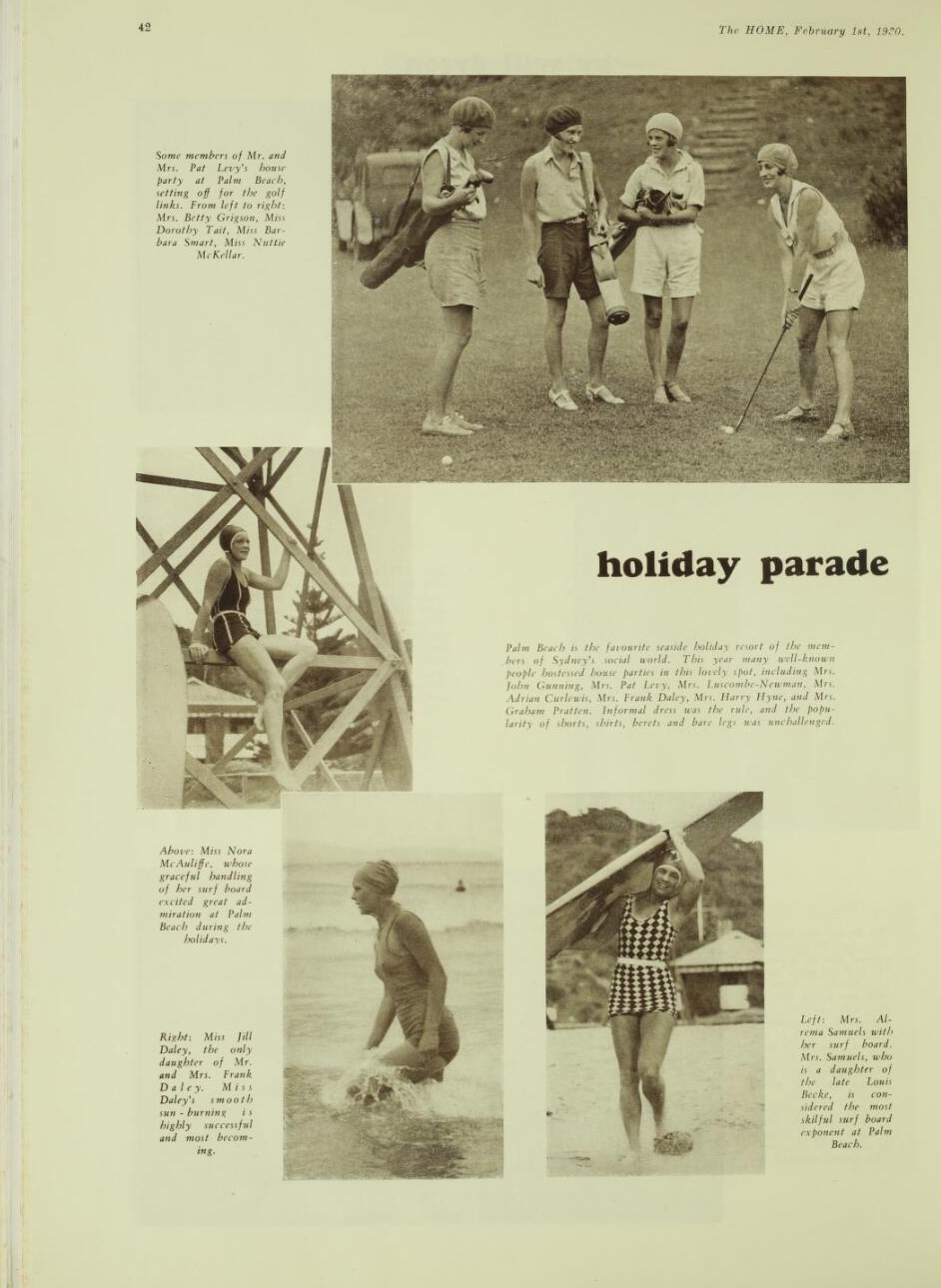
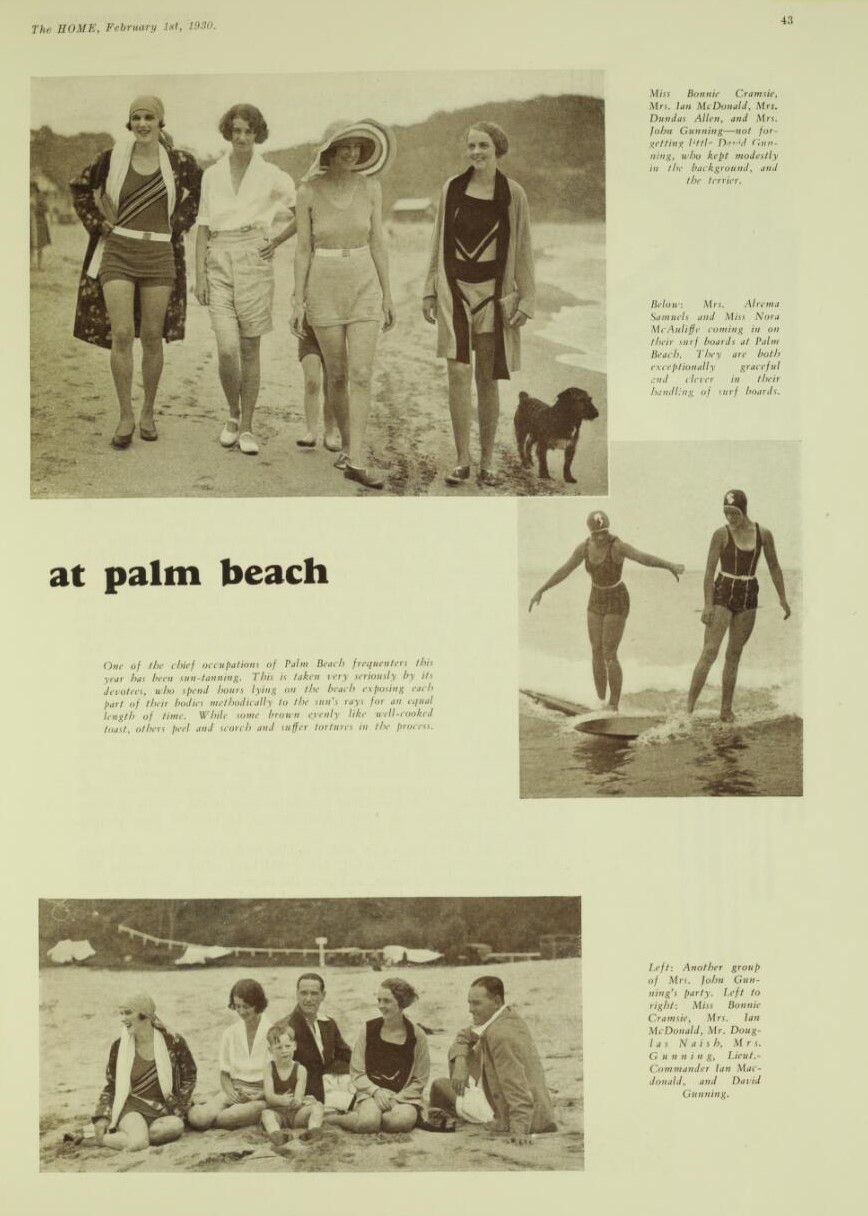
holiday parade at palm beach, The Home : an Australian quarterly. Vol. 11 No. 2 (1 February 1930) Retrieved from http://nla.gov.au/nla.obj-389238046
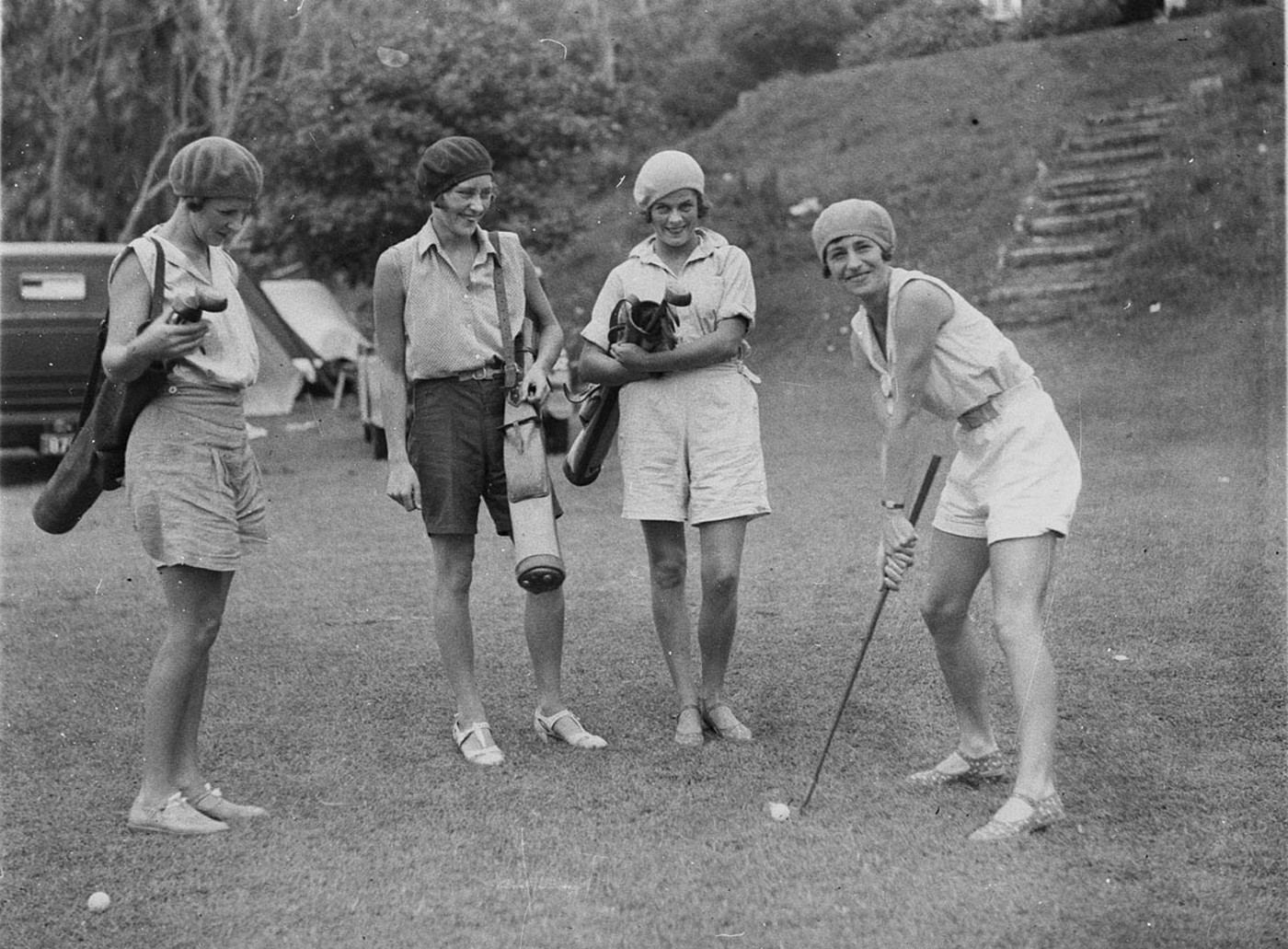
Palm Beach Again
PALM BEACH is setting new fashions in all directions, and the vogue is not confined to bathing togs alone. Sydney shrugged its shoulders when it learnt that society danced in. shorts during the season, and now comes word that the "gay young things" are sporting diminutive trousers on the golf links, in place of the usual very smart sports suit. Last week some very "fetching" ones made their appearance on this exclusive sports ground, and the fair wearers could not have been unconscious of the effect, when, in between dips they strolled to the links and played a round or two. Fancy! (1930, March 10). Daily Pictorial (Sydney, NSW : 1930 - 1931), p. 19. Retrieved from http://nla.gov.au/nla.news-article246125223

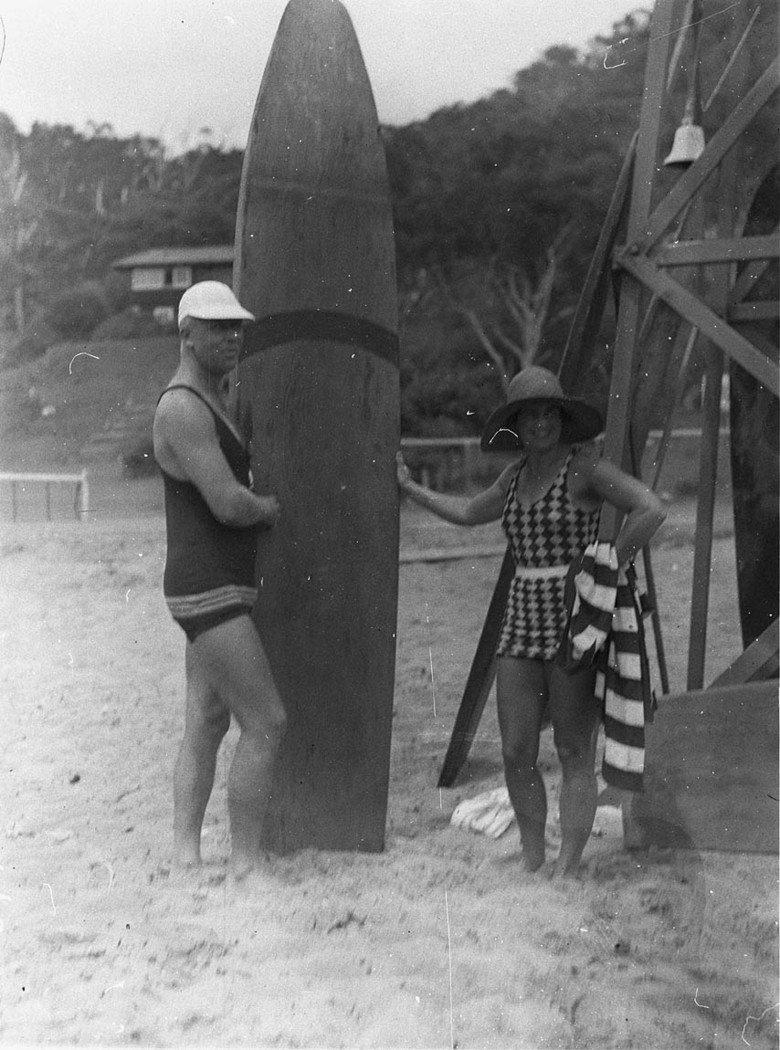
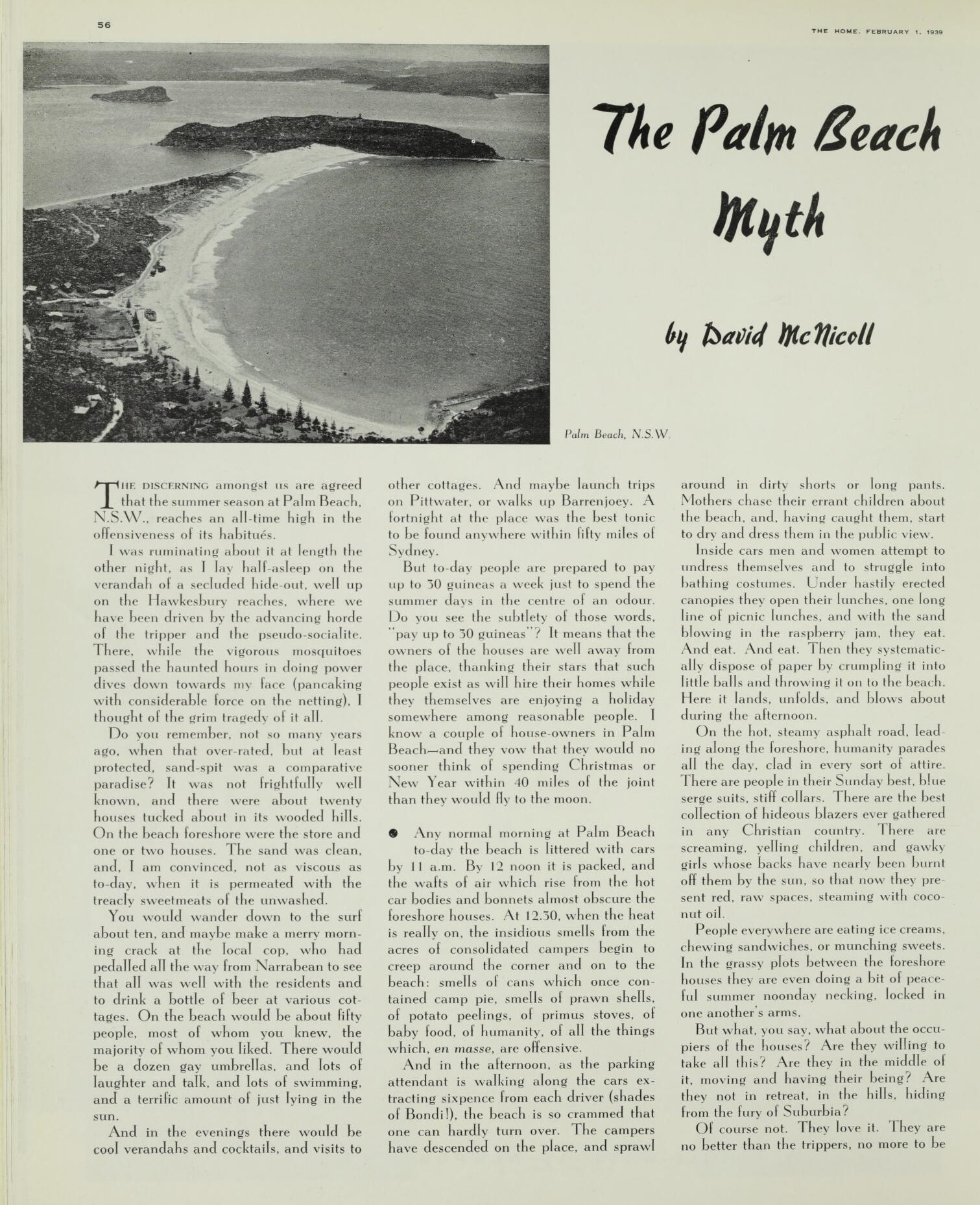
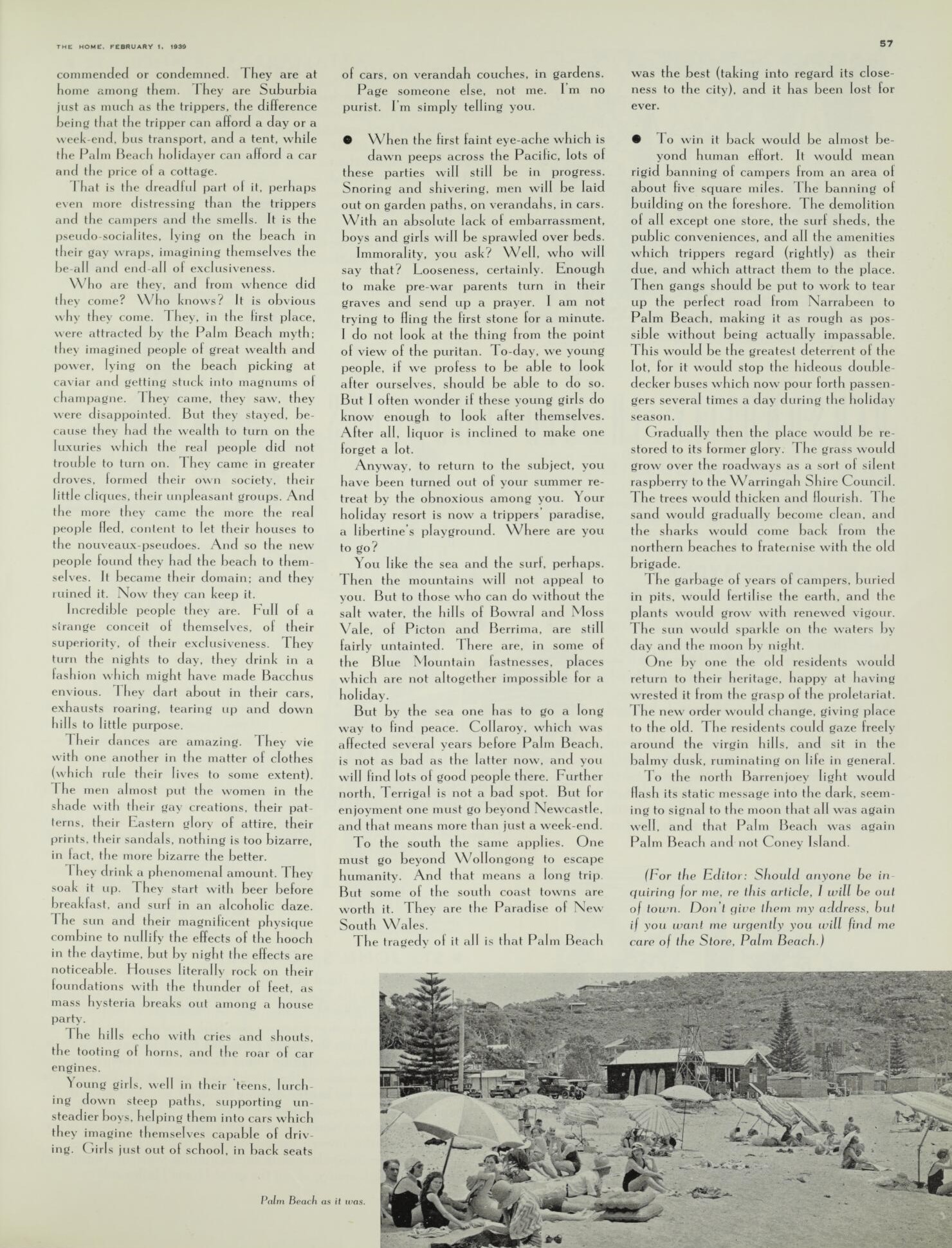
The Palm Beach myth, by David McNicoll. The Home : an Australian quarterly. Vol. 20 No. 2 (1 February 1939) Retrieved from http://nla.gov.au/nla.obj-389607884

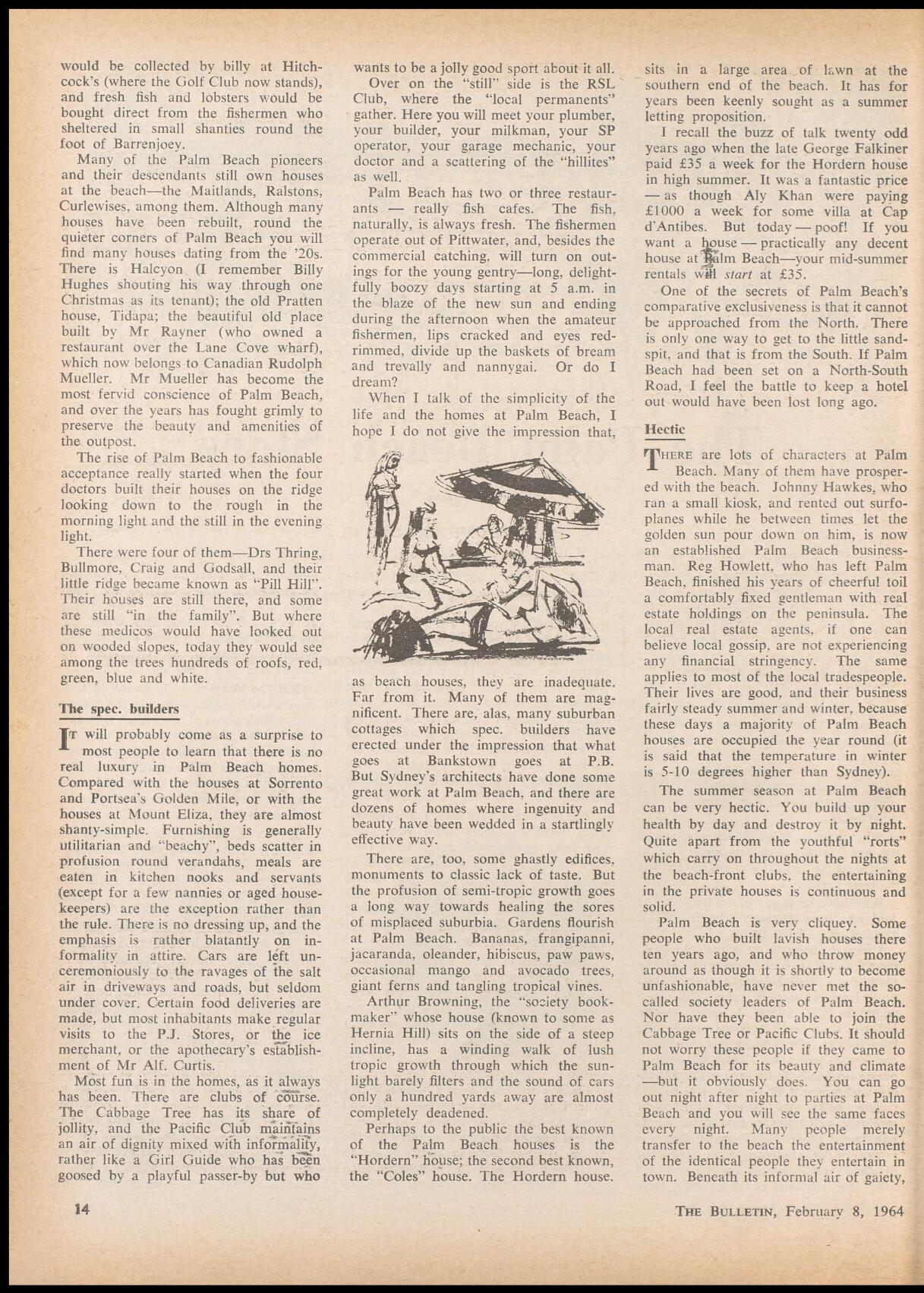

The Palm Beach Story " Very cliquey" By DAVID McNICOLL. The Palm Beach Story "Very cliquey", The Bulletin. Vol. 86 No. 4381 (8 Feb 1964) from http://nla.gov.au/nla.obj-689173158 - recalls Billy Hughes 'yelling his way through Christmas'.
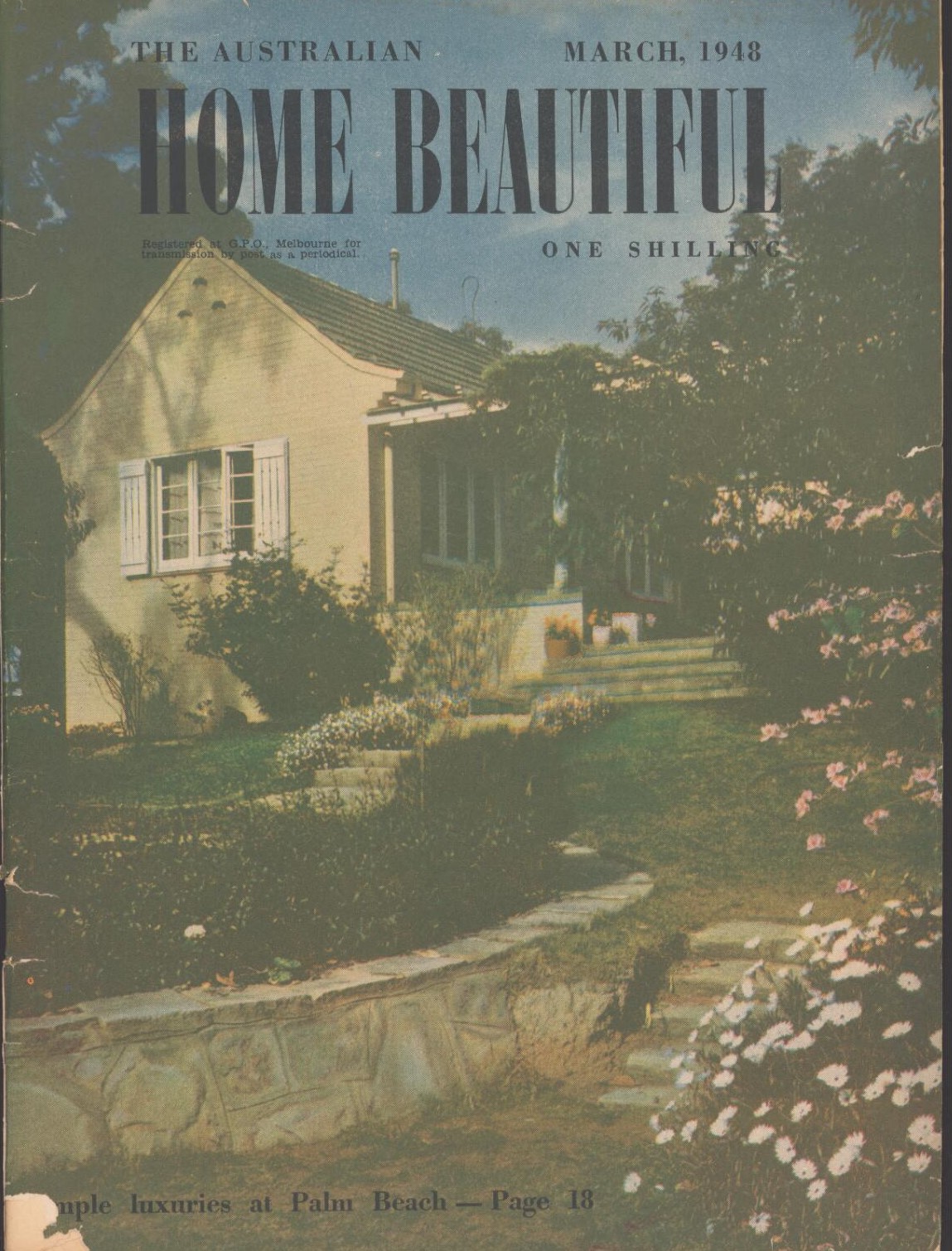
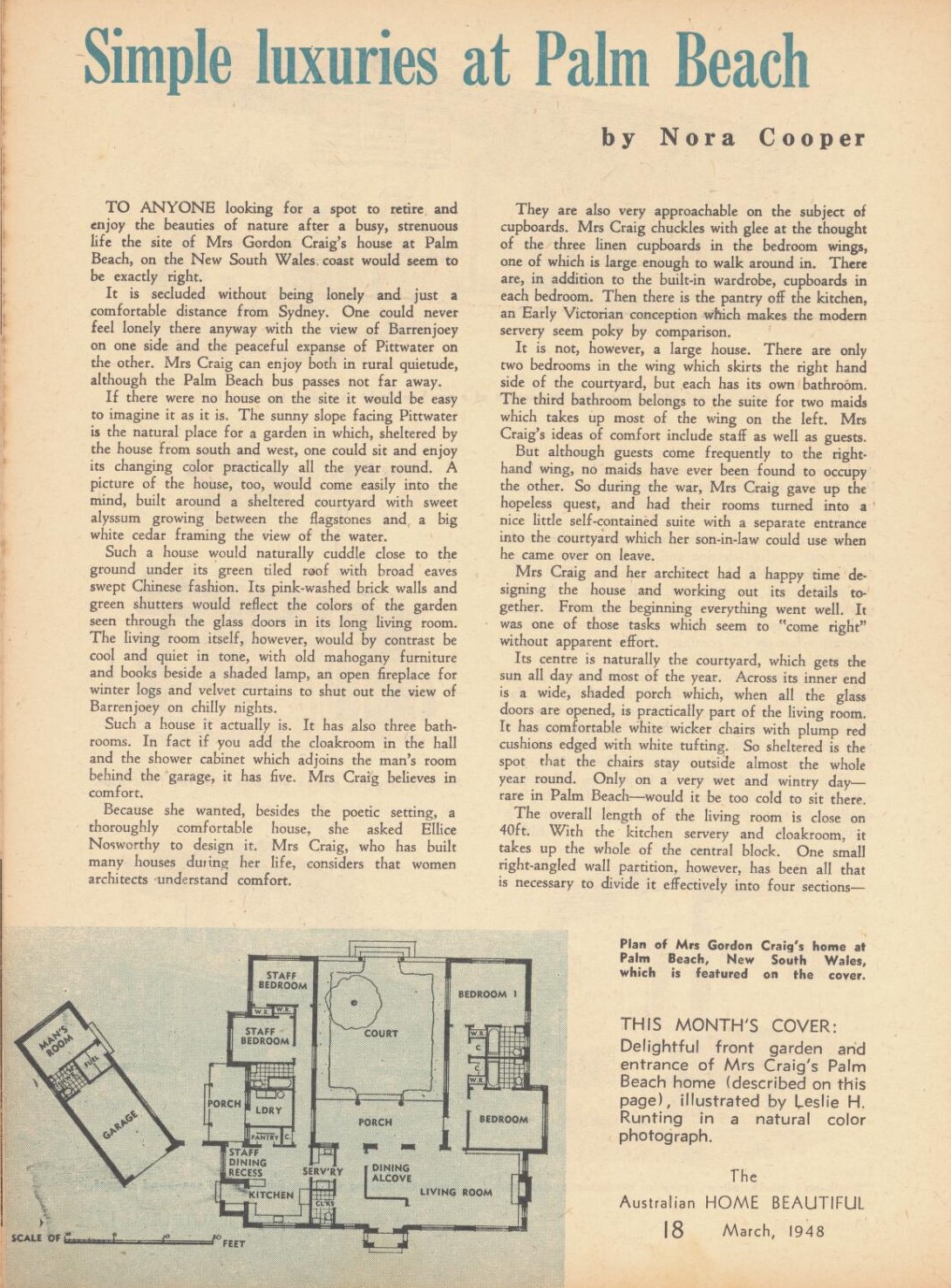
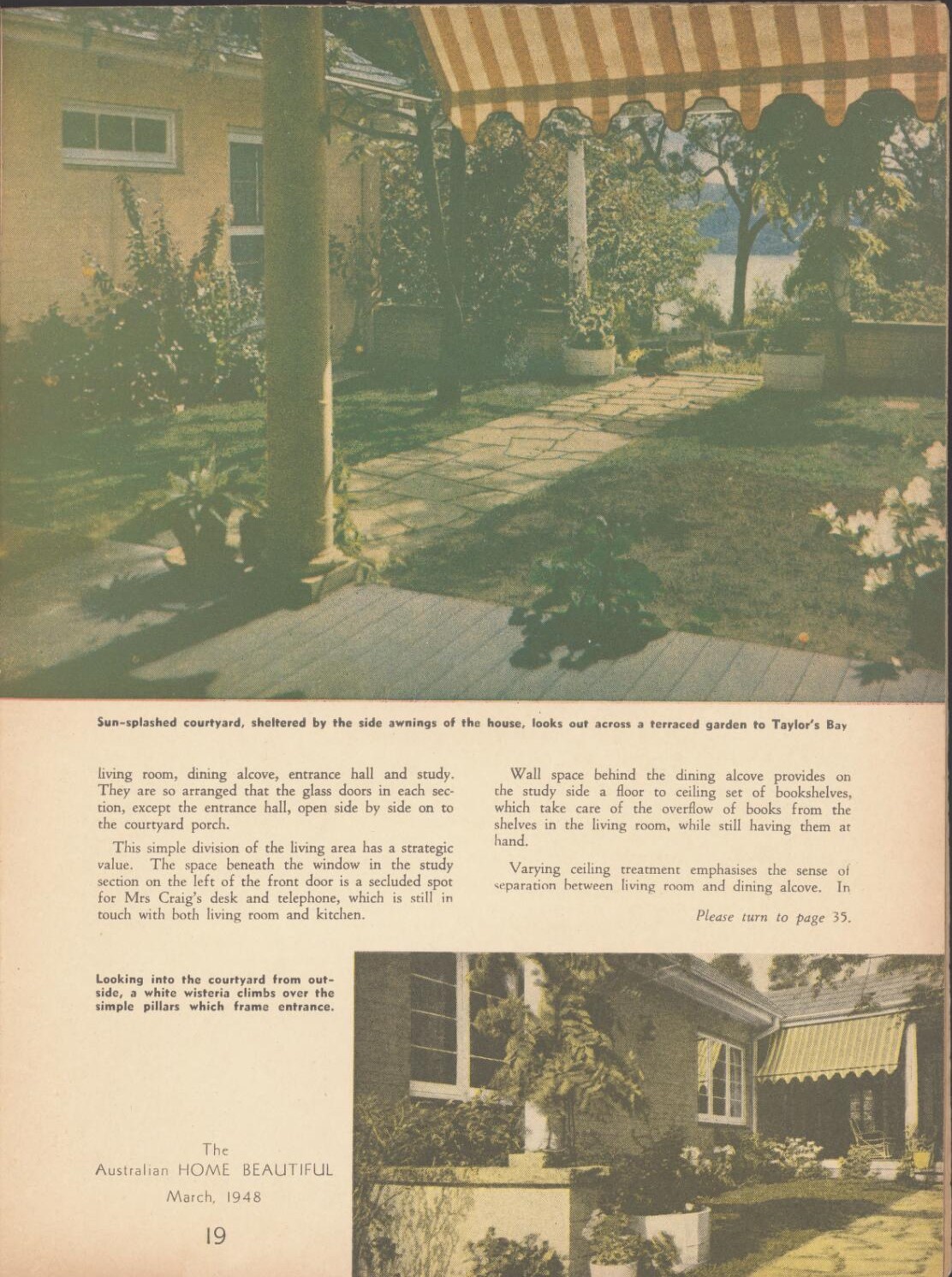
Simple luxuries at Palm Beach, The Australian home beautiful : a journal for the home builder. Vol. 27 No. 3 (March 1948) from http://nla.gov.au/nla.obj-2985930337
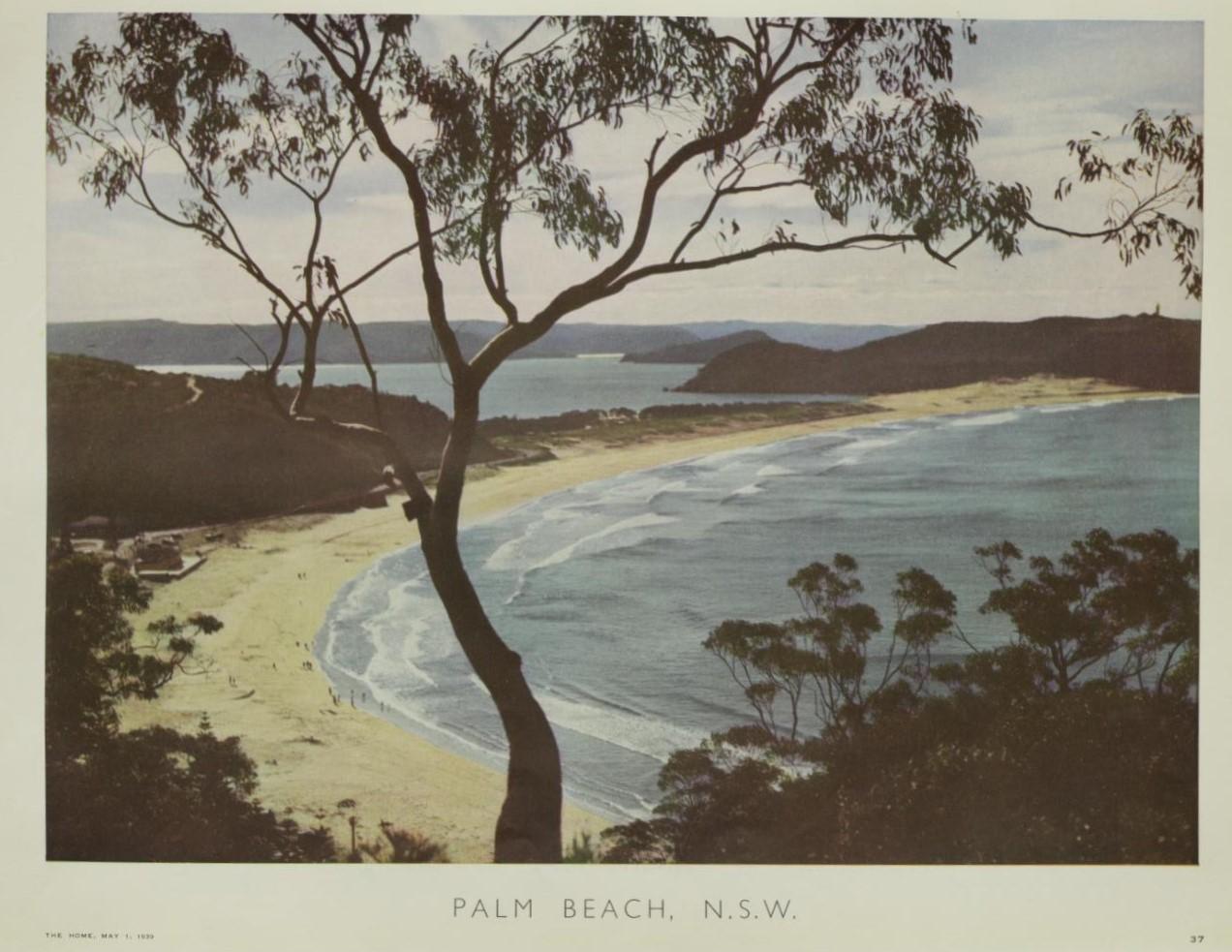
Pittwater Summer Houses: Kalua, Palm Beach by A J Guesdon, 2024

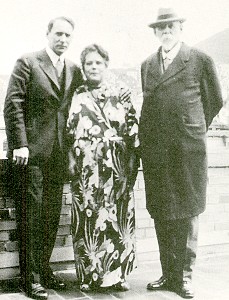
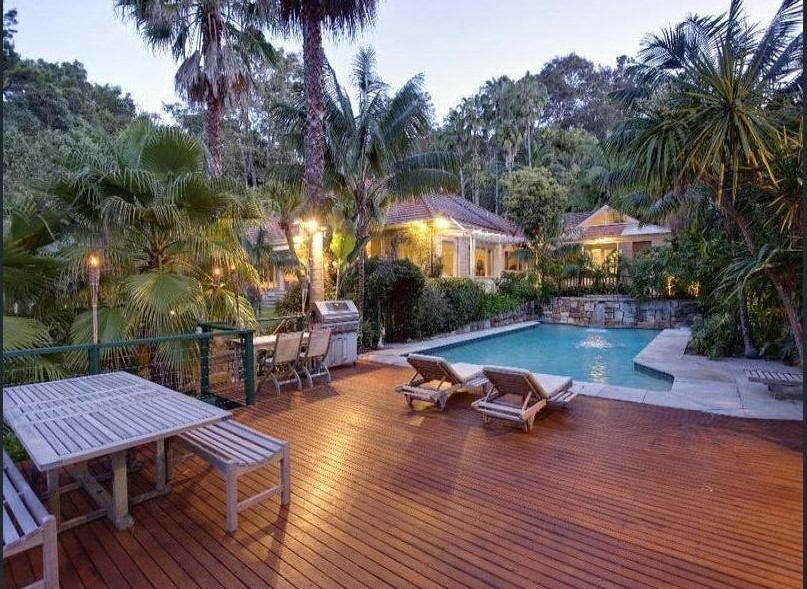
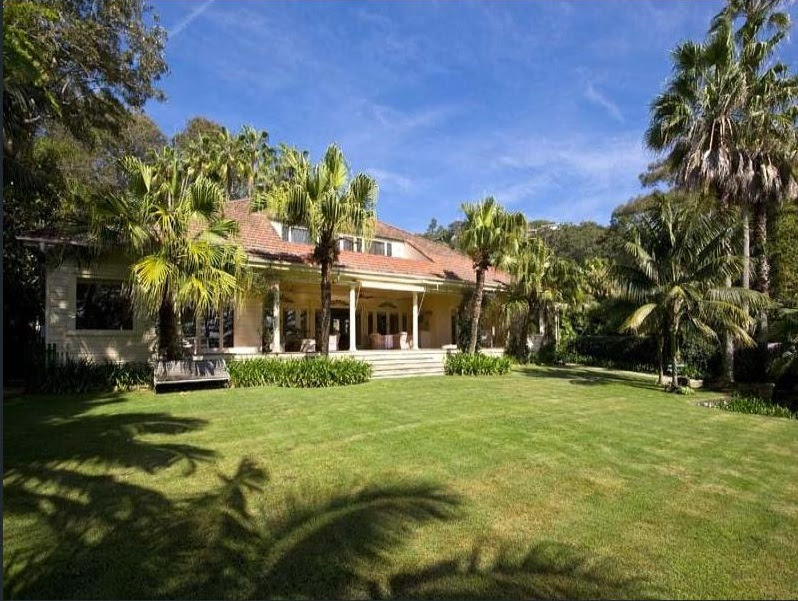
.jpg?timestamp=1707686483858)
